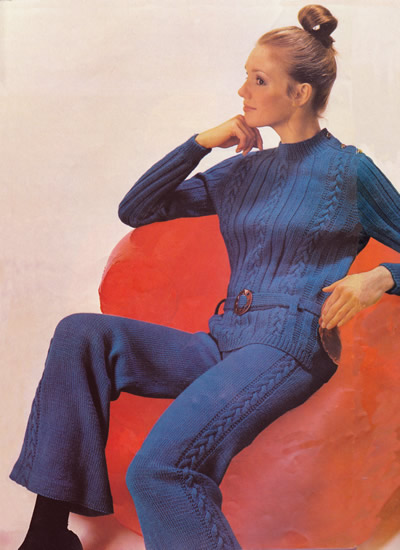
Perfectly Suited
More....
Please note:
Patterns are for
Personal Use Only
You may freely circulate patterns with the Copyright Statement Preserved.
See terms of use.
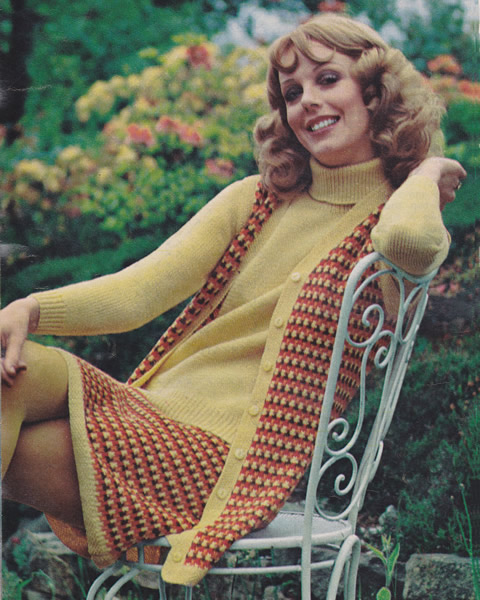
Eye-catching (to say the least...) outfit in colours typical for the 1970s (although other colour palette suggestions are provided in the original pattern).
Very much of its time - but the plain roll-neck sweater (with its light textured detail), and the sleeveless cardigan (maybe without the buttons?) might translate to a pleasing contemporary combination.
"Smart three-piece suit: polo sweater in twisted stocking stitch, skirt and sleeveless cardigan in 4-colour tweed-effect. "
Instructions. 3 sizes - larger sizes are given between brackets - Jumper BackUsing No 11 (3mm) needles, cast on 108 (114, 120) stitches and work 2½ inches in k1/p1 rib. Change to No 9 (3¾mm) needles and work in twisted stocking stitch
thus: Armhole Shaping: Continue straight until work measures 23 (23½, 24) inches. Shoulder Shaping: Jumper FrontWork as for the back up to ★★. Neck Shaping: Shoulder Shaping: With right side facing, slip the centre 22 (24, 26) stitches on to a stitch-holder. Complete the other side of the neck to match. Jumper SleevesUsing No 11 needles, cast on 44 (46,
48) stitches. To shape the top cast off 5 (6,
7) stitches at the beginning of the next
2 rows. Decrease 1 stitch at the beginning of every row until 38 stitches
remain; then, decrease 1 stitch at each end of the next 10 rows. Jumper Polo Collar Join the right shoulder. Work 3 inches in k1/p1 rib. Sleeveless Cardigan BackUsing No 11 needles and main shade, cast on 115 (123, 131) stitches. Moss Stitch row: k1, (p1, k1) to end. Editors note: Moss
stitch - or "seed stitch" - is worked by alternating knit and
purl stitches on every row - like ribbing. However, unlike ribbing, you
do not align the knit and purl stitches vertically above each other but
do the exact opposite; so, as you view the stitches, you will knit a stitch
showing a purl "bump" from the previous row, and purl into a
knit stitch. Repeat the Moss Stitch row row 9 times. Change to No 8 (4mm) needles and pattern: 1st Row: with main shade M, k1, (sl1
purlwise, k3) to the last 2 stitches, sl1 purlwise, k1. Pattern until work measures 21 inches. Armhole Shaping: Shoulder Shaping: Sleeveless Cardigan Right Front Using No. 11 needles and M cast on 59 (63,
67) stitches. Armhole and Front Shaping: Shoulder Shaping : Sleeveless Cardigan Left FrontWork as for the right front, reversing shapings. Sleeveless Cardigan BandsJoin shoulders. Next Row (make buttonhole): moss
stitch 3, cast off 3, moss stitch 3. Work the armbands in the same way, omitting the buttonholes. Skirt (Back and Front Alike)Using No 11 needles and colour M, cast on 147 (155,
163) stitches. Change to No 11 needles, and using M, work 1 inch in k1/p1 rib, beginning
the 2nd row with "p1". Making UpPress or block work according to yarn type. Sweater: Sleeveless Cardigan: Skirt: |
Materials
|

Choose a colourful chunky knit to herald the Spring season to come.
It's still cold enough for a thicker woollen, but you can brighten up the dark days of February with this chunky sweater - which is also quick to knit!
Don't just stick with the naval theme - take inspiration from these Oliver Bonas knits: here, here, or here.
Instructions.Back and Front (alike)Using 4½mm needles, and W (white yarn), cast on 67 (71, 73, 77) stitches, and work 2 (2, 2½, 2½) inches in k1, p1 rib, ending with wrong side facing for increase row. Next row (increase - wrong side facing): rib 5 (7, 5, 7) * increase in next stitch; rib 7 (7, 8, 8); repeat from * to last 6 (8, 5, 7) stitches; increase in the next stitch; rib to end. [75, 79, 81, 85 sts]. Change to 5½ mm needles. Row 1 (right side): knit with main
shade W (white). Editors note: Now you repeat the same pattern sections but change the colours. Rows 15 to 22: As Rows 1 to 8 but
use R instead of W. These 42 Rows form the pattern repeat them once more, then work Rows
1 to 14 again. SleevesUsing 4½mm needles, and W, cast on 37 (37, 39, 39) stitches, and work 2 (2, 2½, 2½) inches in k1, p1 rib, ending with wrong side facing for increase row. Next row (increase - wrong side facing): rib 2; [m1; increase in the next stitch] 5 times; rib 2; [increase in the next stitch] 8 (8, 9, 9) times; [m1; increase in the next stitch] 6 times; rib 2; [increase in the next stitch] 8 (8, 9, 9) times; rib to end. [75, 75, 79, 79 sts] Change to 5½ mm needles. To Make UpSee the yarn ball band for washing and pressing details. Join shoulder seams leaving approximately 9 (9½,
9½, 10) inches open at the centre for
the neck. |
MaterialsChunky yarn: Pair each of No 7 (4½mm) and No 5 (5½mm) needles. Tension17sts and 24 rows to 4 inches over pattern stitch. Size mattersFinished chest measurement: Abbreviations k: knit A word on the wool.Original yarn was: Note that chunky yarns can cover a wide variation in thickness so check your tension and alter the needle size if necessary. Disclaimer
|


Wonderfully cosy raglan sweater stitched in two vibrant colours. Fisherman's rib - or brioche as it now seems to be called, (no link to French bread as far as I can see) - is fantastically squishy and lovely - well worth the effort.
Instructions 3 sizes - larger sizes are given between brackets - [Editor's note:
If you are not familiar with fisherman rib stitch or brioche worked with
two colours, it should be quite easy to pick up from the instructions
below, once you understand that you do two rows with right side facing
(one in each colour) and then two wrong side rows (one in each colour)
- hence the need for double-pointed needles. Striped Fisherman Rib PatternThe two-colour brioche pattern has to be worked on needles or circular with points at both ends. 1st row (right side): With B, k1;
* p1, slip1pw, yrn; repeat from
* to last 2 stitches, p1, k1. 2nd row (right side): With A, k1;
yft, slip1pw, * yon, knit the next
stitch together with the loop made on the previous row, yft, slip1pw;
repeat from * to last stitch, yon,
k1. 4th row (wrong side): With A, k1,
yft, * slip1pw, yrn, purl the next
stitch together with the loop made on the previous row; repeat from
* to the last 2 stitches, slip1pw, yon,
k1. The last 4 rows from 2nd to 5th inclusive, form the pattern. Important notes on the brioche pattern:
BackUsing No 11 (3mm) needles, and main colour A, cast on 85 (89,
93) stitches and work in single rib: Repeat these two rows until work measures 3 inches (8cm) from the beginning,
ending with 1st rib row. Change to No 9 (3¾mm) needles, join in contrast B, and work in fisherman rib pattern as given above. Continue until work measures 13½ (14, 15) inches from the beginning. Raglan Shaping: Decrease 1 stitch at both ends of every alternate row 9 (10, 12) times, then at both ends of every following 4th row 28 (29, 29) times. Cast off remaining 31 stitches for back neck. FrontWork as for back until 114 (120, 124) rows have been worked from the beginning of the raglan shaping; 39 stitches remain for all sizes, ending with a decrease row. Neck Shaping: Next row: Pattern 13, and leave these
stitches on a holder; cast off the next 13 stitches; pattern to end.
Rejoin the correct colour to the other set of 13 stitches, and complete in the same way, from *** reversing shaping. Note that the front is overall 4 rows shorter than the back. Left SleeveUsing No 11 (3mm) needles, and main colour A, cast on 51 (55, 55) stitches and work as for back welt from ** to **. Increase row: Rib 4 (6, 6), [double increase, rib 13] 3 times, double increase, rib 4 (6, 6). [59 (63, 63) sts] Change to No 9 (3¾mm) needles, join in contrast B, and work in fisherman
rib pattern, but increase 1 stitch at both ends of every following 10th
row 6 (8, 3)
times, then every following 8th row 12 (10,
17) times, working the extra stitches into
the pattern. Continue straight until work measures 16 (16½, 17) inches from the beginning, ending with a 3rd (5th, 5th) pattern row. Raglan Shaping: Decrease 1 stitch at both ends of every alternate row 9 (10,
12) times, then at both ends of every following
4th row 22 (23, 23)
times; for all sizes 33 stitches remain, ending with a 5th pattern row. Neck Opening: 2nd pattern row (right side): Pattern 16 and leave these stitches for the back sleeve section on a spare needle; cast off 1 stitch; pattern to end. Continue on 16 stitches now remaining on the needle for front section
of sleeve. Rejoin the correct colour to the stitches on the spare needle for back
sleeve section. Note that front edge off sleeve is 4 rows shorter than back edge. Right SleeveWork as for left sleeve to ****. Neck Opening: 2nd pattern row (right side): Pattern 16 and leave these stitches on a spare needle for front sleeve section; cast off 1 stitch; pattern to end. Continue on 16 stitches now remaining on the needle for back section of right sleeve, and complete as for back section of left sleeve, reversing shapings. Rejoin the correct colour to the stitches on the spare needle for front sleeve section, and complete as for front section of left sleeve, reversing shapings. Make Up and Neck BordersJoin front raglan seams and right back seam matching vertical stripes.
With right side of work facing and using No 11 (3mm) needles, using main
colour A, pick up and knit 15 stitches along the neck opening at the top
of the left sleeve, 41 stitches round front neck edge, 15 stitches along
neck opening at the top of the right sleeve and 32 stitches
across the back neck. You should not press or iron any of the single or fisherman rib. |
Materials Double Knitting yarn, 50g balls: One pair of No 11 (3mm) needles, and two (long) double pointed needles or circular, No 9 (3¾mm) for working the pattern. Tension20 sts x 50 rows to 4 inches measured over pattern; work a sample on 25 stitches beginning with 2 rows of rib in contrast A then continue in pattern. Size mattersTo fit chest 32-34, (36, 38-40) Abbreviations:k/p: knit/purl A Word on the WoolThe original yarn was a standard double knitting wool (50% ) mix, with acrylic (40%) and mohair (10%). The quoted yardage was 125 meters, (137 yds), per 50g ball. Disclaimer
|

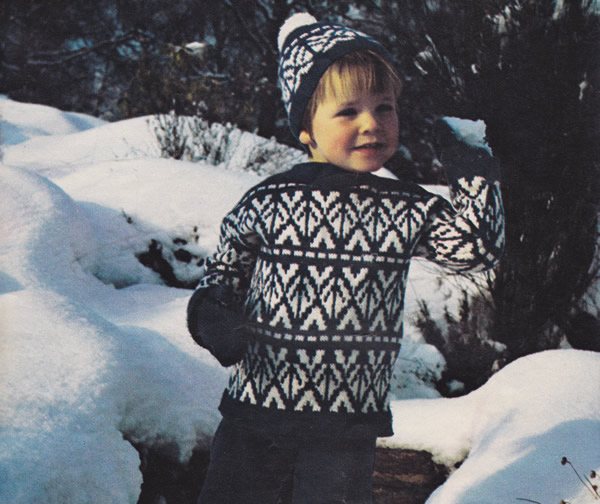
InstructionsSweater Back and Front alike:With No 10 (3¼mm) needles and MC, cast on 85 stitches. Work 10 rows stocking stitch, beginning with a knit row. *
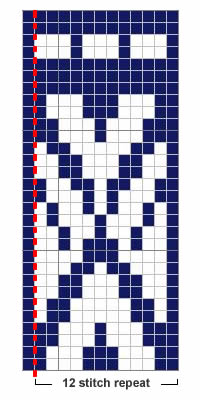
Continue until 3 complete patterns have been worked (or until work measures
16 inches from hemline), ending with a purl row. Shoulder Shaping: Cast off 8 stitches at the beginning of the next 6 rows. Purl 1 row (hemline). Work 6 rows in stocking stitch, beginning with a purl row, increasing 1 stitch at the beginning of every row. Cast off. Sleeves:With No 10 needles and MC cast on 49 stitches. Trousers Right Leg:Beginning at the ankle, with No 10 needles, and MC cast on 76 stitches.
Work 7 rows in stocking stitch knit 1 row (hemline). Decrease 1 stitch at each end of the 5th and every following 6th row until 68 stitches remain. Continue until work measures 24½ inches from hemline *, ending with a knit row. ** Shape back by working short rows thus: Change to No 10 needles and work 1 inch in k1/p1 rib. Trousers Left Leg:Work as right leg to *, ending with
a purl row. Hat:With No 10 needles and MC cast on 97 stitches. Work 6 rows in stocking stitch, decreasing 1 stitch at the end of 1st row. [96 sts]. Shape top thus: Continue decreasing in this way on every alternate row until 24 stitches
remain. Purl 1 row. Mitts (make 2 alike):With No 10 needles and MC cast on 39 stitches. With right side facing and 32 stitches on right hand needle, rejoin
yarn at the base of the thumb; pick up and knit 2 stitches at the base
of thumb, knit the 6 stitches to the end of the row end. [40 sts]. To Make Up Press or block work. Sweater: Join shoulder and neck facing seams. Trousers: Join front and back seams. Hat: Join seam. Mitts: Join seam. |
MaterialsWorked in a standard double knitting yarn (swatch as per tension given). Sweater: Hat: Trousers: Mitts: Pair each of No 9 (3¾mm), and Waist length of elastic. Tension26sts to 4 inches over fair-isle, 24sts over stocking stitch on 3¾mm needles. Size mattersSweater: Trousers: Abbreviations k: knit MC = main colour Disclaimer
|
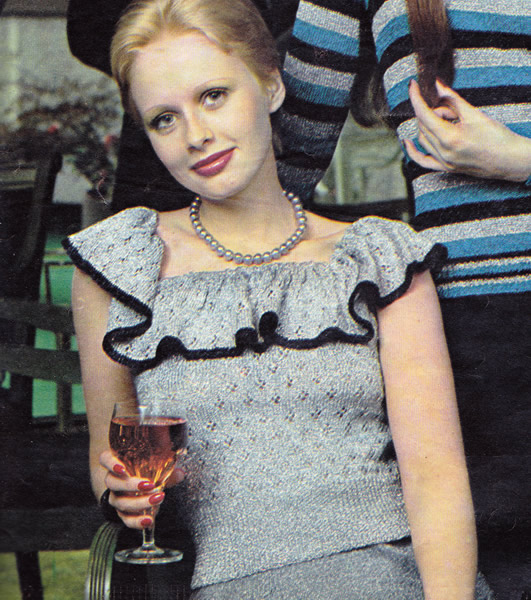
A fun top intended for a metallic yarn, and perfect for the party season. I find metallics a bit scratchy, but there are now quite a lot of sparkly fingering weight yarns for you to choose from. [Always check your tension... I know you do...]
Beautifully shaped sleeveless silver jumper with frill gathered on to deep round neckline.
InstructionsNote: instructions are given for 3 sizes. Back and Front alike:With No 13 (2¼mm) needles cast on 112 / 120
/ 128 stitches, and work 3 inches in k1/p1
rib. Change to No 12 (2¾mm) needles and pattern: 1st row: knit. Armhole Shaping: Cast off 4 / 5
/ 6 stitches at the beginning of the next
4 rows. With right side facing, cast off the centre 28/ 32
/ 36 stitches. Frill (two pieces alike)With No 12 needles and contrast edge colour, cast 168/ 184
/ 200 stitches.
Making UpPress lightly. Join side edges of frill. Fold cast-on edge to wrong side at hemline
and sew down, leaving an opening to insert elastic. |
MaterialsFingering 3 ply weight metallic yarn: Pair each of No 12 (2¾mm), and No 13 (2¼mm) needles. Tension32sts to four inches Size mattersTo fit chest: Abbreviations k: knit Disclaimer
|
A Word on the Wool.The original yarn was Twilleys Goldfingering - available in 25g balls
with a yardage of 100m (109yds), 80% Viscose 20% Metallised Polyester. |
|
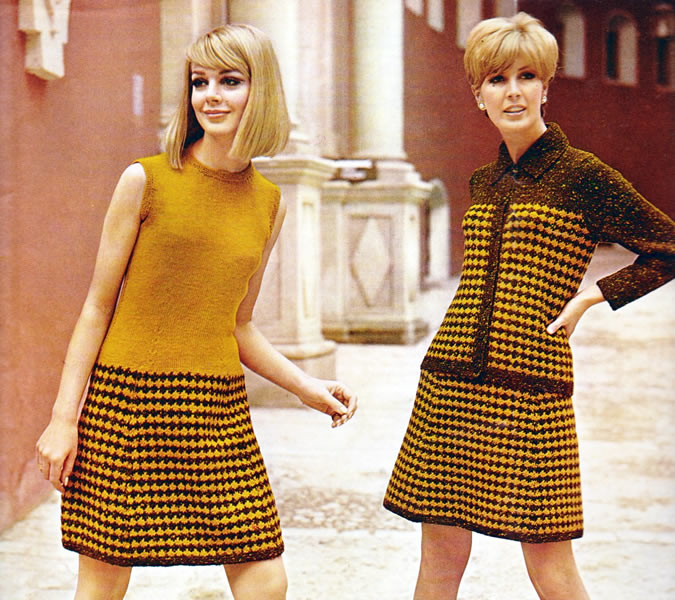
Striking (or startling) sixties "costume" of a jacket with a matching dress or skirt. The colours are very much of the time, so it might be slightly more appealing to current taste if executed in, say, black or navy with a neutral white or cream (but if you like it, I expect you'd already thought of that!).
Instructions for Jacket and Skirt SuitJacket BackUsing No 10 (3¼mm) needles and B, cast on 80 / 84
/ 88 / 92
stitches and work 10 rows in garter stitch. With right side facing, change to No 7 (4½mm) needles, join in D
and work in pattern as follows:— Work straight in pattern until back measures approximately 14 inches,
ending with 8th pattern row. Now decrease 1 stitch at each end of next and every alternate row until 69 / 73 / 79 / 83 stitches remain. Break D. Next row: in B, purl 3 / 6
/ 2 / 5,
p2tog, * p4, p2tog; repeat from *
to last 4 / 5 / 3
/ 4 stitches, purl 4 / 5
/ 3 / 4. Work straight in stocking stitch in B, starting with a knit row, until
back measures 21 / 22 / 22
/ 22½ inches down centre. Jacket Left FrontUsing No 10 needles and B, cast on 38 / 40
/ 42 / 44
stitches and work 10 rows in garter stitch. With right side facing, change to No 7 needles and diamond pattern, starting with 1st pattern row, and work straight until front matches back at side edge, ending with 8th pattern row. With right side facing, shape armholes by casting off 5 / 5
/ 6 / 6
stitches at the beginning of the next row. Next row: in B, purl 3 / 4
/ 3 / 1,
p2tog, * purl 3 / 2
/ 2 / 2,
p2tog; repeat from * to last 3 / 3
/ 3 / 1
stitches, purl 3 / 3 / 3
/ 1. Work straight in stocking stitch in B, starting with a knit row, until
front measures 19½ / 20 / 20
/ 20½ inches down centre. Jacket Right FrontWork to correspond with left front, reversing shapings. SleevesUsing No 10 needles and B, cast on 40 / 42
/ 42 / 44
stitches and work 11 rows garter stitch. Work straight until sleeve seam measures 15 / 15½
/ 15½ / 16
inches. CollarUsing No 10 needles and B, cast on 60 / 62
/ 64 / 66
stitches and work in garter stitch, shaping collar by increasing 1 stitch
at each end of the next and every alternate row until there are 70 / 72
/ 74 / 76
stitches Work 7 rows straight. Work 7 rows straight. Work 7 rows straight, Work 7 rows straight. Cast off. Front BandsRight: With No 10 needles and B, pick up and knit 107 / 109
/ 109 / 111
stitches up right front to start of neck shaping. Left: Work to correspond with right front band, omitting buttonholes. To Make UpPress parts lightly on wrong side under a damp cloth, avoiding garter
stitch borders. SkirtFirst panel: With right side facing, change to No 7 needles, join in D and work in
pattern as follows:— Work a further 4 / 8 / 10
/ 16 rows straight in pattern. Work 3 / 3 / 1 / 1 rows straight, then, decrease 1 stitch at each end of next and every following 6th row until 31 / 33 / 35 / 37 stitches remain. Work a few rows straight until panel measures 20 / 20½
/ 21 / 21½
inches down centre, ending with 8th pattern row. Change to No 10 needles, and work 1 inch k1/p1 rib in B. To Make UpPress parts lightly on wrong side under a damp cloth, avoiding garter
stitch borders. |
MaterialsJacket: Skirt: Pair each of No 7 (4½mm), and 7 buttons. Tension16sts and 27 rows over 3 inches on 4½mm needles over diamond pattern. 18sts and 25 rows to 4 inches in tweed yarn on 4½mm needles over
stocking stitch. Size mattersJacket: Skirt: Abbreviations k: knit D = plain double knitting colour A word on the wool.The original yarn was Patons Bracken combined with a plain DK. I would substitute with Rowan Felted Tweed DK (because I love it and
there is a wonderful range of colours); however it's a finer yarn, and
much loftier and light weight yarn than Bracken, which knitted up quite
firmly, and the tension here aligns Bracken more towards being an Aran
yarn rather than a DK. Disclaimer
|
Instructions for DressSkirt sectionsWork panel as given for skirt above from **
to **. Work a few rows straight until panel measures 16½ / 17
/ 17½ / 18
inches down centre, ending with 4th pattern row, and increasing 1 stitch
in the centre of this row for the 2nd
and 4th sizes only. Break off B yarn, and leave the stitches on a spare needle or stitch holder. Make another 3 panel sections the same, and number each panel 1, 2, 3 and 4. Bodice back:To make the bodice, arrange the stitches from the skirt panels as follows:— *** Continue working back and forth
in stocking stitch on these 94 / 100
/ 106 / 112
stitches for the back, starting with a purl row and work 3 rows straight.
Work straight until bodice measures 12½ / 12½
/ 12 / 12
inches from start. Work a few rows straight until bodice measures 15½ inches down centre,
ending with right side facing. With right side facing, rejoin the yarn to the remaining stitches and finish to correspond with first side of back. Bodice front: With No 8 needles and right side facing, using D yarn, work as follows:—
Work as for Bodice back from ***
to ***. Here divide for neck:- With right side facing, shape shoulder as given for back. With right side facing, slip centre 14 / 16
/ 18 / 20
stitches on a spare needle or stitch holder, rejoin wool to remaining
stitches, and knit to end. To Make Up Press parts carefully on wrong side under a damp cloth, avoiding garter
stitch borders. Neckband: With right side facing, and using the set of No 10 needles,
or circular needle, work in D yarn as follows:— Arranging the stitches evenly on 3 needles, or using circular needle,
work backwards and forwards in garter stitch (every row knitted) for 3
rows. Work a further 3 rows garter stitch. Cast off. Armbands: With right side facing, and using No 10 needles, work
in D yarn as follows:— Join side seams and armbands with a flat seam. |
Materials12 / 13 / 14
/ 15 x 1oz balls in plain double knitting
("Amberglow") Pair each of No 7 (4½mm), No 8 (4mm), and No 10 (3¼mm) needles. A 5 inch zip fastener for back of dress. Tension16sts and 27 rows over 3 inches on 4½mm needles over diamond pattern.
Size mattersTo fit chest: Abbreviations k: knit D = plain double knitting colour A word on the wool.The original yarn was Patons Bracken combined with a plain DK. I would substitute with Rowan Felted Tweed (because I love it and there
is a wonderful range of colours); however it's a much loftier and light
weight yarn than Bracken, which knitted up quite firmly. Disclaimer
|

Still beside the sea, as the weather turns cooler. An altogether pleasing design for jackets with broken cable pattern - for him: a zip closure with angled pockets, and for her: a smooth line with buttons.
Instructions for woman's jacketNote: instructions are given for 3 sizes. BackWith No 8 (4mm) needles cast on 122 / 128 / 136 stitches, and work 11 rows in k1/p1 rib, increasing 1 stitch at the end of the last row on the middle size only. [122 / 129 / 136 sts] 12th row: k1, purl to the last stitch,
k1. Change to No 6 (5mm) needles and pattern: 1st row: k1, p2, *
k4, p3; repeat from * to last 7 sts;
k4, p2, k1. ** Repeat from ** to ** twice more, then repeat the 3rd, 2nd, and 1st rows once more, in that order. Change to No 7 (4½mm) needles. 24th row: k1, purl to the last stitch,
k1. These 34 rows form the pattern. Change to No 6 needles and repeat from 1st to 34th rows inclusive once,
then 1st to 24th rows inclusive once. Keeping pattern correct and changing needles as before, shape armholes
by casting off 7 / 8 / 9
stitches at the beginning of the next 2 rows. Repeat the last 6 rows until 32 / 37 / 42 stitches remain, ending with right side facing. For the 2nd size: work 4 more rows, decreasing 1 stitch at each end of the 1st and 3rd rows. For the 3rd size: work 8 more rows, decreasing 1 stitch at each end of the 1st and then alternate rows. For all sizes: cast off the remaining 32 / 33 / 34 stitches, firmly. Left FrontWith No 8 needles cast on 66 / 72 / 80 stitches, and work exactly as for back to ***. Keeping pattern correct and changing needles as before, shape armhole: Next row: cast off 7 / 8
/ 9 stitches, work in rib to end. Continuing on No 6 needles: SHAPE NECK: For the 2nd and 3rd
sizes: continue decreasing as before but at each end
of the needle until 31 / 21
stitches remain. Right FrontWork exactly as for left front to the start of the armhole shaping, then work one more row in rib to end with the wrong side facing. Now shape the armhole: Next row: cast off 7 / 8
/ 9 stitches, purl to the last stitch, k1.
Continuing on No 6 needles: SleevesWith No 8 needles cast on 40 / 40 / 42 stitches, and work 11 rows in k1/p1 rib, increasing 5 / 5 / 10 stitches evenly across on the last row. [45 / 45 / 52 sts] Next row: k1, purl to the last stitch, k1. Change to No 6 needles and cable pattern, as for the back, and work Continue working in cable and rib pattern, increasing 1 stitch at each end of the next and every following 4th row until there are 89 / 91 / 98 stitches. Then continue straight until the 28th row of the 3rd pattern has been completed - that is, finishing on on the same row as the back before the start of the armhole shaping. Shape armhole exactly as for back until 43 / 43
/ 48 stitches remain. Front BordersLeft: With No 7 needles, cast on 11 stitches. 1st row: k2, *
p1, k1; repeat from * to last stitch,
k1. Repeat these 2 rows until border fits up edge of left front to the start
of the neck shaping when slightly stretched. Right: Work a similar strip for the right front, with the
addition of 8 buttonholes; the first to come in the 5th and 6th rows up
from the lower edge, and the 8th just below the start of the neck shaping,
and the remaining 6 spaced evenly in between. To make a buttonhole: with right side facing, rib 4, cat off 3, rib 4;
rib back, casting on 3 over those cast off. When border is finished, cast off evenly in rib, and sew in position. CollarWith No 7 needles, cast on 139 / 141
/ 145 stitches, and work in k1/p1 rib as
given for left front border, until collar measures 4 inches. Cast off
24 / 25 / 27
stitches at he beginning of the next 4 rows.
To Make UpPin out the pieces to sizes required and block or press according to
the instructions for the wool you are using (usually given on the ball
band). |
MaterialsAran or worsted weight yarn: Pair each of No 6 (5mm), No 7 (4½mm), and No 8 (4mm) needles. 8 buttons. Tension19sts and 24 rows to four inches on 5mm needles over stocking stitch.
Size mattersTo fit chest: Abbreviations k: knit A word on the wool.The original yarn was Patons Ariel designed for outer wear with a slightly
rough texture. It was one of those "tripleknit" yarns which
never really caught on in the UK. More or less Aran or American worsted
weight. It came in 2oz (57g) balls at 89m/97yards, 80% wool, 20% man-made
fibres. Disclaimer
|

"The sporty out-door look is perfectly typified in this popular, but first-class looking, zipped jacket. Companion to the woman's jacket, in the same attractive crunchy broken rib pattern. Lovely waterside colour of deep, shimmering blue, lightweight, but windproof by the sea, in the special triple-knit texture."
Instructions for man's zipped jacketNote: instructions are given for 2 sizes. BackWith No 8 (4mm) needles cast on 136 / 142 stitches, and work 11 rows in k1/p1 rib, increasing 7 stitches evenly across on the last row. [143 / 150 sts] 12th row: k1, purl to the last stitch,
k1. Change to No 6 (5mm) needles and pattern: 1st row: k1, p2, *
k4, p3; repeat from * to last 7 sts;
k4, p2, k1. ** Repeat from ** to ** twice more, then repeat the 3rd, 2nd, and 1st rows once more, in that order. Change to No 7 (4½mm) needles. 24th row: k1, purl to the last stitch,
k1. These 34 rows form the pattern. Change back to No 6 needles and continue in pattern until 3 complete patterns have been completed from the start. Keeping pattern correct and changing needles as before, with right side facing, shape armholes by casting off 4 stitches at the beginning of the next 2 rows, then decrease 1 stitch at each end of every row until 103 / 98 stitches remain. Now decrease 1 stitch at each end of the next and every alternate row until 41 / 42 stitches remain, ending with right side facing. Leave these stitches on a spare needle or stitch holder. Right FrontWith No 8 needles cast on 66 / 72 stitches, and work 11 rows in k1/p1 rib, increasing 7 / 8 stitches evenly across on the last row. [73 / 80 sts] 12th row: k1, purl to the last stitch, k1. Change to No 6 needles and pattern as given for the back. Here divide for pocket. Next row: rib 21 / 28
and slip these stitches onto a spare needle or stitch holder, cast off
3, pattern to end. Keeping pattern correct and changing needles as before, shape as follows:
Repeat the last 2 rows 10 times more. [27 / 27
sts] With right side facing, rejoin yarn to the last 21 / 28
stitches; cast on 3, and rib to end. Continue in pattern, casting on 2 stitches at the beginning of the next and every alternate row until there are 46 / 53 stitches, taking the cast on stitches into the pattern as they are made, and ending at the side edge. Now continue in pattern over all stitches, until front matches back at side edge, ending with wrong side facing. Keeping pattern correct and changing needles as before, shape raglan armhole: Next row: cast off 4, pattern to end. Now decrease 1 stitch at the armhole edge on the next 10 / 22
rows. [59 / 54 sts] Shape neck: Next row: cast off 12 / 13,
pattern to end. Left FrontWith No 8 needles cast on 66 / 72 stitches, and work 11 rows in k1/p1 rib, increasing 7 / 8 stitches evenly across on the last row. [73 / 80 sts] 12th row: k1, purl to the last stitch, k1. Change to No 6 needles and pattern as given for the back. Here divide for pocket. Next row: pattern 52 / 52
and slip the remaining 21 / 28 stitches
onto a spare needle or stitch holder. Next row: cast off 2, pattern to
end. Break yarn and leave these 27 stitches onto a spare needle or stitch holder. With wrong side facing, rejoin yarn to last 21 / 28
stitches. With wrong side facing, rejoin yarn at front edge, and continue in pattern over all stitches, and finish to correspond with right front, reversing all shapings. SleevesWith No 8 needles cast on 48 / 52 stitches, and work 2½ inches in k1/p1 rib, increasing 11 / 14 stitches evenly across on the last row. [59 / 66 sts] Change to No 6 needles and cable pattern, as for the back, and work Continue working in cable and rib pattern, increasing 1 stitch at each end of the next and every following 4th row until there are 109 / 110 stitches, taking the increased stitches into the pattern as they are made. Then continue straight until the 34th row of the 3rd pattern has been completed - that is, finishing on on the same row as the back before the start of the armhole shaping. Shape top by casting off 4 stitches at the beginning of the next 2 rows, then decrease 1 stitch at each end of the next 18 rows. [65 / 66 sts] Now decrease 1 stitch at each end of the next and every following alternate row until 5 / 6 stitches remain, ending with right side facing. Leave these stitches on a spare needle or stitch holder. CollarJoin raglan seams, matching patterns. Next row: k1, *
p1, k1; repeat from * to end. Next row (increases): rib 4, pick
up horizontal loop lying before next stitch and knit into the back of
it; rib to last 4 stitches, pick up horizontal loop lying before next
stitch and knit into the back of it, rib 4. Pocket Linings an BordersLinings: With No 6 needles and right side facing, pick up and
knit 32 stitches along top slope of each pocket and work 4 inches in stocking-stitch,
starting with a knit row. Cast off.
To Make UpPin out the pieces to sizes required and block or press according to
the instructions for the wool you are using (usually given on the ball
band). |
MaterialsAran yarn: Pair each of No 6 (5mm), No 7 (4½mm), and No 8 (4mm) needles. A zip fastener (double-ended - suitable for a jacket). Tension19sts and 24 rows to four inches on 5mm needles over stocking stitch.
Size mattersTo fit chest: Abbreviations k: knit A word on the wool.The original yarn was Patons Ariel designed for outer wear with a slightly
rough texture. It was one of those "tripleknit" yarns which
never really caught on in the UK. More or less Aran or American worsted
weight. It came in 2oz (57g) balls at 89m/97yards, 80% wool, 20% man-made
fibres. Disclaimer
|

Beach cover-up, which can be made as a sleeveless tunic top (above), or a poncho/tabard (below) -- great for a sandy beach, after a refreshing dip on an English summer's day!
"Poncho wrap to slip on after a bathe, ties loosely at the sides -- warm but light weight, it's the perfect cover-up for after-swim. Tunic uses the same vivid design, to give you a play sweater for the beach to wear over tiny shorts."
Instructions for TunicInstructions are given for 3 sizes, and the tunic is knitted sideways,
following the chart. BackWith No 9 (3¾mm) needles and main shade (W), cast on 121 / 121
/ 127 stitches, and work 1 / 3
/ 5 rows in stocking stitch, starting with
a purl row. Change to No 8 (4mm) needles and with right side facing, work the Fair Isle pattern from the chart, reading odd rows knit from right to left, and even rows purl from left to right. On knit rows, first work section A, then repeat the 6 pattern stitches 18 / 18 / 19 times. On purl rows, repeat the 6 pattern stitches 18 / 18 / 19 times, then work section A, as indicated. Thus your first 2 rows will read : Continue working from chart until 36th pattern row has been completed,
increasing 1 stitch at the beginning of the next and every Shape back of neck by casting off 3 stitches at the beginning
of the next row, then decrease 1 stitch at this edge on the following
6 rows as indicated: [121 / 121 /
127 sts]. Change back to No 9 needles and work 42 / 46
/ 50 rows straight in stocking stitch in
main shade W, starting with a knit row. Finish to correspond with chart, increasing for neck and decreasing for
shoulder as indicated. Change to No 9 needles and work 1 / 3
/ 5 rows in stocking stitch, in W, starting
with a knit row. FrontWork as for back, shaping neck by casting off 5 stitches at the beginning of the 37th row, then decreasing as indicated, and changing to No 9 needles when the 44 rows of the Fair Isle panel have been completed: [111 / 111 / 117 sts]. When the neck shapings are complete, work 34 / 38
/ 42 rows straight in stocking stitch using
W, starting with a knit row.
Ribbed BorderFront: with right side facing, using W wool and No 9 needles,
pick up and knit 114 / 120 / 126
stitches evenly along the lower edge. To Make UpPress work lightly on the wrong side, under a damp cloth, avoiding the ribbing. Join right shoulder seam. Turn with 1 chain, and work a further 3 rows dc, turning with 1 chain
Join the left shoulder and neckband seam. Armholes: Measure 6¼ / 6¾
/ 7¼ inches from the top of the shoulder
down the side edge on the back and front, and mark with pins. Join side and border seams; press seams. |
MaterialsDouble Knitting yarn: Pair each of No 8 (4mm) and No 9 (3¾mm) needles. Tension23sts and 31 rows to four inches on 3¾mm needles over stocking stitch.
Size mattersTo fit chest: Abbreviations k: knit A word on the wool.Original yarn was a double knitting Disclaimer
|


Instructions for PonchoInstructions are given for 3 sizes, and the tunic is knitted sideways,
following the chart. BackWith No 7 (4½mm) needles and main shade (W), cast on 127 stitches,
and work 6 rows in stocking stitch, starting with a knit row. Change to No 6 (5mm) needles and with right side facing, work the Fair Isle pattern from the chart, reading odd rows knit from right to left, and even rows purl from left to right. On knit rows, first work section A, then repeat the 6 pattern stitches 19 times. On purl rows, repeat the 6 pattern stitches 19 times, then work section A, as indicated. Thus your first 2 rows will read : Continue working from chart until 36th pattern row has been completed,
increasing 1 stitch at the beginning of the next and every Shape back of neck by casting off 3 stitches at the beginning
of the next row, then decrease 1 stitch at this edge on the following
6 rows as indicated: [127 sts]. Change back to No 7 needles and work 26 rows straight in stocking stitch
using main shade W, starting with a knit row. Finish to correspond with chart, increasing for neck and decreasing for
shoulder as indicated. Change to No 7 needles and work 6 rows in stocking stitch, using W, starting
with a knit row. Front Work as for back, shaping neck by casting off 5 stitches at the beginning
of the 37th row, then decreasing as indicated, and changing to No 7 needles
when the 44 rows of the Fair Isle panel have been completed: [117 sts]. When the neck shapings are complete, work 18
rows straight in stocking stitch using W.
To Make UpPress work lightly on the wrong side, under a damp cloth. Neck edging front: with right side facing, using W and crochet
hook, start at the left side of the neck on the front, and work a row
of double crochet (English = double crochet, American= single crochet)
evenly round neck edge. In the same way, neaten the side edgings by working a row of dc down
the right side of the front, along the lower edge, and up the other side;
turn with one chain, and work a 2nd row. Work a crochet edging on the back in the same way. Join shoulder seams. Make ties: with 3 strands of W, or contrast yarn, make 4 lengths
of crochet chain, about 20 inches long. Sew one length to each side of
front and back, about 3½ inches in from the side and 10 inches up
from the lower edge. |
MaterialsAran or worsted weight yarn: Pair each of No 6 (5mm) and No 7 (4½mm) needles. Tension20sts and 25 rows to four inches on 4½mm needles over stocking stitch.
Size mattersWidth across front measured flat: Abbreviations k: knit A word on the wool.Original yarn was a blend of wool and acrylic, making it so-called "light
weight", though it's an Aran or worsted weight yarn. Disclaimer
|

A very feminine coatlet to crochet in cotton for the summer. Its boxy shape gives it a little more edge for styling successfully with jeans and a tee, as well as more conventionally with a breezy summer frock.
The design is constructed from motifs made using in a fairly fine cotton on a 1.5 mm hook, so it might be more of an heirloom project - the month of June always brings weddings to mind.
Instructions. Instructions for 2 sizes, larger size in brackets Special instructions: make clusterThis is a 3 dtr cluster made by working 3 dtr together as follows: * yoh twice, insert hook into stitch
or ch space, yoh, pull 1 loop through, yoh, pull yarn through 2 loops,
yoh, pull yarn through 2 loops, repeat from *
twice more, still working into the same stitch. When working a cluster at the beginning of the round, work as follows: 3ch (counts as first dtr), * yoh
twice, insert hook into same stitch or ch space, yoh, pull 1 loop through,
yoh, pull yarn through 2 loops, yoh, pull yarn through 2 loops, repeat
from * once more, still working into
the same stitch. Basic MotifMake 6 ch, close circle with 1 slip stitch. Make 298 (332) identical motifs. These are then joined in strips of various lengths in order the build up the cardigan shape. Joining motifsMake sure the motifs are all the same side up when you start to join them. Work as follows: join to the corner of the second completed motif, then make 2 ch, then 1dc into the loop on the corner of previous motif. Continue thus, with 2 ch, 1 dc into each of the following loops, alternating between each of the two motifs. Below is an example of the motifs with the joining stitches shown in a different colour.
Lower edge of cardigan (back and fronts)Make 7 strips of 18 (20) motifs and then join the strips in same way as for joining motifs. (You have a rectangle 18 (20) by 7 motifs which is the back and fronts worked together up to the armholes). Back (top and sleeves)Make 5 strips of 18 (20) motifs and then join the strips in same way as for joining motifs. (You have a rectangle 18 (20) by 5 motifs which is the back and sleeves worked together from the armholes up to the shoulders). Right front (top and sleeves)Make 3 strips of 9 (10)
motifs and then join them. Left front (top and sleeves)Work in the same way,the opposite way round. Putting it all togetherThe assembly diagram below shows the smaller size, which requires you
to join the bottom of the cardigan to the top sections centred across
an uneven number of squares (9) - so involves joining a "half square".
The larger size has an even number (10).
Join the lower section to the top, joining the centre 9 (10)
motifs for the back - shown in the diagram as between points (a)
and (b) - Join the top of garment across the shoulders and tops of sleeves. (There are 7 (8) motifs each side.) Iron lightly on wrong side of work. Stitch the sleeve seams - shown in the diagram as between points (a) and (g) for the right sleeve and (b) and (h) for the left sleeve. Work 5 rows of dc all round the sweater, working a little tighter round
A Word on the WoolThis is made using cotton 8, which is fine but not that fine. You can find cotton 8 on line as rather expensive fine crochet cotton
by the likes of DMC, or in more budget versions from bulk distributors
such as Hobbii. If you want to make this in a fine wool then laceweights would probably suit (again be sure to try a motif). I implied above that the yardage could be used as an indication of suitable thickness when substituting, but not if you are substituting with wool because it has a different density to cotton. You can use the yardage as a guide to how much yarn to purchase to make this garment, but not for any indication of suitable thickness. |
Materials
|

An understated casual top for summer from the 1950s. "Suits all sizes" - but only up to a 38 inch chest!
Instructions. Instructions for larger sizes are given in brackets. Where one set of
figures is given this applies to all sizes. Back** With right side facing, change to No 11 (3mm) needles and stocking stitch,
starting with a knit row, and shape sides by increasing 1 stitch at each
end of the 15th and every following 6th row until there are 132 (140
: 148) stitches. Here shape the underarm by increasing 1 stitch at each end of the next
8 knit rows: [148 (156 : 164)
sts] With right side facing, shape shoulders by casting off 4 (8
: 10) stitches at the beginning of the next
2 rows, then 10 (10 : 10)
stitches at the beginning of the next 10 rows. FrontWork as for back from ** to **
: [132 (140 : 148)
sts] Next row: Increase in 1st stitch, k55 (59 : 63), turn, and leave the remaining stitches on a spare needle. Continue on these stitches for the first shoulder, increasing at the
underarm at the beginning of the next 7 knit rows: [64 (68
: 72) sts]. Continue in stocking stitch, shaping neck edge by knitting 2 stitches together at the end of the next and every following 6th row 10 (10 : 12) times in all. Work a few rows straight until sleeve edge measures 6½ (6½ : 7) inches. With right side facing, shape shoulder by casting off 4 (8 : 10) stitches at the beginning of the next row, then 10 (10 : 10) stitches at the beginning of the following 5 alternate rows at the armhole edge With right side facing, return to the remaining stitches, slip the centre
20 (20 : 20)
stitches on a spare needle, knit to the last stitch, increase in the last
stitch. CollarFor all sizes: Join shoulder seams. Right half: With No 11 needles k20 from spare needle at the front, increasing 1 stitch in the centre to 21 stitches, and work in moss stitch as follows: 1st row: k1, (p1, k1) 9 times, k2. Repeat the last 2 rows 3 times more, then the 1st row again. Left half: With No 11 needles, cast on 21 stitches. 1st row: k1, (p1, k1) 9 times, k2. Repeat the last 2 rows 4 times more, then finish to correspond with right half. To Make UpPress parts lightly on wrong side under a damp cloth, avoiding ribbing.
With right side facing and No 13 needles, pick up and knit 124 (124
: 128) stitches along each sleeve edge. Work
4 rows stocking stitch. A Word on the Wool3 ply weight might be a bit hard to find (outside baby wools) - but I
believe you could get the right tension by varying needle sizes and using
the laceweight yarns such as Rowan
Fine Lace (80% baby alpaca, 20% merino; 400m per 50g) or Debbie
Bliss Rialto Lace (100% merino; 390m per 50g). Jamiesons have an excellent range of colours in "2ply laceweight" which states: This yarn can be used in vintage patterns which call for "3ply yarns". . Susan Crawford offers a lovely range of bright colours in Fenella which is designed for use with 3 ply vintage patterns. As usual with vintage patterns if you are substituting, you cannot rely on the quantities given in the instructions. |
Materials6 (6 : 7) ozs 3 ply crepe in "Flamingo" A pair each Nos 11 (3mm) and 13 (2¼mm) needles. Tension32sts x 40 rows to 4 ins in stocking stitch on No 11 needles. Size mattersTo fit 33-34 (35-36 : 37-38) inch chest; length from top of shoulders 20 (20½ : 21) inches. Abbreviationsstocking stitch: one row knit and one row purl, ("stockinette"). k2tog or p2tog: knit or purl 2 sts together (decrease one stitch). tbl: through back loops. Disclaimer
|

Just to mark the occasion, for a child (from 3-4 years apparently): a cute little twin set with royal processional motifs.
Even if you don't make this twinset for the event, it has some cute military motifs, which cleverly catch the essence of the servicemen depicted despite the simplicity of the design.
This pattern was created to mark the Queen's coronation in 1953 and depicts the historic Gold State Coach; the latter will also be used by King Charles - but only for the somewhat shorter procession back to the Palace after his Coronation on May 6th. For the outward journey, the more modern and altogether more comfortable Diamond Jubilee Coach will be used.
Instructions:Motifs may be worked in Fair Isle or embroidered when garment is completed. ChartsThe charts are included with the pattern instructions below, but for a full version of the charts you can right click on the icon below and choose "save link as" or "save target as" (browser dependent options) to download and save a pdf file. If you want to view chart images full size in the browser then right click on the image and choose "view image". THE JUMPERJumper Front Using No 13 needles and gold (L) wool cast on 106 stitches. Commence 1st panel: 
Work 1 row in white (W). Commence 2nd panel:  Shape the Armholes Continuing to work from chart, cast off 6 stitches at the beginning
of the next 2 rows. Join in L. Shape the Neck Now work on and finish each side separately: Shape the Shoulder: Rejoin the wool to the other side at the neck edge and complete to match the 1st side. Jumper Back Using No 13 needles and L wool cast on 106 stitches. Shape the Armholes: Shape the Shoulders: Jumper Sleeves (both alike)Using No 13 needles and L wool, cast on 60 stitches. Work until sleeve measures 2½ inches from cast on edge, ending with a purl row. Shape Top: Jumper Neck BandJoin the right shoulder seam. Making up the jumperPress or block each piece separately with a warm iron and a damp cloth,
omitting the ribbing. THE CARDIGANInstructions have been given for a boys' cardigan. Cardigan BackWork as for back of jumper. Cardigan Right FrontWith No 13 needles and L. wool cast on 62 stitches. Commence 1st panel:
Work 6 rows in W. Commence 2nd panel:
Shape the Armhole: Join in L and continue as follows: Shape the Neck: Shape the Shoulder: Cardigan Left FrontWith No 13 needles and L. wool cast on 62 stitches. Continue in rib, making one more buttonhole 1½ inches from the 1st
until work measures 3 inches from cast on edge ending at centre-front
edge. Commence 1st panel.
Join in L, and continue as follows : 7th row: *
3W, 3L, 9W, 3L, 6W; repeat from * once more.
Shape the Armhole: Work 7 rows in W ending with a knit row. Continue in W Cardigan Borders Left front border: [Editor's note: In case of tension variations, you may wish to make the plain border first - which will be the right border for a boy and the left border for a girl - so you can see how many rows you need to fit nicely up the front; you can then work out how best to place the buttonholes evenly up the other side.] The CollarUsing No 13 needles and L wool cast on 137 stitches. Cardigan Sleeves (both alike)Using No 13 needles and L wool cast on 50 stitches. Shape top as for jumper sleeve instructions. Making up the cardigan Press each piece separately with a warm iron and damp cloth, omitting
the ribbing. |
Materials3 ply yarn: Jumper: Cardigan: Pair each of No 12 (2¾mm) and No 13 (2¼mm) needles. Tension36sts and 48 rows to 4 inches. Size mattersInstructions for 3-4 years. A word on the woolSusan Crawford, who specialises in vintage knits, offers lovely Fenella wool which "knits up to that elusive vintage ‘3 ply’ tension". Jamiesons have an excellent range of colours in "2ply laceweight" which states: This yarn can be used in vintage patterns which call for "3ply yarns". John Arbon has some wonderful laceweight that looks suitable. Disclaimer
|

I love this brilliantly coloured overblouse - a taste of the Aegean. It can be paired with the sparkling white classic sweater (also in the April entry and shown under the overblouse in the photo), making for a two-piece with just the right look of colour dash for a sixties Continental beach holiday.
InstructionsInstructions are given for 3 sizes. Back** Change to No 8 needles and work 2 rows in stocking stitch (1 row knit,
then 1 row purl). Leave yarn M hanging and join in turquoise yarn (T). 1st row (right side facing): in T,
k1, * slip 3 purlwise, k1; repeat from * to end. These 12 rows form pattern. ** Carrying wools loosely up the side of the work, continue in pattern and work straight until back measures 16 inches at centre. With right side facing, shape armholes, by casting off 6 / 7 / 8
stitches at the beginning of the next 2 rows; then k2tog at
each end of the next and every alternate row until 91 / 95 / 99
stitches remain. With right side facing, shape shoulders by casting off 7 / 7
/ 7 stitches at the beginning of the next
6 rows, then 6 / 7 / 8
stitches at the beginning of the next 2 rows. Front Work as for back from ** to **. Here divide for front opening: Next row: right side facing, pattern 54 / 58 / 60, turn and leave remaining stitches on a spare needle, or stitch holder. Work straight until front measures the same as the back at the side edge. With right side facing, shape armhole and neck edge as follows: Next row: cast off 6 / 7
/ 8, pattern to last 2 stitches, k2tog. Now continue to shape armhole edge by decreasing 1 stitch at the beginning of the next and following 8 / 9 / 8 alternate rows, and at the same time shape neck by decreasing 1 stitch at the end of the 5th row, then at this edge on every following 6th row. When the armhole shapings are done, keep this edge straight but continue
to decrease at the neck edge on every 6th row as before until 27 / 28
/ 29 stitches remain. With right side facing, shape shoulder, by casting off 7 / 7 / 7 stitches at the beginning of the next and following 2 alternate rows, then 6 / 7 / 8 stitches at the beginning of the following alternate row. With right side facing, rejoin wool to the remaining stitches on the
spare needle or stitch holder. Cast off the centre 13 stitches, pattern
to end. SleevesWith No 10 needles and main shade (M), cast on 52 /
56 / 60 stitches, and work 2 inches
twisted k1/p1 rib, increasing 1 stitch at the end of the last row. Change to No 8 needles and work 2 rows in stocking stitch (1 row knit,
then 1 row purl). Leave yarn M hanging, join in turquoise yarn (T), and
work 12 rows in pattern as for back. Work straight until sleeve seam measures 18 inches. With right side facing, shape top by casting off 6 / 7
/ 8 stitches at the beginning of the next
2 rows, then k2tog at each end of the next
and every alternate row until 37 / 37
/ 37 stitches remain. Now (right side facing) cast off 2 stitches at the beginning of the next
2 rows, 3 stitches at the beginning of the following 2 rows, and 4 stitches
at the beginning of the following 2 rows.
Front BorderJoin shoulder seams. Make a buttonhole in next 2 rows thus: CollarBegin by winding off a small ball each of M and T yarns. Next row: rib 10 M, rib 176 in T,
rib 10 M. In rib and using appropriate colours, cast off 10 stitches at the beginning
of the next 8 rows. To Make UpPress parts lightly under a damp cloth, avoiding ribbing. Join side and sleeve seams ; insert sleeves. |
MaterialsDouble Knitting yarn: Pair each of No 8 (4mm) and No 10 (3¼mm) needles. 3 large buttons. Tension22sts and 30 rows to four inches on 4mm needles over stocking stitch.
Size mattersTo fit chest: Abbreviations k: knit A word on the wool.Original yarn was a pure wool double knitting Disclaimer
|

Sparkling white classic sweater which can be teamed with the overblouse (also in the April entry, and pictured in the background here) - for "a two-piece with just the right look of colour dash for a Continental beach holiday". The short-sleeved sweater is long enough to wear over shorts, and the fairly high round turtle band just shows at the neck of the overblouse.
This could also be teamed up with the Sail Away Pullover from POM April 2017, (another favourite of mine).
InstructionsInstructions are given for 3 sizes. Back** Change to No 8 needles and stocking stitch (1 row knit, then 1 row purl), and work straight until back measures 15 inches at centre. With right side facing, shape armholes, by casting off 5 / 6
/ 7 stitches at the beginning of the next
2 rows; then k2tog at each end of the next and every following alternate
row until 76 / 79 / 83
stitches remain. Work straight until back measures 19 / 19½ / 20 inches at centre. With right side facing, divide for back opening: Next row: right side facing, pattern 38 / 39 / 41, turn and leave remaining stitches on a spare needle, or stitch holder. Work straight until back measures 22½ / 23 / 23½ inches. With right side facing, shape shoulder by casting off 6 / 6
/ 7 stitches at the beginning of the next
row, then 6 / 6 / 6
stitches at the beginning of the following 2 alternate rows, then 5 /
6 / 6
stitches at the beginning of the following alternate row. With right side facing, rejoin wool to the remaining stitches on the
spare needle or stitch holder. For 2nd and 3rd sizes only, cast off the
centre stitch, then knit to end for all sizes. [38 / 39
/ 41 sts] Front Work as for back from ** to **. With right side facing divide for neck as follows: Next row: knit 30 / 31 / 32, turn and leave remaining stitches on a spare needle, or stitch holder. Then with wrong side facing, shape neck by casting off 2 stitches at the beginning of the next and following alternate row; then decrease 1 stitch at this (neck) edge on the following 3 rows. [23 / 24 / 25 sts] Work a few rows straight until front measures the same as the back at the armhole edge. With right side facing, shape shoulder, by casting off 6 / 6 / 7 stitches at the beginning of the next row, then 6 / 6 / 6 stitches at the beginning of the following 2 alternate rows, then cast off the remaining 5 / 6 / 6 stitches at the beginning of the following alternate row. With right side facing, slip the centre 16 / 17 / 18 stitches on a spare needle, or stitch holder, rejoin the wool to the remaining 30 / 31 / 32 stitches on the spare needle or stitch holder, and finish to correspond with the first side, reversing shapings. SleevesUsing No 10 needles, cast on 62 / 66
/ 70 stitches, and work 1 inch in twisted
k1/p1 rib, increasing 2 stitches evenly across the last row. Change to No 8 needles and stocking stitch (1 row knit, then 1 row purl), and shape sides by increasing 1 stitch at each end of the 3rd and every following 4th row until there are 70 / 74 / 78 stitches. Work a few rows until until sleeve measures 3½ inches. With right side facing, shape top by casting off 5 / 6
/ 7 stitches at the beginning of the next
2 rows, then k2tog at each end of the next
and every alternate row until 34 / 34
/ 34 stitches remain. Now (right side facing) cast off 2 stitches at the beginning of the next
2 rows, 3 stitches at the beginning of the following 2 rows, and 4 stitches
at the beginning of the following 2 rows.
To Make UpPress parts lightly under a damp cloth, avoiding ribbing. Neckband: Join side and sleeve seams; insert sleeves. |
MaterialsDouble Knitting yarn: Pair each of No 8 (4mm) and No 10 (3¼mm) needles. 6 inch zip. Tension22sts and 30 rows to four inches on 4mm needles over stocking stitch.
Size mattersTo fit chest: Abbreviations k: knit A word on the wool.Original yarn was a pure wool double knitting Disclaimer
|

Celebrate St Patrick's Day in style in this emerald sweater with unusual cable pattern.
Instructions.Instructions are (unusually for this era) given for only one medium/small
size. Vertical cable stitch:Editors note: You begin working the diagonal pattern, and then gradually move to this vertical cable. So these instructions are incorporated into the diagonal pattern below. Made over 4 stitches in stocking stitch: Diagonal pattern stitch:1st row: Cast on 1 stitch, (edge
stitch) then, * p6, k1, increase 1 *; repeat from * to *, ending row with
p6. Front:With No 9 (3¾mm) needles, cast on 94 stitches and work in k2, p2
rib (beginning first row p2), for 4 inches . Continue to work in pattern until the work measures 15½ inches
from the top of the ribbing, then Shape the Neck by casting off
the centre 21 stitches, and then finish each side separately. Back:With No 9 (3¾mm) needles, cast on 94 stitches and work in k2, p2
rib (beginning first row p2), for 4 inches . Continue the pattern, working 2 stitches fewer at the beginning and end of rows. When the work measures 11½ inches from the top of the ribbing, When the work measures 18 inches from the top of the ribbing, Sleeves:With No 11 (3mm) needles, cast on 48 stitches and work in k2, p2 rib for 4½ inches. Change to No 8 (4mm) needles and work in garter stitch (every row knitted), increasing 1 stitch at each end of every 16th row 6 times. When the work measures 13 inches from the top of the ribbing, 
Neckband:With the No 11 (3mm) needles, cast on 110 stitches, and work in garter
stitch for 3 rows. Cast off. To Make Up: Sew up the side and shoulder seams. |
Materials
|
 |
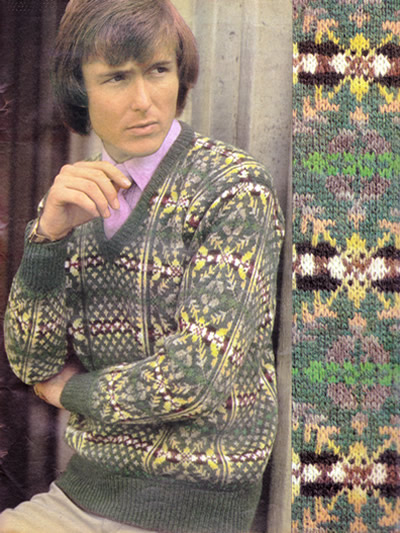
A fairly timeless design for a man's Fair-Isle sweater in lovely muted shades of Shetland wool. As I love this kind of colourwork, and I love men's fashions, it's definitely a hit with me - a lovely gift for a (very) deserving man...
Instructions:The pullover is given in one (medium man's) size and is worked using the Fair-Isle technique, with colours not in use stranded loosely across back of work. ChartsThe charts are included with the pattern instructions below, but for a larger version of the charts you can right click on the icon below and choose "save link as" or "save target as" (browser dependent options) to download and save a pdf file. BackUsing No 12 (2¾mm) needles and main shade yarn cast on 175 stitches, and work 3 inches in k1/p1 rib. Change to No 11 (3mm) needles, and work 2 rows in stocking stitch. Continue in stocking stitch, working the pattern from the chart thus: reading knit rows from right to left and purl rows from left to right. Work the 87 pattern stitch repeat twice across.
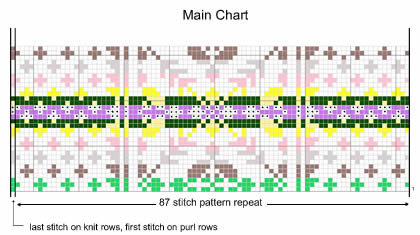
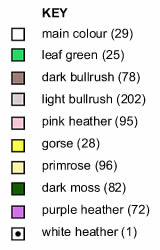
Continue working rows from the chart until the 12th row of the 4th pattern repeat has been completed. ** Armhole shaping: cast off 13 stitches at the beginning of the
next 2 rows. FrontWork as for the back until **. Armhole and neck Shaping: Repeat the last 2 rows until 61 stitches remain, then decrease in the
same way at the neck edge on every 4th row until 52 stitches remain. Join wool to inner (neck) edge of the remaining stitches. SleevesBegin at the top of the sleeve. Using No 11 (3mm) needles and main shade yarn cast on 135 stitches. Knit one row. Beginning with the 16th row of the chart (a purl row worked from left
to right), work thus:
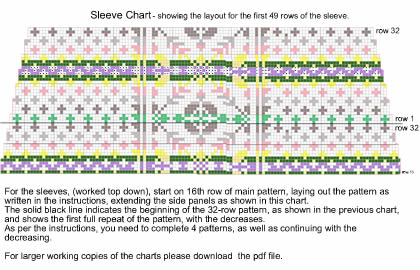
Continue in pattern as set, decreasing 1 stitch at each end of every
5th row until 87 stitches remain. Continue with main shade only and work 3 rows in stocking stitch. Change to No 12 (2¾mm) needles and work 3 inches in rib as for the back. Cast off ribwise. NeckbandJoin right shoulder seam. Using No 12 (2¾mm) needles and main shade, pick up and knit 54 stitches down left front neck, 1 stitch from centre front, 54 stitches up right front neck, and 50 stitches across back neck. [159 sts] Work 10 rows k1/p1 rib, decreasing 1 stitch each side of the centre front
stitch on every row, then work 10 rows k1/p1 rib, increasing 1 stitch
each side of the centre front stitch on every row. To Make UpPress parts lightly under a damp cloth. |
|
Materials Shetland 2 ply jumper weight (fingering yarn): A pair each No 11 (3mm) and No 12 (2¾mm) needles. Tension32sts x 32 rows to 4 inches over Fair Isle stitch. Size mattersChest to fit one size: 40-42 inches. Abbreviationsk2tog/p2tog: decrease by knitting/purling 2 sts together. stocking stitch: one row knit and one row purl, ("stockinette"). A word on the woolOriginal yarn "Real Shetland Knitting Wool 2 ply jumper weight"
stated as available from a supplier in Edinburgh is likely to be the 2
ply jumper weight from Jamieson
and Smith. It's a 4 ply equivalent specifically designed for Fair
Isle knitting, and is available in 25g balls from a number of different
suppliers in an extensive range of colours. Disclaimer
|

Adorable winter coatigan and bonnet set for a child.
Instructions.Instructions for 2 sizes, larger size in brackets. COATThe body of the coat is made in one piece beginning at the bottom edge. With larger size needles and white colour, cast on 186 (204)
stitches, and, using the blue colour, work in stocking stitch until the work measures
9 (13 ) inches. Coat BackContinue on the centre 94 (104)stitches for the Back only. Shape armholes by decreasing: for size 1: decrease 1 stitch at the beginning of the next 8 rows, (for size 2: decrease
1 stitch at each end of the next row once, then the following 4th row
once, then the following alternate row once, and finally the following
4th row once). Coat - Right Front:With right side facing, pick up 46 (50)
stitches for the on the right and shape the armhole. Leave all 42 (46) stitches remaining on a holder. Coat - Left Front:Work the left front the same as the right front, reversing all shapings. Sleeves (make 2):With smaller size needles and blue colour, cast on 38 stitches and work
1¼ inches in k1/p1 rib. Continue without shaping until work measures 6¾ (8¼)
inches. Yoke:With larger size needles in blue colour, pick up the 278 (300) stitches from the holders: 42 (46) stitches from the right front, 54 (56) stitches from the right sleeve, 86 (96) stitches from the back, 54 (56) stitches from the left sleeve, and finally, 42 (46) stitches from the left front. With right side facing, work 2 rows in stocking stitch decreasing 8 stitches
at the armholes on the first row as follows: The next row decreases a number of stitches evenly across each section of the yoke - work the two sizes as follows: SIZE 1 only Next row (decrease): (k1, k2tog,
k2tog, k1, k2tog) 5 times, k1; SIZE 2 only Next row (decrease): (k1,
k2tog) 15 times; Next row: purl.
Both sizes: work row 1-4 rows from chart 1 starting with a knit row.

SIZE 1 only: SIZE 2 only: Next row 5 (decrease): Using
blue yarn: k8, *
k2tog, k6, repeat from *
26 times, k3. [193 sts] Both sizes: work 7 rows from chart 2 starting with a purl row.

SIZE 1 only: SIZE 2 only: Next row 15 (decrease): Using blue yarn: k7, * k2tog, k4, repeat from * 27 times, k4. [146 sts] Both sizes: work 2 rows from chart 3 starting with a purl row.

SIZE 1 only: SIZE 2 only: Next row 18 (decrease): Using
blue yarn: p6, *
p2tog, p4, repeat from *
23 times, p2. [123 sts] Both sizes: work 6 rows from chart 4 starting with a knit row.

SIZE 1 only: SIZE 2 only: Next row 27 (decrease): Using blue yarn: k2, * k2tog, k2, repeat from * 25 times. [77 sts] Both sizes: work 4 rows from chart 5 starting with a purl row.

Both sizes: purl 1 row in blue, decreasing one stitch at the centre of the work. [60 (76) sts] Place the remaining stitches on a stitch holder. Coat border:Remove the strand of white at the bottom of the work, picking up the
stitches as you go. Work 4 rounds of stocking stitch (every round knitted) and on the 2nd
round on right front edge, make 3 buttonholes 2 stitches wide: cast off
2 stitches, then on the third round, cast on 2 stitches over the spaces. On the 5th round, work 1 round of eyelets: Work a further round, then make 3 buttonholes at same places as first 3 buttonholes. Work a further 2 rounds then cast off all stitches. Finishing the coat:Sew armhole and sleeve seams. |
MaterialsDouble Knitting yarn: Coat: 3 (4) x 50g balls in blue colour plus 1 ball in white. Bonnet: 1 ball in each colour. One pair each of 3mm and 3½mm (or 3¾mm) needles. 3½mm (or 3¾mm) circular needle. Tension23sts x 30 rows to 4 inches Size matters1 / 2 years Abbreviations:k2tog: decrease by knitting 2 stitches together A Word on the Wool.Original yarn was a double knitting with 50/50 wool/acrylic mix and approximately 125m to 50g. Disclaimer
|
BONNETWith larger size needles and blue colour, cast on 89 stitches. On the 5th row, work eyelets: Continue in stocking stitch, and when work measures 1¼ inches, begin the fair-isle pattern following the 35 rows on the chart given at the end.
Then shape the back of the hat by casting off 30 stitches at each
edge of next row. You now have 29 stitches.
Continue on the centre 29 stitches in blue colour, decreasing 1 stitch
at each end of every 4th row 6 times. Finishing the bonnet:Fold the border along the row of eyelets to form the picot edge, and
sew a hem. To make the chin strap, cast on 25 stitches (left side of work, right
side of bonnet), and work 4 rows in k1/p1 rib. On the 2nd make 1 buttonhole
2 stitches wide, as on the coat, placing it 4 stitches from the end of
the strap. Bonnet Chart |
|

Having spent years making tongue-in-cheek comments about knitted trousers, I find they seemed to become a kind of pandemic fashion item - safely out of site during Zoom meetings. I'm not sure the fashion was really for anything like hand-knitted trousers; however, sitting (unobserved!) in my poorly-insulated chilly office at the top of the house, cosy woollen trousers are taking on some kind of appeal.
Even if the trousers don't appeal, there is a rather nice matching low-belted long-line cable sweater - very much of the period.
Instructions. 3 sizes - larger sizes are given between brackets - Jumper BackUsing No 10 (3¼mm) needles, cast on 94 (106,
116) stitches and work 11 rows in k1/p1 rib.
Change to No 8 (4mm) needles and pattern: 1st row (right side facing): k5 (4, 1);
[p4, k4] one (two, three)
times; * p2, k9, p2, [k4, p4] twice,
k4; repeat from * once, p2, k9, p2,
[k4, p4] one (two, three)
times, k5 (4, 1). These 8 rows form the pattern. Continue in pattern until work measures 16 inches from the beginning, ending with a wrong side row. Shape Armholes: * Continue without further shaping until work measures 7 (7½, 8) inches from start of armhole shaping, ending with a right side row. Shape Shoulders: With wrong side of work facing, join in yarn at the neck edge and work
to end. Jumper FrontFollow instructions for Back from *
to *. Shape Neck: Shape Shoulder: Shape Shoulder: Jumper SleevesUsing No 10 (3¼mm) needles, cast on 52 (54,
56) stitches and work 15 rows in k1/p1 rib. Change to No 8 (4mm) needles and rib pattern. These 2 rows form the pattern. Shape Top: Jumper Shoulder EdgingUsing size 10 needles, cast on 11 stitches. 1st Buttonhole row: Rib 4, cast off
3, rib to end. Jumper Neckband Using a back stitch, join right shoulder seam. Next row (wrong side facing): p1,
* k1, p1, repeat from *
to end. Continue in rib, making a third buttonhole 1¾ (2,
2¼) inches from base of previous buttonhole.
Jumper BeltUsing No 10 needles, cast on 13 stitches. Belt Tabs (Make 4): Using No 10 needles, cast on 7 stitches. Making Up JumperUsing a back stitch, join side and sleeve seams. |
Materials
|
Trousers Right LegUsing No 8 (4mm) needles, cast on 121 (129,
137) stitches and work 9 rows stocking stitch,
(1 row knit, 1 row purl). Commence pattern: 1st row (right side facing): k53
(57, 61);
p2, k9, p2; k55 (59, 63). These 8 rows form the pattern. Keep continuity of cable panel: Next row: k2tog, work to last 2 stitches,
k2tog. [113 (121, 129)
sts] Trousers Left Leg Using No 8 (4mm) needles, cast on 121 (129,
137) stitches and work 9 rows stocking stitch,
(1 row knit, 1 row purl). Commence pattern: 1st row (right side facing): k55
(59, 63);
p2, k9, p2; k53 (57, 61). These 8 rows form the pattern. Keep continuity of cable panel: Next row: k2tog, work to last 2 stitches,
k2tog. [113 (121, 129)
sts] Next row: Work to last 2 stitches,
k2tog. [110 (118, 126)
sts] Trousers Waistband Using backstitch, join front and inside leg seams. Making Up TrousersSew in zip to centre back seam, placing top of zip in line with base
of waistband, then join |
|
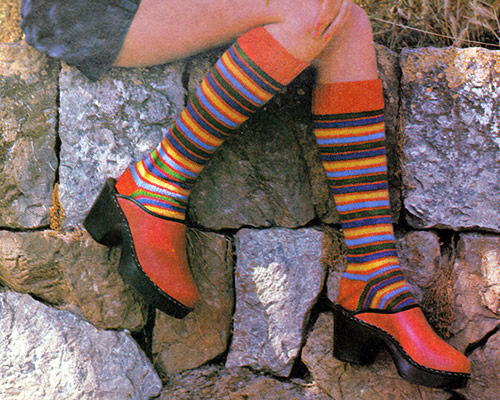
These socks are made using 2 needles, with one main colour and 4 contrasts. Of course, you can have as many contrasts as you like, and it would be good for using up lots of bright leftovers yarns; however it's always good to have a consistent main colour to tie it all together.
Alternatively you could easily substitute a suitably cheerful self-striping yarn either for the contrast stripes, or used plain throughout, allowing it to do its thing.
whatever you choose, complete the look with clogs*.
Just the thing to jazz up your jeans. Make them with or without toes — and the brighter the better!
* note: if you knit separate toes, it might be a bit overcrowded in clogs...
Instructions.The socks are worked on two needles. Right Leg** Using No 11 needles and colour A, cast on 80 stitches. Join in colour B. Beginning with a knit row, continue in stocking stitch,
(1 row knit, 1 row purl), working in striped sequence of 4 rows B, 2 rows
A, 4 rows C, 2 rows A, 4 rows D, 2 rows A, 4 rows E and 2 rows A throughout.
Shape leg:Next row: k1, sl1, k1, psso; knit to the last 3 stitches k2tog, k1. Keeping striped sequence correct. Continue in this way, decreasing 1
stitch at each end of every following 6th row until 60 stitches remain. Divide for heel and instep With right side of work facing, slip the first 15 stitches on to a stitch
holder for the heel. InstepWork 6½ inches (16½cm) in the striped sequence for the instep, ending with 2 rows in colour A (wrong side row). Editor's note: Now you need to decide if you want "normal" socks, or socks with separate toes - useful for bar-toe sandals! - and if you are knitting toes then you leave the stitches on a stitch holder at this point while you continue to knit the heel. Shape instep top without toes ("normal" sock) Next row: Using colour A throughout,
k1,sl1, psso; knit to the last 3 stitches, k2tog, k1. Version including toesBreak off yarn and leave the stitches on a holder while you continue with the instructions to shape the heel. Shape heelEditor's note: heel shaping instructions for both versions of sock, with or without toes. Slip the 30 stitches you previously left on holders on to the needle,
placing the outside edges together in the middle. Using colour A and with right side of work facing, shape the heel, working short rows as follows: 1st row (right side facing): sl1
knitwise, k28. Turn. Continue in this way, working one stitch less on every row until you have worked the row: "sl1 purlwise, p13. Turn." has been completed, leaving 8 stitches unworked at each side. Next row: sl1 knitwise, k13. Pick
up the loop lying between Shape sole top without toes ("normal" sock)Shape the top by working exactly the same as for the instep shaping. ** Version including toesHaving completed the heel, return to the instep stitches that you left on a holder. Big toe:
Next row: Using colour A, knit across
instep stitches, then knit 10 stitches from the sole. Turn, and cast on
2 stitches. Using A throughout, and working on these 24 stitches, work 16 rows in stocking stitch. Shape top: Second toeWith right side of work facing, using the right hand needle and colour
B, pick up 3 stitches at the base of the big toe. K5 stitches. Turn, and
cast on 2 stitches. Using B throughout, and working on these 17 stitches, work 14 rows in stocking stitch. Shape top: Third toeWith right side of work facing, using the right hand needle and colour
C, pick up 3 stitches at the base of the second toe. Using C throughout, and working on these 17 stitches, work 12 rows in
stocking stitch. Fourth toeWith right side of work facing, using the right hand needle and colour
D, pick up 3 stitches at the base of the third toe. K4 stitches. Turn,
and cast on 2 stitches. Using D throughout, and working on these 15 stitches, work 12 rows in stocking stitch. Shape top: Little toeWith right side of work facing, using the right hand needle and colour
E, pick up 3 stitches at the base of the fourth toe. Knit to end. Turn. Using E throughout, and working on these 15 stitches, work 10 rows in
stocking stitch. Left LegWork as for right leg from ** to
**. Version including toesSet the position of the toes for the left foot as follows: Big toe: Next row: Using colour A, knit across
the sole stitches, then knit 10 stitches from the instep. Turn, and cast
on 2 stitches. Complete the big, second, third, fourth, and little toes, as given for
the right leg. Making upOmitting ribbing, press parts lightly under a damp cloth with |
Materials3 x 25g balls of 4 ply yarn in main shade (A) and 1 ball in each of 4 contrast colours (B, C, D, and E). One pair of No 11 (3mm) needles. Tension30 sts x 40 rows to 4 inches over stocking stitch on No 11 (3mm) needles. Size mattersTo fit and "average" adult foot: 9/9½ inches (23/24cm).
Length from top of heel: 13½ inches (34½ cm). Abbreviationssl1: slip the next stitch k2tog or p2tog: work 2 sts together to decrease. A Word on the Wool.Original yarn was a superwash 4ply. These days there is a huge choice of wool for socks, but I would recommend some nylon content. Disclaimer (well...almost)In transposing any pattern it is always a risk that errors will be introduced, in spite of dedicated proof reading. If you have any problems with this pattern, please and I will try and assist. |

A sixties dress in crochet - which is apparently one of the trends for the season. The simple lacy-look design is worked in light weight yarn over a four-row pattern.
Personally I have a slight prejudice that it can be a bit thick and heavy for summer wear - however the catwalks featured "jumbo" crochet items - so - time to sacrifice all for fashion!
On the plus side, crochet is a speedy technique, meaning that items are highly suitable for you to make for yourself in a reasonable time frame.
Instructions.The dress is given for 3 sizes - larger sizes in brackets - which once again only go up as far as a 38 inch chest. The yarn required is a 4 ply fingering weight, but you could experiment with the tension using a DK soft cotton and a larger hook, which would tend more towards the "jumbo" nature of the designer version. Back and Front (make 2 alike)Using No 11 (3mm) hook make 141 (150 : 159) chain. 1st row: 1 dtr in 6th chain from
hook, * miss 2 chain, 1 dtr in each
of the next 4 chain, miss 2 chain, (1 dtr, 2 chain, 1 dtr) - referred
to as 1 group - in next chain; repeat from *
to end. Continue in pattern until work measures 7 (8
: 9) inches. Armhole Shaping: Continue in pattern until work measures 32½ (33½ : 34½) inches, ending with a 3rd pattern row. Neck and Shoulder shaping: Miss 6 (7 : 8) complete patterns and 1 group; join in yarn and complete to match the other side. To Make UpPress work with a warm iron over a damp cloth. Edging: Work in rounds around neck, armholes and lower edge. Fasten off. For an excellent round-up of SS22 trends on the catwalks review the items at Wardrobe Icons. Crochet dress, seen here in Tod's sixties-inspired jumbo crochet shift. 
|
Materials4ply fingering yarn: Nos 11 (3mm), 12 (2¾mm), and 13 (2¼mm) crochet hooks. Tension2 patterns to 3 inches on 3mm hook. Size mattersTo fit chest: Abbreviationsch: chain A word on the wool.Original yarn was pure wool crepe 4 ply - crepe being good for crochet
as the yarn tends to resist splitting. Disclaimer
|

An easy ribbed slipover for breezier summer days.
Instructions.The main pattern stitch is named as "beaded rib" worked as follows: 1st row and all odd rows (right side facing):
knit BackWith smaller sized needles, cast on 134/140/146/152/158
stitches, and work 2¾ inches in k1/p1 rib. Change to larger needles and work in the "beaded rib" stitch until work measures 14/14/14½/15/15½ inches. Shape armholes, by casting off 3 stitches at the beginning of the
next 4 rows; then cast off 2 stitches at the beginning of the next 4/4/4/6/6
rows; then decrease 1 stitch at each end of the next, and following
4/5/6/5/6
alternate rows. Continue in pattern as set until work measures 22/22½/23½/24½/25½ inches. Shape shoulders and back neck as follows: Cast off 10/9/10/11/11 stitches at the beginning of the next 2 rows. Next row: cast off 9/10/10/10/11,
k18/9/10/11/11,
cast off centre 28/30/32/34/34,
knit to end. Next row: cast off 10 at the neck
edge, knit to end. With wrong side facing, rejoin the yarn to the right back at the neck edge and cast off 10 at the neck edge, purl to end. Turn and cast off the remaining 9/10/10/10/11 and fasten off, thus completing the right shoulder. FrontWork as for back up to the start of the armhole shaping when work measures 14/14/14½/15/15½ inches. Start the armhole shaping, by casting off 3 stitches at the beginning
of the next 4 rows; then cast off 2 stitches at the beginning of the next
4/4/4/6/6
rows. Divide for neck by continuing on the first half of the stitches only and placing the remaining half of the stitches [57/60/63/64/67 sts] on a spare needle. Keeping the pattern correct, decrease 1 stitch at the armhole edge on the next and following 4/5/6/5/6 alternate rows, and, at the same time, decrease 1 stitch at the neck edge on every 5th row 24/25/26/27/27 times. [28/29/30/31/33 sts] Continue straight until work measures 22/22½/23½/24½/25½ inches, then shape shoulders by casting off at the armhole edge on every alternate row, 10/9/10/11/11 stitches once, and 9/10/10/10/11 stitches twice. Rejoin the yarn to the stitches on the spare needle and work the other side of the neck to match, reversing the shapings. To Make UpJoin the shoulder seams. Neck Border: Armhole borders: Sew side seams including the armhole border seams. |
Materials4 ply yarn: Pair each of No 12 (2¾mm) and No 10 (3¼mm) needles. No 12 (2¾mm) double pointed needles or circular. Tension28sts and 60 rows to 4 inches on 3¼mm needles over "beaded
rib" stitch. Size mattersFinished chest measurement: Abbreviations k: knit A word on the wool.Original yarn was an acrylic yarn with a yardage of about 170m per 50g ball. You can use a 4 or 5 ply yarn for this loose fitting design, but check your tension and alter the needle size if necessary. Disclaimer
|

This sweater from the end of the 1970s is a presage of the style that became so ubiquitous in the 1980s - the oversized unisex sweater with drop shoulders and no shaping. It is very simply constructed with wide squared off sleeves and no armhole shaping on the body. The neck opening is formed from a vertical slit, rather like a poncho - all very simple.
This is one of my favourite types of sweater - really long and slouchy with a deep welt - suitable to wear with narrow trousers or leggings. [Clearly I belong in the 1980s.] In addition, the stitch used is an openwork lacy pattern which I find very satisfying to knit. In fact, this particular sweater looks so very long, I might be tempted to knit it shorter for myself (I am not very tall) to keep the style of a tunic rather than a dress.
...the length is mini-skirt, the style blouson. Surprisingly easy to knit, this feminine open lace stitch sweater worked on large size needles adds new dimensions to a sporty Aran...
Instructions.The pattern is written for one size only, and at 34 to 38 inches this might be a bit of a limitation. It is designed to be oversized, so the actual measurement should come out at about 41 inches if you achieve the stated tension. [Editor's note: I can see why they would have had difficulty providing a sensible larger size, as the lace pattern is repeated over 34 stitches - so if you added another repeat it would increase the size by at least 12 inches. Having said that, many oversize sweaters, both in the eighties and now, are designed to be in excess of 50 inches as a supposed "one size", and it would be a moderately feasible task to redraft the pattern, due to the lack of shaping - if you had the appetite for it.] Front** With 4mm needles, cast on 88 stitches. 1st row: p1, k2, *
p2, k2; repeat from * to last stitch,
p1. Next row: p6, increase in the next stitch, * p4, increase in the next stitch; repeat from * to the last 6 stitches, p6. [104 sts]. Change to No 5½ mm needles and work in pattern as follows: 5th - 12th rows: Repeat 1st to 4th
rows twice. 17th - 24th rows: Repeat 13th to
16th rows twice. Next row: Pattern 52 stitches, M2, pattern to end. Divide for neck as follows: With wrong side facing, rejoin yarn to remaining stitches at the centre
neck edge, and finish to correspond with first side. BackWork as for Front from ** to **. Divide for neck as follows: With wrong side facing, rejoin yarn to remaining stitches at the centre
neck edge, and finish to correspond with first side. SleevesWith 4mm needles, cast on 36 stitches and work in rib as for Front for
4 inches (10cm), ending with a 1st row. To Make UpOmitting ribbing, press lightly on wrong side following instructions
on the ball band. |
Materials
|
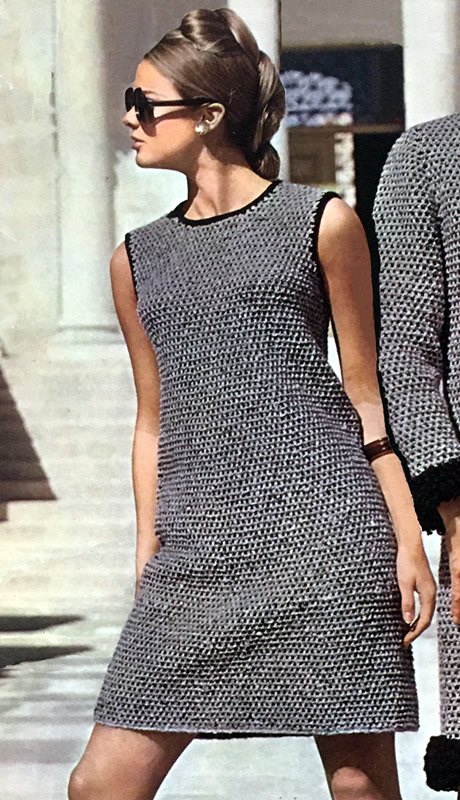
This wasn't my original choice for this month, but recently I have noticed a trend for monochrome wool dresses in some fashion articles. Not too hard to knit as the two-colour effect is formed by slipping stitches - so only one colour in any one row.
Instructions.A tweed dress in 3 sizes (small/medium/large). Back** 1st row (right side facing): Purl
in L - do not break yarn L. These 8 rows form the pattern. Work straight until back measures 3 inches, ending with a 4th or 8th
pattern row. Work straight until back measures 6 inches, ending with a 4th or 8th
pattern row. Work straight until back measures 9 inches, ending with a 4th or 8th
pattern row. Work straight until back measures 12 inches, ending with a 4th or 8th pattern row. Continue in this way, decreasing 4 stitches on every 1st or 5th pattern row at 3 inch intervals, until 97/103/109 stitches remain. Work straight until back measures 29½ inches down centre, ending
with 2nd or 6th pattern row. Work a few rows straight until back measures 31/31½/32 inches, ending with right side facing. Here divide for back opening: Continue straight on these 37/38/41
stitches for first side, until back measures 36½/37/37½
inches. With right side facing, rejoin wool to remaining stitches, cast off the centre stitch, then finish to correspond with first side, reversing shapings. FrontWork as for back from ** to **
. Work straight until front measures 34/34½/35 inches, ending with right side facing. Here divide for neck: Next row: pattern 28/29/30,
turn, and leave remaining 47/50/53
stitches on a spare needle. Continue on these stitches for first side, decreasing 1 stitch at the neck edge on the next and every alternate row until 20/21/22 stitches remain. Work a few rows straight until front matches back at armhole edge, ending with right side facing. Shape shoulder as given for back. With right side facing, rejoin wool to the remaining stitches, cast off
the centre 19/21/23
stitches, and pattern to end. To Make UpPress parts or block lightly on the wrong side under a damp cloth. Neck Facing: Armhole Facing: Join side seams. |
MaterialsDouble knitting: Pair each of 6 inch zip. Tension22sts to 4 inches on 4mm needles over pattern. Size mattersTo fit chest: Abbreviations k: knit A word on the wool.Original yarn was pure wool in a standard DK weight. Disclaimer
|
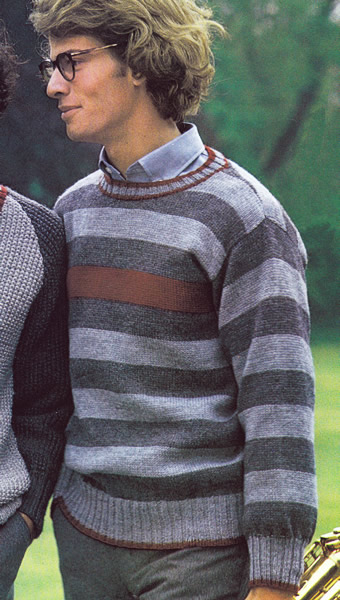
well... they prefer... grey if my experience is anything to go by (whether it's 50 shades or maybe just 2); even the muted coloured stripe is a risk. However, colour choices are easily adapted to the taste of the wearer, and in my case: I love stripes (both wearing and knitting them), whatever the colours.
Otherwise - the greys have it.
Instructions.A man's plain loose sweater in 3 sizes (small medium and large). BackUsing No 11 (3mm) needles and red contrast colour (R), cast on 118/122/126
stitches, and work 3 rows k2/p2 rib. Break yarn. Change to No 9 (3¾mm or 3½mm) needles and join in dark grey
contrast (G) to start working the striped stocking stitch pattern, increasing
2 / 3 / 4
stitches, evenly across the first row. After the first 12 rows of the seventh stripe (which is in in colour G), shape the armholes by casting off 9/10/11 stitches at the beginning of the next 2 rows. [102/105/108 sts]. Change to colour R and work 14 rows for the 8th stripe. Change to colour G and continue in striped stocking stitch alternating
between colours G and M. Cast off 9 stitches at the beginning of the next 2 rows. With wrong side facing, rejoin the yarn to the right back at the neck edge and purl 8/9/10. Turn and cast off the remaining 8/9/10 and fasten off, thus completing the right shoulder FrontWork as for back until work measures 23¼ / 23½ / 24 inches. Keeping continuity of the striped pattern shape neck as follows: At the beginning of the next row cast off 4 stitches. Then at the neck edge on every following alternate row, cast off: 3 stitches once, 2 stitches 3 times, and 1 stitch 4 times. [26/27/28 sts]. Continue straight on these stitches until front matches back to the shoulder.
With wrong side facing, at the armhole edge, shape shoulder by
casting off 9/9/9
stitches on the next and following alternate row. Knit 1 row and then
cast off the remaining 8/9/10
stitches. With wrong side facing, return to the stitches for the right side of
the front, rejoin the yarn to the neck edge, and cast off 4 stitches,
purl to end. Then at the neck edge on every following alternate row cast
off: 3 stitches once, 2 stitches 3 times, and 1 stitch 4 times. [26/27/28
sts]. SleevesUsing No 11 (3mm) needles and red contrast colour (R), cast on 66/70/74
stitches, and work 3 rows k2/p2 rib. Break yarn. With right side facing, change to No 9 (3¾mm or 3½mm) needles
and join in contrast to start working the striped stocking stitch pattern,
increasing 18/19/20
stitches, evenly across the first row. Increase 1 stitch at each end of every following 10th row, 11 times.
Continue until work measures 20 / 20¾
/ 21½ inches from the beginning, [Editor's
note: This should be 126/128/140
rows in stocking stitch.], which should be an exact number of stripes,
ending with the darker grey colour G - for the second (medium) size you
should work 16 rows in colour G on this last stripe. To Make UpPress parts or block lightly under a damp cloth, avoiding ribbing. Neck Border: Sew in sleeves. [Editor's
note: The instructions are not explicit on this point but as the top of
the sleeve is a straight edge, I would be inclined to sew it to the straight
edge of the armhole, and sew the top half inch of the side of the sleeve
to the cast off stitches of the armhole.] Diagram showing dimensions for smallest size:
|
MaterialsDouble knitting yarn: Pair each of Tension22sts x 30 rows to four inches on 3½mm needles over stocking stitch.
Size mattersTo fit chest: Abbreviations k: knit A word on the wool.Original yarn was mixed fibre double knitting equivalent. Disclaimer
|
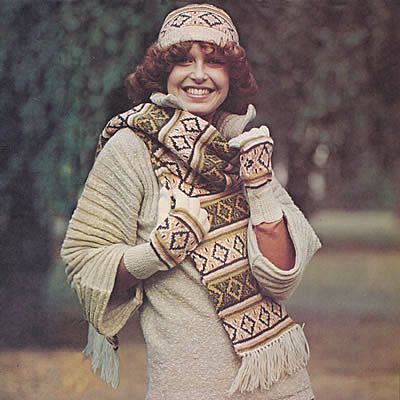
A "long, long" scarf worked in bands of stripes and jacquard pattern, with a matching pull-on hat and gloves to complete the set. These are all knitted in a lighter weight yarn, but the scarf is double thickness so will be very snug; it's also pretty long, so check that's what you want, as obviously you can make it to whatever length you like.
InstructionsThe scarf is worked on 4 needles in the round to make a tube, which is then flattened; the result is a flat scarf with two layers of knitted fabric, and means you don't have to worry about seeing the "wrong side" of the knitting. This is a standard way to make - especially commercial - scarves. Although often seen made in the round, both the hat and the gloves are worked flat on two needles, with a seam making them into the required round shape. It would be simple enough to adapt this pattern and make the hat in the round, especially as you have the method given for the scarf. If this is your first attempt at gloves, however, making them flat may be a good way to start. ScarfUsing the set of 4 No 10 (3¼mm) needles - or the circular needle
- cast on 112 sts in Main Shade (A). Pattern as follows: ** 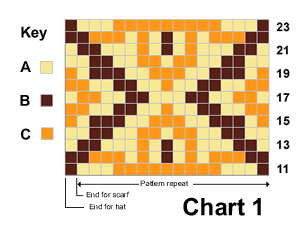 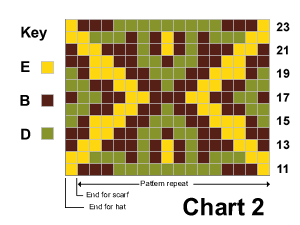 These 46 rounds form the pattern. Cast off using A. To make up the ScarfDarn in all ends on the wrong side. HatUsing No 12 (2¾mm) needles, and main shade A, cast on loosely 144
stitches. Work 20 rows K1/P1 rib, increasing 1 stitch at the end of the
last row. [145 sts] Continue in pattern until work measures 18cm (7 inches) from the beginning, ending with a purl row. Shape the crown Decrease for the crown, keeping the continuity of the striped pattern: To make up the HatPress as given for the scarf. GlovesNote: When working the gloves, use separate balls of yarn for the palm and thumb, twisting the yarns at the back of the work when changing colours. Right hand gloveUsing No 12 (2¾mm) needles and main shade A, cast on 56 stitches.
Start thumb shaping: 1st row: using first ball of B, k28;
using A, increase one stitch in each
of the next 2 stitches, k1; using a 2nd ball of B, k25. Continue in pattern as given for chart, increasing the thumb stitches
as before on the 3rd and then every foil 4th row until the 24th row has
been completed, decreasing one stitch at the end of the last row. 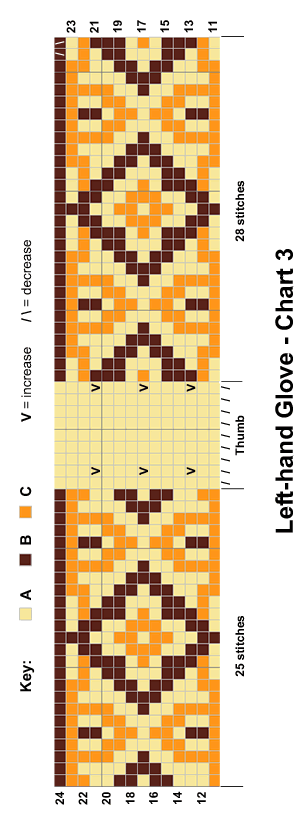 Thumb: Next row: using B, k28; using A,
k16 stitches; turn and cast on 2
stitches. [Editor's note: For this method you keep all the stitches on the needles as you work the thumb and each finger separately. At this point for the thumb, you keep 28 stitches unworked on the right hand needle, and 25 stitches unworked on the left hand needle, while you work on the centre 16 stitches (which you have increased to 20 by casting on 2 extra stitches on each side. You knit the thumb flat, back and forth up to the tip, then you fasten off and sew it up into the thumb shape.] Shape top: With right side of work facing and using B, knit up 4 stitches from the
base of the thumb, knit to end. [57 sts]
Divide for fingers: 1st finger Shape top: 2nd finger 3rd finger 4th finger Shape top Left hand gloveWork as given for right hand glove, reversing the pattern and the position of thumb as follows: 1st row: using 1st ball of B, k25;
using A, increase one stitch in each of Continue as given for right hand glove until 24th row of pattern has been completed. Thumb Next row: using B, k24; using A,
k16, turn and cast on 2 stitches. Complete as given for right hand glove working from *** to ***. To make upPress as given for scarf. |
Materials25g balls of 4 ply (fingering) yarn: Scarf: 4 balls in main shade A One set of 4 3¼mm (UK 10) double pointed needles (dpn), or a circular needle. Hat and gloves: One pair of 3mm (UK 11), and one pair of 2¾mm (UK 12) needles Tension28sts x 36 rows to 4 ins over stocking stitch on 3¼ mm needles. Size mattersScarf: 20½ cm (8 inches) wide, by 183cm (72 inches) long,
excluding the fringe Abbreviationsk2tog: knit 2 sts together. increase: by knitting into the front and back of the next stitch A word on the wool.The original yarn was standard 4 ply superwash wool; about 92 yards (84 m) per 25g ball. Disclaimer
|

The cutest hooded gown made in a soft chunky yarn - perfect for bedtime, (or other occasions, as it is described as a "coat"). The lower section has a design of kittens - and there is a cute toy cat to match.
InstructionsThe pattern is given in 3 sizes: 12 (18
: 24) months. Where only one set
of instructions is given it applies to all sizes. SleevesWith 5mm needles and main colour (M), cast on 22 (24
: 26) stitches and work 3 (3
: 4) cm in k1/p1 rib, ending with
wrong side facing for next row. Now change to 6mm needles and stocking stitch following the Fair Isle colour pattern in the chart for the sleeve:

For the first size, begin with 1 stitch in black (B) then 1 in main shade
(M); for the second size, begin with 1M, 1B,
1M; for the third size, begin with 4M,
1B, 1M, 1B, 1M. Leave the stitches on a stitch holder or spare needle and work a second sleeve in the same way. Body (knitted as a single piece)Using size 5mm needles and main colour (M), cast on 113 (121 : 129) stitches and work 6 rows in garter stitch. Change to 6mm needles and work 2 (2 : 6) rows in stocking stitch. Continue stocking stitch and follow the Fair-Isle pattern working from the charts.

Work 2 rows as in Chart 1, commencing with 1M, 1B, then repeating the 8 stitch pattern across the row ending 1M, 1B, as indicated.

Now work the 19 rows of the cat pattern from Chart 2, 4 times across the row, placing 3 (5 : 7) stitches between each group, and working 2 (3 : 4) stitches in main shade before the first and after the last group.

Work 2 rows as in Chart 3, commencing with 2M, then repeating the 8 stitch pattern across the row ending 1B, 1M, as indicated. Work 4 rows in stocking stitch.

Work 4 rows in stocking stitch. Repeat the 2 rows as in Chart 3, as before, (commencing with 2M, then repeating the 8 stitch pattern across the row ending 1B, 1M, as indicated). Work 3 (2 : 2) rows in stocking stitch, and (wrong side facing) work 4 rows in garter stitch. At this point you have completed 58 (64 : 68) rows and your work should measure 32 (35 : 38) cm. Now you must divide the work and continue knitting the back and fronts separately. Change to 5mm needles and work in k1/p1 rib as follows, casting off some stitches for the armholes, as well as decreasing across the row. Next (right side facing, decrease) row:
k2, (p1, k1) 3 (3
: 3) times, p1, k2tog, (p1, k1) 2
(3 :
4) times, p1, k2tog, (p1, k1) 3 (3
: 3) times, k1; place these 23
(25, 27 ) stitches
on a spare needle or stitch holder...
Upper Left FrontNext row (wrong side facing): p2, * k1, p1, repeat from * to last stitch, p1. [23 (25 : 27) sts] With right side facing, continue in k1/p1 rib for a further 19 (21
: 23) rows, then shape the neck
as follows: cast off 3 (4
: 4) stitches on the next row, then
2 (2 :
2) on the following alternate row. Continue to decrease at the neck edge, and shape shoulders as
follows: Upper Right FrontRejoin yarn to the right front section at the front edge. Next row (right side facing): k2, * p1, k1, repeat from * to last stitch, p1. [23 (25 : 27) sts] With wrong side facing, continue in k1/p1 rib for a further 19 (21
: 23) rows, then shape the neck
as follows: cast off 3 (4
: 4) stitches on the next row, then
2 (2 :
2) on the following alternate row. Continue to decrease at the neck edge, and shape shoulders as
follows: Upper Back sectionWith wrong side facing, rejoin the yarn to the remaining stitches in
the centre. Work a further 26 (28 : 30) rows in k1/p1 rib. Now shape shoulders and back neck by casting off 5 (5 : 6) stitches at the beginning of the next row. Next row (wrong side facing): cast
off 5 (5 :
6) stitches, rib 15 (17
: 19) (including the stitch already
on the needle), cast off 7 stitches, and rib to end. This completes the right side of the Back neck. Rejoin the yarn to the remaining stitches at the neck edge and, right side facing, rib one row. Next row (wrong side facing): cast
off 5 (6 :
6) stitches, rib 10 (11
: 12) (including the stitch already
on the needle). This completes the left side of the Back neck. Button BandUsing 5mm needles, cast on 65 (71 : 77) stitches in main shade (B), and work in k1/p1 rib for 5 rows, keeping the 2 stitches at each end of the row in stocking stitch - like this: Next row: k2,
* p1, k1, repeat from *
to last stitch, k1. And so on for 5 rows in all. Purl one row, then knit 3 rows in stocking stitch using waste yarn of a different colour. Leave these stitches on a spare needle or holder. Make a second (right hand) band in the same way, adding 3 button holes on the 4th row: 4th row: k2,
p1, k1, cast off 2, rib 10 (12
: 13), cast off 2, rib 10 (12
: 13), cast off 2, rib to end. Complete with 3 rows of waste yarn as before. HoodUsing 5mm needles, cast on 69 (73 : 75) stitches in main shade (B), and work in k1/p1 rib for 8 rows. Change to 6mm needles and work 11 (13
: 15) rows in stocking stitch. Wrong side facing, continue in stocking stitch, increasing 1 stitch at
each end of every 4th row 3 times. [21 (23
: 25) sts] Right side facing, continue in stocking stitch, decreasing 1 stitch at
each end of every 6th (6th
: 5th) row 3 (3
: 4) times. [15 (17
: 17) sts] To Make UpSew shoulder and sleeve seams up to the coloured markers. Sew the button band, stitch by stitch, to the right side of the work using back stitch, (undo the rows of waste yarn). Sew up the sides of the hood. Fold the front edge in half inwards and
sew round like a hem to make a channel to thread the cord through. Finish the buttonholes with embroidery if desired, and sew on buttons. |
Materials
|
MittensThis is a pattern for a very simple little pair of mittens in matching colours. The mittens are attached to a cord which is threaded through the armholes of a coat so that they can hang free at the ends of the sleeves if removed (and thus don't get lost). With 5mm needles and dark contrast colour (B), cast on 18 (18
: 20) stitches and work 3 cm in k1/p1
rib. Next row: k1, sl1, k1, psso, k4 (4
: 5), k2tog, sl1, k1, psso, k4 (4
: 5), k2tog, k1.
|
|




This drop-shoulder design cardigan in cheering Nordic colours is taken from a much-loved and much-handled pattern.
Instructions.Instructions are given for 3 sizes - the larger sizes are shown in brackets. When working the pattern weave the yarns not in use loosely across the wrong side of the work; do not strand the threads over more than 3 stitches at a time in order to keep the fabric elastic, joining in and breaking off colours as required. Back and Fronts (worked in one piece up to the armholes)With No 10 (3¼mm) needles and main shade (R), cast on 194 [206, 218] stitches and work as follows: 1st row: k2, *
p2, k2; repeat from * to end. These two rows form the rib. Work a further 31 rows. Next (increase) row: p9 [12, 4], m1, * p8 [7, 7], m1; repeat from * until p9 [12, 4] stitches remain; purl to end. {217 [233, 249] sts} Change to No 8 (4 mm) needles and join in white (W). Weaving in the yarns not in use, work the 2-colour pattern entirely in stocking stitch, beginning, on the right side of the work, with a knit row. Note: only the colours are specified below. 1st row (knit): 3R, *
3W, 5R; repeat from * ending the last
repeat with 3R instead of 5R.

These 8 rows form the 2-colour pattern. Work a further 59 rows, up to the armholes, ending with a 3rd pattern row. Divide to separate back and fronts: With red, (R) p51 [55,
59] stitches; increase in the next stitch
and leave these 53 [57, 61]
stitches on a spare needle or stitch holder to be worked later for the
left front; BackOn these 113 [121, 129] stitches work the 36 row 3-colour pattern, weaving in the yarns not in use at the back of the work. Once again, the pattern is worked entirely in stocking stitch beginning with a knit row so only the colour details are shown. Join in blue (B). 1st row (knit): 4R, *
1B, 7R; repeat from * until 5 stitches
remain; 1B, 4R. [Editor's note: Rows 21-36 are a repeat of rows 1-16 worked in exact mirror image so Row 21 is the same as row 16, row 22 is the same as row 15, and so on back to the first row the same as row 36..]
21st row: knit across all stitches
in white (W).

Break off blue and continue in the 2-colour pattern, beginning with the 3rd row. Work 10 [10, 14] rows. Slope shoulders: Cast off 7 [6,
8] stitches at the beginning of the next
2 rows, 7 [7, 8]
stitches at the beginning of the following 2 rows, then cast off 6 [7,
7] stitches at the beginning of the next
8 rows. Left FrontWith right side facing, rejoin the yarns to the the inner (armhole) end of the 53 [57, 61] stitches, and work in the 3 colour pattern as follows. 1st row (knit): 4R, *
1B, 7R; repeat from * until 1 [5,
1] stitches remain; 1B [(1B,
4R), (1B)] . These 4 rows set the position of the 3-colour pattern. Work a further 32 rows in pattern to match the back. Break off blue (B). With red (R) knit 1 row. To shape the neck: 1st row (purl, wrong side facing):
with red (R), cast off 9 [10, 11]
stitches, purl to end. ** Keeping continuity of the 2-colour pattern to match the main part, decrease 1 stitch at the neck edge on the next 5 rows — when working the right front read 6 rows here instead — {38 [41, 44] sts}. Pattern 2 [2, 6] rows. Slope shoulder: Cast off 7 [6,
8] stitches at the beginning of the next
row, then 7 [7, 8]
stitches at the beginning of the following alternate row. Right FrontWith wrong side facing, rejoin red (R) at the the inner (armhole) end, increase in the first stitch, and purl to end. {53 [57, 61] sts} Work in the 3 colour pattern as follows: 1st row (knit): 1B [(4R,
1B), (1B)], *
7R 1B; repeat from * until 4 stitches
remain; 4R. These 4 rows set the position of the 3-colour pattern. Break off blue (B). With red (R) work 2 rows. To shape the neck: 1st row (knit, right side facing): with red (R), cast off 9 [10, 11] stitches; knit k1R [(4R), (2W, 5R)]; * 3W, 5R; repeat from * until 2 stitches remain; 2W. Work as given for left front from ** to end, noting the variation. Sleeves (both alike)With No 10 (3¼mm) needles and main shade R, cast on 48 [48, 52] stitches and work 32 rows in double rib as for main piece. Next (increase) row: k4, m1, * k1, m1; repeat from * until 4 stitches remain;k4. {89 [89, 97] sts} Purl one row in red (R). Change to No 8 (4 mm) needles and work 72 rows in the 2-colour pattern as given on main piece (back and fronts). Work the 36 rows of the 3-colour pattern as given on back. With red (R) knit one row, then cast off. Button BandWith No 10 (3¼mm) needles and blue (B) cast on 13 stitches, and
work 158 [158, 162]
rows in k1/p1 single rib, beginning odd numbered rows with k1, and even
numbered rows with p1. Buttonhole BandWith No 10 (3¼mm) needles and blue (B) cast on 13 stitches, and work 6 [6, 10] rows in k1/p1 single rib, as given for button band. 1st (buttonhole) row: Rib 5, cast
off 3 stitches, rib to end. Repeat the last 26 rows 4 times more, then the 2 buttonhole rows again. Rib 19 more rows, leaving the stitches on the needle. NeckbandJoin shoulder seams. Using the No 10 (3¼mm) needles holding the 13 stitches of the buttonhole band, and continuing the last row, pick up and knit 23 [24, 27] stitches from right neck shaping, knit across 37 [39, 41] stitches from the back, increasing 3 stitches evenly across, pick up and knit 23 [24, 27] stitches from left neck shaping, and finally rib across the 13 stitches (from the safety pin) of the button band. {112 [116, 124] sts} 1st rib row: k1, *
p1, k1; repeat from * 5 times, k2;
** p2, k2; repeat from **
until 13 sts remain; p1, * k1, p1;
repeat from this last * to end. These two rows set the rib. Work 3 rows. 1st (buttonhole) row: Rib 5, cast
off 3 stitches, rib as set to end. Work 12 rows in rib as set, then work the 2 buttonhole rows again. Making UpPress parts lightly on wrong side with a warm iron over a dry cloth, or following any instructions on the ball band. Set sleeves into armholes, and join the sleeve seams. |
Materials 5 [5, 6]
50g balls DK in main shade (R) red, plus Pair each No 8 (4mm) and No 10 (3¼mm) needles. 7 buttons. Tension26 stitches x 27 rows to 4 ins (10cm) over the pattern on No 8 (4mm) needles. Size mattersTo fit chest 34 [36, 38]
inches, (86 [91, 97]
cm); Abbreviationsk2tog or p2tog: knit or purl 2 stitches together (decrease one stitch). stocking stitch: one row knit and one row purl, ("stockinette"). dec: decrease by working 2 stitches together. inc: increase by working twice into the same stitch. m1: make 1 stitch by picking up horizontal A word on the woolThe original design was in Patons Fiona - a yarn I was very fond of, both in quality and rich colour range. It was a standard DK; some information given on the web implies it was slightly thicker and others slightly thinner. In the 1970s it was sold in 50g balls: 175 yds/160m meters); 51% wool, 49% acrylic. In my opinion a similar substitute would be Rowan Felted Tweed DK. "Always check your tension" [Good Advice]. Disclaimer
|

Simply styled early sixties casual sweaters with separate instructions for her and for him. They are knitted in "triple knitting" yarn - a short-lived experiment by the yarn companies to introduce what is now the American "worsted" weight standard to British knitters. However, we were too much in love with our double knitting yarn - I mean that was bulky enough surely?!
However, owing to globalisation, we have now fully embraced worsted weight yarns which means we can easily find a good selection of yarn colours and fibre mixes to use with this pattern. [Failing that we always have Aran yarns to fall back on...]
|
The man's and womans versions are very similar - and similar in chest sizes offered as well. The changes are mainly to the proportion. However, the man's version has a set-in sleeve, while the woman's is more of square almost drop-shoulder - you can see this in the photo. I prefer the set in sleeve and if you are a woman of size 36-40 then it would be quite feasible to knit the man's sweater, adjusting sleeve and overall length to suit. Instructions for WOMAN's version.Instructions are given for three sizes with larger sizes given in bold or colour between slashes. Where one set of figures is given this applies to all sizes. Back and Front alike (knit 2)With No 8 (4mm) needles, cast on 80/86/92 stitches and work 2 inches in k1/p1 rib. Increase 5/7/9 stitches evenly across on last row. [85/93/101 sts] With right side facing change to No 4 (6mm) needles and work in pattern as follows: 1st row: *
p1, Cross2K, k1, p1, k3; repeat from *
to last 5 stitches; p1, Cross2K, k1, p1. These two rows form the pattern. Continue straight in pattern until work measures 15 inches down centre, ending with row 2. With right side facing shape armholes, by casting off 8 stitches at the beginning of the next 2 rows. [69/77/85 sts] Continue straight in pattern until work measures 21/21/21½ inches, ending after a first row with wrong side facing. Next row: purl, increasing 9 stitches evenly across the row by working twice into every 7th/8th/9th stitch. [78/86/94 sts] Change to No 6 (5mm) needles and continue in k1/p1 rib until work measures 24/24/24½ inches. With right side facing, shape shoulders, by casting off 11/12/13
stitches at the beginning of the next 4 rows. Work a further 6 rows in
rib on the remaining 34/38/42
stitches, increasing 1 stitch at each end of every row. SleevesWith No 8 needles, cast on 40/40/44 stitches, and work 2 inches in k1/p1 rib. Increase 5/5/9 stitches evenly across on last row. [45/45/53 sts] With right side facing, change to No 4 needles and work in pattern, shaping
sides by increasing 1 stitch at each end of the 5th/5th/9th
and every following 4th row until there are 83//83/89
stitches, taking the increased stitches into the pattern as they
are made. To Make UpIMPORTANT: Press parts on wrong side using a dry cloth
and cool iron. Join shaped ends of neck facing with flat seam, then turn under 6 rows
of the rib to the wrong side at the back neck and catch down loosely;
turn under rib in the same way across the front graduating the hem to
a depth of 12 rows at the centre front. Instructions for MAN's version.Instructions are given for three sizes with larger sizes given in bold or colour between slashes. Where one set of figures is given this applies to all sizes. Back and Front alike (knit 2)With No 8 (4mm) needles, cast on 90/96/102 stitches and work 2½ inches in k1/p1 rib. Increase 3/5/7 stitches evenly across on last row. [93/101/109 sts] With right side facing change to No 4 (6mm) needles and work in pattern as follows: 1st row: *
p1, Cross2K, k1, p1, k3; repeat from *
to last 5 stitches; p1, Cross2K, k1, p1. These two rows form the pattern. Continue straight in pattern until work measures 16/16½/16½ inches down centre, ending with row 2. With right side facing shape armholes, by casting off 4 stitches at the beginning of the next 2 rows; then decrease 1 stitch at each end of the next and every alternate row until 69/77/85 stitches remain. Continue straight in pattern until work measures 23 inches down centre, ending after a second row with right side facing. Change to No 6 (5mm) needles. Continue in k1/p1 rib until work measures 25½/26/26 inches down centre. With right side facing, shape shoulders, by casting off 8/8/9
stitches at the beginning of the next 2 rows; then 7/8/9
stitches at the beginning of the next 4 rows. Work a further 6 rows in
rib on the remaining 38/42/44
stitches, increasing 1 stitch at each end of every row. SleevesWith No 8 needles, cast on 46 stitches, and work 2½ inches in k1/p1 rib. Increase 7 stitches evenly across on last row. [53 sts] With right side facing, change to No 4 needles and work in pattern, shaping
sides by increasing 1 stitch at each end of the 3rd
and every following 8th//8th/6th
row until there are 73/73/77
stitches, taking the increased stitches into the pattern as they are made.
With right side facing, shape top, by casting of 3 stitches at the beginning
of the next 2 rows, then decrease 1 stitch at each end of the next and
every alternate row until 45/45/51
stitches remain. Work 1 row back, so that the right side is facing again. Cast off loosely. To Make UpIMPORTANT: Press parts on wrong side using a dry cloth and cool iron. Join shoulder, side and sleeve sleeve seams; insert sleeves. Join shaped ends of neck facing with flat seam, then turn under 6 rows
of the rib to the wrong side at the back neck and slip stitch loosely
in position; turn under the rib in the same way across the front graduating
the hem to a depth of 12 rows at the centre front. [Editor's note: I imagine the heavy emphasis on the ironing instructions are specific to the original yarn. In general, if using an iron, press only very gently with a cool iron using either a dry or damp cloth as appropriate to the yarn; use the instructions on the ball band if any are given.] |
MaterialsIn Aran or worsted weight yarn. Woman's version: Man's version: A pair each of Nos 4 (6mm), 6 (5mm), and 8 (4mm) needles. Tension17 sts x 22 rows to 4 ins on No 4 (5mm) needles. Size mattersWoman's version To fit chest: 34/36/38
inches. Man's version Abbreviationsstocking stitch: one row knit, one row purl. Cross2K: knit into the back of the 2nd stitch on the left hand (but do not slip off the needle), then knit into the front of the 1st stitch, and slip both stitches off the needle together. Cross2P: purl into the front of the 2nd stitch on the left hand (but do not slip off the needle), then purl into the front of the 1st stitch, and slip both stitches off the needle together. k2tog or p2tog: work 2 sts together to decrease. A Word on the WoolThe original yarn was Patons Ariel designed for outer wear with a slightly
rough texture. It was one of those "tripleknit" yarns which
never really caught on in the UK. More or less Aran or American worsted
weight. It came in 2oz (57g) balls at 89m/97yards, 80% wool, 20% man-made
fibres. Disclaimer
|

Very practical airy cover-up in a sunny colour. These tops are surprisingly effective as shelter from a hot sun. But always remember, they offer screening against scorching but are not man enough against uv - so never forget to use a good sunscreen lotion, and stay in the shade where you can.
Instructions.Instructions for two sizes as this is intended an "oversized" top - but, with the specified yarn as written, it measures up to 40 inches. However, you can see from the shape and construction method, it would be easy enough to expand, either by adding stitches or experimenting with a slightly less fine thread. Mesh Pattern:Multiple of 3 ch plus 7 ch to turn. Back and FrontThe beach robe is worked in one piece, beginning at the lower front edge.
Work straight. When work measures 26¾(27¼)
inches, using 1 strand of yarn from a separate ball of yarn, make front
neck opening. Now work in mesh pattern across (88(92) dtr and 2 ch spaces. When work measures 9¾(10¼)
inches from neck opening, leave 11(12)
dtr unworked at each end of the row. Work a border of 10 rows in dc at the lower edge of the front and also and around the sleeves. To Make UpPress parts lightly on wrong side under a damp cloth A Word on the WoolThe original yarn was Fil d'Ecosse No 8, now discontinued but sometimes
seen on eBay. This is quite a fine 100% cotton thread probably equivalent
to a 3ply weight in wool. (Make sure you look for "No 8" cotton
- there were other weights for this yarn - the higher the number the thicker
the thread). At the current time of writing: Laughing Hens, Love Crafts, Yeoman Yarns, Yarnoncone |
MaterialsNo 8 crochet cotton. No 14 (2mm) crochet hook. For the purse: 25g No 8 crochet cotton. Tension13 dtrs x 10½ rows to 4 ins over mesh pattern using 2mm hook. Size mattersTo fit size 10-12 (14); actual measurement: 40 (42) inches. Abbreviationsch: chain Remember these are English crochet instructions where dc is equivalent to US single crochet - see "Terminology" in the side bar. Disclaimer
|

Neck PurseBack and Flap: Work straight until 58th row has been completed. Make a second section for the Front: Borders: 1st row: On wrong side of work, work
in dc, taking in the whole thickness On front section of purse, work the row of slst then on wrong
side of work, 1 row in dc. |

Just a really simple striped crochet tee - but I love this top - my weakness for anything seaside related and in these lovely summer colours. Can't you feel that light summer breeze and hear the water softly lapping against the side of your yacht?
Instructions. Instructions for 4 sizes are given between "/". BackUsing 3mm hook and white, make 120/124/128/132
chain, plus 1 ch to turn. From the 26th row, decrease 1 stitch - by missing the first and last
dc - at each end of every 12th row 7 times. Continue until work measures 17 inches. Shape armholes: When work measures 21½ inches, increase 1 stitch at each end of the next row, then increase again when work measure 22¾ inches. When work measure 23½/24/24/24¼ inches, shape shoulder by decreasing at each end of every row as follows: (the first decrease should be on the second row of the blue colour) Decrease 4 dc at each end of the next 1/1/1/3
rows. This leaves 17/17/18/19 dc. Fasten Off. FrontWork as for the Back until work measures 21/21/21¼/21¼
inches, after completing 2 rows in blue colour. Shape the neck by leaving
the centre 16/18/18/18
dc unworked. Work on one side only, and decrease at the neck edge: When work measures 21½ inches and 22¾, increase 1 dc at the
armhole edge as you did on the Back. When work measures 23½/24/24/24¼ inches, on the second row of the blue colour, shape shoulder as for one side of the Back. Then work the other side of the neck to match, reversing all shapings. SleevesUsing 3mm hook and white, make 70/72/74/76 chain, plus 1 ch to turn, and work 6 rows in dc. The continue with striped dc beginning with the blue colour. When work measures 5¾/6/6/6¼ inches, shape armhole: Decrease 4 dc at each end of the next row. Work one row straight, then decrease 1 dc at each end of the next 4 rows. Fasten off. Front neck and shoulder borders:Using the white colour, with right side of front facing, work 17/17/18/19
sl st across one shoulder, then 58/61/61/61 sl st around neck, then 17/17/18/19 sl st across other shoulder. Crochet straight on the next 2 rows, then on the 4th row, work 13/13/14/15
dc, * 2 dc into next stitch, 1 dc,
repeat from * 3 times more, (again
easing round the corner). Work in the same way on the corner at the other
side. Back neck and shoulder borders:Using the white colour, with right side of front facing, work 1 row in sl st over each dc. Making UpCross front shoulder borders over back. |
MaterialsCotton yarn equivalent to 3 or 4ply yarn weight.
3mm crochet hook Tension23½ dc and 28 rows to 4 inches using 3mm hook Size matters10 / 12 / 14
/ 16 Approximate actual measurement: 36/38/40/42 inches. Crochet abbreviations:ch: chain Remember these are English crochet instructions where dc is equivalent to US single crochet - see "Terminology" in the side bar. A Word on the WoolThe original yarn is not one with which I am familiar and I can find no external references to it. Hence I have little idea of the thickness or yardage. Making some assumptions, based on the description, tension, and the other crochet tops, it should be a cotton blend, probably a 4 ply equivalent, with possibly around 130m to 50g. Needless to say - check the tension with a swatch, and don't skimp when purchasing the yarn. Disclaimer
|


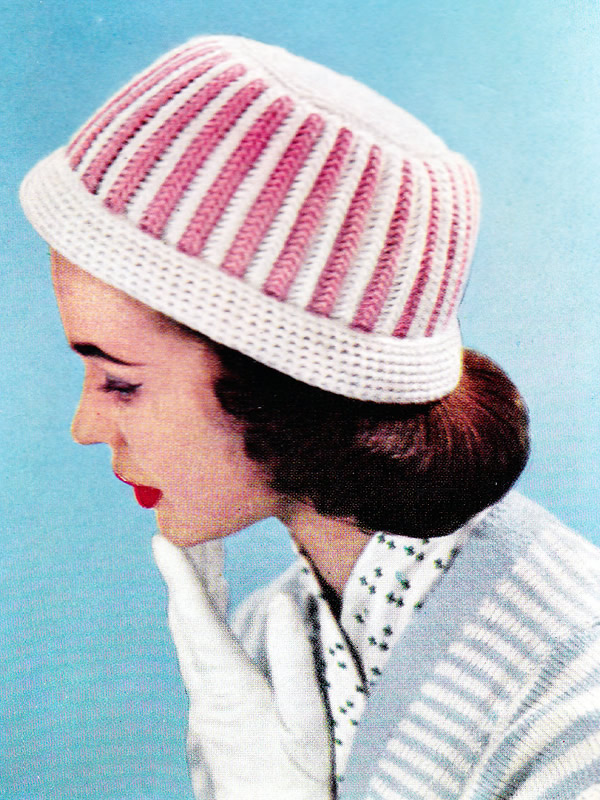
Knitting and crochet combine in this eye-catching candy floss striped hat which can be quickly put together in double knitting weight yarn.
This hat was designed for smart summer holidays (in the UK) in the 1950s, though it's hard to imagine wearing a woolly hat in the summer these days (even in the UK) - which is more a comment on fashion than global warming. However - easy to adapt the colour scheme for autumn and winter days.
Instructions.The main part of the hat is knitted in a fancy striped stitch (which is easier to do than to describe - see below); the top of the crown and brim are in simple double crochet. CrownBegin with the striped part: with pink wool, on No 10 needles, cast on 33 stitches and work in pattern thus: 1st row: k1, *
insert needle into next stitch and knit, winding wool twice round needle;
repeat from * to end. Next row: As 3rd in white. 3rd row forms pattern and this row is now repeated throughout, working
two rows in each shade, ie your next 2 rows will be in pink Continue thus until you have 26 pink stripes. Next 2 rows: in white. Cast off in white as follows: With No 8 hook and white wool, make 3 chain, join into a ring with a 1st round: *
2 dc in 1 dc; repeat from * to end.
[12 dc] Fasten off. Brim:With white wool and No 5 hook, make 101 chain fairly loosely. Join into
a ring with a slip stitch. Next round: *
1 dc in 1 dc but going through the back loop only of each dc; repeat from
* to end. To Make UpPress top of crown only. Don hat with best frock and cotton gloves, and go for a promenade on the sea front. |
Materials
|

Sweater in Spring colours with sleeveless option suitable for the changing season.
Currently for me, the appeal of this combination is the yellow and grey colour scheme in which they have illustrated it - although I would be disinclined to set it off with a bright all-yellow ensemble, and would probably use a more muted shade of yellow.
Instructions.Instructions are given for 3 sizes - larger sizes given in brackets up
to a 40 inch chest. The design is intended for women or men (albeit men
of presumably modest proportions). BackWith No 11 needles, and main shade (M) cast on 108 (118
: 126) stitches, and work 5 inches in k2/p2
rib, beginning the second row "p2" for second and third sizes,
and increasing 1 stitch at the end of the last row for all sizes. Change to No 9 needles and work Fair-Isle from Chart thus: For 1st and 3rd sizes, repeat the 18 stitches between the red lines to the last the last stitch then work the 1st stitch beyond the line. For 2nd size, work 5 stitches before the red line, then
repeat the 18 Continue until work measures 12 (13
: 14) inches for the sweater with sleeves,
or 13 (14 : 15)
inches for the sleeveless slipover, ending with a Armholes shaping: Cast off 4 stitches at the beginning of the next 2 rows, and then 3 stitches at the beginning of the following 2 rows. Decrease 1 stitch at each end of the next 4 rows, then decrease 1 stitch at the beginning of every row until 77 (85 : 91) stitches remain. Continue straight until work measures 21 (22½ : 24) inches. Shoulder shaping: Cast off 5 stitches at the beginning of the next 6 rows, and then 5 (7 : 9) stitches at the beginning of the following 2 rows. Cast off 37 (41 : 43)
stitches. FrontWork as for the Back until work measures 11 (11¾ : 12) inches for the sweater with sleeves or 12 (12¾ : 13½) inches for the slipover. Front shaping: Continue on these stitches only. Decrease 1 stitch at the beginning of the next and ever following 4th row until work measures 12 (13 : 14) inches for the sweater with sleeves or 13 (14 : 15) inches for the slipover, ending at the side edge. Armholes shaping: Decrease 1 stitch at the armhole edge on the next 4 rows, then decrease 1 stitch at the beginning of the next 5 (6 : 7) alternate rows. Continue with centre front edge shaping until until 20 (22 : 24) stitches remain. Continue straight until work measures 21 (22½ : 24) inches, ending at the side edge. Shoulder shaping: Cast off 5 stitches at the beginning of the next, and following 2 alternate rows. Work 1 row. Cast off 5 (7 : 9) stitches and break yarn. With right side facing, slip the centre front stitch on to a safety pin.
SleevesWith No 11 needles and main shade, cast on 56 (66
: 74) stitches and work 3½ inches in
k2/p2 rib, as for the Back,and decreasing 1 stitch at the beginning of
the last row for all sizes. Change to No 9 needles and working from the Chart as for the Back, increase
1 stitch at each end of every 10th row until there are 75 (83
: 89),stitches. To shape the top cast off 4 stitches at the beginning of the next
2 rows. Neckband:Join right shoulder seam. With right side facing, using No 12 needles and main shade, pick up and
knit 64 (68 : 72)
stitches down left side of neck, increase in the stitch from the safety
pin, pick up and knit 64 (68 : 72)
stitches up right side of neck, and then knit 36 (40
: 44) stitches from the Back neck. 1st row wrong side facing): * p2, k2; repeat from * to last 2 stitches, p2. Decreasing 1 stitch each side of the centre front 2 stitches on every
row, rib 9 more rows as set. Join left shoulder and neckband seam. Armbands for Slipover:With right side facing, using No 11 needles and main shade, pick up and
knit 118 (130 : 142)
stitches round each armhole. Cast off ribwise. Making UpPress work lightly on wrong side, omitting welts. Sweater with sleeves: Set in sleeves. Join side and sleeve seams. |
Materials
|
Note: When working the colour pattern from the chart, strand the yarns loosely across the back of the work over not more than 3 stitches at a time, to keep the fabric elastic.


Man's sweater with a textured pattern, made in two colours intended to blend with each other. The overall tweedy look makes this colour scheme look a little autumnal - perhaps the acid green combined with grey or a different shade of green might be more redolent of Spring.
I think the cropping of the picture is an illustration of "never let knitting get in the way of a good photo".
Instructions.Sweater is worked in stripes of the two colours using a textured moss stitch. Instructions are given for 3 sizes. Back and Front alikeWith No 9 needles and main shade (M), cast on 104/108/112
stitches, and work 3 inches in k1/p1 rib, increasing 7/9/11
stitches evenly across the last row. With right side facing, change to No 7 needles and work in pattern as
follows: These 4 rows form the pattern. With right side facing, shape armholes by casting off 4 stitches
at the beginning of the next 2 rows, then decrease 1 stitch at each end
of the next and every alternate row until 91 / 95
/ 99 stitches remain. Continue straight in pattern until back measures 25 / 25½
/ 25½
inches, ending with 4th pattern row. With right side facing continue in M and shape neck: With right side facing, slip the centre 33 / 35
/ 37 stitches on a spare needle or stitch
holder. SleevesWith No 10 needles and main shade (M), cast on 50 / 52
/ 52 stitches, and work 3 inches in k1/p1
rib, increasing 7 stitches evenly across the last row. With right side facing, change to No 7 needles, join in C and continue in pattern, shaping sides by increasing 1 stitch at each end of the 9th and every following 8th row until there are 79 / 83 / 83 stitches, taking the increased stitches into the pattern as they are made. Continue straight in pattern until sleeve seam measures 18½ / 18½ / 19 inches, ending with 2nd pattern row. With right side facing, keeping pattern correct, shape top by
casting off 4 stitches at the beginning of the next 2 rows, then decrease
1 stitch at each end of the next and every alternate row until 37 / 39
/ 39 stitches remain. Neck Ribbing - back and front alike.With No 9 needles, main shade M, and right side facing, start at shoulder
edge and pick up and knit, 8 / 8 /
8 stitches down side of neck, rib 33 / 35
/ 37 stitches from spare needle or stitch
holder, pick up and knit 8 / 8 / 8
stitches up other side of neck. Work 3 rows in rib over all stitches, decreasing 1 stitch at each end of the next and following alternate row. Cast off evenly in rib. To Make UpPress work lightly on wrong side under a damp cloth, avoiding ribbing.
|
MaterialsAran or worsted weight yarn: Pair each of No 7 (4½mm), No 9 (3¾mm), and No 10 (3¼mm)
needles. Tension20sts and 25 rows to four inches on 4½mm needles over stocking stitch.
Size mattersTo fit chest: Abbreviations k: knit A word on the wool.The original yarn was Patons Flair - one of those "tripleknit" yarns which never caught on so much in the UK. More or less Aran or American worsted weight . As usual no clues as to the yardage, but it was 60% wool, 40% courtelle (acrylic). Note that later on Patons made "Flair DK" in 20g balls and with a slightly different wool blend. Disclaimer
|


"Fuller figure" shown off on a suitably matronly figure for the post-rationing 1950s - but actually means a pleasing pattern in a reasonable size range for this century.
Instructions.Instructions are given for 6 sizes - larger sizes given in brackets. Jumper Back† Next row: Rib 4 (7
: 10 : 6 : 9
: 8), *
work twice into the next stitch, rib 5, repeat from *
to last 4 (7 : 10
: 6 : 9 : 8)
stitches, work twice into next the stitch, rib 3 (6
: 9 : 5 : 8
: 7). Change to size 8 (4mm) needles and pattern as follows: 6th row: *
knit into back of stitch, p1, knit into back of stitch, p3, repeat from *
to last 3 stitches, knit into back of stitch, p1, knit into back of stitch. Shape Raglan Armholes: Jumper FrontFollow the instructions for the Back from † to † until 69 (73 : 77 : 79 : 83 : 93) stitches remain, ending with a wrong side row. Shape Neck: 1st size only: Keeping the neck edge straight, decrease 1 stitch at the armhole edge
on every row until 2 stitches remain. 2nd, 3rd
and 4th sizes only 5th and 6th
sizes only: All sizes: Jumper Short Sleeves Using size 10 needles, cast on 80 (86
: 86 : 92 : 92
: 98) stitches and work in k1, p1
rib for ¾ of an inch, ending with a wrong side row and increasing
1 stitch at the end of the last row. Change to size 8 needles and work in pattern as given for the Back until the work measures 3 (3 : 3½ : 3½ : 3½ : 3½) inches from the beginning, ending with a wrong side row. Shape Raglan Top: Jumper Neckband Using a back stitch, join raglan seams, leaving left back raglan seam
open. Work in k1, p1 rib for 1 inch. Cardigan BackFollow the instructions exactly as for the Jumper, but on completion cast off the stitches at the back neck. Cardigan Left FrontUsing size 10 needles, cast on 60 (60 : 66 : 66 : 70 : 76) stitches and work in k1, p1 rib for 2 inches, ending with a right side row. Next row: Rib 6 (6
: 5 : 5 : 5
: 8), *
work twice into the next stitch, rib 5 (5
: 6 : 6 : 5
: 5), repeat from *
to last 6 (6 : 5
: 5 : 5 : 8)
stitches, work twice into next stitch, rib 5 (5
: 4 : 4 : 4
: 7). Change to size 8 needles and pattern as given for Back until work measures 12 (12 : 12½ : 12½ : 13 : 13) inches, from the beginning, ending with a wrong side row. Shape Raglan Armhole and Neck: 2nd, 3rd,
4th, 5th
and 6th sizes only: All sizes: Cardigan Right FrontFollow the instructions exactly as for Left Front, reversing all shapings. Cardigan Long Sleeves Using size 10 needles, cast on 58 (60
: 60 : 62 : 62
: 64) stitches and work in k1, p1
rib for 2½ inches, ending with a right side row. Change to size 8 needles and pattern. Shape Raglan Top: Cardigan Front Bands Using size 10 needles, cast on 11 stitches. To Make UpJumper Cardigan |
Materials
|
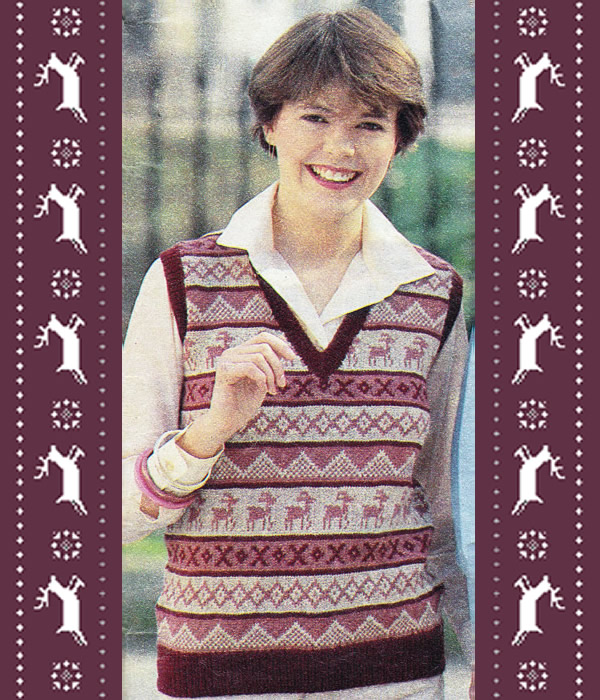
A cute seasonal sleeveless sweater.
Co-incidentally I see that Wardrobe Icons have featured "knitted vests" as an "unexpected hero" this week, having "fallen in love with how versatile it is as a layering piece". They illustrate it with 3 shapes including fair-isle patterns with a closer fit and plain with a relaxed fit.
You could replace the Nordic style pattern given here with any fair-isle pattern of your choosing, just repeating it across the width of the sweater, making sure to centre the pattern - for example the Shetland Folklore pattern which is worked over a 10 stitch repeat.
I have a "relaxed fit" example in polka dots, which could easily be knitted plain.
Instructions Note: When working the colour pattern from the chart, strand
the yarns loosely across the back of the work over not more than 3 stitches
at a time, to keep the fabric elastic. BackWith No 12 (2¾mm) needles and main shade (MS), cast on 106 [114, 120, 128] stitches and work in K1/P1 for 2½ inches, ending with a right side row. Next row: Rib 1 [5,
4, 4] *
m1, rib 4; repeat from * to last 1
[5, 4,
4] stitches, m1, rib 1 [5,
4, 4]. Change to No 10 (3¼mm) needles and work in pattern from the chart, joining in and breaking off colours as required, working the first 4 [1, 5, 3] and last 3 [0, 4, 2] stitches on knit rows, and the first 3 [0, 4, 2], and the last 4 [1, 5, 3] stitches on purl row as indicated, and working the 14 stitch repeat pattern 9 [10, 19, 11] times across in between. Continue until back measures 14½ inches, ending with a wrong side row. ** Shape Armholes: Work without further shaping until back measures 22½ [23, 23, 23½] inches, ending with a wrong side row. Shape Shoulders: Leave stitches on a spare needle or stitch holder. FrontWork as for Back up to **. Shape Armholes and Neck: Next row: keeping pattern correct, cast off 6 stitches, and pattern until 60 [64, 68, 73] stitches are on the right hand needle; turn and leave remaining stitches on a spare needle or stitch holder. Continue on first set of stitches only. Decrease 1 stitch at the armhole edge on the next 9 [11, 11, 15] rows, and then on every alternate row, at the same time, decrease 1 stitches at the neck edge on the next row, and every alternate row until 38 [39, 41, 42] stitches remain. Then continue to decrease 1 stitch at the neck edge only on every alternate row until 32 [34, 37, 39] stitches remain. Then decrease 1 stitch at the neck edge only on every following 3rd row until 25 [26, 28, 29] stitches remain. Work without further shaping until front matches back to start of shoulder shaping, ending with a wrong side row. Shape Shoulder: Work one row, and then cast off. With right side facing, slip centre stitch on to a safety pin, and rejoin yarn to the remaining 66 [70, 74, 79], and pattern to end. Work to match the first side, reversing the shaping. Making UpPress lightly using a cool iron and dry cloth - or as instructed on the ball band - omitting the ribbing. Join right shoulder seam. Neckband: With right side facing, No 12 needles and MS, pick up
and knit 72 [76, 78,
82], stitches down left neck, knit stitch from safety pin (mark
this stitch with a coloured thread), pick up and knit 72 [76,
78, 82], stitches up right neck, then
knit 45 [47, 49,
51] stitches from Back, decreasing 3 stitches evenly. 1st row wrong side facing): * p1, k1; repeat from * to last 2 stitches before the marked stitch, p2tog, p1, p2togtbl; ** k1, p1; repeat from ** to end. 2nd row: k1, * k1, p1; repeat from * to last 2 stitches before the marked stitch, p2tog, p1, p2togtbl, k1; ** p1, k1; repeat from ** to end. Repeat the last 2 rows 3 times more, then the 1st row again. Armhole Borders: With right side facing, No 12 needles and MS, pick up and knit 118 [124, 132, 138], stitches round each armhole. Work in k1/p1 rib for 9 rows. Join side seams and armhole borders. |
Materials2 x 50g balls 4 ply in each of the three colours (all sizes). Pair each No 12 (2¾mm), and No 10 (3¼mm) needles. Tension32 stitches x 32 rows to 4 ins (10cm) measured over pattern using 2¾mm needles. Size mattersTo fit chest 32 [34, 36,
38] inches; Abbreviationsk2tog or p2tog: knit or purl 2 stitches together (decrease one stitch). m1: make 1 stitch by picking up horizontal p2togtbl: purl 2 stitches together through back loops. A word on the woolThe original design was in Patons Clansman 4ply. Disclaimer
|
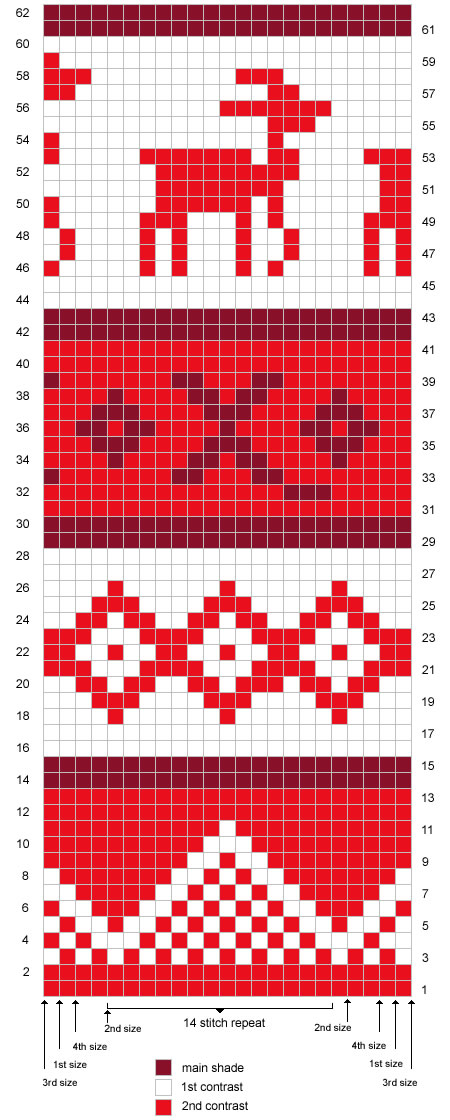 |
|
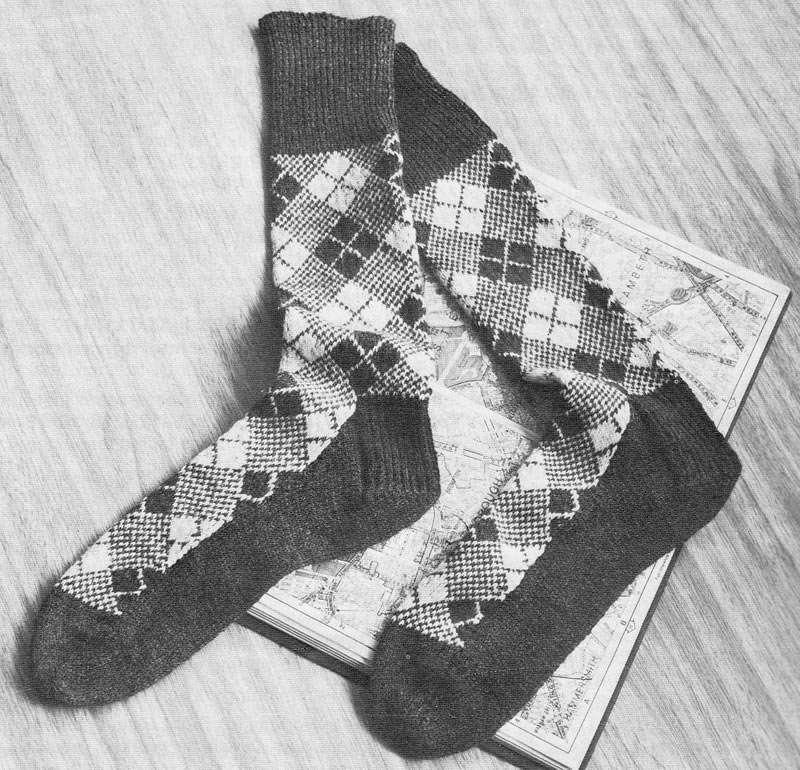
Socks created in two colours with the fair isle technique. Less common these days, now that we can create such exciting coloured socks with self-patterning yarns. Nonetheless quite satisfying since space dyed skeins cannot produce this lovely traditional Argyll pattern.
Instructions.Each sock is worked in three (attached) sections - leg, upper foot, and
lower foot - and mostly using only 2 needles, but these needles need to
be double points (that is, pointed at both ends). Leg and instepStarting at the top leg, using 2 needles and Main Shade (MS), cast on 78 stitches and work in k1/p1 rib for 4 inches, decreasing 1 stitch at the end of the last row : 77 stitches. Start with a knit row, working in stocking stitch in pattern from chart, joining in Contrast (C), reading odd rows knit from right to left and even rows purl from left to right, until 75 rows have been worked. 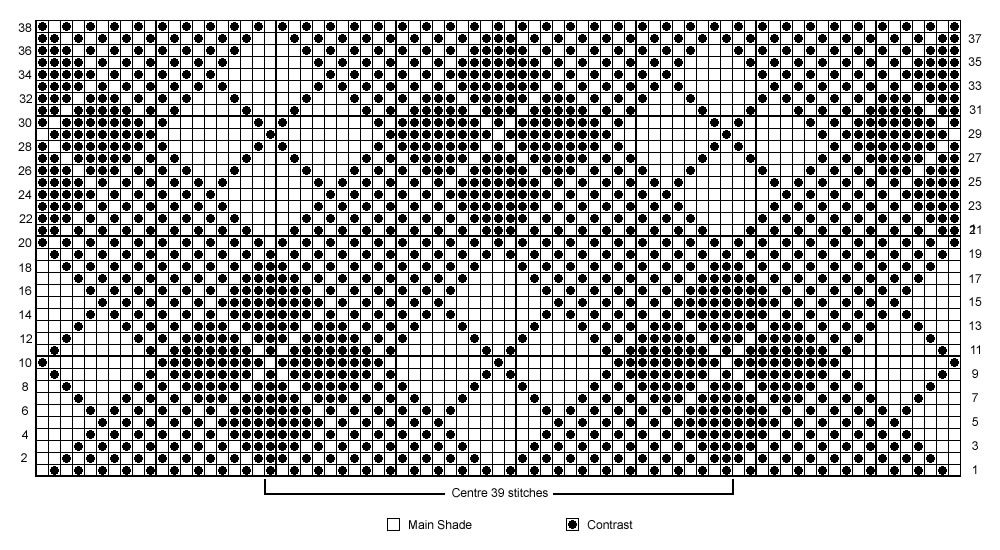
Next row: pattern 18, increase in
the next stitch, pattern to last 19 stitches, increase in the next stitch,
pattern to end : 79 stitches. Slip first and last 20 stitches on spare needles for heel. Continue in MS and stocking stitch (1 row knit one row purl), starting with a knit row, until foot is required length, allowing 2½ inches for toe shaping and ending with a purl row. Leave stitches on a spare needle. Heel and sole:Slip the 2 groups of 20 stitches on to one needle....
1st row: k19, k2tog, k19. Turn heel as follows: Continue in this way until all the stitches have been worked : 21 stitches. Next row: p21 stitches, then pick
up and purl 18 stitches down side of heel piece, turn. Continue straight until work matches the patterned instep piece, ending with a purl row. Toe:Next row: k18 and now (finally) arrange
the stitches on 3 needles for working the toe in the round as follows: Work in rounds shape toe as follows: Making upOmitting ribbing, press parts lightly on wrong side following instructions on the ball band. Sew seams down back of leg, and on each side of the sole, using a flat seam technique (not mattress stitch for example). Sew in all ends. Make a second sock to match. |
Materials3 x 25g balls of 3 ply yarn in main shade and 1 in lighter contrast. Set of four No 13 (2¼mm) needles, pointed at both ends.
Tension36 sts x 44 rows to 4 inches Size mattersLength from top to base of heel: 13½ inches (34 cm); AbbreviationsMS is main shade (Lovat Heather). sl1: slip the next stitch k2tog or p2tog: work 2 sts together to decrease. psso: pass the slipped stitch over, ("sl1, k1, psso" also known as "ssk") A Word on the Wool.Original yarn was Patons Nylox 3ply in colours Lovat Heather (2002) and Snow White (504). Disclaimer (well...almost)In transposing any pattern it is always a risk that errors will be introduced, in spite of dedicated proof reading. If you have any problems with this pattern, please and I will try and assist. |
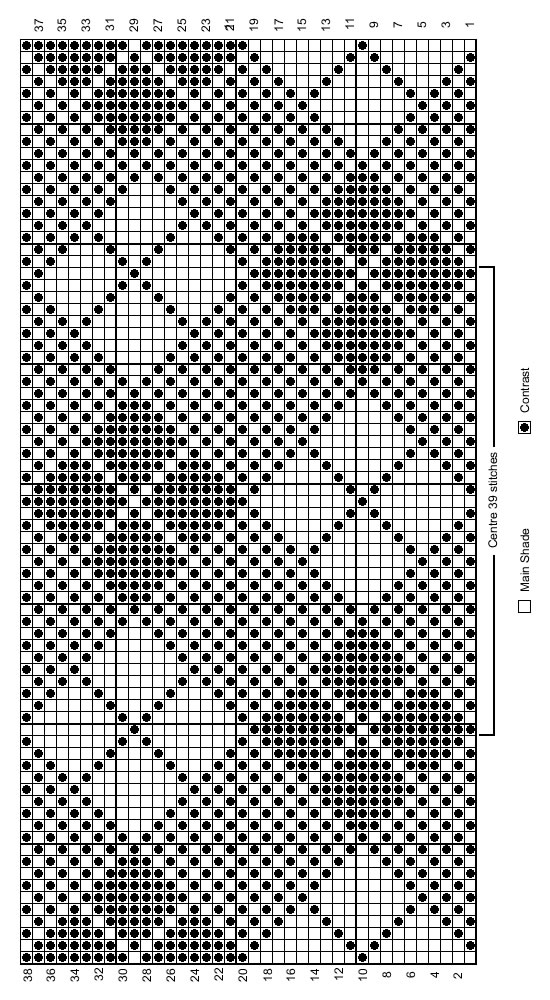

Long-line sweaters with belts at hip level. Very up-to-the-minute sixties styling - but somehow I feel they should have been shown in Lincoln Green - no?
InstructionsThe main body of the sweater is knitted in "rice stitch" which is knitting a kind of sparse moss or seed stitch with some of the knit stitches on the right side worked into the back of the stitch. Back:‡ Change to size 8 needles and pattern: 2nd row: k8 (8, 10, 14, 18, 18, 20), p9, k17, p9, k29 (33, 33, 33, 33, 37, 37); p9, k17, p9; k8 (8, 10, 14, 18, 18, 20). 3rd row: [p1, k1tbl] 3 (3, 4, 6, 8, 8, 9) times, * p2, sl3F, k3, k3 from cable needle, k3, p2, [k1tbl, p1] 6 times, k1tbl, p2, sl3F, k3, k3 from cable needle, k3, p2, * [k1tbl, p1] 12 (14, 14, 14, 14, 16, 16) times, k1tbl, repeat from *to * once, [k1tbl, p 1] 3 (3, 4, 6, 8, 8, 9) times. 4th row: As 2nd row. 7th row: [p1, k1tbl] 3 (3, 4, 6, 8, 8, 9) times, * p2, k3, sl3B, k3, k3 from cable needle, p2, [k1tbl, p1] 6 times, k1tbl, p2, k3, sl3B, k3, k3 from cable needle, p2, * [k1tbl, p1] 12 (14, 14, 14, 14, 16, 16) times, k1tbl, repeat from * to * once, [k1tbl, p1] 3 (3, 4, 6, 8, 8, 9) times. 8th row: As 2nd row. These 8 rows form the pattern. Make Slots for Belt: Next row: Pattern 6 (6,
8, 12, 16,
16, 18) stitches and turn, leaving
remaining stitches on a spare needle. Join in yarn to remaining stitches, pattern 13 stitches and turn, leaving
remaining stitches on a spare needle. Join in yarn to remaining stitches, pattern 13 stitches and turn, leaving
remaining stitches on a spare needle. Join in yarn to remaining stitches, pattern 13 stitches and turn, leaving remaining stitches on a spare needle. Work 8 rows on these stitches. Break off yarn. Join in yarn to remaining stitches, pattern 25 (29,
29, 29, 29,
33, 33) stitches and turn, leaving
remaining stitches on a spare needle. Join in yarn to remaining stitches, pattern 13 stitches and turn, leaving
remaining stitches on a spare needle. Join in yarn to remaining stitches, pattern 13 stitches and turn, leaving
remaining stitches on a spare needle. Join in yarn to remaining stitches, pattern 13 stitches and turn, leaving remaining stitches on a spare needle. Work 8 rows on these stitches. Break off yarn. Join in yarn to remaining 6 (6, 8,
12, 16, 16,
18) stitches, work to end. Next row: Work in pattern across all stitches. Continue in pattern until work measures approximately 15 (15½, 15½, 16, 16, 16½, 16½) inches from the beginning, ending with a wrong side row. Mark each end of the last row with a coloured thread to facilitate easier working when joining raglan seams. Shape Raglan Armholes: 1st, 2nd, 3rd, 4th, and 7th sizes only. Decrease 1 stitch at each end of the next and 3 (3, 3, 3, -, -, 1) following 4th rows. 107 (111, 115, 125, -, -, 143) remaining. All sizes . Decrease 1 stitch at each end of the next and every following alternate
row Shape Shoulder Sections: Front:Follow instructions as for the Back from ‡ to ‡, until 79 (81, 81, 85, 87, 89, 91 ) stitches remain, ending with a wrong side row. Shape one side of the Neck: Shape other side of the Neck: Sleeves:Using size 10 needles, cast on 53 (53, 57, 57, 61, 61, 61) stitches. Using size 10 needles, cast on 115 (119,
123, 131, 139,
143, 147) stitches. Change to size 8 needles and pattern: 2nd row: k22 (22, 24, 24, 26, 26, 26), p9, k17, p9, k29 (33, 33, 33, 33, 37, 37); p9, k22 (22, 24, 24, 26, 26, 26). 3rd row: [p1, k1tbl] 10 (10, 11, 11, 12, 12, 12) times, p2, sl3F, k3, k3 from cable needle, k3, p2, [k1tbl, p1] 10 (10, 11, 11, 12, 12, 12) times. 4th row: As 2nd row. 7th row: [p1, k1tbl] 10 (10, 11, 11, 12, 12, 12) times, p2, k3, sl3B, k3, k3 from cable needle, p2, [k1tbl, p1] 10 (10, 11, 11, 12, 12, 12) times. 8th row: As 2nd row. These 8 rows form the pattern. Increase and work into pattern, 1 stitch at each end of the next and
every following 10th (9th, 9th,
8th, 8th, 7th,
6th) row until there are 73 (77,
81, 85, 89,
93, 97) stitches on the needle. Shape Raglan Top: Work 1 row. Now decrease 1 stitch at each end of the next and every following alternate
row until 13 stitches remain, ending with a wrong side row. NeckbandWith right side of work facing and using size 8 needles, knit across
the 13 stitches on top of Left Sleeve, pick up and k20 (20,
22, 22, 24,
24, 24) stitches down left side of
neck, knit across the 17 (19, 19,
21, 21, 21,
23) stitches at centre, pick up and k20 (20,
22, 22, 24,
24, 24) stitches up right side of
neck, knit across the 13 stitches on top of Right Sleeve and the 31 (33,
33, 35, 35,
37, 39) stitches on back neck: 114
(118, 122,
126, 130, 132,
136) stitches. BeltUsing size 10 needles, cast on 13 stitches. 1st row (Right side facing): * k1,
p1, repeat from * to last stitch, k1. Decrease 1 stitch at each end of the next and every following alternate row until 3 stitches remain. Knit 3 together and fasten off. To Make UpUsing a back stitch, join raglan seams, shoulder sections and neckband,
matching coloured threads on raglan to coloured threads on sleeve top. Press seams lightly under a damp cloth. |
Materials23 (24, 26, 27, 29, 30, 31) x 25g balls double knitting wool. Pair each No 8 (4mm) and Buckle for belt. Tension24sts x 34 rows to 4 ins measured over rice stitch. Size mattersActual chest measurement: 34 (36,
38, 40, 42,
44 46) inches
Length to centre back neck: 23 (23¾,
24¼, 25¼, 25¾,
26½, 27) ins
Her sleeve seam: 16 (16½, 16½,
17, 17, 17½,
17½) inches Abbreviations k1tbl: knit through the back of the stitch. A word on the wool.Original yarn was a pure wool superwash yarn. Disclaimer (well...almost)In transposing any pattern it is always a risk that errors will be introduced,
in spite of dedicated proof reading. |
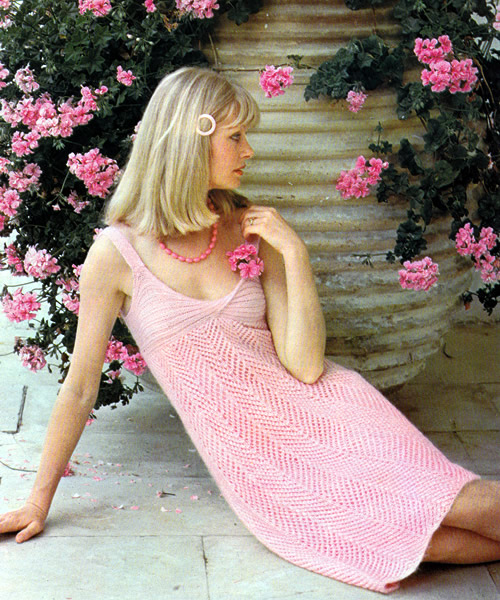
A very pretty strappy knitted dress which is styled for the summer, but, as usual, would work well for the winter, perhaps with a sparkly yarn, and worn with a bolero, tippet, or stole - if we are ever allowed to go out in public any time soon....
InstructionsThe pattern panel for the dress is worked over 5 stitches as follows: 1st row: yfwd, k2togtbl, k1, k2tog,
yfwd. Back** Work in Pattern A as follows: 1st row (right side facing): k1, (k2tog, yfwd) 5 times, k3, * (yfwd, k2togtbl) 4 times, yfwd, sl1, k2tog, psso, yfwd, (k2tog, yfwd) 4 times, k3; repeat from * to last 11 stitches; (yfwd, k2togtbl) 5 times, k1. 2nd row: k1, purl to last stitch, k1 3rd row: k2, * (k2tog, yfwd) 5 times, k1, (yfwd, k2togtbl) 5 times, k1; repeat from * to last stitch, k1. 4th row: as 2nd. These 4 rows form Pattern A. Repeat them until back measures 15 inches, ending with 4th pattern row. Shape as follows: Next row: k1, (k2tog) twice, (yfwd, k2tog) 3 times, yfwd, sl1, k2tog, psso, * (yfwd, k2togtbl) 4 times, sl1, k2tog, psso, (k2tog, yfwd) 4 times, sl1, k2tog, psso repeat from * to last 11 stitches, (yfwd, k2togtbl) 4 times, k2togtbl, k1. [111 sts] Continue in Pattern B as follows: 1st row (wrong side facing): k1, purl to the last stitch, k1. 2nd row: k1, (k2tog, yfwd) 4 times, k3, *(yfwd. k2togtbl) 3 times, yfwd, sl1, k2tog, psso, yfwd, (k2tog, yfwd) 3 times, k3; repeat from * to last 9 stitches, (yfwd, k2togtbl) 4 times, k1. 3rd row: as 1st row. 4th row: k2, * (k2tog. yfwd) 4 times. k1, (yfwd, k2togtbl) 4 times, k1; repeat from * to last stitch, k1. These 4 rows form Pattern B. Repeat them until back measures 20 inches, ending with 1st pattern row. Shape as follows: Next row: k1, (k2tog) twice, (yfwd, k2tog) twice, yfwd, sl1, k2tog, psso, * (yfwd, k2togtbl) 3 times, sl1, k2tog, psso, (k2tog, yfwd) 3 times, sl1, k2tog, psso; repeat from * to last 9 stitches , (yfwd, k2togtbl) 3 times, k2togtbl, k1. [87 sts] Continue in Pattern C as follows: 1st row (wrong side facing): k1, purl to last stitch, k1. 2nd row: k1, (k2tog , yfwd) 3 times, k3, * (yfwd, k2togtbl) twice, yfwd, sl1, k2tog, psso, yfwd, (k2tog, yfwd) twice, k3; repeat from * to last 7 stitches; (yfwd, k2togtbl) 3 times, k1 3rd row: as 1st row. 4th row: k2, * (k2tog, yfwd) 3 times, k1, (yfwd, k2togtbl) 3 times, k1; repeat from * to last stitch, k1. These 4 rows form Pattern C. Repeat them until back measures 22 inches. Place a marker at each end of last row. Change to No 10 (3¼mm) needles and continue in Pattern C until back measures 4 inches from markers, ending with right side facing. Next row: cast off 21, k8 (this includes the stitch on the needle from casting off), slip these 8 stitches on a safety-pin, cast off 29, k8, slip these 8 stitches on a safety-pin, cast off remaining 21 stitches. Work shoulder strap as follows: FrontWork as for back from ** to **. Next row: cast off 44, place a marker in the last of these stitches, cast off remaining stitches. Join side seams of skirt. BodiceWith No. 10 needles, cast on 34 stitches and work in rib as follows: Next row: k1, * p2, k2; repeat from * to last stitch, k1. This row forms rib pattern. Repeat it until strip, when slightly stretched,
fits along upper edge of skirt from outer side of shoulder straps to marker
at centre front. Now continue in rib until length from 2nd marker matches length from
cast-on edge to 1 st marker. To Make UpStarting at outer side of shoulder strap, sew first half of bodice strip
in position, first marker matching centre marker of front. Cut lining the full width of skirt but 2 inches longer than skirt when
lying flat. Allow ½ inches for seams and 1 inch for hem. Pin hem in position, then try dress on before stitching, to be certain lining is the correct length. |
MaterialsDress: 6 x 50g balls of a light weight double knitting. (See"a word on the wool"). Pair each No 10 (3¼mm) and No 7 (4½mm) needles. 1¼ yards (about 1.2m) of 1 inch (2.5cm) wide facing ribbon. 1¾ yards (about 1.6m) of 36 inch (90cm) wide lining material in a matching shade. Tension25 sts and 32 rows to 4 inches measured over pattern on No 7 needles. Size mattersThe pattern is given in one size to fit bust 34 - 36 inches. Length (excluding shoulder strap) measured flat is 30 inches. (The dress drops to 32 inches when worn) Abbreviations:k2tog or p2tog: knit or purl 2 stitches together (decrease one
stitch). A Word on the Wool:Original knitted in Patons Kismet which which was 80% acrylic and 20% mohair; it was a fairly light weight yarn, and it was the fluffiness that caused it to knit to something like a DK equivalent (on the right needles). This pattern emphasises the light weight nature of the yarn with an open-work pattern knitted on large needles. The other thing to note is that it had an exceptional yardage - about 225m to 50g which is about double that of a normal DK, so you need to take all that into account when considering substituting. Disclaimer (well...almost)In transposing any pattern it is always a risk that errors will be introduced, in spite of dedicated proof reading. If you have any problems with this pattern, please and I will try and assist. |
Unusually for this era, we have only the one size - perhaps they think those more well-endowed would not suit this style - and maybe they are right - certainly I don't think I could make it work for me.
However, if you did want to make it larger, I really think the only option is to work out the repeats in the pattern and add some extra width in the skirt - then knit the bodice section (it's knitted sideways) longer, and workout where to reposition the straps.
On top of that, if were knitting this, I would try using a delicate lace-weight yarn (there are some lovely ones around), swatching the pattern, and experimenting with different needles to get the right tension.
But then I never did like an easy life.
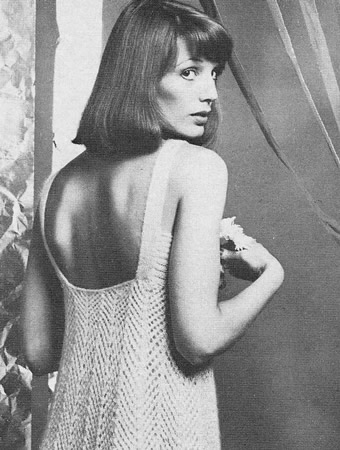
I'm putting this photo in to show you the back of the dress, but I can't let it pass without commenting that to me it's very vaguely sleazy - I think "come to bed eyes" would be the description. It's almost as if the photographer were more used to using his skills for a different kind of audience altogether...
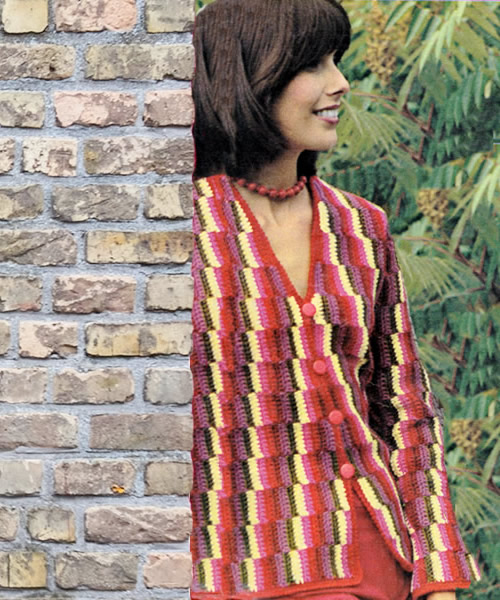
This looks like a very wearable crochet cardigan (for those who prefer crochet to knitting). Bands of two-row stripes in double crochet are arranged to form a flattering chevron down the centre back, giving the illusion of shaping. You could make it in a single shade, or go totally wild as shown in the photo - or you could choose more muted contrasts in naturals, perhaps greys and taupes with ecru. If you choose brights you could be guided more by Kaffe Fassett's favourite combinations, introducing turquoises with fuschia and poppy.
So .... "Make it plain and simple or bright and stunning"
Instructions. Instructions for larger sizes are given in brackets. Main Part1st Band:
With 4mm hook and main shade (A) make 8 chain. 2nd Band:
Make as the 1st band , but beginning and ending with contrast colour B
and with centre back stripe of E [A
: C : E]. 3rd Band:
As 1st, but beginning and ending with contrast colour C and with centre
back stripe of F [B : D
: F]. Continue in this way, beginning and ending with next stripe of colour sequence, until the 9th band is complete. Right FrontNext Band: Begin with contrast colour E and work 16 [17 : 18 : 19] stripes. Omit the first stripe of the previous band; join. Next Band: Begin with A and work 14 [15 : 16 : 17] stripes. Omit one stripe at each end of the previous band; join. Next Band: Begin with contrast colour C and work 12 [13 : 14 : 15] stripes. Join as previous band. Next Band: Begin with contrast colour E and work 11 [12 : 13 : 14] stripes. Omit the first stripe of the previous band; join. Shape shoulders: Next Band:
With A make 7 [8 : 10
: 11] chain. Work the foundation row and the 1st row as you did
in the first band. {6 [7 : 9
: 10] dc}. Continue in stripes, decreasing 1 stitch at eh beginning of every 4th
row until 2 dc remain. Work 1 row. Fasten off. BackReversing stripes at centre as given for main part continue thus: Next Band: Beginning and ending B [C : D : E] work 35 [37 : 39 : 41] stripes. Omit 5 stripes of 9th band of main part for armhole; join. Next Band: Beginning and ending D [E : F : A] work 33 [35 : 37 : 39] stripes. Omit 1 stripe at each end of previous band ; join. Next Band: Beginning and ending F [A : B : C] work 31 [33 : 35 : 37] stripes. Join on as last band. Next Band: As last but beginning and ending A [B : C : D]; join. Shape shoulders: With B [C : D : E] ** make 3 [3 : 5 : 5] chain. Work the foundation row and the 1st row as you did in the first band. {2 [2 : 4 : 4] dc}. Next Row:
l ch, 2 dc in next dc - increase worked - 1 dc in each dc to end. Left FrontAs right front to shoulder shaping, reversing stripes and shapings, and missing 5 stripes of last band of main part for armhole. Shape shoulders: Beginning D [E : F : A], work as shoulder shaping of back from ** to ** . Work 2 [1 : 2 : 1] stripes. Fasten off. Sew on. Sleeves1st Band: beginning with A, work as for 1st band of main part, repeating 6 stripes of A, B, C, D, E and F until there are 22 [22 : 24 : 24] stripes. 2nd Band:
beginning with B, work as 1st band. 3rd Band: beginning with B, work 24 [24 : 26 : 26] stripes. Omitting 1 stripe each end sew on to 2nd band. 4th Band: beginning with C, work as for 3rd band. Sew on. 5th Band: beginning with C, work 26 [26 : 28 : 28] stripes. Omitting 1 stripe each end, sew on. 6th Band: beginning with D, work as for 5th band. Sew on. 7th Band: beginning with D, work 28 [28 : 30 : 30] stripes. Omitting 1 stripe each end, sew on. 8th Band: beginning with E, work as 7th band. Sew on. 9th Band: beginning with E, work 30 [30 : 32 : 32] stripes. Omitting 1 stripe at each end, sew on. 10th Band: beginning with F, work as 9th band. Now shape top: 12th Band: beginning with F, work 22 [22 : 24 : 24] stripes. Omitting 1 stripe each end of previous band and sew on. 13th Band: beginning with B, work 20 [20 : 22 : 22] stripes. Sew on as last band. Making UpPress work lightly. Edging: 1st Round: l ch, 1 dc in end of each
row or dc around entire outer edge, working 3 dc in the corners; slip
stitch to 1st ch at the beginning of the round. With main shade A work around sleeve edges to match. |
Materials 5 [6 : 7
: 8] (25 gram) balls double knitting yarn in the main colour, plus,
4mm and 3½mm crochet hooks. TensionPattern strip is 1¾ inches wide and 18 rows to 4 inches. Size mattersTo fit chest 32 [34 : 36
: 38] inches; Crochet abbreviations:ch: chain Remember these are English crochet instructions where dc is equivalent to US single crochet - see "Terminology" in the side bar. Disclaimer
|
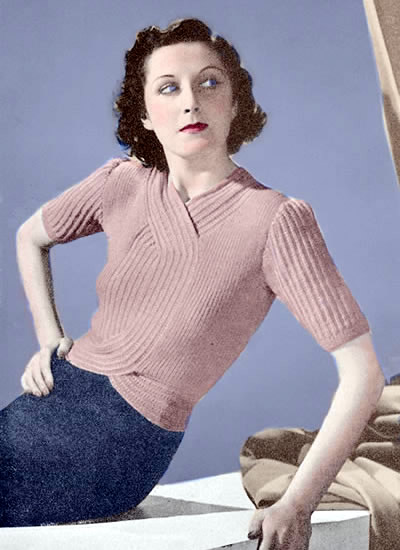
The criss-cross front on this knitted blouse is a new*, exciting idea. It fits close and snug around the waist, and does up With eight buttons - four at the back of the neck, and four at the waist. The main part is in plain k1/p1 rib, while the bands are in a fancy rib stitch.
* New in the autumn of 1938.
... and being from the 1930s, there is only one set of instructions to fit a modest 34-36 inch chest - however, they do suggest using different needle sizes to make a minor adjustment within that size range.
Instructions.Instructions for one size only; you can slightly alter the size by using different needles as indicated in the pattern materials. FrontStart with the belt as follows: 1st row: Slip 1,*
slip 1 knitwise, p3; repeat from *
to last 2 stitches, slip 1 knitwise, k1. Repeat these 2 rows (which form the pattern) until work measures 13½ inches, then, with right side facing: * work to last 3 stitches, turn, and work back. Work straight across tow rows then repeat from * twice. Now shape as follows: With right side facing, pick up and knit 46 stitches, commencing 3½
inches in from the holder, and ending 6 inches from beginning of work
along upper edge (inside of curve) for right front. [The 6 inch straight
piece left should reach to the centre back.]
Work 19 rows in k1/p1 rib over these 46 stitches. Work a second piece to correspond to the first to make the left front, working all shapings at the opposite ends of the needle. (ie: commence picking up stitches with right side facing, 6 inches from commencement, and start the rib with p1). The two front pieces are now joined together as follows: Now continue over all stitches: Now work straight until front measures 11 inches, or length required; it is advisable to measure yourself here and make sure that the belt fits snugly round the natural waistline. With right side facing, shape armholes by casting off 6 stitches at the
beginning of the next 2 rows, 5 stitches at the beginning of the next
2 rows, 4 stitches at the beginning of the next 2 rows, and 3 stitches
at the beginning of the next 2 rows. 1st row (right side facing): Rib
38 stitches, turn, leaving remaining stitches on a spare needle. Return to the main work, and complete the right shoulder to correspond.
1st row:Work 3 stitches, turn, and
work back. Back Cast on 114 stitches and work 28 rows in k1/p1 rib. Shape neck by casting off 2 stitches at the neck edge on the following
5 alternate rows, and then k2tog at this edge on the following 9 alternate
rows [23 sts]. SleevesCast on 91 stitches and work 1 inch in k1/p1 rib. Making UpPress very lightly only with a warm iron under a damp cloth. |
Materials
|
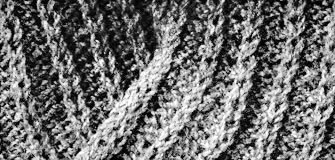

Sweet little sleeveless jumpers for toddlers with Easter bunny motifs.
Instructions.When working the colour pattern from the chart, strand yarn not in use
loosely across the wrong side of the work over not more than 3 stitches
at a time in order to keep the fabric elastic. If you want to view chart image full size in the browser then right click on the image below and choose "view image". Back** Next row: rib 3 [7,
10] (m1, rib 10) 7 times, m1, rib 3 [7,
10]: Change to No 11 needles and starting with a knit row, work straight in stocking-stitch until back measures 1½ [2, 2] inches, ending with right side facing. Change to No 10 needles and joining in contrast colour (C) as required, work rows 1-20 inclusive from chart A [B, A]
Work the first 0 [1, 1]
stitch on knit rows and last 0 [1,
1] stitch on purl rows as indicated, repeating
the 12 [13, 12]
pattern stitches 7 [7, 8]
times across - and the last 0 [0,
1] stitch on knit rows, and first 0 [0,
1] stitch on purl rows as indicated. Change to No 11 needles and continue in M and stocking stitch until back measures 4½ [5, 5½]inches, ending with right side facing. Shape armholes by casting off 6 stitches at the beginning of the next 2 rows, then decrease 1 stitch at each end of every row until 54 [58, 64] stitches remain. Work 1 row straight. Now decrease 1 stitch at each end of the next and every alternate row until 48 [52, 56] stitches remain. ** Continue straight until back measures 9 [10, 11] inches, ending with right side facing. Shape shoulders by casting off 5 stitches at the beginning of the next 2 rows, then 4 [5, 6] stitches at the beginning of the following 2 rows. Leave the remaining 30 [32, 34] stitches on a spare needle. FrontWork as for Back from ** to **
. Shape neck as follows: Knit 18 [19, 20],
turn, and leave remaining stitches on a spare needle. Work straight until front matches back at armhole edge, ending with right side facing. Shape shoulder by casting off 5 stitches at the beginning of the
next row. With right side facing, leave centre 12 [14, 16] stitches on a spare needle, rejoin yarn to the remaining stitches and knit to end. Finish to correspond with first side, reversing shapings. Making UpUsing a cool iron and a damp cloth for Baby Wool, press parts lightly
on the wrong side, omitting ribbing. Neckband: With right side facing, No 13 needles and M, start at
the top of the left shoulder and work as follows: Work 6 rows k1/p1 rib. Join left shoulder seam, then join neckband with a flat seam Armhole Borders: With right side facing, No 13 needles and M, pick up and knit 86 [94, 102] stitches round each armhole and work 6 rows k1/p1 rib. Cast off evenly in rib. |
MaterialsBaby 3 ply 25g balls: 2 in main colour and 1 contrast colour (all sizes). Pair each No 13 (2¼mm), No 11 (3mm), and No 10 (3¼mm) needles.
Tension32 stitches x 40 rows to 4 ins (10cm) in stocking stitch on No 11 (3mm) needles. Size mattersTo fit chest 20 [22, 24]
inches; Abbreviationsk2tog or p2tog: knit or purl 2 stitches together (decrease one stitch). m1: make 1 stitch by picking up horizontal sl1: slip one stitch by passing it between the needles without knitting it. A word on the woolThe original design was in Patons Baby 3ply - a version of which is still available today. Disclaimer
|

Perfect for our current wintery spring.
Every man loves a comfortable lumber jacket for casual week-end wear.
[And I'm sure many a woman loves a comfortable man just like this one - if not the dog as well.
Notice that Roger has been wisely supplied with a lovely thick pair of leather gloves for this photo shoot...]
Instructions.Instructions are given for one medium man's size only. BackWith No 10 needles, cast on 109 stitches and work 3 inches in k1/p1 rib, rows on the right side having a k1 at each end. Change to No 8 needles and pattern as follows: 1st row [Right side facing]: *
k1, p1; repeat from * to last stitch,
k1. These 2 rows form the pattern. With right side facing, shape armholes by casting off 7 stitches at the beginning of the next 2 rows, then k2tog at each end of following 2 rows: [91 sts] Work straight until back measures 24 inches. With right side facing, shape shoulders by casting off 10 stitches at the beginning of the next 6 rows; cast off remainder fairly tightly. Left Front:With No 10 needles, cast on 55 stitches and work 34 inches in k1/p1 rib as before. Change to No 8 needles and, in pattern, work straight until front measures 16 inches. With right side facing, shape armhole by casting off 7 stitches at the
beginning of the next row, then k2tog at this edge on the following 2
rows [46 sts] Work 41 rows straight in pattern, then with wrong side facing, shape neck by casting off 6 stitches at the beginning of the next row, then k2tog at this edge on every row until 30 stitches remain. Work a few rows straight until front matches back to the start of the shoulder shaping. With right side facing, shape shoulder by casting off 10 stitches at the beginning of the next and following 2 alternate rows, (armhole edge). Right Front:Work to correspond with the left front, reversing shapings. Sleeves:With No 10 needles, cast on 57 stitches, and work 2½ inches in k1/p1 rib as before. Change to No 8 needles and pattern, increasing 1 stitch at each end of the 7th and every following 6th row until there are 83 stitches. Work straight until sleeve measures 18½ inches or required length. With right side facing, shape top by casting off 5 stitches at
the beginning of the next 2 rows, then k2tog at each end of the next and
every alternate row until 41 stitches remain; then, at each end of every
row until 25 stitches remain. To Make UpPress work on wrong side under a damp cloth. Neckband: Join side and sleeve seams; insert sleeves. |
MaterialsDouble Knitting yarn 19 ozs - shown in colour Wine. A pair each No 8 (4mm) and No 10 (3¼mm) needles. A zip fastener (double-ended - suitable for a jacket). Tension22 sts x 30 rows to 4 inches. Size mattersTo fit 39-41 inch bust; length from top of shoulders: 25 inches; sleeve seam: 18½ inches. Abbreviationsk2tog: decrease by knitting 2 stitches together. inc: increase by working into front and back of stitch dec: decrease by working 2 stitches together. Disclaimer
|


This 1930s sweater has good news and bad news. The good is that it's made in a yarn weight that is more popular today than then - that is a heavy DK or worsted. And as a consequence, the bad news is that the instructions are only given for one size, and with limited opportunity to alter the size by using thicker yarn.
I have referenced some reading material at the end of the instructions, that might help you with adaptations if you are feeling that adventurous.
" An unusual broken trellis pattern makes this warm country jumper. The casual polo collar does up at the back with three buttons, and the button-up idea is carried out again on the front of the welt. ".
Instructions.Instructions are given for only one small/medium size. BackWith No 8 needles, cast on 70 stitches and work 3½ inches in k2,
p2 rib. In the last row increase to 80 stitches by working twice into
each of the first and last 5 stitches of the row. Change to No. 7 needles
and pattern as follows: These 24 rows form the pattern, which is repeated throughout. Next row: Rib across the first 30 stitches, k6, turn, leaving remaining stitches on a spare needle. Work on these 36 stitches, keeping the 6 stitches at the inside edge in stocking-stitch, and after ½ an inch make a buttonhole as in the front welt (see instructions below). To make a buttonhole: When work measures 19 inches from commencement cast off 9 stitches at
the beginning of the following 2 alternate rows at the armhole edge, and
in the same row as the first casting-off make another buttonhole as before.
Return to the remaining 30 stitches, cast on 6 stitches and, keeping
these in stocking-stitch, work to correspond with the first side, but
omitting the buttonholes. Front:Begin with the right welt. 1st row: k6, *
p2, k2, repeat from * to last 2 stitches,
p2. Repeat these 2 rows once and then make a buttonhole as follows: Continue in pattern for 1 inch, and then make another buttonhole in the
same way, then work for 1 more inch and make another buttonhole. Now change to No 7 needles and pattern as for back, and continue until 3½ inches of the yoke ribbing have been done. Next row (right side facing): Rib
27, leave 12 stitches on a spare needle, rib 27. Cast off 9 stitches at the beginning of the following 2 alternate rows,
at the armhole edge. Sleeves:With No 8 needles, cast on 32 stitches and work in k2, p2 rib for 3 inches.
Now change to No 7 needles and pattern, but after 2 inches have been done, increase in the next and every following 4th row until there are 62 stitches on the needle, taking the increased stitches into the pattern. Work straight until sleeve measures 18½ inches from commencement,
then, cast off 4 stitches at the beginning of the next 2 rows, then k2tog
at each end of every row until 20 stitches remain. CollarJoin shoulder seams. With the set of No 8 needles and front of work facing, take the 18 stitches
from the spare needle at the left back, pick up and knit 19 over the left
shoulder, take 12 from the spare needle at the front, pick up and knit
19 over the right shoulder, and take the 18 from the spare needle at the
right back. To Make UpSew up side and sleeve seams, and insert sleeves. |
Materials
|
A word on the wool...This 1930s pattern is given in only one size - which to be fair is a "medium" although I suspect the average size for women is rather larger than medium these days. The original yarn was Patons Totem - which was a double knit weight but came in a number of guises over the years I believe - and the tension and needles indicate it's more like a worsted weight. So it's not so easy to simply increase the size by using a thicker yarn - it might work if you check your tension, but the resulting sweater might be unappealingly chunky for the intended style. Geraldine Warner has produced a helpful book about how to approach adapting
vintage patterns - however, don't be confused as it is published under
two different titles - but it's the same book. Also note that this
is a book of techniques and "how to" - it's does not contain
any knitting patterns: Whatever you choose to do, when adapting - always knit a swatch! Pattern detail:  |

A set of conventional Aran sweaters in a good range of sizes.
Patterns include, twisted cables, lobster claw, diamonds, blackberry or trinity stitch, and double moss stitch.
InstructionsBack:‡ Change to size 7 needles and pattern. 2nd row: [p1, k1] 1 (2, 4, 5, 6, 8, 10, 11, 13) times, * [p4, k1] twice, p2, k2, p2, k6, p2, k2, p2, [k1, p4] twice, * [k1, p1, k1 all into next stitch, p3tog] 3 times; repeat from * to * once, [k1, p1] 1 (2, 4, 5, 6, 8, 10, 11, 13) times. 3rd row: [p1, k1] 1 (2, 4, 5, 6, 8, 10, 11, 13) times, * C4B, p1, C4F, p1, k2, p2, sl2f , p1, k2 from cable needle, p4, sl1b, k2, purl stitch from cable needle, p2, k2, p1, C4B, p1, C4F, *p12; repeat from * to * once, [k1, p1] 1 (2, 4, 5, 6, 8, 10, 11, 13) times. 4th row: [k1, p1] 1 (2, 4, 5, 6, 8, 10, 11, 13) times, * [p4, k1] twice, p2, k3, p2, k4, p2, k3, p2, [k1, p4] twice, * [p3tog, k1, p1, k1 all into next stitch] 3 times; repeat from * to * once, [p1, k1] 1 (2, 4, 5, 6, 8, 10, 11, 13) times. 5th row: [k1, p1] 1 (2, 4, 5, 6, 8, 10, 11, 13) times, * [k4, p1] twice, k2, p3, sl2f , p1, k2 from cable needle, p2, sl1b, k2, purl stitch from cable needle, p3, k2, [p1, k4] twice, * p12; repeat from * to * once, [p1, k1] 1 (2, 4, 5, 6, 8, 10, 11, 13) times. 6th row: [p1, k1] 1 (2, 4, 5, 6, 8, 10, 11, 13) times, * [p4, k1] twice, p2, k4, p2, k2, p2, k4, p2, [k1, p4] twice, * [k1, p1, k1 all into next stitch, p3tog] 3 times; repeat from * to * once, [k1, p1] 1 (2, 4, 5, 6, 8, 10, 11, 13) times. 7th row: [p1, k1] 1 (2, 4, 5, 6, 8, 10, 11, 13) times, * C4B, p1, C4F, p1, k2, p4, sl2f , p1, k2 from cable needle, sl1b, k2, purl stitch from cable needle, p4, k2, p1, C4B, p1, C4F, * p12; repeat from * to * once, [k1, p1] 1 (2, 4, 5, 6, 8, 10, 11, 13) times. 8th row: [k1, p1] 1 (2, 4, 5, 6, 8, 10, 11, 13) times, * [p4, k1] twice, p2, k5, sl2b, p2, p2 from cable needle, k5, p2, [k1, p4] twice, * [p3tog, k1, p1, k1 all into next stitch] 3 times; repeat from * to * once, [p1, k1] 1 (2, 4, 5, 6, 8, 10, 11, 13) times. 9th row: [k1, p1] 1 (2, 4, 5, 6, 8, 10, 11, 13) times, * [k4, p1] twice, k2, p4, sl1b, k2, purl stitch from cable needle, sl2f , p1, k2 from cable needle, p4, k2, [p1, k4] twice, * p12; repeat from * to * once, [p1, k1] 1 (2, 4, 5, 6, 8, 10, 11, 13) times. 10th row: [p1, k1] 1 (2, 4, 5, 6, 8, 10, 11, 13) times, * [p4, k1] twice, p2, k4, p2, k2, p2, k4, p2, [k1, p4] twice, * [k1, p1, k1 all into next stitch, p3tog] 3 times; repeat from * to * once, [k1, p1] 1 (2, 4, 5, 6, 8, 10, 11, 13) times. 11th row: [p1, k1] 1 (2, 4, 5, 6, 8, 10, 11, 13) times, * C4B, p1, C4F, p1, k2, p3, sl1b, k2, purl stitch from cable needle, p2, sl2f, p1, k2 from cable needle, p3, k2, p1, C4B, p1, C4F, * p12; repeat from * to * once, [k1, p1] 1 (2, 4, 5, 6, 8, 10, 11, 13) times. 12th row: [k1, p1] 1 (2, 4, 5, 6, 8, 10, 11, 13) times, * [p4, k1] twice, p2, k3, p2, k4, p2, k3, p2, [k1, p4] twice, * [p3tog, k1, p1, k1 all into next stitch] 3 times; repeat from * to * once, [p1, k1] 1 (2, 4, 5, 6, 8, 10, 11, 13) times. 13th row: [k1, p1] 1 (2, 4, 5, 6, 8, 10, 11, 13) times, * [k4, p1] twice, k2, p2, sl1b, k2, purl stitch from cable needle, p4, sl2f, p1, k2 from cable needle, p2, k2, [p1, k4] twice, * p12; repeat from * to * once, [p1, k1] 1 (2, 4, 5, 6, 8, 10, 11, 13) times. 14th row: [p1, k1] 1 (2, 4, 5, 6, 8, 10, 11, 13) times, * [p4, k1] twice, p2, k2, p2, k6, p2, k2, p2, [k1, p4] twice, * [k1, p1, k1 all into next stitch, p3tog] 3 times; repeat from * to * once, [k1, p1] 1 (2, 4, 5, 6, 8, 10, 11, 13) times. 15th row: [p1, k1] 1 (2, 4, 5, 6, 8, 10, 11, 13) times, * C4B, p1, C4F, p1, k2, p1, sl1b, k2, purl stitch from cable needle, p6, sl2f, p1, k2 from cable needle, p1, k2, p1, C4B, p1, C4F, * p12; repeat from * to * once, [k1, p1] 1 (2, 4, 5, 6, 8, 10, 11, 13) times. 16th row: [k1, p1] 1 (2, 4, 5, 6, 8, 10, 11, 13) times, * [p4, k1] twice, p2, k1, p2, k8, p2, k1, p2, [k1, p4] twice, * [p3tog, k1, p1, k1 all into next stitch] 3 times; repeat from * to * once, [p1, k1] 1 (2, 4, 5, 6, 8, 10, 11, 13) times. These 16 rows form the pattern. Shape Armholes: Continue without further shaping until work measures 7½ (7¾, 8, 8¼, 8½, 8¾, 9, 9¼, 9½) inches from commencement of armhole shaping, ending with a wrong side row. Shape Shoulders: Front:Follow instructions as for the Back, from ‡ to ‡. Continue without further shaping until work measures 5 (5¼, 5½, 5¾, 6, 6¼, 6½, 6¼, 7) inches from commencement of armhole shaping, ending with a wrong side row. Shape Shoulders: Shape Neck: Decrease 1 stitch at the neck edge on the next 8 (8,
8, 9, 9,
9, 9, 9,
10) rows. Shape Shoulders: Slip the centre 16 (16, 18,
18, 18, 20,
20, 22, 22)
stitches on to a spare needle. Sleeves:Using size 10 needles, cast on 42 (44,
46, 48, 50,
52, 54, 56,
58) stitches and work in k1/p1 rib for 2½
inches, ending with a right side row. Change to size 7 needles and pattern.
1st row: [k1, p1] 1 (1, 1, 1, 1, 2, 2, 3, 3) times, k2, p8, [k4, p1] twice, k2, p1, sl2f, p1, k2 from cable needle, p6, sl1b, k2, purl stitch from cable needle, p1, k2, [p1, k4] twice, p8, k2, [p1, k1] 1 (1, 1, 1, 1, 2, 2, 3, 3) times. 2nd row: [p1, k1] 1 (1, 1, 1, 1, 2, 2, 3, 3) times, p2, [k1, p1, k1 all into next stitch, p3tog] twice, [p4, k1] twice, p2, k2, p2, k6, p2, k2, p2, [k1, p4] twice, [k1, p1, k1 all into next stitch, p3tog] twice, p2, [k1, p1] 1 (1, 1, 1, 1, 2, 2, 3, 3) times. 3rd row: [p1, k1] 1 (1, 1, 1, 1, 2, 2, 3, 3) times, k2, p8, C4B, p1, C4F, p1, k2, p2, sl2f , p1, k2 from cable needle, p4, sl1b, k2, purl stitch from cable needle, p2, k2, p1, C4B, p1, C4F, p8, k2, [k1, p1] 1 (1, 1, 1, 1, 2, 2, 3, 3) times. 4th row: [k1, p1] 1 (1, 1, 1, 1, 2, 2, 3, 3) times, p2, [p3tog, k1, p1, k1 all into next stitch] twice, [p4, k1] twice, p2, k3, p2, k4, p2, k3, p2, [k1, p4] twice, [p3tog, k1, p1, k1 all into next stitch] twice, p2, [p1, k1] 1 (1, 1, 1, 1, 2, 2, 3, 3) times. 5th row: [k1, p1] 1 (1,
1, 1, 1,
2, 2, 3,
3) times, k2, p8, [k4, p1] twice, k2, p3,
sl2f , p1, k2 from cable needle, p2, sl1b, k2, purl stitch from cable
needle, p3, k2, [p1, k4] twice, p8, k2, [p1, k1] 1 (1,
1, 1, 1,
2, 2, 3,
3) times. 6th row: [p1, k1] 1 (1, 1, 1, 1, 2, 2, 3, 3) times, p2, [k1, p1, k1 all into next stitch, p3tog] twice, [p4, k1] twice, p2, k4, p2, k2, p2, k4, p2, [k1, p4] twice, [k1, p1, k1 all into next stitch, p3tog] twice, p2, [k1, p1] 1 (1, 1, 1, 1, 2, 2, 3, 3) times. 7th row: [p1, k1] 1 (1, 1, 1, 1, 2, 2, 3, 3) times, k2, p8, C4B, p1, C4F, p1, k2, p4, sl2f , p1, k2 from cable needle, sl1b, k2, purl stitch from cable needle, p4, k2, p1, C4B, p1, C4F, p8, k2, [k1, p1] 1 (1, 1, 1, 1, 2, 2, 3, 3) times. 8th row: [k1, p1] 1 (1, 1, 1, 1, 2, 2, 3, 3) times, p2, [p3tog, k1, p1, k1 all into next stitch] twice, [p4, k1] twice, p2, k5, sl2b, p2, p2 from cable needle, k5, p2, [k1, p4] twice, [p3tog, k1, p1, k1 all into next stitch] twice, p2, [p1, k1] 1 (1, 1, 1, 1, 2, 2, 3, 3) times. 9th row: [k1, p1] 1 (1, 1, 1, 1, 2, 2, 3, 3) times, k2, p8, [k4, p1] twice, k2, p4, sl1b, k2, purl stitch from cable needle, sl2f, p1, k2 from cable needle, p4, k2, [p1, k4] twice, p8, k2, [p1, k1] 1 (1, 1, 1, 1, 2, 2, 3, 3) times. 10th row: [p1, k1] 1 (1, 1, 1, 1, 2, 2, 3, 3) times, p2, [k1, p1, k1 all into next stitch, p3tog] twice, [p4, k1] twice, p2, k4, p2, k2, p2, k4, p2, [k1, p4] twice, [k1, p1, k1 all into next stitch, p3tog] twice, p2, [k1, p1] 1 (1, 1, 1, 1, 2, 2, 3, 3) times. 11th row: [p1, k1] 1 (1, 1, 1, 1, 2, 2, 3, 3) times, k2, p8, C4B, p1, C4F, p1, k2, p3, sl1b, k2, purl stitch from cable needle, p2, sl2f, p1, k2 from cable needle, p3, k2, p1, C4B, p1, C4F, p8, k2, [k1, p1] 1 (1, 1, 1, 1, 2, 2, 3, 3) times. 12th row: [k1, p1] 1 (1, 1, 1, 1, 2, 2, 3, 3) times, p2, [p3tog, k1, p1, k1 all into next stitch] twice, [p4, k1] twice, p2, k3, p2, k4, p2, k3, p2, [k1, p4] twice, [p3tog, k1, p1, k1 all into next stitch] twice, p2, [p1, k1] 1 (1, 1, 1, 1, 2, 2, 3, 3) times. 13th row: [k1, p1] 1 (1, 1, 1, 1, 2, 2, 3, 3) times, k2, p8, [k4, p1] twice, k2, p2, sl1b, k2, purl stitch from cable needle, p4, sl2f, p1, k2 from cable needle, p2, k2, [p1, k4] twice, p8, k2, [p1, k1] 1 (1, 1, 1, 1, 2, 2, 3, 3) times. 14th row: [p1, k1] 1 (1, 1, 1, 1, 2, 2, 3, 3) times, p2, [k1, p1, k1 all into next stitch, p3tog] twice, [p4, k1] twice, p2, k2, p2, k6, p2, k2, p2, [k1, p4] twice, [k1, p1, k1 all into next stitch, p3tog] twice, [k1, p1] 1 (1, 1, 1, 1, 2, 2, 3, 3) times. 15th row: [p1, k1] 1 (1, 1, 1, 1, 2, 2, 3, 3) times, k2, p8, C4B, p1, C4F, p1, k2, p1, sl1b, k2, purl stitch from cable needle, p6, sl2f, p1, k2 from cable needle, p1, k2, p1, C4B, p1, C4F, p8, k2, [k1, p1] 1 (1, 1, 1, 1, 2, 2, 3, 3) times. 16th row: [k1, p1] 1 (1, 1, 1, 1, 2, 2, 3, 3) times, p2, [p3tog, k1, p1, k1 all into next stitch] twice, [p4, k1] twice, p2, k1, p2, k8, p2, k1, p2, [k1, p4] twice, [p3tog, k1, p1, k1 all into next stitch] twice, p2, [p1, k1] 1 (1, 1, 1, 1, 2, 2, 3, 3) times. These 16 rows form the pattern. Increase, and work into the double moss, 1 stitch at each end of the next and every following 10th (9th, 7th, 6th, 6th, 6th, 5th, 6th, 5th) row until there are 72 (74, 78, 80, 84, 88, 92, 94, 98) stitches on the needle. Continue without further shaping until work measures 15 (16, 16½, 17, 17½, 18, 18, 18½, 18½) inches from the beginning, ending with a wrong side row. Shape Top: NeckbandUsing a back stitch, join right shoulder seam. With right side of work facing and using size 10 needles, pick up and
knit 21 (21, 21,
22, 22, 22,
22, 22, 23)
stitches down side of neck, knit across the 16 (16,
18, 18, 18,
20, 20, 22,
22) stitches at centre, pick up and knit
21 (21, 21,
22, 22, 22,
22, 22, 23)
stitches up right side of neck, knit across the 32 (32,
34, 36, 36,
38, 38, 40,
42) stitches on back neck. Work in k1, p1, rib for 2½ inches. To Make UpPin out to correct measurements and press lightly with a warm iron over a damp cloth, omitting ribbing. [Editor's Note: Avoid over-pressing the pattern stitches as this will flatten out cables or other textured stitches - in fact spraying the work with water, pinning out to shape (ie blocking), and leaving to dry naturally can work better than pressing.] Using a back stitch, join side and sleeve seams. |
Materials
|

Pretty and easy to make knitted pinafores, providing a practical alternative to full knitted dresses which may be too warm for most centrally heated homes in this era.

Instructions.This is the plain bodice, striped skirt, design in two colours. Back** Next row (increase row): knit 7/9/8/10
stitches; (m1, k14/14/16/16)
5 times; m1, knit 7/9/8/10. Change to No 8 needles and join in main shade (L); work in pattern as follows: 1st row (right side facing): Knit
in L These 12 rows form the pattern. Next row: Using D: purl 13/2/0/5
stitches; (p2tog, p0/1/1/1)
31/29/33/31
times; p2tog, purl 13/3/1/6 Starting with a knit row, continue straight in stocking-stitch (one row knit, one row purl) until back measures 8/9½/11/12½ inches, ending with a purl row. Shape armholes by casting off 3 stitches at the beginning of the
next 2 rows, then decrease 1 stitch at each end of every row until 42/48/52/58
stitches remain. Now decrease 1 stitch at each end of the next and every alternate row
until 36/40/44/48
stitches remain. Work straight until back measures 12½/14½/16½/18½
inches ending with a purl row. Front Work as for back from ** to **
. Divide for neck as follows: Next row: knit 10/11/12/13;
k2tog, turn, and leave the remaining stitches on a spare needle. With right side facing, leave the centre 12/14/16/18 stitches on a spare needle, and rejoin yarn to the remaining stitches k2tog, knit to end. Finish to correspond with the first side, reversing shapings. To Make UpPress parts lightly under a damp cloth on wrong side, omitting garter Neckband: With right side facing, using No 10 needles and colour
D, starting at the left front shoulder, work as follows: Join left shoulder seam and neckband. Join side seams. |
MaterialsDouble Knitting yarn: Pair each of No 8 (4mm) and No 10 (3¼mm) needles. Spare needles or stitch holders. Tension22sts and 30 rows to four inches on 4mm needles over stocking stitch.
Size mattersTo fit chest: Abbreviations L: main shade (light) k: knit m1: make a stitch by picking up the horizontal loop lying before next stitch and working into the back of it. sl1: slip one stitch by passing it between the needles without
knitting it. A word on the wool.Original yarn was Patons Totem double crepe. Disclaimer
|

Instructions.This is the pinafore with the patterned bodice design in three colours. Note: When working colour pattern from the chart, strand yarns
loosely across the back of the work over not more than 3 stitches at a
time, to keep the fabric elastic. Back** Next row (increase row): knit 7/9/8/10
stitches; (m1, k14/14/16/16)
5 times; m1, knit 7/9/8/10. Break off colour D Change to No 8 needles and join in main shade (M), and starting with a knit row, work straight in stocking stitch until back measures 7/8½/9½/11 inches ending with a knit row. Next row: purl 4/10/10/7
stitches; (p2tog, p2/2/2/3)
20/18/20/18
times; p2tog, purl 4/10/10/7 Joining in and breaking off colours as required, work in pattern from chart until back measures 8/9½/11/12½ inches, ending with a purl row. Note: Repeat the 6 pattern stitches 11/12/13/14 times across and last 3 stitches on knit rows and first 3 stitches on purl rows as indicated.
Keeping continuity of pattern, shape armholes by casting off 4
stitches at the beginning of the next 2 rows, then decrease 1 stitch at
each end of every row until 47/53/59/65
stitches remain. Now decrease 1 stitch at each end of the next and every alternate row
until 43/47/51/55
stitches remain. Work straight in pattern until back measures 12½/14½/16½/18½ inches ending with a purl row. Shape shoulders by casting off 4/4/5/5
stitches at the beginning of the next 2 rows, then 4/5/5/6
stitches at the beginning of the following 2 rows. Front Work as for back from ** to **
. Divide for neck as follows: Next row: pattern 12/13/14/15;
k2tog, turn, and leave the remaining stitches on a spare needle. With right side facing, leave the centre 15/17/19/21 stitches on a spare needle, and rejoin appropriate colour yarn to the remaining stitches k2tog, pattern to end. Finish to correspond with the first side, reversing shapings. To Make UpPress parts lightly under a damp cloth on wrong side, omitting garter Neckband: With right side facing, using No 10 needles and colour
D, starting at the left front shoulder, work as follows: Join left shoulder seams and neckband. Join side seams. |
MaterialsDouble Knitting yarn: Pair each of No 8 (4mm) and No 10 (3¼mm) needles. Spare needles or stitch holders. Tension22sts and 30 rows to four inches on 4mm needles over stocking stitch.
Size mattersTo fit chest: Abbreviations M: main (aqua) k: knit m1: make a stitch by picking up the horizontal loop lying before next stitch and working into the back of it. sl1: slip one stitch by passing it between the needles without
knitting it. A word on the wool.Original yarn was Patons Totem double crepe. Disclaimer
|
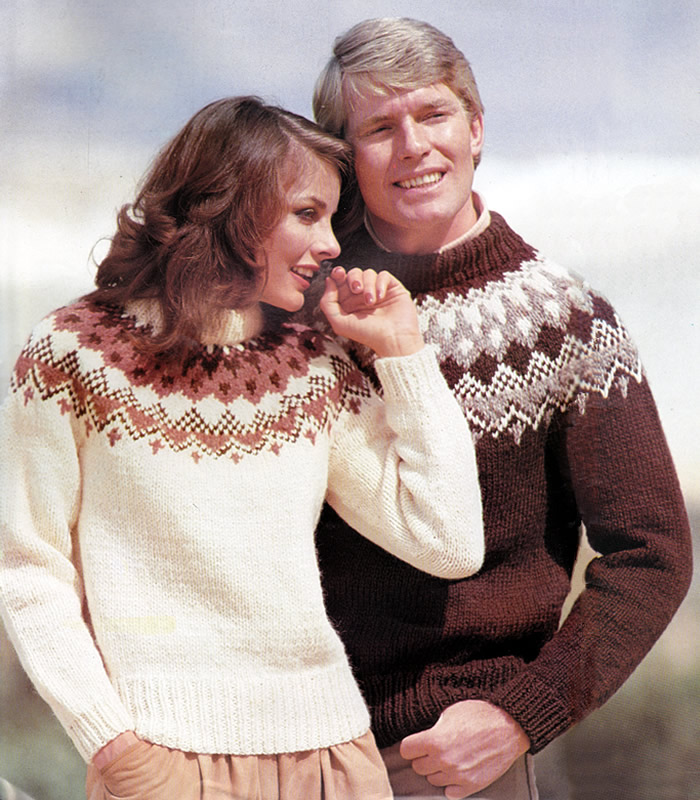
I have always loved Lopi sweaters (whatever the era) and I thought the one worn by Martin Freeman in Sherlock (2011 - was it that long ago?!) was especially good. I love the navy base and the Christmassy air about it. For all I know, in the context of the show, it may have been meant as a joke Christmas jumper - but I love it despite many Sherlock fans labelling as ugly (ugly?!).
As you can see this pattern I have provided here, as made popular in the 70s and 80s, goes with the muted natural tones of the era, so you would need to change the colours to your own choice - mine being navy white and red, of course. You can, however, see in the picture what a difference the colour scheme makes; both his and hers sweaters are knitted to the same pattern, and yet with a change to the main shade and order of contrasts it looks like quite a different pattern.
Instructions.Note: When working colour pattern from chart, strand yarn not
in use loosely across wrong side of work over not more than 3 stitches
at a time to keep fabric elastic. Back and Front (alike)With 5mm needles and main shade A, cast on 75 [79,
83, 87, 91,
95] stitches, and work in K1/P1 rib
for 4 inches (10cm), right-side rows having K1 at each end, and ending
with wrong side facing for next row. Change to 6mm needles and starting with a knit row, work in stocking stitch until work measures 15½ (15½, 15, 14½, 15, 14½] inches, (39 [39, 38, 37, 38, 37] cm), ending with a purl row. Shape armholes by casting off 5 stitches at the beginning of the
next 2 rows. Sleeves (two alike)With 5mm needles and main shade A, cast on 33 [35,
37, 39, 39,
41] stitches, and work in rib as
on Back for 4 inches (10cm), and ending with wrong side facing for next
row. Change to 6mm needles and starting with a knit row, work in stocking stitch, shaping sides by increasing 1 stitch at each end of the 3rd [3rd, 5th, 3rd, 7th, 7th) row. Continue in stocking stitch in main colour
only on 6mm needles and increase 1 stitch at each end of every following
8th [8th, 9th,
9th, 9th, 8th]
row until there are 58 [60, 60,
64, 64, 68]
stitches. Shape armholes by casting off 5 stitches at the beginning of the
next 2 rows. 1st, 3rd, 4th and 6th sizes only: Decrease 1 stitch at each end of the next row. Work 1 row. All sizes: Leave remaining
44 [46, 44,
48, 48, 50]
stitches on a spare needle or stitch holder. Yoke and Neck BorderWith right side facing, slip the first 32 [33,
34, 36, 37,
38] stitches from the back on a spare
needle with points at both ends. If you are using 6 double pointed needles, then divide the stitches evenly
on 5 needles. Mark the first stitch of the round with a coloured thread,
then joining in and breaking off colours as required, work the 32 [32,
32, 36, 36,
36] rounds from Chart A [A,
A, B, B,
B], repeating the 8 pattern stitches
27 [28, 28,
30, 31 , 32]
times across and decreasing where indicated. Chart A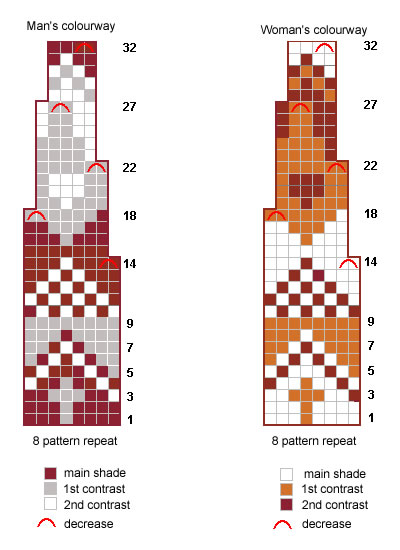 Chart B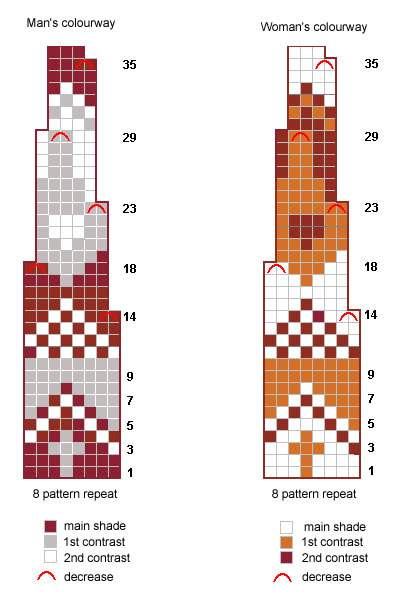 Break 1st and 2nd contrasts and continue in main shade only. Shape Back as follows: Change to set of four (or circular) 5mm needles and decrease 1 stitch
on the first round on 1st and 5th sizes only
(to make them an even number of stitches). To Make UpWith wrong side of work facing, block each piece by pinning out round edges, and omitting ribbing press lightly following any instructions on the ball band. When making up a chunky garment it is easier to use an oddment of finer yarn in a toning shade for the sewing. If you prefer to make up with the original yarn, use 76cm lengths and a large needle, making sure the yarn keeps its original twist by turning the needle clockwise between fingers and thumb after every few stitches. Join armhole, side and sleeve seams. Press seams. |
MaterialsChunky knitting yarn: 2 balls in each of 2 contrast colours for all sizes. Pair each 5mm, 6mm, and 6½mm needles. Tension15sts and 20 rows to four inches on 6mm needles over stocking stitch.
Size mattersTo fit chest: Abbreviations k: knit A word on the wool.Original yarn was Patons Husky Chunky. Disclaimer
|
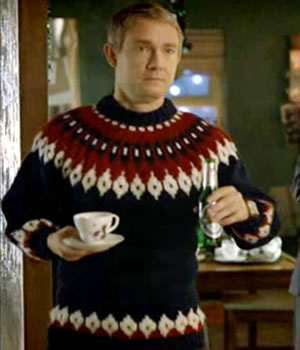
Note that Dr Watson has patterning just above the welts on the body and the sleeve.
If you want to knit the actual original, it is Alafoss 52 - again looking quite different in the natural tones associated with Icelandic sweaters.
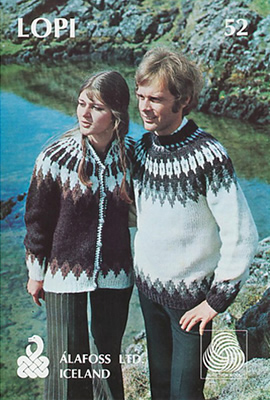
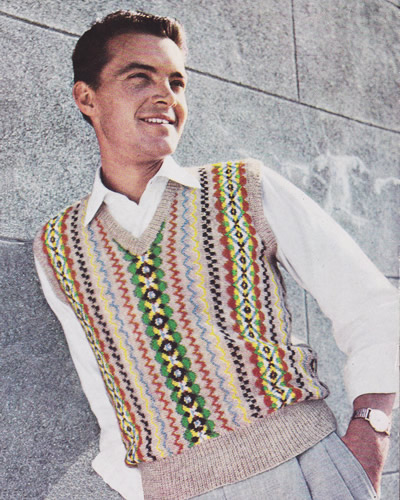
Fair-Isle pullover or vest in bright colours, with the added interest in that it is knitted sideways.
Instructions:The pullover is worked sideways using the Fair-Isle technique. Strand
the wools not in use loosely across the back of the work. BackBegin at the left side edge. Using No 9 (3¾mm) needles and main
shade natural yarn cast on 84 stitches. Continue in stocking stitch, working the pattern from the chart, reading knit rows from right to left and purl rows from left to right. Work the 12 pattern stitches 7 times across. When the 10th row of the chart has been completed, continue in pattern,
working armhole increasings as shown on the chart, and keeping
the extra stitches in pattern as indicated. Continue in pattern, increasing 1 stitch at the shoulder edge at the
end of the 29th, 37th, 45th, and 53rd rows as indicated. [151 sts] For the second half of the back, work down from top of chart, that is:
77th, 76th, 75th, 74th rows, etc, still reading from right to left on
knit rows and left to right on purl rows. Work straight to the end of the chart, then purl 1 row in natural. FrontBegin at the right side and work exactly as for the first half of the back until the 57th row has been completed. [151 sts]. Divide for neck opening: Continue in pattern, casting off 5 stitches at the beginning of the next
9 purl rows as indicated on the chart. [91 sts] For the second half of the front, work down from the top of the chart as before, casting on stitches at the neck edge to correspond with those cast off on the first half, and decreasing at the shoulder and armhole edges as indicated. When the chart is complete, purl 1 row in natural. Ribbed weltWith the right side of the work facing, using No 12 needles and main shade natural, pick
up and knit 140 stitches along the lower edge of the back. Work the front welt in the same way. NeckbandJoin shoulder seams. With the right side of the work facing, using No 12 needles and main shade natural, beginning at the centre back, pick up and knit 88 stitches to centre front. Work 10 rows k1/p1 rib, decreasing 1 stitch at the centre front on alternate rows; cast off in rib. Work the other half to correspond. Armhole bandsWith the right side of the work facing, using No 12 needles and main shade natural, pick up and knit 160 stitches round each armhole. Work 10 rows k1/p1 rib; cast off in rib. To Make UpPress parts well under a damp cloth. |
|
Materials4 x 1oz balls of 4 ply fingering in main shade (natural), plus 1 oz each in 6 contrast colours: brown, yellow, blue, rust, emerald, white. A pair each No 9 (3¾mm) and No 12 (2¾mm) needles. Tension30sts to 4 inches Size mattersChest to fit one size: 39-41 inches. Abbreviationsk2tog/p2tog: decrease by knitting/purling 2 sts together. stocking stitch: one row knit and one row purl, ("stockinette"). A word on the woolOriginal called for Patons Fair Isle Fingering about which there is some information available on Ravelry. This pattern is in ounces but it seems the yarn
stuck around for a while as some vintage stocks can be seen in 25g balls. Jamiesons are Kings (or Queens) of Fair Isle and Shetland knitting - their Spindrift yarn sounds a good substitute: equivalent to a traditional 4ply; ideal for Fair Isle knitting; extensive colour pallet of over 220 colours; supplied in 25g Balls (105m); tension: 30sts x 32 rows on 3¼mm needles. Disclaimer
|
|
For a pdf version of the chart you can right click >>here<< and choose "save link as" or "save target as" (browser dependent options) to download and save a pdf file. |

I love the styling of this photo - the poise of the model, the "clashing" colour combination, the bracelet, and the lovely use of the location which makes the very best of the look of fresh summer rain.
This is a fairly simple pattern where the vertical contrast stripes are made by stranding the unused colour across the back (as opposed to intarsia) and this makes for a slightly more interesting 3D effect, even though they compensate by changing needles and stitch count over the different sections.
Not everyone likes mustard (or yellow...) but I think this sweater looks quite sophisticated as the colours are close on the colour wheel but not really matching. I have a sweater in pink with orange trim which gives a similar effect (less violent than it might sound!). Bear in mind also that mustard can be a difficult shade to pin down - so it could be gold or beige - just make sure it tones perfectly with your pencil skirt....
Instructions. Instructions for larger size is given in brackets. Where one set of
figures is given, this applies to both sizes. Back and Front alikeWith No 10 (3¼mm) needles, cast on 100 (106) stitches and work in k1/p1 rib for 1¼ inches, increasing 14 (16) stitches on the last row by working twice into every 7th (6th) stitch 14 (16) times: [114 (122) sts] ‡‡ 1st row: Using Mustard yarn (M),
* k2, keeping wool at back of work,
slip 2 purlways; rep from * to last
2 stitches, k2. Repeat the last 4 rows 8 times more. Change to No 8 needles and continue in stocking stitch in yarn Y, thus: Next row: * k 7 (8), k2tog; repeat from * to last 6 (2) stitches; k6 (2): [102 (110) sts] Work 13 rows straight in stocking stitch. Join in yarn M, and work horizontal stripes of 2 rows M, 2 rows Y, 2
rows M, 2 rows Y, 2 rows M. Work 13 rows in yarn Y. Next row: * p7 (8), purl twice into next stitch; repeat from * to last 6 (2) stitches, p6 (2): [114 (122) sts] Repeat from ‡‡ to ‡‡ Continue in yarn Y and shape armholes by casting off 5 (6) stitches at the beginning of the next 2 rows, then decrease 1 stitch at each end of the next 6 knit rows: [80 (86) sts] Next row: * p 6 (9), purl twice in the next stitch; repeat from * to last 10 (6) stitches, p 10 (6): [90 (94) sts] Change to No 7 needles, join in M and work the 36 rows of vertical stripes.
Change to No 8 needles. Next row: *
k6 (9), k2tog; repeat from *
to last 10 (6) stitches, k10 (6):
[80 (86) sts] Join in M and work horizontal stripes of 2 rows M, 2 rows Y, 2 rows M,
2 rows Y, 2 rows M. Shape shoulders: by casting off 6 (7)
stitches at the beginning of the next 6 rows. Back and Front alikeMake a second piece for the front exactly as instructions above. SleevesWith No 10 needles and yarn Y, cast on 48 (50) stitches, and work 2½ inches in k1/p1 rib. With right side facing, change to No 8 needles and stocking-stitch, starting with a knit row, and shape sides by increasing 1 stitch at each end of the 7th and every following 6th row until there are 70 (72) stitches. Work straight until sleeve seam measures 16½ (16½)
inches. To Make Up Press parts lightly on wrong side under a damp cloth, avoiding ribbing.
|
Materials
|


The era of the "set" — a sweet and quirky twin set for you to enjoy while soaking up the sun.
[I would, but I have a serious case of teeny tiny waist envy].
InstructionsThis is a two-piece: a bolero with pointed edge, and a sleeveless top with back and front V-neck. Bolero BackBegin at the back of the neck. With right side facing, continue in rib, casting on 18 stitches at the
beginning of the next 2 rows, then 6 stitches at the beginning of the
With right side facing, shape for armholes by increasing 1 stitch
at the beginning of the next 8 rows, then cast on 8 stitches at the beginning
of the following 2 rows, taking the extra stitches into the ** Here divide for points: Next row (right side facing): rib 78, turn, and leave remaining stitches on a spare needle, or stitch holder. ¶Continue to work backwards
and forwards on these 78 stitches using With right side facing, rejoin wool to last 78 stitches and Bolero FrontsLeft bolero front: Begin at the shoulder. With wrong side facing, continue in rib, casting on 6 stitches at the
With right side facing, continue in rib and shape front edge by increasing
1 stitch at the beginning of the next row (front edge) then on every following
4th row, 18 times in all, taking the extra stitches into rib as they are
made; afterwards keep the front edge straight. When the armhole (straight
edge) measures 7½ inches from the end of the shoulder shaping, with
wrong side facing, increase 1 stitch at the beginning of the next and
following 3 alternate rows, then cast on 8 stitches at the beginning of
the following alternate row. [78 sts]. With right side facing, shape as for back by working from ¶ to ¶. Right bolero front: Work as for left, reversing all shapings. Sleeves (two alike)With two No 12 (2¾mm) needles, cast on 116 stitches and work Continue in rib, shaping the top by casting off 4 stitches at the beginning
of the next 2 rows, then decrease 1 stitch at the beginning of every row
until 66 stitches remain, then at each end of every row until 32 stitches
remain. Sun Top (back and front alike)With two No 13 (2¼mm) needles, cast on 126 stitches and work Here divide for points exactly as given for back of by working from ** to ** . Making upPress parts only very lightly on the wrong side under a damp cloth. Join shoulder and sleeve seams of bolero and side seams of sun top. Cords: Take 6 strands of Viridian each 60 inches long and twist
tightly together; then fold in half allowing two halves to twine round
each other to form a cord; thread through holes in crochet edging on inside
edges of points of sun-top; make a similar cord for back inside edges,
then two more in red for outer edges of points. |
Materials3ply fingering:- A set of 4 No 12 (2¾mm) needles. TensionEquivalent to a basic tension of Size mattersOne size only to fit 34-35 inch chest; Abbreviationsk2tog or p2tog: work 2 sts together to decrease. sl1: slip one stitch by passing it between the needles without knitting it. psso: pass the slipped stitch over. sl1, k1, psso: slip 1, knit 1, pass the slipped stitch over; also known as "ssk" (slip, slip, knit). Disclaimer
|


Very pretty lacy tops with the emphasis on wool economy.
The style of this pattern in conjunction with the price (3d), the emphasis on economy, and its pattern sequence number is giving me mixed messages as to the date; however general opinion seems to be that these patterns are from the late 1940s.
Instructions. Instructions for the larger size is given in brackets. Where one set
of figures is given this applies to both sizes. FrontWith No 13 (12) needles, cast on 123 stitches. 1st row: p3, *
k3, p3; repeat from * to end. Change to No 11 (10) needles and pattern as follows: 1st row: k1, *
k1, wo, k4, sl1, k2tog, psso, k4, wo; repeat from *
to last stitch, k1. Repeat the 10 pattern rows 7 times more. (80 rows). Shape Armhole: Cast off 5 stitches at the beginning of the next 2 rows; then 4 stitches at the beginning of the next 2 rows, and 3 stitches at the beginning of the next 2 rows. [98 sts] 7th row: As 7th pattern row. Shape Neck: Cast off 22 stitches, (1 stitch on the right-hand needle), pattern 37
stitches. 70th row: cast off 10 stitches; purl
to end. Left shoulder: BackWork to match the front until 5 complete patterns have been worked from the beginning of the armhole shaping. Divide for Back Opening: 51st row: work 49 stitches in pattern.
Turn. Shape Shoulder: Left Shoulder: Sleeves:With No. 13, (12) needles. cast on
87 stitches. 10th row: p3, * increase into next stitch, p8; repeat from to last 4 stitches, increase into next stitch, p3. [98 sts] Change to No 11 (10) needles and
pattern. Shape Top: Neck BandBack-stitch shoulder seams very neatly. Making UpSeam-stitch side and sleeve seams. Make 4 buttons follows: Lay on a blanket or well padded board and press lightly on wrong side
with a hot iron and damp cloth, omitting all ribbing. |
Materials
|

Very pretty lacy tops with the emphasis on wool economy.
The style of this pattern in conjunction with the price (3d), the emphasis on economy, and its pattern sequence number is giving me mixed messages as to the date; however general opinion seems to be that these patterns are from the late 1940s.
Instructions. This jumper with the low neck is given only in one size. FrontWith No. 10 needles, cast on 123 stitches. 1st row: p3, * k3, p3, repeat from
* to end. Change to pattern as follows:
1st row: k1, *
k1, wo, k4, sl1, k2tog, psso, k4, wo; repeat from *
to last stitch, k1. Repeat the 10 pattern rows twice more. (3 complete patterns of 10 rows each). Change to No 12 needles and work 20 rows.
Change back to No 10 needles and work 70 rows. Shape Armhole: Cast off 12 stitches. With 1 stitch on the right-hand needle, work as
1st pattern row to the last 12 stitches. Cast on 24 stitches. Join to work. Purl 98 stitches, and cast on 24 stitches
at the end of the row. Neck Shaping: Shape Shoulder: Left Side of Neck: Cast off 6 stitches at the beginning of this and the 2 following alternate
rows, then cast off 3 stitches at the beginning of the 2 following alternate
rows. Shape Shoulder as for right side of neck, beginning with a 7th pattern row. NeckWith No 10 needles and right side of work facing, pick up and knit 98 stitches all round neck. Purl 1 row. Change to No 12 needles. BackWork to match the front exactly. Making UpRun a thread along each of the cast on 24 stitches and gather to fit
the 12 cast off stitches. Sew together very neatly on the wrong side.
Lay on a blanket or well padded board and press lightly on wrong side
with a hot iron and damp cloth, omitting all ribbing. |
Materials
|

Anyone for cricket?
I made this as a slipover for a long, lean, and lanky chap; it is based on the pattern given but I adapted it to use some Guernsey yarn instead of DK (by knitting a bigger size and making it much longer to fit the chap - seemed like the body was never-ending!).
The instructions are for a full sweater pattern as well as the slipover.
Instructions.The sweater is worked in a good range of sizes, intended to cover kids
and men, but could also fit women, making suitable length adjustments
in body and sleeve. Instructions for the larger sizes are shown in brackets.
Sweater BackWith No 10 (3¼mm) needles and main shade, cast on 77, 83, 89, 95, 99, 105, 111, 117, 121, 127 stitches. ** If not including contrast colours, Repeat 1st and 2nd rows 10 times then the 1st row again, and continue below with 24th (increase) row. If including contrast colours, repeat 1st and 2nd rows once. Change to No 8 (4mm) needles and proceed as follows:- For three smallest sizes only (28, 30 and 32 inch chest): *** For the medium-small sizes only (34, and 36 inch chest): *** For the three medium-large sizes only (38, 40 and 42 inch chest): *** For two largest sizes only (44 and 46 inch chest): *** FOR ALL 10 sizes Under each separate section for the size you are working, the instructions embedded between *** to *** forms the pattern. Keeping continuity of pattern (throughout) continue until work measures 11½ (13, 14, 13½, 15½, 15½, 15½, 15½, 15, 16) inches from the beginning, ending on a wrong side row. Shape armholes: **** Continue without shaping until armhole measures 7½ (8, 8, 8½, 10½, 10½, 10½, 10½, 11, 11) inches, ending on the wrong side. Shape shoulders: Cast off remaining 33 (37, 37, 37, 37, 43, 43, 43, 43, 47) stitches in pattern. Sweater FrontWork exactly as given for back until **** is reached in the armhole shaping section. Divide for neck: Working on these 47 (51, 54, 58, 62, 67, 71, 74, 78, 82) stitches only, proceed as follows: Next row: pattern to last 2 stitches,
p2tog. Work 7 (9, 11,
13, 5, 11,
15, 16, 13,
21) rows, decreasing once at the armhole edge on every row, and
at the same time decreasing at the neck edge on the next
and every alternate row. For one medium and the two largest sizes only (36, 44 and 46 inch chest): Work - (-, -,
-, 3, -,
-, -, 7,
1) rows, decreasing once at the armhole edge in every row, at
the same time decreasing once at the neck edge on the - (-,
-, -, 0,
-, -, -,
4th, 0) row. For the smallest and other large sizes only (28, 30, 32, 34, 38, 40, 42 inch chest): Work 12 (14, 12,
6, -, 6,
2, 1, -,
-) rows, decreasing once at the neck edge only on every following
2nd (2nd, 2nd,
2nd, -, 2nd,
2nd, 1st, -,
-) row. FOR ALL 10 sizes Work 20 (20, 20,
28, 53, 44,
44, 44, 45,
43) rows, decreasing once at the neck edge only on the 4th (4th,
4th, 4th, 1st,
4th, 4th, 4th,
1st, 3rd), and every following 4th
row. Continue without shaping until armhole measures same as Back to "Shape Shoulders" section, ending on wrong side row. Shape shoulders: Work the other half of the front to match the first as follows: With right side facing, slip the first stitch of the the remaining stitches
on to a safety pin (this is the centre stitch). Next row: k2tog, pattern to last
2 stitches, k2tog. Work 7 (9, 11,
13, 5, 11,
15, 16, 13,
21) rows, decreasing once at the neck edge on the next and every
alternate row, and at the same time decreasing once at
the armhole edge on every row. For one medium and the two largest sizes only (36, 44 and 46 inch chest): Work - (-, -,
-, 3, -,
-, -, 7,
1) rows, decreasing once at the neck edge on the - (-,
-, -, 0,
-, -, -,
4th, 0) row, at the same
time decreasing once at the armhole edge on every row. For the smallest and other large sizes only (28, 30, 32, 34, 38, 40, 42 inch chest): Work 12 (14, 12,
6, -, 6,
2, 1, -,
-) rows, decreasing once at the neck edge only on every following
2nd (2nd, 2nd,
2nd, -, 2nd,
2nd, 1st, -,
-) row. FOR ALL 10 sizes Work 20 (20, 20,
28, 53, 44,
44, 44, 45,
43) rows, decreasing once at the neck edge only on the 4th (4th,
4th, 4th, 1st,
4th, 4th, 4th,
1st, 3rd), and every following 4th
row. Continue without shaping until armhole measures same as Back to "Shape Shoulders" section ending on right side. Shape shoulders: Sweater Sleeves (both alike)With No 10 needles and main shade, cast on 43 (43, 45, 45, 55, 55, 59, 59, 59, 61) stitches. Work from ** to ** as given for Back. 24th (increase) row: p6 (6,
8, 8, 11,
11, 11, 11,
11, 13); *
increase once in the next stitch purlwise; repeat from *
to the last 7 (7, 9,
9, 12, 12,
12, 12, 12,
14) stitches: p7 (7, 9,
9, 12, 12,
12, 12, 12,
14). Change to No 8 (4mm) needles and using main shade throughout proceed in pattern as give for 1st (1st, 1st, 1st, 3rd, 3rd, 9th, 9th, 9th, 9th) size of Back and at the same time, increasing once at each end of the 1st (1st, 1st, 1st, 3rd, 3rd, 9th, 9th, 9th, 9th) and every following 1st (1st, 1st, 1st, 3rd, 3rd, 9th, 9th, 9th, 9th) row until there are 87 (81, 89, 81, 117, 117, 107, 107, 125, 125) stitches, working the increased stitches into the pattern. For all sizes EXCEPT the smallest only (30, 32, 34, 36, 38, 40, 42, 44, 46 inch chest): Increase once at each end of the following - (6th, 6th, 6th, 4th, 4th, 6th, 6th, 4th, 4th) row, until there are 87 (95, 95, 101, 129, 129, 129, 129, 137, 137) stitches, working the increased stitches into the pattern. FOR ALL 10 sizes Continue without shaping until sleeve measures 14½ (15½, 16½, 17, 20, 20, 20, 20, 20, 20) inches, ending on the wrong side. Shape Sleeve Top Work 20 (20, 20,
24, 36, 36,
32, 32, 36,
36) rows, casting off 2 stitches at the beginning of every row.
Cast off loosely in pattern. Sweater NeckbandJoin right shoulder seams. If you are including a contrast then proceed as follows, otherwise follow the same instructions using only the main shade. 1st row: Using main shade *
p1, k1, repeat from * to last stitch
pl. Cast off in rib. To Make Up the Sweater Review the yarn ball band for any special washing or pressing instructions.
Slipover Back, Front, and NeckbandWork exactly as given for sweater. Slipover Armbands (alike)Join left shoulder and neckband seams. With right side facing, using No 10 (3¼mm) needles and main shade pick up and knit 101 (107, 107, 113, 135, 135, 135, 135, 141, 141) stitches evenly around the armhole edge. If you are including a contrast then proceed as follows, otherwise follow the same instructions using only the main shade. 1st row: Join in and use contrast,
* p1, k1, repeat from *
to last stitch, p1. Using main shade, repeat 1st and 2nd rows twice. To Make Up the Slipover Review the yarn ball band for any special washing or pressing instructions.
|
MaterialsDouble Knitting yarn in white or ivory. Pair each of No 8 (4mm) and No 10 (3¼mm) needles. Tension29sts and 30 rows to four inches on 4mm needles over pattern.
Size mattersTo fit chest: Abbreviations k: knit A word on the wool.Original yarn was a good quality double knitting woollen blend. Disclaimer
|

Printed towards the end of WW2, in an era of extreme shortages **, this is knitwear designed with a view to using left overs or even maybe "pulled back" wool.
Despite that I think it looks really attractive - and is a very interesting design being knitted sideways.
Instructions. Instructions for one size. Pattern:1st row (wrong side facing): Purl.
Repeat these 12 rows throughout. BackThe bolero is knitted sideways. With No 10 (3¼mm) needles, cast on 90 stitches and work 5 rows of the pattern. Now increase at the beginning of the next and end of every following
row at this side until there are 108 stitches, and 23 rows are done. Work straight until 2 more complete patterns are done, and then work
1 row of the next pattern, which brings you back to the top of the shoulder.
At the beginning of the 10th row cast on 16 stitches, and then finish the shoulder to correspond with first side, casting off 37 for the armhole and decreasing on every row thereafter until 90 stitches remain. Finish off with 5 rows straight. There are 15 patterns in total across the back, omitting the last 2-row white stripe. Left frontWork as for back, but cast off 26 instead of 16 stitches on the shoulder. Right frontWork to correspond with left front. [Editor's note: They
are assuming rather a lot here and expect you will work this out for yourself.
You could continue to work the in the same sideways direction: as you
have just cast off at the centre front, so you could cast on for the right
front at the centre front which would mean casting on 119 stitches - then
casting on 26 at the shoulder, and completing the shaping as you did for
the back. Neck RibbingJoin back and front shoulder seams. With No 10 (3¼mm) needles, and front of work facing, pick up and knit 80 stitches across the back of the neck. Work in k1/p1 rib, decreasing at each end of every alternate row 5 times. Change to No 12 (2¾mm) needles and continue in rib, decreasing as before until 48 stitches remain. Cast off fairly tightly in rib. For each front section pick up and knit 44 stitches in the same way,
and decrease 5 times on alternate rows at the side edge before changing
to No 12 needles. Then decrease as before until 22 stitches remain. For each shoulder piece pick up and knit 42 stitches across each shoulder and then shape as for back, casting off the remaining 10 stitches. [Editor's note: It may or may not be obvious here but you are knitting on the sides of a rectangle here and decreasing towards the middle; when you sew these together you will have mitred corners - you can just see this in the photograph.] Front BordersWith No 12 (2¾mm) needles, cast on 13 stitches and work a length
of k1/p1 rib long enough to go up the left front. To make a buttonhole: rib 5, cast off 3, rib 5; on the next row cast on 3 over those cast off in the previous row. Continue strip for the length required, then cast off in rib. SleevesWorked sideways in pattern. With No 10 (3¼mm) needles cast on 13. 1st row: Pattern to end. Repeat 2nd and 3rd rows 3 times more. 10th row: As 2nd. Repeat 12th and 13th rows 15 times more, then the 12th row again. 87th row: Pattern to the last 2 stitches,
k2tog. Repeat 87th and 88th rows 15 times more, then 87th row again. 120th row: k2tog, pattern to end.
Repeat 122nd and 123rd rows 3 times more, leaving 13 stitches on the
needle. This finishes the 11th coloured stripe. Making UpPress work lightly on wrong side under a damp cloth. |
Materials3 ply yarn: 1 oz in main shade (M) plus 1oz each in 5 different shades of the same wool, or odd balls of different colours to make up this amount. [Editor's note: Looking at the photo and instructions, presumably one of these colours needs to be white.] Pair each No 10 (3¼mm) and No 12 (2¾mm) needles. Tension32 stitches to 4 ins on No 10 (3¼mm) needles. Size mattersTo fit chest 33-35 inches; AbbreviationsTwist A: Knit into back of 2nd stitch on left-hand needle, then knit into front of 1st stitch, drop both stitches off needle together. Twist B: Knit into front of 2nd stitch on left needle, then knit into front of 1st stitch on left needle, slip both off together. k2tog or p2tog: work 2 sts together to decrease. A word on the woolSusan Crawford, who specialises in vintage knits, offers lovely Fenella wool which "knits up to that elusive vintage ‘3 ply’ tension". Jamiesons have an excellent range of colours in "2ply laceweight" which states: This yarn can be used in vintage patterns which call for "3ply yarns". John Arbon has some wonderful laceweight that looks suitable. Disclaimer
|
** The 'Make Do and Mend' campaign - which is currently quite a well known slogan from WW2 - was launched to encourage people to make their existing clothing last longer. Clothes care was a key part of the Make Do and Mend message. Shortages of basic materials and consequential clothing rationing necessitated imaginative use of materials; this included recycling and renovating old clothes, and the innovative use of home-made accessories, which could alter or smarten up an outfit. You see a lot of these ideas in magazines of that era appearing as little knitted collars and cuffs or just inexpensive embellishment ideas. This type of pattern continues from its humble beginnings well into the 1950s - and not surprising since although the war ended in 1945, clothes rationing did not end until 1949.
Rationing worked by allocating each item or category of clothing a 'points' value which varied according to how much material and labour went into its manufacture. Each person was allocated a fixed number of coupons to "spend" when they purchased clothing. In 1941, at the inception, adults receive 66 but this allocation shrank as the war progressed: to 48 in 1942, 36 in 1943 and 24 by 1945. As for knitwear specifically - a jumper, for example, used up 5 coupons and socks 1-3. Making your own knitwear did not help much since knitting wool was also rationed (almost pro rata) with two ounces of knitting yarn requiring one coupon; however, with essentials such as boots and overcoats requiring 7 coupons you can see why people were reluctant to spend any coupons at all on knitwear when they could reuse old "pulled back" yarn.
One interesting result of this evolved from the fact that "mending cards" of yarn were not rationed at all - presumably to encourage the make-do-and-mend mentality. They were traditionally dull buff or grey colours being intended to darn mens socks. [I have inherited many of these cards which sit at the bottom of my work basket - commercial socks are much tougher these days]. However during this period the commercial yarn companies started to produce "mending cards" in all kinds of wild colours which fitted perfectly with multicoloured designs such as this bolero, or the ubiquitous Fair Isle sweater patterns of the period. The influence of rationing some items and not others could be seen much wider than just in knitting yarn in that people would find ways of using many different or less usual materials for clothing if they happened to be "off the ration".
The popularity of multicoloured sweaters, and specifically Fair Isle, was very much to do with being able to use smaller amounts of yarn from different sources and make a garment that looked fresh and new, rather than the collection of oddments which it really was. Sewing patterns were also offered with this in mind - I have a lovely blouse pattern from the period with terrific square shoulders and nipped in waist that is designed to be made in 2 fabrics out of "2 of your husbands old shirts" with the pattern pieces shown laid out accordingly on the shirts, (noting that men's shirts of the period were positively voluminous).

Another highly wearable jumper with a flattering neckline from the 1950's.
The sleeves look to be a pleasing (to me) three-quarter length but with a set in style that is almost a dolman, yet with a flattering line fitted to the neck shaping.
Although cited as a "thickie" in 1950s terms it's made in a standard double knitting weight yarn - so "Spring Thickie" or "Square Neck Casual" - I leave the name up to you.
Instructions.Instructions for the larger size is given in brackets. Where one set of figures is given this applies to both sizes. The sweater is worked in an all-over pattern involving loops and slipped
stitches. It is advisable to practise this stitch to get used to it before
starting the main work. Take particular care not to drop any stitches
as it is difficult to pick them up again without spoiling the pattern.
Pattern stitchWith No 9 needles, cast on 13 stitches, and work 2 inches to practise
the pattern. The 3rd row forms the pattern and this row is now repeated throughout. [Editor's note: Just to encourage you - this pattern is easier to do in practice than to explain.] BackUsing yarn in main shade and No 9 needles, cast on 101 (109) stitches and work straight in pattern starting with 1st and 2nd rows [once 2nd row is done there are 100 (108) stitches]; continue until 31 (31) ridges have been done from start. Continue in pattern and shape for armholes: With wrong side facing, rejoin wool and continue straight in pattern
until 51 (51) ridges have been done
from start. **Continue
thus: Pocket linings (make 2 the same)Begin by making pocket linings. FrontUsing yarn in main shade and No 9 needles, cast on 101 (109)
stitches and work in pattern exactly as given for back, starting with
1st and 2nd Next row (right side facing): pattern
9 (11), leave main shade yarn hanging,
and join in white, [knit the next 2 loops together, winding wool once
round needle] 26 times, slip these 26 white stitches on a spare needle
or stitch holder for the time being; pick up the main shade yarn again
and work across the 26 (26) stitches
of one pocket lining thus [k1 winding wool twice round needle] 26 times,
pattern across the next 30 (34) stitches
of main work, again leave main shade yarn hanging, join in 2nd ball of
white and work across the next 26 (26)
stitches as before and leave on a spare needle or stitch holder; pick
up main shade and work across 26 (26)
stitches of 2nd pocket lining as before, pattern 9 (11).
With right side facing, work striped rib border for neck exactly Left sleeve** Change to No 9 needles and rib 3 rows in white. Join in main shade and work first 3 rows of pattern as given for back.
Continue repeating the last row until there are 123 (123)
stitches ‡With right side facing shape
top. Right sleeveWork as for left sleeve from ** to
** [123 (123)
sts]. To Make UpDo not press. With No 11 needles and white wool, work a further 3 rows rib across each pocket top, then 2 rows main shade, 3 rows white; cast off in rib in white Catch down sides of pocket tops and pocket linings. Press seams lightly. |
Materials
|


This knitting pattern is not at all challenging (except maybe the 4 needles).
No - it's really all about the delightful picture - such a charming fresh-faced model with those decorous come-hither eyes - all combined with lovely bright colours designed to be cheering for the home makers during WW2.
This kind of quirky Wee Willy Winkie hat did become popular for a while, a few years ago but I haven't seen many around lately. Big pom poms are still the thing though....!
Materials4 ozs mixed shades fingering, 2-ply. [Editor's note: the "2ply" is probably literally two plies but in yarn weight perhaps more like a 3 ply going by the stated tension,] A set of four No 11 (3mm ) needles. Instructions.Cast on 120 stitches, 40 on each of 3 needles. When 6 inches are done start to decrease very gradually. When cap is desired length k2tog all round, then draw wool through remaining
stitches and fasten off. Finish off the end with a multicoloured wool pom-pom, but don't make
You may need to run thread elastic round cast-on edge to keep cap firm on the head. |
Tension8 stitches to an inch. Size matters
Original cap is 30 inches long but you could make one 18 inches long that
is perhaps more suitable for every day wear. Disclaimer
|

Suitable for all 5 year olds who aren't expecting an iphone, (and who like to play out of season cricket).
Instructions:The jersey is worked in one size - stated as a 5 year old but remembering that children now tend to be larger than they were in the early 1950s. BackUsing No 12 (2¾mm) needles and main shade (mid blue) cast on 84 stitches, and work 1½ inches in k1/p1 rib, increasing to 85 stitches on the last row. Change to No 10 (3¼mm) needles and stocking stitch, and changing from the main mid-blue wool to the pale blue as the background colour for the motifs, work the soldier pattern from chart, reading knit rows from right to left and purl rows from left to right.

Work the 12 pattern stitches 7 times across with last stitch on knit
rows and first stitch on purl rows as indicated. When 20 rows have been completed, change back to the mid-blue main shade and work straight in stocking stitch until back measures 8 inches. Then, with right side facing, shape armholes by casting off 5 stitches
at the beginning of he next 2 rows. Then k2tog at each end of every knit
row until 65 stitches remain. With right side facing, shape shoulders by casting off 12 stitches
at the beginning of the next 4 rows. FrontWork exactly as for back until the first 2 rows of the armhole shaping have been done. [75 sts] Now divide for the neck: Continue on these 35 stitches for back, decreasing 1 stitch at the armhole edge on the next 4 rows, then keeping the armhole edge straight, and at the same time, decreasing at the neck edge on every following 3rd row until 24 stitches remain. Work straight until front matches back, then with right side facing, shape shoulders by casting off 12 stitches at the beginning of the next and following alternate row, armhole edge. Join the wool to the remaining stitches, at the neck edge; cast off 1,
then work to correspond with first half, reversing all shapings. SleevesUsing No 12 (2¾mm) needles and main shade (mid-blue) cast on 48 stitches and work 1 inch in k1/p1 rib, increasing to 49 stitches on the last row. Change to No 10 (3¼mm) needles and stocking stitch, and work the 20 rows from the chart as for the back. When these are done, change back to the main mid-blue wool and continue in stocking stitch, increasing 1 stitch at each end of the next and every following 6th row until there are 63 stitches. Work straight until sleeve measures 10½ inches. With right side facing, shape top by casting off 3 stitches at
the beginning of the next 2 rows, then k2tog at the beginning of every
row until 21 stitches remain. NeckbandJoin right shoulder seam. With right side facing, using No 12 (2¾mm) needles and mid-blue main shade, pick up and knit 48 stitches down left front, 1 stitch from centre, 48 stitches up right front, and 18 stitches across back of neck. Work ¾ inch k1/p1 rib; decreasing 1 stitch either side of centre
front stitch on alternate rows. Making UpOmitting ribbing, press each piece carefully on wrong side using a warm
iron and a damp cloth. |
Materials3 oz Fair Isle Fingering in main shade (mid blue) and 1 oz in paler blue. Small balls in red and navy for the soldier motifs. A pair each No 12 (2¾mm) and No 10 (3¼mm) needles. Tension30 sts and 38 rows to 4 inches over stocking stitch. Size mattersOne size - width all round chest 25 ins. Abbreviations:k1: knit 1. A word on the woolOriginal called for Patons Fair Isle Fingering about which there is some information available on Ravelry. This pattern is in ounces but it seems the yarn
stuck around for a while as some vintage stocks can be seen in 25g balls. Jamiesons are Kings (or Queens) of Fair Isle and Shetland knitting - their Spindrift yarn sounds a good substitute: equivalent to a traditional 4ply; ideal for Fair Isle knitting; extensive colour pallet of over 220 colours; supplied in 25g Balls (105m); tension: 30sts x 32 rows on 3¼mm needles. Disclaimer
|


Another "summer" top, which I always thought would be eminently suited to a winter cocktails evening, (and clearly they did too, as it is additionally shown in a black-tie setting). It's made in a fingering 2ply or laceweight yarn, with a stitch that forms "bubbles", which each have a sequin or bead sewn at the centre.
Instructions. Instructions for one size only. Backand Front alikeWith No 12 (2½mm) needles cast on 108 stitches and work 4 inches k2/p2 rib. Change to pattern thus: 1st row (right side facing): *
wrn, p2tog, won, k1, wfd, k1, wfd, k2tog; repeat from *
to end. Rows 1-22 inclusive form the pattern. Repeat these 22 pattern rows 3 times more. Next row (right side facing): pattern 26. Turn, and leave remaining stitches on a spare needle or stitch holder. Continue on these 26 stitches, decreasing 1 stitch at the neck edge fairly loosely on the next 5 rows. With right side facing, shape shoulder: by casting off 3 stitches loosely at the beginning of the next and following 4 alternate rows, at the same time, decreasing 1 stitch at the neck edge on every row, 6 times. Return to the remaining stitches; cast off the centre 56 stitches loosely, then work on last 26 stitches to correspond with the first shoulder. Making UpDo not press. Neck edging: With right side facing, work 2 rows of double crochet (American single crochet) all round the neck, then work picot edge thus: * 4 chain, 1 dc in first of these 4 chain, 2dc in next 2 dc; repeat from * all round; fasten off. Sew 1 sequin or bead in the centre of each stocking-stitch bubble, as
shown in photograph, using a matching sewing cotton (you must sew on each
sequin separately), then sew sequins about inch apart all round dc of
neck. Press seams. Altering the sizeIt would be feasible to increase the size by knitting in a thicker yarn
- but you do need to make a swatch and do some arithmetic. All those "wool overs"won: "wool over needle" - bring the wool over the needle
so that when you knit the following stitch, you will have created an extra
stitch, in a way that makes a decorative eyelet hole. Now you know everything..... |
Materials
|


"....prima donna opera coat - so boldly dramatic...."
I think this could be appropriate as an evening coat or for a wedding - but again, even though it looks very summery, it's 4ply crochet which, even in a cotton weight, could prove to be quite warm.
InstructionsThe coat is worked in a number of repeated "patterns". To make 1 pattern: Motif Panel Pattern
|
Materials
|


Although I always hesitate to say this, I do think the design of this particular classic plain sweater in a fine (4 ply fingering) yarn, is pretty timeless. It is knitted in one colour, but could be a good basic pattern to be used for colour work: stripes or fairisle; do remember though that stranded colour work does tend to pull in the stitiches somewhat, so do check your tension before you start adapting.
The sweater is titled a "short length classic sweater". Of course, you can knit it to the length you want - but - it is designed to fit to the waist and so there is some shaping in the form of increases up to the armhole. If you want it longer or do not see yourself with a neat waist, you could cast on the full number of stitches at the start, and just knit straight up to the armhole omitting the increasing.
Instructions. Instructions for larger sizes are given in brackets. Back‡‡ Change to No 10 (3¼mm) needles, and starting with a knit row, work in stocking stitch, shaping sides by increasing 1 stitch at each end of the 5th and every following 6th row until there are 114 [120, 128, 134, 142] stitches. Work straight until Back measures 11 inches, (28 cm), ending with a purl row. Shape armholes by casting off 3 stitches at the beginning of the next 2 rows, then decrease 1 stitch at each end of every row until 100 [102, 102, 108, 104] stitches remain. Now decrease 1 stitch at each end of the next and every following alternate
row until 86 [90, 92,
98, 100] stitches remain. Work straight until Back measures 18½ [19, 19¼, 19¾, 20] inches, (47 [48, 49, 50, 51] cm), ending with a purl row. Shape shoulders by casting off 11 [12, 12, 13, 13] stitches at the beginning of the next 2 rows, then cast off 12 [13, 13, 14, 13] stitches at the beginning of the next 2 rows. Leave the remaining 40 [40, 42, 44, 48] stitches on a length of yarn, or stitch holder. FrontWork as for Back from ‡‡ to ‡‡. Work straight until Front measures 16 [16½, 17, 17½, 17½] inches, (41 [42, 43, 44, 44] cm), ending with a purl row. Shape neck as follows: Continue on these stitches for the first side, decreasing 1 stitch at the neck edge on the next 3 rows, and then on every alternate row until 23 [25, 25, 27, 26] stitches remain. Work straight until Front matches Back to start of shoulder shaping, ending with a purl row. Shape shoulders by casting off 11 [12,
12, 13, 13]
stitches at the beginning of the next row. With right side facing, leave centre 26 [26, 28, 30, 30] stitches on a spare needle or stitch holder, rejoin yarn to remaining stitches and complete to correspond with the first side, reversing shapings. SleevesWith No 12 needles, cast on 50 [50, 54, 56, 56] stitches and work in k1/p1 rib for 2 inches (5 cm). Next row: rib 7, (m1, rib 12
[12, 13,
14, 14]) 3 times, m1, rib 7 [7,
8, 7, 7]. Change to No 10 needles and starting with a knit row, work in stocking stitch, shaping sides by increasing 1 stitch at each end of the next and every following 9th [7th, 8th, 7th, 6th] row until there are 82 [88, 90, 94, 100] stitches. Work straight until sleeve seam measures 17½ inches, (44 cm), ending with a purl row. Shape top by casting off 3 stitches at the beginning of the next
2 rows, then decrease 1 stitch at each end of the next and every following
alternate row until 28 [32, 30,
30, 34] stitches remain. Now decrease 1 stitch at each end of every row until 20 [20,
22, 22, 22]
stitches remain. Making UpOmitting ribbing, press parts lightly on wrong side following instructions
(if any) on the ball band. Neckband: With right side facing and No 12 needles, knit up 18
[18, 18,
18, 19] stitches down left side of
neck, knit 26 [26, 28,
30, 30] stitches from front, knit
up 18 [18, 18,
18, 19] stitches up right side of
neck, knit 40 [40, 42,
44, 48] stitches from back. Join left shoulder seam and Neckband. Join side and sleeve seams; insert Sleeves. |
Materials
|

A summer setting with summer colours for this man's sweater in double knitting. Original was knitted in pure wool but there are many cotton blend yarn options in exciting colours that you could use instead.
Perfect for that Indian summer.
Instructions.Sweater is worked in intarsia technique using smaller balls of yarn wound onto bobbins. Instructions are given for 3 sizes. Back** Next row: purl, increasing 6/8/10
stitches evenly across. Change to No 8 needles and winding 5 lengths of contrast B yarn 1st row (right side facing): K10
/ 11 / 12
M; k4 B; * k20 / 21
/ 22 M, k4 B; repeat from *
3 times more, k10 / 11 / 12
M. Repeat 1st and 2nd rows 4 times more, then 1st row again. Join in yarn C, and working with 5 lengths of M yarn on bobbins for stripes, continue thus: 12th row: P10 / 11
/ 12 C; p4 M; *
p20 / 21 / 22
C, p4 M; repeat from * 3 times more,
p10 / 11 / 12
C. Repeat the last 2 rows 3 times more. Join in yarn M, and using 5 bobbins of B yarn for stripes, continue thus: 20th row: as 2nd row. Repeat the last 2 rows once more. Join in yarn W: 24th row: P10 / 11
/ 12 W; p4 B; *
p20 / 21 / 22
W, p4 B; repeat from * 3 times more,
p10 / 11 / 12
W. Break W yarn. Rejoin M, and repeat 2nd then 1st rows in that order 6 times more. Break M yarn. Join in C. 38th row: P10 / 11 / 12 C; p4 B; * p20 / 21 / 22 C, p4 B; repeat from * 3 times more, p10 / 11 / 12 C. Break C yarn. These 38 rows form the pattern. Join in M, and work straight continuing the pattern sequence to the end of the 32nd / 32nd / 36th row of the 3rd pattern. Keeping pattern correct, shape armholes by casting off 5 stitches
at the beginning of the next 2 rows, then decrease 1 stitch at the beginning
of every row until 100 / 104 / 108
stitches remain. Work straight until back measures 25 / 25½
/ 26 inches,
ending with right side facing. Front Work as for back from ** to **
. Shape neck as follows: Next row: K37 / 39 / 41, turn, and leave remaining stitches on a spare needle. Working on first 37 / 39 / 41
stitches, decrease 1 stitch at the neck edge on every row until
32 / 34 / 36
stitches remain. Shape shoulder by casting off 8 stitches at the beginning of the
next and every following alternate row, until 8 / 10
/ 12 stitches remain. With right side facing, slip centre 26 stitches on a stitch-holder, and rejoin yarn to the remaining 37 / 39 / 41 stitches, work to end. Finish to correspond with first side. SleevesWith No 10 needles and main shade (M), cast on 60 stitches, and work 15 rows k1/p1 rib, as for back. Next row: Purl, increasing 2 / 4
/ 6 stitches evenly across the row. Change to No 8 needles and continue in pattern, joining in lengths of yarn B as required. 1st row: K5 M; k4 B; *
k20 / 21 / 22
M, k4 B; repeat from * once more,
k5 M. Repeat 1st and 2nd rows 4 times more, then 1st row again, increasing
1 stitch at each end of next and following 8th row. Join in C. Next row: P5 C; p4 B; *
p20 / 21 / 22
C, p4 B; repeat from * once more,
p5 C. Join in M, and continue in pattern as for back, starting with 1st pattern row, and increasing 1 stitch at each end of every 8th row from last increase until there are 90 / 92 / 94 stitches. Work straight until 7 / 7 / 11 rows have been worked after 3rd W stripe. Keeping pattern correct, shape top by casting off 6 stitches at
the beginning of the next 2 rows, then decrease 1 stitch at the beginning
of every row until 52 / 48 / 52
remain. Now decrease 1 stitch at each end of every row until 20 / 24
/ 24 stitches remain. To Make UpPress parts lightly under a damp cloth, avoiding ribbing. Neck Border: Work 15 rows in twisted rib as given for welt on back. Join left shoulder and neck ribbing. Fold neck ribbing in half to wrong
side and slip-hem lightly in position all round. |
MaterialsDouble Knitting yarn: Pair each of No 8 (4mm) and No 10 (3¼mm) needles. Stitch holders and plastic bobbins Tension22sts and 30 rows to four inches on 4mm needles over stocking stitch.
Size mattersTo fit chest: Abbreviations k: knit A word on the wool.Original yarn was Patons pure wool double knitting Disclaimer
|
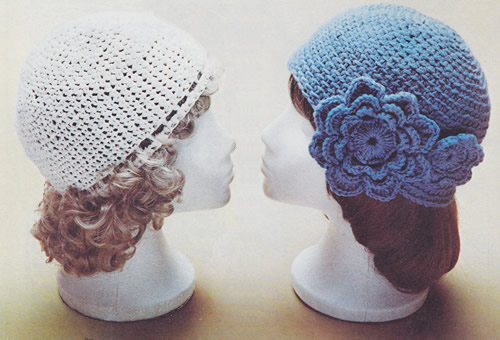
InstructionsNote: Yarn is used double throughout, and the hats are made using
a variation of double crochet: Basic HatMake 3 chain, join in a ring with slip stitch (ss) in 1st chain. Do not join after this round, but carry on working in continuous rounds,
making a spiral. This will be easy if you mark the begninning of the next
Continue in pattern, increasing 6 stitches in every round in this way
until there are 66 stitches. Continue working in rounds of double crochet without shaping for a further 3½ inches (9cm). For the basic hat - fasten off at this point. You can then decorate as required. DaisiesMake one small and one large daisy to sew on the basic hat. You should use a smaller crochet hook (2½ -3mm) and a single strand of the 4ply yarn. Small daisy: Fasten off. Large daisy: Make 11ch. [Editor's note: If you want to create a medium sized flower you can stop here and fasten off - otherwise continue with 2 more rounds.] 6th round: *
5ch, 1ss into back of st on 4th round between next 2 petals, repeat from
* 7 times more, joining last ss into
first of first 5ch. White hatThis hat was made using raffia, using thread single throughout with a
Granny squares hatUsing a No 6 (5mm) crochet hook and double yarn, work crown as given
for basic hat in double crochet pattern until there are 72 stitches. Fasten
off. Make 6 chain. Insert hook from front to back into first chain, yarn round hook and draw loop through chain and loop on hook in one movement. One slip stitch (ss) ss has been worked to join ch into a circle or ring. 1st round: 3ch to count as first
tr, 2tr into circle working under ch, 2ch, work (3tr into circle, 2ch)
3 times. Join with ss to third of first 3ch. 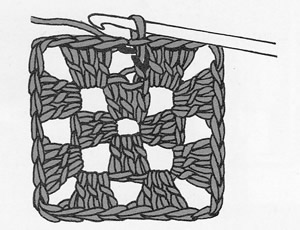
3rd round: 3ch, 2tr into first ch
space to the left of ss join of previous round, 1ch, *
work (3tr, 2ch, 3tr) into 2ch space, 1ch, 3tr into 1ch space, 1ch, repeat
from * twice more, (3tr, 2ch, 3tr)
into last 2ch space, 1ch. Join with ss to third of first 3ch. You can work the square in a single colour or in multiple different colours, fastening off one colour and starting another at the end of each round. Join the 6 squares into a circle. With main colour work 72 dc along To Make UpSew in ends and embellish as desired referring to the photos: - sew daisies to hat, or, |
Materials
|
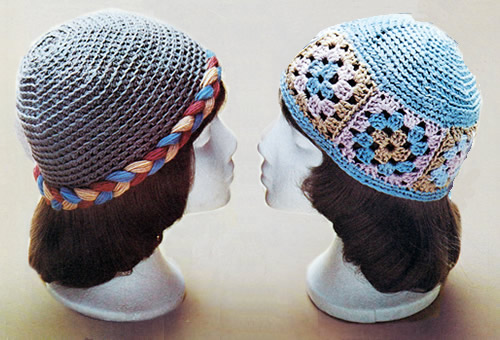
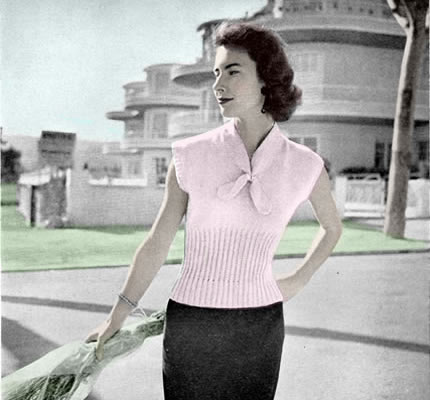
A pretty knitted "blouse" - spoken with a soft "s" as in "mouse" I suspect (maybe you pronounce it like that anyway). Presumably you could go wild and try wearing it other than in daylight hours.
Instructions. Instructions for larger size is given in brackets. Where one set of
figures is given this applies to both sizes. Back** 1st row (right side facing): *
p2, k3; repeat from * to last 2 stitches,
p2. Now increase as follows: Next row: * p1, pick up horizontal thread before next stitch and purl into back of it, p1, k3; repeat from * to last 2 stitches, p1, pick up and purl horizontal thread as before, p1. [141 (153) sts] Continue in k3, p3 rib until work measures 8 (8½)
inches from start. With right side facing, change to stocking stitch,
starting with a knit row, and shape sides by increasing 1 stitch at each
end of the 3rd (5th) and every following
6th row until there are 153 (163)
stitches. With right side facing, shape armholes by casting off 9 (9)
stitches at the beginning of the next 2 rows, then decrease 1 stitch at
each end of every knit row until 121 (131)
stitches remain. Now continue straight in stocking stitch until armholes measure 6 (6½)
inches from markers. With right side facing, shape shoulders by
casting off 10 (11) stitches at the
beginning of the following 8 rows; cast off remaining 41 (43)
stitches. FrontWork as for back from ** to **. [121 (131) sts] Next row: Purl. With right side facing, divide for neck as follows: With right side facing, shape shoulder by casting off 10 (11) stitches at the beginning of the next and following 3 alternate rows, at the armhole edge. With right side facing, rejoin wool to remaining 61 (66)
stitches, cast off centre stitch and knit to end. Making UpPress only the stocking stitch parts on the wrong side under a damp With the pair of No 13 needles and right side facing, pick up and knit
148 (156) stitches all round each
armhole. Join side seams. Collar:
Next row: Purl. * Continue in stocking-stitch, increasing
1 stitch at each end of the following 6 knit rows, then decreasing 1 stitch
at each end of the following 6 knit rows*.
Repeat from * to *
once more. Fold the collar in half with right side inside, then join points and side edge of the cast-on stitches for bow. Turn right side out and press, then fold rest of collar in half all round neck to wrong side and slip-hem in position. Press seams and collar. Slip ends of collar through scarf ring to form a bow as shown in photograph. Altering the sizeIt would be feasible to increase the size by knitting in a thicker yarn - but you do need to make a swatch and do some arithmetic. Even changing to a 4 ply with 3¼mm needles could change your chest size from a modest 34 to over 40 inches. |
Materials
|

Hearts and flowers in the bluebell season.
Instructions for Crew Neck Version.Instructions for 5 sizes - larger sizes are shown in brackets. ChartsWhen working the colour pattern from the chart, strand yarn not in use
loosely across the wrong side of the work over not more than 3 stitches
at a time in order to keep the fabric elastic. The chart is included with the pattern instructions below, but for a larger version of the chart you can right click >>here<< and choose "save link as" or "save target as" (browser dependent options) to download and save a pdf file. If you want to view chart image full size in the browser then right click on the image below and choose "view image". BackWith No 10 (3¼mm) needles and MS, cast on 61 [65, 71, 77, 81] stitches and work in rib as follows: 1st row (right side): k1, *
p1, k1; repeat from * to end. Repeat these 2 row for 5cm ending with a a first row (wrong side facing
Next row: Rib 8 [4, 8, 10, 5] m1; (rib 15 [8, 11, 19, 10], m1) 3 [7, 5, 3, 7] times, rib to end. (65 [73, 77, 81, 89] sts). Change to No 8 (4mm) needles and work 34 rows in pattern from the chart, working the first and last 8 [12, 14, 0, 4] stitches of each row as indicated for each size, and working the 16 stitch repeat pattern in between.
After completing the first 34 rows, work a further 6 [18, 26, 38, 40] rows in the pattern thus ending with a 6th [18th, 26th, 4th, 6th] pattern row. Keeping the continuity of the pattern, shape raglans by casting off 4 stitches at the beginning of the next 2 rows. 3rd, 4th and 5th
sizes: All sizes: Leave remaining stitches on a spare needle or stitch holder. FrontWork as for Back until 37 [43, 45, 47, 49] stitches remain in raglan shaping, ending with right side facing for next row. Keeping continuity of pattern, divide for neck as follows: Continue on these 12 [14, 15, 15, 16] stitches for the first side, decreasing 1 stitch at the neck edge on every row, and at the same time decreasing 1 stitch at the raglan edge on every alternate row until 6 [8, 8, 8, 7] stitches remain. Work 1 [1, 0,
0, 1] rows. With right side facing, slip centre 11 [13, 13, 15, 15] stitches on a length of yarn or stitch holder, rejoin yarn to remaining stitches, pattern to the last 2 stitches, k2tog. Work to match first side, reversing shapings. SleevesWith No 10 (3¼mm) needles and MS, cast on 31 [31, 39, 39, 39] stitches and work in rib as on back for 5 [5, 6, 6, 6] cm, ending with a 1st row and wrong side facing for next row. Next row: Rib 8 [8, 10, 10, 10] m1; rib 15 [15, 19, 19, 19], m1; rib to end. (33 [33, 41, 41, 41] sts). Change to No 8 (4mm) needles and joining in and breaking off colours as required, and starting with a 19th row, work in pattern as for 1st [1st, 2nd, 2nd, 2nd] size of the Back at the same time shaping sides by increasing 1 stitch at each end of the 3rd [7th, 3rd, 7th, 3rd] and every following 6th [7th, 12th, 14th, 12th] row until there are 49 [49, 53, 53, 57] stitches, taking the increase stitches into the pattern. |
Materials50g balls DK in 3 colours: main shade (MS) plus 2 contrasts: Pair each No 7 (4½mm), No 8 (4mm), and No 10 (3¼mm) needles. Tension23 stitches x 30 rows to 4 ins (10cm) in stocking stitch on No 8 (4mm) needles. Size mattersTo fit chest 22 [24, 26,
28, 30] inches, (56 [61,
66, 71,
76]cm) actual measurement allows 1-2 inches
of ease; Abbreviationsk2tog or p2tog: knit or purl 2 stitches together (decrease one stitch). stocking stitch: one row knit and one row purl, ("stockinette"). m1: make 1 stitch by picking up horizontal sl1: slip one stitch by passing it between the needles without knitting it. A word on the woolThe original yarn was Patons Moorland Tweed/Shetland double knitting. Moorland was 100% wool with a suggested yardage of 137 yds (125m) - although this was not printed on the ball bands at that time. A similar substitute might be Rowan Felted Tweed DK. "Always check your tension" [Good Advice]. Disclaimer
|
|
Continue in pattern until sleeve seam measures: 9½ [11, 12, 14, 15½] inches, (24 [28, 31, 35, 39] cm), ending with the same pattern row as on the Back at the start of the raglan shaping, thus ending with right side facing for next row. Keeping the continuity of the pattern, shape raglans by casting off 4 stitches at the beginning of the next 2 rows. 2nd, 3rd,
4th, and 5th
sizes: All sizes: Leave remaining stitches on a safety pin. Making Up and instructions for crew neckWith wrong side of work facing, block each piece by pinning out round
edges, and omitting ribbing, press parts lightly on wrong side following
instructions (if any) on the ball band. Make Neck Border: Starting with a 2nd row, work in rib as for the Back for 5 [5,
6, 6, 6] cm.
Join remaining raglan and Crew Neck seam. Making Up and instructions for collarWork as for Crew Neck Version but casting off stitches loosely at back of neck, front of neck, and top of sleeves. With wrong side of work facing, block each piece by pinning out round
edges, and omitting ribbing, press parts lightly on wrong side following
instructions (if any) on the ball band. Make collar: 1st row (right side): k2, *
p1, k1; repeat from * to last stitch,
k1. Repeat the last 2 rows once more then the 1st row again. Continue thus until the 2 rows "sl1, rib to last 16 stitches, turn"
have been worked. Continue in rib across all stitches until Collar measures 3cm at the side edge. Using a No 8 (4mm) needle, cast off evenly in rib. Press seams. |
|

I was told last autumn that red was definitely THE colour of the season, and then - after my wardrobe became impossibly bold - I was told that it was all about neutrals! Similarly last Spring I was told that yellow was the colour - just a splash or dash - and now apparently it is definitely THE colour for Spring.
Whatever you believe, this is a staple 50s jacket which you can knit in a single colour - entirely in yellow - or entirely without yellow. Whatever colour scheme you go for, make sure of those wonderful coordinating giant buttons before you start.
So: "Use a clear sharp sulphur yellow -- vivid contrast with white."
Instructions.Instructions give for 2 sizes- larger size given in brackets thus ().
BackWith No 8 needles white yarn (W), cast on 104 (110) stitches and work 1½ inches in twisted stocking stitch [that is: knit into the back of every stitch on the knit rows throughout], ending with a purl row. Next row (right side facing): Purl,
working into the back of every stitch. With right side facing, continue straight in twisted stocking stitch until back measures 15 (15) inches from hemline ending with a purl row. Shape armholes by casting off 5 stitches at the beginning of the next 2 rows, then decrease 1 stitch at each end of following 6 (8) knit rows. [82 (84) sts] Work straight until back measures 23½ (23½) inches from hemline. With right side facing, shape shoulders by casting off 6 (6)
stitches at the beginning of the next 2 rows, then 5 (5)
stitches at the beginning of the next 8 rows. Pocket linings (make 2 the same)Begin by making pocket linings. Left Front: With No 8 needles and W, cast on 44 (48)
stitches and work 1½ inches in twisted stocking stitch, ending with
a purl row. Next row (right side facing): Purl,
working into the back of every stitch. Continue in twisted stocking stitch as follows: Introduce pocket as follows: Now continue straight in twisted stocking-stitch as before until front measures 15 (15) inches from hemline, ending with a purl row. Continue in pattern shaping armhole and increasing 6 stitches in the border after the slipstitch as follows: Next row: Cast off 5, knit to last
18 stitches, Slip 1 purlways, [increase 1 by picking up horizontal thread
before next stitch and knitting into back of it, k3] 5 times, increase
1 as before, k2. Next row (wrong side facing): join
in yarn Y, (k1, wool forward, slip 1 purlways, wool over needle] 11 times,
k1 in Y; rejoin W and purl to end in W. Repeat the last 2 rows 5 (7) times
more. Now continue straight until front measures 21½ inches from the hemline, keeping 23 stitches of border in twisted rib pattern in Y for revers as before. With wrong side facing, shape neck by casting off 23 stitches in Y. Continue in twisted stocking stitch in W decreasing 1 stitch at the neck
edge on the next 8 (8) rows. [26 sts].
With right side facing, shape shoulder by casting off 6 (6) stitches at the beginning of the next row, then 5 (5) stitches at the beginning of the following 4 alternate rows, at the armhole edge. Right Front: With No 8 needles and W, cast on 44 (48)
stitches and work 1½ inches in twisted stocking stitch, ending with
a purl row. Work to correspond with left front reversing shapings and with the addition of 3 double buttonholes. First to come 3½ inches up from lower edge and remaining 2 at 5-inch intervals. To make a buttonhole: Your pocket row will read: (right side facing), k17, slip 1 purlways, k22 (23), cast off 24 (26), k15 (16). The increase row before start of armhole will read: (right side facing), k2, increase 1 by picking up horizontal thread before next stitch and knitting into back of it, [k3, increase 1 as before] 5 times, slip 1 purlways, knit to end. On the next row start armhole shaping and introduce fancy rib
in Y. as follows: Sleeves:With Y yarn, cast on 53 stitches. 1st row (wrong side facing): *
k1, wfd., Slip 1 purlways,won; repeat from *
to last stitch, k1. Continue in fancy rib for 3 inches ending with 2nd pattern row. Continuing in pattern start to increase 1 stitch at each end of the next
and every following 6th row until there are 93 stitches Work straight in pattern until sleeve seam measures 18 (19) inches from start of fancy rib pattern, ending with 2nd pattern row. With wrong side facing, continue in pattern shaping top by casting
off 5 stitches at the beginning of the next 2 rows, then k2tog at each
end of the next and every alternate row until 59 stitches remain, then
at each end of every row until 19 stitches remain. CollarJoin shoulder seams. With right side facing and yarn Y, pick up and k. 93 stitches all round
neck, beginning and ending at the slipped-stitch of front borders. Next row: Purl, across all stitches,
picking up horizontal loops in the same way. To Make UpPress stocking stitch parts lightly on wrong side under a damp cloth.
Now make up double collar and double front borders as follows: Slip-hem front facing in position on wrong side [note that the slipped stitch in the knitting marks the edge of the fold up the front edges]. Oversew loosely around the double buttonholes. Join side and sleeve seams; insert sleeves. Turn under 1½ inches of stocking-stitch up to hemline all round lower Catch down pocket linings, then with yarn W and (right side facing), pick up and knit 24 (26) stitches along cast-off edge of each pocket opening. Work 2 inches twisted stocking-stitch; cast off loosely. Fold pocket tops in half to wrong side and slip-hem, then catch down sides of pocket tops to main work. Press all seams and hems. |
Materials
|

It is interesting to note that this jacket is referenced as being a revamp of a previous model (which I have yet to find). This picture above is obviously how it was made up for the photo shoot - ie in a single colour. You can peer at the detail in the colour photo and pretty easily see that the yellow colour has been painted in after the event. I am keen on trying out changes to the photos - lightly tinting black and white pictures etc - but these changes would have been made by skillful application using a real air brush technique rather than Photoshop.

Lovely heathery shetland yarn tunic in a double knitting weight yarn.
Although this pattern is from the seventies, it evokes a much earlier era to me. I remember my friend Sara having a cardigan just like this, (in colour and pom-poms), knitted by her Mother in the 1960s. I have had cardigan envy ever since. However - I am sure a tunic would suit me even better!
Instructions.Instructions for larger sizes are given in brackets. When working the yoke pattern from the chart, strand yarns not in use
loosely across the wrong side of the work over not more than 3 stitches
at a time in order to keep the fabric elastic, joining in and breaking
off colours as required. Back‡‡ 1st row (wrong side facing): (k1,
p1) 23 times; k1, p2tog, p1 (mark this stitch with a coloured thread);
p2togtbl, k1; (p1, k1) 68 [72, 76,
80] times; p2tog, p1 (mark this stitch as before); p2togtbl, k1;
(p1. k1) 23 times. Next row: In D, cast off 38 stitches evenly in rib; in M, p9 [11, 12, 13] (including stitch on needle after cast off), p2tog, (p1, p2tog) 32 [34, 36, 38] times, p10 [10, 11, 12]; then in D, cast off remaining stitches in rib. [84 [90, 96, 102] sts]. Change to No 8 (4 mm) needles and with M, work in stocking stitch starting
with a knit row until back measures 6 inches, ending with a purl row. Shape sides as follows: Shape armholes by casting off 1 [2,
3, 4] stitches at the beginning of
the next 2 rows. Decrease 1 stitch at each end of the next row. Now decrease 1 stitch at each end of the next and every alternate row
until 86 stitches remain, ending with right side facing. FrontWork as for Back from ‡‡ to ‡‡. Next row: k2tog, knit to the last
2 stitches, k2tog. Repeat the last 2 rows 0 [2, 4, 6] times more. [92 sts]. Shape neck by working short rows as follows: Decrease 1 stitch at the beginning of the next and following alternate
row and at the same time decrease 1 stitch at the neck edge
on the next 3 rows. [2 sts]. Finish to correspond with first side, reversing shapings. SleevesWith No 10 (3¼mm) needles and M, cast on 42 [44, 46, 48] stitches and work in k1/p1 rib and stripes of 4 rows M, 2 rows D, 2 rows L, 2 rows M, 2 rows D. [12 rows] Continue in M until rib measures 3 inches, increasing across last row as follows : (rib 2, m1) 7 times; (rib 1, m1) 16 [18, 20, 22] times; (rib 2, m1) 5 times; rib 2. [70, 74, 78, 82 sts]. Change to No 8 (4 mm) needles and work straight until sleeve measures 18½ [18½, 19, 19] inches measured at centre, ending with right side facing for next row. Shape top by casting off 1 [2,
3, 4] stitches at the beginning of
the next 2 rows. Repeat the last 4 rows 1 [2, 3, 4] times more. [64 sts] Now decrease 1 stitch at each end of the next and following alternate
row. [60 sts] YokeWith right side facing, slip first 43 stitches of back on a length of yarn. With circular or set of No 8 (4 mm) needles and M, knit the remaining 43 stitches from back, marking first of these stitches as the start of the rounds; knit 60 from sleeve, knit up 31 down left side of neck, knit 32 from front, knit up 31 up right side of neck, knit 60 from second sleeve, then finally knit 43 from length of yarn (or stitch holder). [300 sts] Divide these stitches evenly on 3 of the set of needles. Joining in D and L as required work the 50 rounds from the chart, repeating
the 20 pattern stitches 15 times in each round and decreasing where indicated.
On completion of the above rounds the number of stitches remaining will
be: Next round: in M, decrease 8 [8, 4, 4] stitches evenly. [112, 112, 116, 116 sts] Make holes as follows: Change to set of No 10 (3¼ mm) needles and in L, work 3 rounds.
Making UpOmitting cuffs, press parts lightly on wrong side following instructions
on the ball band. In M, make 2 pompons. Make Cord: Using 6 strands of M, make a twisted cord 45 in long. Thread through row of holes at neck. Sew a pompon to each end of cord. |
Materials 6 [7, 7,
8] 50g balls Shetland DK in main shade (M) "Ocean Deep",
plus 1 ball each in 2 contrasts: Pair each No 8 (4mm) and No 10 (3¼mm) needles. Sets of 4 each No 8 (4mm) and No 10 (3¼mm) needles - or circulars. Tension23 stitches x 30 rows to 4 ins (10cm) in stocking stitch on No 8 (4mm) needles. Size mattersTo fit chest 32 [34, 36,
38] inches, (81 [86, 91,
97] cm); Abbreviationsk2tog or p2tog: knit or purl 2 stitches together (decrease one stitch). k2togtbl or p2togtbl: knit or purl 2 stitches together through
back loops. sl1: slip one stitch by passing it between the needles without knitting it. psso: pass the slipped stitch over. sl1, k1, psso: slip 1, knit 1, pass the slipped stitch over; also known as "ssk" (slip, slip, knit). m1: make 1 stitch by picking up horizontal yfwd: yarn forward - bring the yarn to the front of the work and when you knit the following stitch, you will have created an extra stitch, in a way that makes a decorative eyelet hole. A word on the woolThe original design was in Patons Fiona - a yarn I was very fond of both in quality and rich colour range. It was a standard DK; some information given on the web implies it was slightly thicker than that but the tension given here suggests slightly thinner! In the 1970s it was sold in 50g balls: 175 yds/160m meters); 51% wool, 49% acrylic. In my opinion a similar substitute would be Rowan Felted Tweed DK. "Always check your tension" [Good Advice]. Disclaimer
|

A jolly little waistcoat for the lucky 3 year old who is having a new toy engine or or aeroplane.
... what little boy wouldn't be thrilled to receive this attractive woolly on Christmas morning, teaming up with his new toys. Quickly knitted in tough Fair Isle Fingering, and you can use up your odds and ends for the various motifs.
How far away those days seem - or actually "are"! Even in my era - as attested by James May in Top Toys - boys (not girls of course!) were fixated by rockets and action men - though Airfix was as popular as ever.
Nonetheless - a "jolly little waistcoat" - for retro 3 years olds and their retro parents.
Instructions:The waistcoat is worked in one piece and in one size - stated as a 3 year old but remembering that children tend to be larger than they were in the early 1950s. As usual, you could probably increase the size successfully by using a heavier wool and larger needles. Back and Fronts in oneUsing No 12 (2¾mm) needles and main shade (MS) cast on 145 stitches, and work 1½ inches in k1/p1 rib - rows on the right side having k1 and each end. Change to No 10 (3¼mm) needles and stocking stitch, and work in pattern from chart, reading knit rows from right to left and purl rows from left to right.

Work the 24 pattern stitches 6 times across with last stitch on knit rows
and first stitch on purl rows as indicated. Work the 52 rows once, then, continuing to work motifs from the chart, and with right side facing, divide for armholes thus: Next row: pattern 36, turn, and
leave remaining stitches on a spare needle or stitch holder. Continue in pattern on these 33 stitches for the right front, decreasing 1 stitch at the armhole edge on the next 6 rows. [27 sts] Work straight in pattern to the end of the 34th row of the chart. With right side facing, continue in MS only, shaping neck by casting
off 4 stitches at the beginning of the next row, then k2tog at the neck
edge on the next 5 rows. With wrong side facing, shape shoulder by casting off 9 stitches at the beginning of the next and following alternate row, (armhole edge). With right side facing, join wool to the remaining stitches. Continue on these 67 stitches for back, decreasing 1 stitch at each end of the next 6 rows. Work straight to end of the 34th row of the chart. Change to MS only and work 8 rows straight, then with right side facing, shape shoulders by casting off 9 stitches at the beginning of the next 4 rows; cast off remaining stitches loosely. With right side facing, join wool to last 36 stitches, armhole edge, and cast off 3, pattern to end, then work to correspond with right front. Ribbed Front BordersUsing No 12 (2¾mm) needles and main shade (MS) cast on 11 stitches
and working in k1/p1 rib, with rows on the right side having a k1 at each
end, make a strip to go up the right front when slightly stretched. Make a similar strip for left front with the addition of 7 buttonholes,
the first to come in the 3rd and 4th rows from the bottom edge, and the
7th about 1 inch from the top (allowing for 8th to be worked in the neckband
later), and the remaining 5 at equal intervals. To make a buttonhole: Neck BorderJoin shoulder seams. Using No 12 (2¾mm) needles and main shade (MS), rib the 11 stitches from the right front border, pick up and knit 43 stitches all round the neck, then rib the remaining 11 stitches from the left front border. [65 sts] Work ½ inch in k1/p1 rib making the 8th buttonhole after ¼ inch has been done. Cast off in rib. Armhole BordersWith right side facing, using No 12 (2¾mm) needles and main shade
(MS), pick up and knit 89 stitches round each armhole. Making UpOmitting ribbing, press each piece carefully on wrong side using a warm
iron and a damp cloth. |
Materials 2 oz Fair Isle Fingering in main shade and 1 oz each in emerald and
scarlet. A pair each No 12 (2¾mm) and No 10 (3¼mm) needles. Eight buttons. Tension32 sts to 4 inches on No 10 (3¼mm) needles over Fair Isle pattern. Size mattersOne size - width all round under arm 22 inches. Abbreviations:k1: knit 1. A word on the woolOriginal called for Patons Fair Isle Fingering about which there is some information available on Ravelry. This pattern is in ounces but it seems the yarn
stuck around for a while as some vintage stocks can be seen in 25g balls. Jamiesons are Kings (or Queens) of Fair Isle and Shetland knitting - their Spindrift yarn sounds a good substitute: equivalent to a traditional 4ply; ideal for Fair Isle knitting; extensive colour pallet of over 220 colours; supplied in 25g Balls (105m); tension: 30sts x 32 rows on 3¼mm needles. Disclaimer
|


Splendidly cosy knee-length wrap in Irish Knot stitch with garter stitch borders forming a soft shawl collar.
Instructions.Figures in brackets refer to larger sizes; where only one figure is given, this refers to all sizes. Make knot (MK) in pattern as follows: BackWith No 9 needles cast on 98 [104
: 110: 116 : 122]
stitches. With No 3, (6½ mm), needles, cast on 18 stitches and Change to No 2 (7 mm) needles and work in pattern as follows: 1st row (wrong side facing): k9 [6
: 8 : 10 : 7];
* p2, k1, p1, k1, p2, k7; repeat
from * to
last 16 [13 : 15
: 17 : 14] stitches; p2, k1, p1, k1,
p2, k9 [6 : 8
: 10 : 7]. These 12 rows form the pattern. Continue in pattern until Back measures 10 inches (25 cm), ending with right side facing for next row. Change to No 3, (6½ mm), needles, and keeping continuity of pattern, work
Pocket Linings as follows: Repeat the last 2 rows 13 times more, then the first of these 2 rows again, thus ending with right side facing for next row. Next row: Cast off 18 stitches, pattern to last 18 stitches, cast off remaining stitches. Break yarn. With wrong side facing, rejoin yarn to remaining stitches and continue in pattern until Back measures 21½ inches (55 cm). Change to No 4 (6 mm) needles and continue in pattern until Back measures 26½ inches (67 cm), ending with right side facing for next row. Keeping continuity of pattern, shape armholes, by casting off
5 stitches at the beginning of the next 2 rows, then decrease 1 stitch
at each end of the next 5 [7 : 7
: 7 : 9] rows. Now decrease 1 stitch at each end of the next and every alternate Shape shoulders by casting off 7 stitches at the beginning of
the next 4 rows, then 6 [6 : 7
: 8 : 8] stitches at the beginning
of the Left frontWith No 3, (6½ mm), needles, cast on 55 [61
: 63 : 65 : 67]
stitches. These 12 rows form the pattern. Continue in pattern until Front measures 10 inches (25 cm), ending with right side facing for next row. Change to No 3, (6½ mm), needles and keeping continuity of pattern,
shape for Pocket Border as follows: Next row: Cast on 5 stitches, pattern across these stitches, pattern to end. (55 [61, 63, 65, 67] sts). Continue in pattern until 32 rows less than on Back have been worked before start of armhole shaping, ending with right side facing for next row. Keeping continuity of pattern, shape front slope as follows: 1st size: Decrease 1 stitch at the end of the next row, and then at the same edge on every following 3rd row until 44 stitches remain, noting that when Front measures 21½ inches (55 cm), change to No 4 (6 mm) needles. 2nd, 3rd, 4th and 5th sizes: Decrease
1 stitch at the end of the next, and every following alternate row until
- [54, 54,
56, 60] stitches remain, then decrease
1 stitch at the front edge All sizes: Work 1 row, thus ending with right side facing for next row. Shape armhole by casting off 5 stitches at the beginning of the next row. Next row: Work 2tog, pattern to end. Decrease 1 stitch at armhole edge on next 5 [7 : 7 : 7 : 9] rows, then on he following 2 [3 : 3 : 3 : 4] alternate rows, and at the same time decrease 1 stitch at the front edge on every 3rd row from previous decrease until 28 [28 : 29 : 31 : 31] stitches remain. Continue decreasing 1 stitch at the front edge only on every 3rd row
from previous decrease until 20 [20
: 21 : 22 : 22]
stitches remain. Shape shoulder by casting off 7 stitches at the beginning of the
next and following alternate row. Right frontWith No 3, (6½ mm), needles, cast on 5 stitches and leave on a spare
needle. With No 3, (6½ mm), needles, cast on 55 [61
: 63 : 65 : 67]
stitches. These 12 rows form the pattern. Continue in pattern until Front measures 10 inches (25 cm), ending with right side facing for next row. Change to No 3, (6½ mm), needles and keeping continuity of pattern,
shape for Pocket Border as follows: With wrong side facing, rejoin yarn and work 29 rows in pattern. Continue in pattern and complete to correspond with the Left Front, reversing shapings and changing needles as required. SleevesWith No 4 (6 mm) needles, cast on 53 [53,
57, 61, 61]
stitches, and work 7 rows garter stitch (every row: sl1k, knit to end).
Now work in pattern as follows: 1st row (wrong side facing),: k6
[6, 8,
10, 10]; *
p2, k1, p1, k1, p2, k7; repeat from *
to last 13 [13, 15,
17, 17] stitches, p2, k1, p1, k1,
p2, K6 [6, 8,
10, 10]. These 12 rows form the pattern. Continue in pattern, shaping sides by increasing 1 stitch at each
end of the next and every following 18th [14th,
18th, 18th, 12th]
row until there are 69 [71, 73,
77, 81] stitches, taking increase
stitches into the pattern. Shape top by casting off 5 stitches at the beginning of the next
2 Now decrease as before at each end of every row until 21 stitches remain. To Make UpPress parts lightly on wrong side following instructions (if any) on
the ball band. Pocket Borders: With right side facing and No 4 (6 mm) needles,
knit up 23 stitches evenly along side edge of front between cast-off and
cast-on stitches. Join sleeve seams; insert sleeves. Left Front Border and Collar: Shape Collar by increasing 1 stitch at the beginning of the next
and every following 6th row until there are 21 stitches. Right Front Border and Collar: |
Materials
|
|

|

Lovely heathery shetland yarn sweater in a double knitting weight yarn. This is an example of early eighties "folklore style" but retaining classic shaping. [You can see the late seventies / eighties styling in the photo with the sweater worn tucked into pleated/gathered trousers].
Instructions.Instructions for larger sizes are given in brackets. When working the colour pattern from the chart, strand yarn not in use
loosely across the wrong side of the work over not more than 3 stitches
at a time in order to keep the fabric elastic. Back‡‡ Next row: Rib 8 [9, 9, 11, 11] m1; (rib 18 [19, 20, 21, 22], m1) 5 times, rib to end. (113 [119, 125, 133, 139] sts). Change to No 8 (4mm) needles and joining in and breaking off colours
as required, work in pattern from chart A, repeating the 10 pattern stitches
11 [11, 12,
13, 13] times across, and working
the first
Keeping the continuity of the pattern, shape armholes, by casting
off 3 stitches at the beginning of the next 2 rows. Decrease 1 stitch
at each end of the next 5 rows, then on every alternate row until 89 [95,
101, 107, 113]
stitches remain. Work straight in pattern until Back measures 22½ [23,
23½, 23½, 24]
inches, (57 [58, 60,
60, 61]cm), ending with right side
Shape shoulders by casting off 9 [9,
10, 11, 11]
stitches at the beginning of the next 4 rows, then 8 [10,
10, 10, 12]
stitches at the beginning of the following 2 rows. FrontWork as for Back from ‡‡ to ‡‡. Work straight in pattern until 14 [14,
14, 16, 16]
rows fewer than on Back have been worked before start of shoulder shaping,
thus ending Keeping the continuity of the pattern, shape neck as follows: Continue on these 35 [37, 39,
41, 43] stitches for the first side,
decreasing 1 stitch at the neck edge on the next 9 rows. Work 4 [4, 4, 6, 6] rows. Shape shoulder by casting off 9 [9,
10, 11, 11]
stitches at the beginning of the next and following alternate row. With right side facing, slip centre 17 [19, 21, 23, 25] stitches on a length of yarn, or stitch holder, and rejoin appropriate colour to remaining stitches: k2tog, pattern to end. Complete to correspond with first side, reversing shapings. SleevesWith No 10 (3¼mm) needles and MS, cast on 49 [51,
53, 55, 57]
stitches and work in k1/p1 rib for 2 inches, (5cm), rows on right side
having a k1 at each end, and ending with wrong side facing for next Next row: Rib 6 [6, 7, 6, 7] m1; (rib 12 [13, 13, 14, 14], m1) 3 times; rib to end. (53 [55, 57, 59, 61] sts). Change to No 8 (4mm) needles and joining in and breaking off colours as required, work in pattern from chart B repeating the 10 pattern stitches 5 [5, 5, 5, 6] times across, and working first 1 [2, 3, 4, 0] stitches, and last 2 [3, 4, 5, 1] stitches on knit rows, and first 2 [3, 4, 5, 1] stitches and last 1 [2, 3, 4, 0] stitches on purl rows as indicated, shaping sides by increasing 1 stitch at each end of the 13th and every following 7th [7th, 7th, 7th, 6th] row until there are 75 [77, 81, 83, 87] stitches, taking the increased stitches into the pattern.
Work straight until sleeve seam measures approximately 17½ inches, (44cm), ending with the same pattern row as on Back before the start of the armhole shaping, thus ending with right side facing for next row. Keeping the continuity of the pattern, shape top by casting off
3 stitches at the beginning of the next 2 rows. Now decrease 1 stitch at each end of every row until 27 stitches remain. Cast off. Making UpOmitting ribbing, press parts lightly on wrong side following instructions (if any) on the ball band. Join right shoulder seam. Work in k1/p1 rib for 2 inches, (5cm). Join left shoulder seam and Neck Border. |
Materials50g balls Shetland DK in 6 colours: main shade plus 5 contrasts: Pair each No 8 (4mm) and No 10 (3¼mm) needles. Tension23 stitches x 30 rows to 4 ins (10cm) in stocking stitch on No 8 (4mm) needles. Size mattersTo fit chest 32 [34, 36,
38, 40] inches, (81 [86,
91, 97,
102]cm); Abbreviationsk2tog or p2tog: knit or purl 2 stitches together (decrease one
stitch). A word on the woolThe original design was in Patons Fiona - a yarn I was very fond of both in quality and rich colour range. It was a standard DK; some information given on the web implies it was slightly thicker than that but the tension given here suggests slightly thinner! In the 1970s it was sold in 50g balls: 175 yds/160m meters); 51% wool, 49% acrylic. In my opinion a similar substitute would be Rowan Felted Tweed DK. "Always check your tension" [Good Advice]. Disclaimer
|

"Their woollies match - her warm button-up and his comfortable sweater"
But still so sad to have to say goodbye to the the lovely man.
Instructions.Pattern rows used throughout: 1st row (wrong side facing):
p3, * slip the next 2 stitches on
to the cable needle and place to back of work, k2, k2 from cable needle
(this will be called cable back), slip next 2 stitches on to cable needle
to front of work, k2, k2 from cable needle (this will be Repeat 2nd and 3rd rows 4 times more, then 2nd row again. 13th row: As 1st row. These 24 rows form the pattern. Cardigan BackWith No. 12 needles cast on 98 stitches and work 3½ inches in k1/p1 rib. Next row: k3, * p8, k6; repeat from * to last 11 stitches, p8, k3. Change to No 9 (3¾mm) needles and pattern, shaping sides by increasing
1 stitch at each end of the 25th and every following 6th row, 6 times
(110 sts), taking increased stitches into reversed stocking-stitch. With right side facing, shape armholes by casting off 8 stitches
at the beginning of the next 2 rows, then k2tog at each end of the next
and every row until 76 stitches remain. With right side facing, shape shoulders by casting off 9 stitches
at the beginning of the next 6 rows; then cast off remaining stitches
loosely. Cardigan Left FrontWith No 12 needles cast on 42 stitches and work 3½ inches Next row: k3, * p8, k6; repeat from * to last 11 stitches , p8, k3. Change to No 9 needles and pattern, shaping side edge by increasing 1 stitch at the beginning of the 25th and every following 6th row, 6 times, taking increased stitches into reversed stocking-stitch. Work straight until front matches back at side edge. With right side facing, shape armhole by casting off 8 stitches
at the beginning of the next row, then k2tog at this edge on every row
until Work straight until front measures 18½ inches. With wrong side facing, shape neck by decreasing 1 stitch at the beginning of the next row, then on the following 3 rows at this edge. Work straight until front measures 20 inches, then, with right side facing, shape shoulder by casting off 9 stitches at the beginning of the next and following 2 alternate rows, armhole edge. Cardigan Right FrontWork to correspond with left front, reversing all shapings. SleevesWith No 12 needles cast on 50 stitches and work 3 inches k1/p1 rib. Next row: k7, * p8, k6; repeat from * to last 15 stitches, p8, k7. Change to No 9 needles and pattern but keeping the 7 stitches at each end of the needle in reversed stocking stitch instead of 3. Thus your 1st row will read: Continue thus in pattern, shaping sides by increasing 1 stitch at each end of the 3rd and every following 6th row until there are 64 stitches , taking the increased stitches into the pattern as they are made (you will now have 5 cable panels across sleeve). Continue increasing as before on every 6th row until there are 78 stitches, taking the increased stitches into reversed stocking stitch. Work straight until sleeve measures 18 inches. With right side facing, shape top by casting off 3 stitches at
the beginning of the next 2 rows, then k2tog at the beginning of every
row until 36 stitches remain, then at each end of every row until 24 stitches
remain; cast off. Making Up the CardiganUsing a warm iron and slightly damp cloth, press parts very lightly on
wrong side, omitting welts. Front bands: Make a similar strip for the right front with the addition of 11 buttonholes, the first to come ¼-inch from lower edge, and the 11th about ½-inch from the top (allowing for 12th hole to come in the neckband later) and the remainder at equal intervals. First mark position of buttons on left front with pins to ensure even spacing, then work holes on right front to correspond. To make a buttonhole: Neckband: Work 1 inch in moss-stitch, making 12th buttonhole after ¾-inch has been done; cast off in moss stitch. Join side and sleeve seams; insert sleeves. Pullover Back With No 11 (3mm) needles cast on 126 stitches and work 3½ inches
Next row: k3, * p8, k6; rep. from * to last 11 stitches, p8, k3. Change to No 9 needles and work straight in pattern, until back measures
14 inches at centre. Work straight until back measures 23 inches, then with right side facing, shape shoulders by casting off 10 stitches at the beginning of the next 6 rows; leave remaining stitches on a spare needle or stitch holder. Pullover FrontWork exactly as for back to end of armhole shapings (96 stitches). Work straight over all stitches until front measures 18½ inches
at centre. Here divide for neck: Work straight until front matches back to shoulder shaping. With right side facing, shape shoulder by casting off 10 stitches at the beginning of the next and following 2 alternate rows, (armhole edge). Now return to the remaining stitches. Slip the centre 20 on a spare needle or stitch holder, and rejoin the yarn to the last 38 stitches, at the neck edge, and work to correspond with first shoulder. SleevesWith No 11 needles cast on 64 stitches and work 3 inches in k1/p1 rib, increasing 6 stitches evenly across the last row (70 stitches). Next row: k3, * p8, k6; repeat from * to last 11 stitches, p8, k3. Change to No 9 needles and working in pattern, increase 1 stitch at With right side facing, shape top by casting off 3 stitches at the beginning of the next 2 rows, then k2tog at the beginning of every row until 25 stitches remain. Cast off. Neckband Join right shoulder seam, and with right side facing, using No 11 needles,
pick up and knit 120 stitches all round neck, including those on spare
needles at back and front. Work 1 inch k1/p1 rib. Making Up the PulloverPress work lightly on wrong side under a damp cloth. |
Materials
|

Warm wrap for the beach with a hood - completely appropriate for a breezy British summer's day!
The wrap is lined with towelling (optional) - and I think this is an excellent idea for a beach wrap. You will need to choose as fine (thin) a towelling fabric as you can because the wrap will already be fairly chunky even though it is made from a light weight quickknit or 5ply.
Instructions.Instructions for two sizes with larger sizes given in brackets. The pattern is in three colours - White is represented by W, Navy Blue by B, Green by G, and Pink by P. BackWith colour B, cast on 130 (138)
stitches and work 3 inches straight. Shape shoulders by casting off 8 (9)
stitches at the beginning of the next 8 rows. Work 8 rows straight on
remaining 46 (46) stitches Right FrontWith Colour B, cast on 68 (72) stitches and work 3 inches straight. Next row (right side facing): Fold
work in half and make hem. Continue straight in B until work measures 6 inches from lower edge.
Break B. Continue in W until front measures 16 inches from lower edge, Next row (wrong side facing): shape shoulder by casting off 8 (9) stitches at the beginning of the next and following 3 alternate rows, (armhole edge). Next row (right side facing): Cast
off 10 (10) stitches at the front
edge, then work 8 rows straight on remaining 26 (26)
stitches. Left FrontAs for right front, cast on 68 (72) stitches in colour B, and work 3 inches straight. Next row (right side facing): Fold
work in half and make hem. Work to correspond with right front reversing the shapings. SleevesWith colour B, cast on 80 (80) stitches
and work 4 inches straight in stocking-stitch for facing. Break B. Continue in W and shape sides by increasing 1 stitch at each end
of the next and every following 6th row until there are 100 stitches,
then at each end of every following 4th row until there are 120 stitches. HoodFirst Half: Next row (wrong side facing): * p2; purl twice in next stitch; repeat from * to last stitch, p1. [65 sts]. Continue in W and work 2 rows straight, then cast on 17 stitches at front
edge for facing. Work 12½ inches straight. Second Half: Facing: To Make UpEditor's note: lining the coat with fine towelling is optional (as is the colour of the lining material). However, if you are planning to do so, it is a good idea to cut out the lining using the knitted pieces as a pattern guide, at this point - before you sew the coat together. Allow ¼-½ inch turnings for the seams. Press parts on wrong side under a damp cloth, pinning out each piece
to shape and taking care not to stretch centre edges on fronts. Fold under 10 facing stitches down front edges and slip-hem lightly in position;
catch down neatly at neck and lower edge. Press lightly and turn back 2½ inches of facing on to right side
for cuffs. Sew blue facing all round front of hood, right sides facing, and along cast-on stitches at each side; turn width of facing on to wrong side and press; catch down neatly all round so that stitches do not show through on right side. Fold back on to right side and catch down at sides to keep in position. Press all seams. Line back, fronts and hood with yellow towelling if required. |
MaterialsQuick-knit, 5ply, or light double knitting: 14(15) 1oz balls in White, 6(6)oz in Royal Blue, and 2(2)oz each in Carnival Pink, and Shannon Green. A pair of No 9 (3¾mm) needles. 2 yards of fine yellow towelling for the lining; 1 yard of white facing ribbon; 1¼ yards white cord. Tension26 sts to 4 ins on No 9 (3¾mm) needles. Size mattersTo fit chest Abbreviationsstocking stitch: one row knit, one row purl. k2tog or p2tog: work 2 sts together to decrease. A Word on the WoolThe original yarn was Patons Quickerknit Botany. I believe "quicknit" wools evolved as a compromise yarn for
baby designs. They were half way between traditional DK and 4 ply; Phildar
marketed Pronostic (a synthetic) which was much used for their
baby patterns, being hard wearing and practical. Debbie
Bliss Baby Cashmerino is one such yarn being of superb quality and
available in wonderful range of colours. [Though if you really want to
use it a lot on the beach you might want to look for a less luxurious
fibre option]. Disclaimer
|
Make a HemThere are a number of tutorials on You tube about making an invisible hem as you knit. This one shows you two ways - the first part of the tutorial applies to the type you need here. This one shows you a number of ways to make a hem starting with just making the hem at the end when you sew up. The latter part of the tutorial applies to the type you need here. |

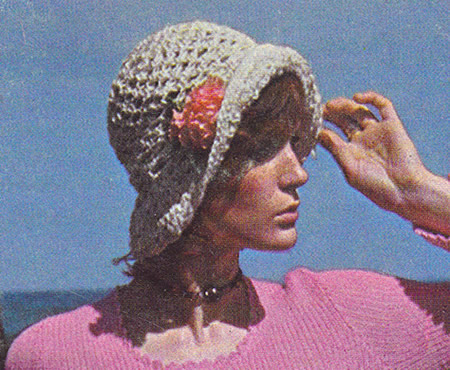
Instructions.Note: Yarn is used double throughout. Make 5 chain, join in a ring with slip stitch (ss) in 1st chain. Repeat the last round 13 times more. Make row of holes for cord as follows: Brim23rd round: ss in next st, 1 dc in
this st, * 2 ch, 1 dc in next ch sp,
2 ch, 1 dc in 2nd htr of previous round; repeat from *
ending last repeat, 2 ch, ss in 1st dc. To Make UpTo prevent heavy pressing and use of an iron, either
of which could be injurious to fabric, some yarns state that they should
not be pressed. Light pressing is suitable as follows:
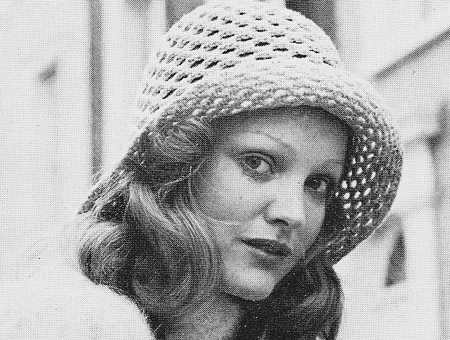
|
Materials
|

"Roses All the Way"
The copy says "cool beauty with openwork patterning", and, lovely though she looks in a shady garden, I cannot help thinking that a June bride would be a bit hot and bothered dressed head to toe in knitwear.
It might be lovely for a winter wedding however, and given the time it would take to tackle such a project, you definitely need to plan ahead!.
InstructionsThe pattern panel for the dress is worked over 5 stitches as follows: 1st row: yfwd, k2togtbl., k1, k2tog,
yfwd. Front‡‡ Next row: k2,
* yfwd, k2tog; repeat from * to
last stitch, k1. Change to No 10 (3¼mm) needles and continue in stocking stitch, placing panel patterns as follows: 1st row (right side facing): k6,
pattern 5 as 1st row of panel pattern, * k12,
pattern 5 as 1st row of panel pattern; repeat from *
to last Keeping continuity of panel patterns, work thus until front measures 24 inches from row of holes at hemline, ending with right side facing. 1st decrease row: k2, k2tog, k2,
pattern 5; * k5, k2tog , k5, pattern
5; repeat from * to last 6 stitches;
k2, k2tog, k2. [175 (191 : 207)
sts] 2nd decrease row: k2, k2tog , k1,
pattern 5; * k5, k2tog , k4, pattern
5; repeat from * to last 5 stitches,
k1, k2tog, k2. [163 (178 : 193)
sts] 3rd decrease row: k1 , k2tog , k1,
pattern 5; * k4, k2tog , k4, pattern
5; repeat from * to last 4 stitches;
k1, k2tog, k1. [151 (165 : 179)
sts] 4th decrease row: k1, k2tog, pattern 5; * k4, k2tog, k3, pattern 5; repeat from * to last 3 stitches; k2tog, k1. [139 (152 : 165) sts] Work a few rows straight until front measures 39 inches from row of holes at hemline, ending with 1st pattern row. Next row: p2, pattern 5, * (p2tog) twice, (p2togtbl) twice, pattern 5; repeat from * to last 2 stitches; p2. [99 (108 : 117) sts] Now work in lace pattern as follows: Continue in lace pattern, shaping sides by increasing 1 stitch at each end of the next and every following 6th row until there are 115 (124 : 133) stitches, taking the increased stitches into the pattern. Work a few rows straight until front measures 45 inches from row of holes
at hemline, ending with right side facing. Keeping continuity of pattern, shape armholes by casting off 4
stitches at the beginning of the of next 2 rows. Continue straight in pattern until front measures approximately 49½ (50 : 50½) inches from row of holes at hemline, ending with 2nd pattern row. Keeping continuity of pattern, divide for neck as follows: Next row: pattern 30 (31 : 32), turn, and leave remaining stitches on a stitch holder. Continue on these stitches for the first side, shaping neck by decreasing 1 stitch at the neck edge on every row until 22 (23 : 24) stitches remain. Continue straight in pattern until front measures 52 (52½ : 53) inches from row of holes at hemline, ending with right side facing. Shape shoulder by casting off 5 (6
: 6) stitches at the beginning of the next
and following 2 alternate rows. With right side facing, leave the centre 23 (26
: 27) stitches on a stitch holder, and rejoin
yarn to remaining stitches. Finish to correspond with BackWork as for front from ‡‡ to ‡‡. Keeping continuity of pattern, shape armholes and divide for back opening as follows: Next row: cast off 4, pattern 53
(58 : 62),
turn and leave remaining stitches on a length of yarn or a stitch holder.
Continue straight in pattern on these stitches until back matches front at armhole edge, ending with right side facing. Shape shoulder by casting off 5 (6
: 6) stitches at the beginning of the next
and following 2 alternate rows, then 7 (5
: 6) stitches at the beginning of the following
alternate row. With right side facing, rejoin yarn to remaining stitches, casting off
1 stitch at the centre on the 1st and 3rd sizes
only. Finish to correspond SleevesWith No 12 needles, cast on 53 stitches and work 1½ inches in stocking
stitch, starting with a knit row, and ending with right side facing. Now work a further 1½ inches stocking stitch, starting with a purl row, increasing 1 stitch at the centre on the last row and ending with right side facing. [54 sts] Change to No 10 needles, and starting with 3rd row, work in lace pattern as for bodice on front, shaping as follows: Increase 1 stitch at each end of the 11th (3rd : 3rd), and every following 15th (13th : 11th) row until there are 74 (78 : 82) stitches , taking increased stitches into pattern. Work a few rows straight until sleeve seam measures 17 inches from row of holes at wrist, ending with right side facing. Keeping continuity of pattern, shape top by casting off 4 stitches
at the beginning of the of next 2 rows. BonnetMain part: With No 12 needles, cast on 125 stitches and work 1½
inches in stocking stitch, starting with a knit row, and ending with right
side facing. Starting with a purl row, work a further 1½ inches in stocking stitch, increasing 1 stitch at the centre on the last row and ending with right side facing. [126 sts] Change to No 10 needles and starting with 3rd row, continue in lace pattern as on bodice of dress, until work measures approximately 5 inches from row of holes, ending with 2nd pattern row. Change to No 12 needles and work 6 rows in stocking stitch, starting
with a knit row, and decreasing 1 stitch at the centre on the last row.
[125 sts] Work a further 7 rows in stocking stitch, starting with a purl row. Bonnet back part: With No. 10 needles, cast on 30 stitches and
Continue straight until bonnet back measures 5½ inches, then decrease
1 stitch at each end of every row until 20 stitches remain. To Make UpPress parts lightly on wrong side, following instructions (if any) on the ball band, taking care not to spoil the lace pattern on bodice, sleeves and bonnet by over-pressing. Dress: Join shoulder seams. Dress Back Borders: Bonnet: Next row: rib 2, cast off 2, rib
to end and back, casting on 2 over those cast off. |
Materials
|


Styled for the play-deck.
The good news is that this lovely sleeveless top from the 1950s is simple enough to knit - the bad news is that it is in 3 ply - really fine - yarn and comes in only 2 tiny sizes.
However, if you like the idea there is a charming 1930s Sun-Ray sweater that Susan Crawford has sized from 28-52 inch chest and transposed for the modern knitter in the book "Stitch in Time I".
Instructions. Instructions for larger sizes are given in brackets. Where one set of
figures is given this applies to both sizes. Back and Front alike (make 2)With two No 14 (2mm) needles cast on 165 (171) stitches and work 3 (3) inches in k3/p3 rib starting and ending right side rows k3. Change to No 13 needles. Next row (right side facing): * k2tog, k1, p2tog, p1; repeat from * to last 3 stitches, k2tog, k1. {118 (126) sts}. Change to garter stitch, (every row knit), and shape sides by increasing 1 stitch at each end of 3rd and every following 6th row until there are 156 (164) stitches. Continue straight for a few rows until work measures 11½ (11½) inches at centre. With right side facing, shape armholes by casting off 4 (5) stitches at the beginning of the next 2 rows, then k2tog at the beginning of the following 10 (10) rows: {138 (144) sts}. Continue straight until work measures 13½ (13½) inches at centre. YokeUsing the circular needle, knit across 138 (144) stitches of the front, then on to this same needle cast on 87 (87) stitches for one shoulder, knit across 138 (144) stitches of back, then cast on 87 (87) stitches for second shoulder: 450 (462) stitches Continue in rounds thus: Next round:*
k2tog, k1, p2tog, p1; repeat from *
to end. Cast off in rib, knitting together every 13th and 14th stitch. Making UpPress garter stitch parts very lightly on the wrong side under a damp
cloth, avoiding the ribbing. Altering the sizeIt would be feasible to increase the size by knitting in a thicker yarn - but you do need to make a swatch and do some arithmetic. Even changing to a 4 ply with 3¼mm needles would potentially change your chest size from a modest 34 to over 40 inches. |
Materials
|

I admit that including the word "tabard" in the description of a pattern is not so inspiring - for one such as I anyway, a teenager in an era where tabards were ubiquitous and possibly naff even then. However it was named prior to that time and is after all merely descriptive - and I love this pullover. Styled perfectly as shown, worn over a polo-neck - very glamorous, very European, very sixties.
Sail away on a windy day in this attractive tabard style overpull. Jaunty and gay in snug and wind-proof yarn -- heavier than double-knit, yet so light and crisp in feeling. Gold and dark blue colour bands stripe the lower edges and smart side slits, and note the special crew neckline, designed to slip easily over a polo sweater.
Instructions.Instructions for three sizes with larger sizes given in bold or colour
between slashes. The pattern is in three colours - White is represented by W, Gold by G and Navy Blue by B. Back and Front alike (knit 2)With No 7 needles and white yarn W, cast on 76/82/88 stitches and work straight in stocking stitch until piece measures 17/17/17½ ins, ending with a purl row. Shape neck: Continue straight until work measures 21 /21
/21½ inches, ending with a purl row.
SleevesWith No 8 needles and blue yarn B, cast on 46/46/48
stitches, and work 8 rows in garter-stitch, (every row knit). Break off
B. Work straight until sleeve seam measures 18½/18½/19
inches.
Cast off loosely using a larger needle. BordersFront Neck: With right side facing, using yarn G, and No 8 needles, pick up and knit 30/30/30 stitches round left side of neck, knit 16/18/20 from stitch-holder, pick up and knit 30/30/30 stitches round right side. {76/78/80 sts} Next row: knit. Back Neck: Work as for front neck Lower Edge: With right side facing, No 8 needles and G, pick up and knit 76/82/88 stitches along lower edge of front. Work 7 rows garter-stitch, increasing 1 stitch at each end of the next
and every alternate row. Join in B, and work 8 rows garter-stitch, increasing stitch at each end
of every alternate row. Side edges:
To Make UpPress parts lightly on wrong side under a damp cloth. |
MaterialsAran or worsted weight yarn: 13/14/15 1oz balls in White and 3 1oz balls in each of Gold and Light Navy Blue. A pair each of Nos 7 (4½mm) and 8 (4mm) needles. Tension20 sts x 25 rows to 4 ins on No 7 (4½mm) needles. Size mattersTo fit chest Abbreviationsstocking stitch: one row knit, one row purl. k2tog or p2tog: work 2 sts together to decrease. A Word on the WoolThe original yarn was Patons Flair - one of those "tripleknit" yarns which never caught on in the UK. More or less Aran or American worsted weight . As usual no clues as to the yardage, but it was 60% wool, 40% courtelle (acrylic). Disclaimer
|

An expression of the era of safari suits and cravats* heralding a new "casual look" - where you could be smart without a lounge suit - like Brett Sinclair. [Having said that I can only find pictures of Brett with his safari jacket open necked or worn over a polo-neck, and his cravats worn conventionally with his suits; perhaps this was an expression of the character he was playing rather than fashion.]
If you overlook the styling - and maybe the colour - this is quite a nice sweater - and maybe cap if not all worn as an outfit. A shorter button-through neck would improve it for me.
* See gratuitous picture of Roger at the end of the instructions.
Sweater Instructions.Back** 1st row: p1, k2, *
p2, k2; repeat from * to last stitch,
p1. Change to No 4 needles and pattern as follows: 1st row (right side facing): *
Tw2R, k1 ; repeat from * to end. Shape sides by increasing 1 stitch at each end of the next and every following 24th row until there are 78/82/86/90 stitches, taking increased stitches into pattern. Work straight until back measures 17 inches, ending with right side facing. Keeping continuity of pattern, shape armholes by casting off 4
stitches at the beginning of the next 2 rows, then decrease 1 stitch at
each end of every row until 58/60/62/64
stitches remain. Work straight until back measures 26/26½/27/27½ inches, ending with right side facing. Shape shoulders by casting off 5/6/6/6 stitches at the beginning of the next 4 rows, then 6/5/5/6 stitches at the beginning of the following 2 rows. Leave the remaining 26/26/28/28 stitches on a spare needle. Front Work as for back from ** to **. Divide for front opening as follows: Next row: pattern 26/27/28/29.
Turn. Work straight in pattern on these 26/27/28/29 stitches for first side until front measures 23/23/23½/23½ inches, ending with right side facing. Shape neck by decreasing 1 stitch at the neck edge on the next 7 rows, then on every alternate row until 16/17/17/18 stitches remain. Work a few rows straight until front matches back at armhole edge, ending
with right side facing. With right side facing, leave centre 6 stitches on a safety-pin; rejoin yarn to remaining stitches and pattern to end. Finish to correspond with first side, reversing shapings. SleevesWith No 7 needles, cast on 32/32/36/36 stitches and work 3 inches in rib as on lower edge of back increasing 4 stitches evenly across last row: 36/36/40/40 stitches. Change to No 4 needles and pattern as on back, shaping sides by increasing
1 stitch at each end of the 9th and every following 6th row until there
are 48/44/52/50
stitches. Work straight until sleeve seam measures 18/18/18½/18½ inches, ending with right side facing. Keeping continuity of pattern, shape top by casting off 4 stitches at the beginning of the next 2 rows, then decrease 1 stitch at each end of the next and every alternate row until 38/38/42/42 38/38/42/42 stitches remain. Now decrease 1 stitch at each end of every row until 16 stitches remain.
Left Front BorderWith right side facing and No 7 needles, work across 6 centre stitches on front as follows: 1st row: k2, p1, m1, p1, k2 {7 sts} Repeat the last 2 rows until border, when slightly stretched, fits up
left side of front to start of neck shaping, ending with right side facing. Right Front BorderWith No 7 needles, cast on 7 stitches and work in rib as for left front until border fits up right side of front to start of neck shaping, ending with right side facing. Do not break yarn. Leave stitches on a safety pin. To Make UpOmitting ribbing, press lightly under a damp cloth or following the instructions
on the ball band. CollarWith right side facing and No 7 needles, rib 7 stitches from right front
border, pick up and knit 16/18/20/22
up right side of neck, knit 26/26/28/28
from back, increase 1 stitch at centre, pick and knit 16/18/20/22
down left side, then rib 7 border stitches. Shape collar as follows: 1st row: k1, *
p1, k1, repeat from * to end. Now repeat rows 2 - 5 until collar measures 4 inches at centre back,
ending with 2nd or 4th row. Use a tapestry needle and 12 inch lengths of yarn for making up, noting that yarn must be twisted from time to time during make up so that it does not break. Join side and sleeve seams; insert sleeves. |
Materials17/18/19/20 x 50g balls chunky wool. Pair each of No 4 (6mm) No 7 (4½mm) needles. Tension15st and 20 rows to four inches on No 4 needles over stocking stitch.
Size mattersTo fit chest: 17/18/19/20
inches; AbbreviationsTw2R: k2tog, but do not slip stitches off needle; then knit first
stitch again, A word on the wool.Original yarn was Patons Husky Chunky, which as I recall was a pure wool
chunky, and a fairly dense tough yarn as the name implies. Disclaimer
|
Cap Instructions CrownWith No, 4 needles, cast on 14 stitches and purl 1 row. Shape as follows: Keeping continuity of pattern, increase 1 stitch as before at each end
of next and following 2 alternate rows: {34 sts} Now decrease 1 stitch at each end of every row until 14 stitches remain.
Work 1 row straight. BrimWith No 7 needles, cast on 84 stitches. 1st row: (p2, increase in next stitch) 3 times, * p1, increase in next stitch, p2, increase in next stitch; repeat from * to last 5 stitches, p2, increase in next stitch p2. {116 sts} Change to No 4 needles and work rows 1 - 8 of pattern as on back of sweater, then repeat rows 1 - 3 again. Cast off knitwise. PeakWith right side facing and No 7 needles, pick up and knit 76 stitches
along cast-on edge on the brim. Shape as follows: Continue working short rows in this manner, working 2 stitches fewer on every 2 rows until the rows "knit to last 33 stitches. Turn" have been worked. Next 2 rows: knit to last 36 stitches.
Turn. Making UpBlock crown to a 9 inch circle by pinning out round edges, and press
lightly under a damp cloth. Using a flat seam, join ends of brim. |
Materials3x 50g balls chunky wool. Pair each of No 4 (6mm) No 7 (4½mm) needles. Tension24st and 32 rows to four inches on No 9 needles. Size matters"Average hat size". A word on the wool.Original yarn was Patons Husky Chunky, which as I recall was a pure wool
chunky, and a fairly dense tough yarn as the name implies. Disclaimer
|


I admit this is clearly styled for summer but I always thought to make it in black with gold beads and perhaps a gold metallic yarn for the collar.
Either way it's a lovely flattering top in fine yarn.
This pattern offers you the option of beads - which are threaded on in advance and then knitted in - or "trimmmed with embroidery". I found a good alternative to pre-threading beads which is hooking them, where you can work them in as you go. I wrote about this technique in an earlier entry, and repeat the instructions here at the end of these pattern instructions.
I think beads would be lovely for a winter version and perhaps embroidery for summer.
Instructions. Instructions for larger size is given in brackets. Where one set of
figures is given this applies to both sizes. Instructions in square brackets
also apply to both sizes.  To thread beads on to the wool, make a needle with a 4-inch length of fuse wire by folding up 1½ inches of wire into a loop, slip the end of the wool through the loop, then twist the wire very tightly to form a smooth needle with the wool fixed firmly at the end. [Editor's note: I wrote about threading beads in a previous article - go to this link to see some pictures.] Back** For bead version: break wool and thread 126 beads. 1st - 6th rows: Work in stocking
stitch, starting with a knit row. For bead version, break wool and thread 126 beads. 45th - 70th rows: As 7th to 32nd
rows but reverse, motif by reading pattern rows (odd rows) backwards,for
example 45th (7th) row will read: 71st - 76th rows: As 1st to 6th rows. These 76 rows form pattern. Continue in pattern, shaping sides by increasing 1 stitch at each end
of next and every following 6th row until there are 125 (131)
stitches, taking increased stitches into stocking stitch a few rows straight
until back measures 15 inches down centre. With right side facing, shape armholes by casting off 7 stitches at the beginning of the next 2 rows, then k2tog at each end of the next and every alternate row until 97 (99) stitches remain. Continue straight in pattern until 5 lines of motifs have been done,
then continue in stocking-stitch until back measures 22½ inches down
centre. With right side facing, shape shoulders by casting off
10 (10) stitches at the beginning of the
next 6 rows. FrontWork as for back from ** to **.
Continue in pattern shaping armholes by casting off 7 stitches at the
beginning of the next 2 rows, then k2tog at each end of the next and following
alternate row. [107 (113) sts] Now shape neck: Next row: k2tog, pattern 45 (48),
turn and leave remaining stitches on a spare needle or needle holder.
Continue in pattern, decreasing 1 stitch at the armhole edge, on the following 3 (5) alternate rows, then keep this edge straight, and at the same time decrease 1 stitch at the neck edge on every following 4th row until 30 stitches remain. Work straight in stocking-stitch until front matches back. With right side facing, continue in stocking stitch, shaping shoulder
by casting off 10 (10) stitches at the
beginning of the next and following 2 alternate rows (the armhole edge).
Finish to correspond with first shoulder. CollarJoin shoulder seams. With No 11 needles and white (contrast) wool, cast
on 31 (33) stitches. Repeat the last 2 rows until strip fits comfortably all round neck. Cast
off in rib; join short sides. Making UpPress work lightly on wrong side under a damp cloth. With No. 11 needles,
right side facing and pink wool, pick up and knit 110 (110)
stitches all round each armhole.  Join side seams. |
Materials
|
This method means you don't have to pre-string the beads on your yarn - I think it is good for placing a few beads amid a lot of knitting, when you don't want to carry just a few beads across miles of yarn before you use them, and you also don't want to break your thread.
This information appeared in Knitty.com. (Spring 2006 edition) in an article by Sivia Harding.
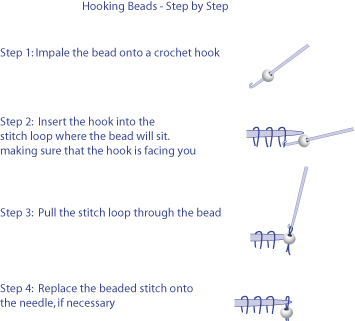
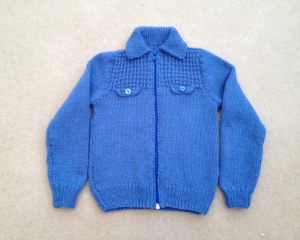
A delightful little child's jacket from the 1950s. Beryl knitted it for her grandson and it looks lovely on him - see pictures at the end. [She also gives useful feedback on the sizing].
Instructions:Two sizes are given - see notes on sizing with the photos at the end. Larger size is shown in brackets, and where only one number is shown it applies to both sizes. Pocket Flaps (make 2)Using No 8 (4mm) needles cast on 13 stitches. 1st row: Purl. Break off wool and leave stitches on a spare needle or stitch holder. Right FrontUsing No 10 (3¼mm) needles cast on 33[35] stitches. 1st row: K2, *
p1, k1; repeat from * to the last
stitch, k1. . Work these two rows 8[9] times more, increasing one stitch the beginning of the last row on the larger size only. {33[36] sts}. †† Shape armhole by casting off 3[3]
stitches the the beginning of the next row. Decrease 1 stitch the the
armhole edge on every row until 26[28]
stitches remain. Work 3[4] rows in stocking stitch thus finishing at the side edge. Place pocket flap: Proceed in yoke pattern as follows: 1st row (right side of work facing):
P8[8]; slip 13 pocket flap stitches
on to left-hand needle, purl across these stitches; purl to end. ††† Keeping yoke pattern correct, shape neck by casting off 5[6] stitches at the beginning of the next row. Decrease 1 stitch at the neck edge on every row until 17[18] stitches remain. Continue on these stitches until work measures 5[5½]inches from the beginning of the armhole shaping, finishing at the armhole edge. Shape shoulder: Left FrontUsing No 10 (3¼mm) needles cast on 33[35] stitches. Work rows 1 and 2 of rib as on Right Front 9[10] times, increasing one stitch the end of the last row on the larger size only. {33[36] sts} Work as for Right Front from †† to
††. Place pocket flap: Proceed in yoke pattern as follows: 1st row (right side of work facing):
P5[7]; slip 13 pocket flap stitches
on to left-hand needle, purl across these stitches; purl to end. Complete as for right Front working from ††† to end. Back:Using No 10 (3¼mm) needles cast on 65[71] stitches. Work rows 1 and 2 of rib as on Right Front 9[10] times. Change to No 8 (4mm) needles and proceed in stocking stitch until work measures same as fronts up to the armhole shaping, finishing at the end of a purl row. Shape armholes by casting off 3[3]
stitches at the beginning of the next 2 rows. Decrease 1 stitch at both
ends of every row until 51[55] stitches
remain. Proceed in yoke pattern as follows: 1st row (right side of work facing):
Purl. Continue in yoke pattern as on these 6 rows until work measures same as fronts up to shoulder shaping. Shape shoulder by casting off 8[9]
stitches at the beginning of the next 2 rows, 9[9]
stitches at the beginning of the following 2 rows. Sleeves (both alike):With No 10 (3¼mm) needles, cast on 32[34] stitches and Work 2¼[2½] inches in k1, p1 rib. Next row: Rib 1[2], (increase in next stitch, rib 3) 7 times; increase in next stitch, rib to end. {40[42] sts}. Change to No 8 (4mm) needles and proceed in stocking stitch, increasing 1 stitch at each end of the 7th and every following 10th[10th] row until there are 50[54] stitches. Continue on these stitches until work measures 10½[12] inches from the beginning. Shape top by casting off 3[3] stitches at the beginning of the next 2 rows. Decrease 1 stitch at each end of the next and every alternate row until 14[16] stitches remain. Cast off. Collar:Using No 10 (3¼mm) needles, cast on 85[89] stitches. 1st row: K2, *
p1, k1; repeat from * to the last
stitch, k1.. Work rows 2-5 inclusive 3 times more, then the 2nd row once. Cast off 9 stitches at the beginning of the next 6 rows. Pockets (make 2):Using No 8 (4mm) needles, cast on 13 stitches. Making UpOmitting the ribbing, with wrong side facing, block each piece by pinning
out round edges. Omitting ribbing, press each piece carefully using a
warm iron and a damp cloth. |
Materials7 [9] oz Double Knitting Yarn. A pair each No 8 (4mm) and No 10 (3¼mm) needles. 12[14] inch open ended zip. Tension22 sts and 30 rows to 4 inches on No 8 (4mm) needles in stocking stitch. Size mattersTo fit 23½[25½] inch chest. Abbreviations:yf: yarn forward; makes an extra stitch which forms a small pattern
hole when knitted on the next row. A word on the woolOriginal called for Patons Moorland, Double Quick, or Totem DK. Disclaimer
|
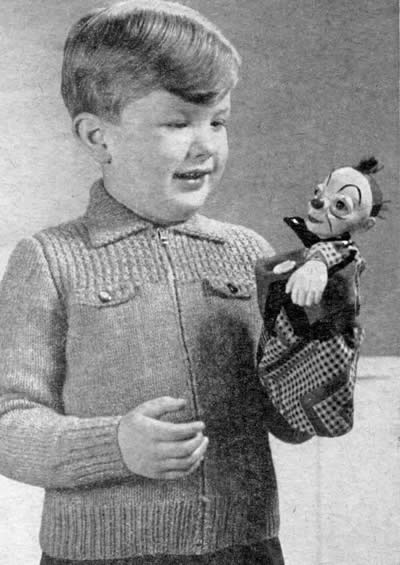
And here is a picture of the cardigan knitted by Beryl in a modern yarn: 2½ balls of Sirdar Snuggly Double Knitting:
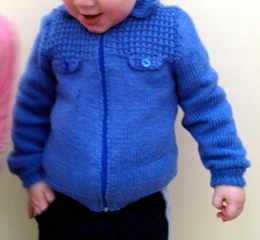
Beryl had some notes on the sizing. The original pattern was for 4-7 year olds; her grandson was only 20 months old and she left the length as it was written - she says: "he is a chunky littel chap" and previous feedback for the Little Raglan Reefer suggested the lengths of these old patterns works up a bit short for modern taste. The sleeves could have been shortened (for a 20 month old) as you can see the cuffs are turned back. Beryl found the zip a challenge and ended up using the sewing machine.
Her conclusion is that if the knitter does the length longer and leaves the sleeves as they are it would be more suitable for a 2-3 year old.
Beryl said: "I love the jacket on my grandson and I have recently found a picture of my brother wearing the same cardigan that my Mum made for him!"
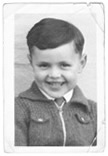
[And needless to say this one is my personal favourite - how is it that all our brothers from that era have such wonderful cheeky grins? All of them "Just William".]
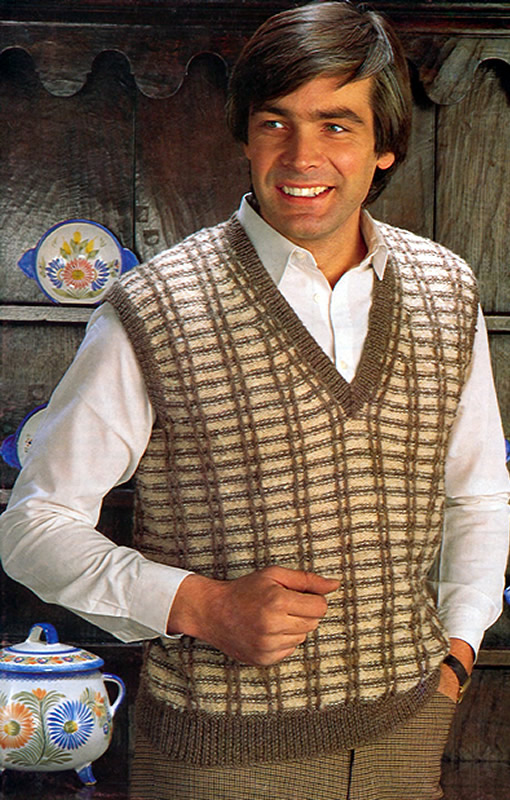
Pullover in a range of sizes, with an interesting plaid effect made by slipping stitches.
Joy first knitted it 35 years ago for her husband and he liked it so much he was always asking her to redo it. It took a while but she finally managed it - see her satisfied hubby at the end....
Instructions:The instructions are given in 9 sizes with smallest size given first
and the larger sizes in brackets. Back† 1st row (right side): K1, *
p1, k1; repeat from * to end. Change to No 8 (4mm) needles and commence pattern. 1st, 2nd, 4th, 5th, 6th, 8th, and 9th sizes only 1st row: Purl 3rd and 7th sizes only 1st row: Purl Continue in pattern ... † ....until work measures 14 [14½; 14½; 15; 15; 15½; 15½; 16; 16] inches from the beginning , ending with a wrong side row. Shape Armholes: Continue without further shaping until work measures 8¼ [8½; 8¾; 9; 9¼; 9½; 9¾; 10; 10¼] inches from the commencement of the armhole shaping, ending with a wrong side row. Shape Shoulders: FrontWork as given for back from † to † until work measures 8 rows less than the Back to armhole shapings ending with a wrong side row. Shape First side of neck Shape Armhole: †† Shape Shoulder: Return to the stitches on the spare needle on the other half of the front. Slip the centre stitch onto a safety pin. Shape second side of neck: Shape Armhole: Complete to match the first side, working from †† to ††. NeckbandUsing a back stitch and matching yarn, join right shoulder seam. With right side of work facing, using No 10 (3¼ mm) needles and yarn B, pick up and knit 68 [70; 72; 74; 76; 78; 80; 82; 84] stitches down left side of neck, knit centre from safety pin (mark this stitch with a coloured thread or stitch marker), pick up and knit 68 [70; 72; 74; 76; 78; 80; 82; 84] stitches up right side of neck, knit across the 29 [31; 33; 33; 35; 35; 37; 39; 41] stitches of back neck, increasing into last stitch: 167 [173; 179; 183; 189; 193; 199; 205; 211] stitches. 1st row: Work in k1/p1 rib to 1 stitch
before centre stitch; slip next stitch onto right hand needle, slip next
stitch onto cable needle and leave at back of work, place stitch on right
hand needle back onto Repeat these 2 rows twice more, then the first row once. ArmbandsUsing a back stitch and matching yarn, join left shoulder seam and Neckband.
With right side of work facing, using No 10 (3¼ mm) needles and yarn
B, pick up and knit 90 [94; 96;
100; 102;
104;
108; 110;
112] stitches evenly along armhole edge. For each armhole, with right side facing and using No 11 needles pick
up and knit 90 [96; 102;
108] stitches evenly round armhole.
Cast off ribwise. To Make UpPin out to correct measurements and steam very gently, using a warm iron
over a damp cloth. |
Materials Yarn A - bouclé double knitting: 3 [3;
4; 4;
4; 4;
5; 5;
5] x 50g balls A pair each No 10 (3¼mm), No 9 (3¾mm) and No 8 (4mm) needles. Tension22sts to 4 inches Size mattersChest to fit: 32 [34; 36; 38; 40; 42; 44; 46; 48] inches. Chest actual: 34 [36; 38; 40; 42; 44; 46; 48; 50] inches. Length: 23-27 ins. Abbreviationsk2tog/p2tog: decrease by knitting/purling 2 sts together. sl: slip yb: yarn back A word on the woolYou can see in the picture this is knitted in two different colours and textures of double knitting yarn. Finding a substitute will not be impossible as DK yarns are fairly standard, though it might be trickier to find the bouclé. The example shown, used Stylecraft double knitting yarn in just the one
texture (no bouclé). It took 125g of the maroon colour and just
under 100g of the grey (or silver). Disclaimer
|
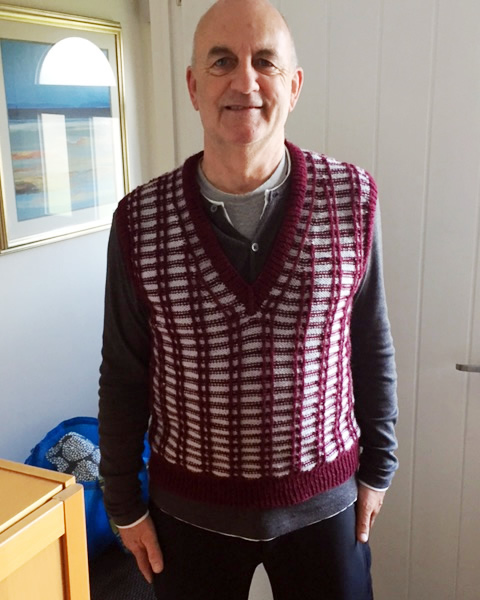
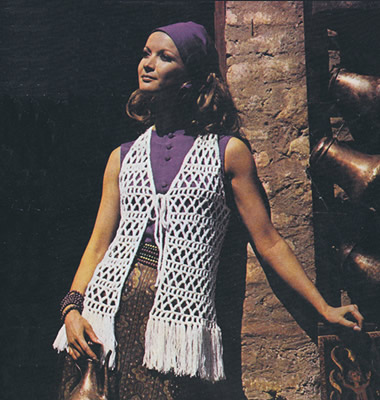
Fringes appeared everywhere last year so this may still have a place this summer. The seventies photo is delightful - a sophisticated peasant style making you long for an adventurous getaway to foreign climes - you can feel that heat.
However the editors haven't quite caught up in the ways of modern copy to match...
"... a dashing little crochet vest to wear in many ways."
Instructions.The pattern is given in one size. Back and FrontsUsing 2 balls of yarn and working with yarn doubled, make 128 ch Foundation row: 1 dtr in 6th ch from hook, * miss 1 ch, 1 ch, 1 dtr in next ch; repeat from * to end. 1st row: 1 dc in 1st stitch, *
miss next 3 stitches (that is: 1 ch, 1 dtr, 1 ch), 8 ch, 1 dc in next
stitch; repeat from * working last
dc in 4th of 5 turning ch, turn with 10 ch (work into 3rd of 4 turning
ch here on all following 1st pattern rows). These 4 rows form pattern. 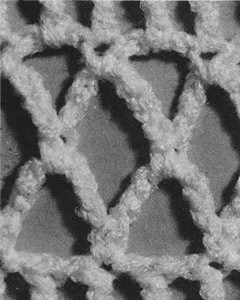 Divide for armholes as follows: Next row: 1 dtr in next ch sp, 1 ch, 1 dtr in next dc, (1 ch, 1 dtr in next ch sp, 1 ch, 1 dtr in next dc) 6 times, turn. Continue for right front, shaping armhole and neck as follows : ** Continue for back as follows: Leaving 7 stitches unworked, rejoin double yarn to next dc, make 4 ch, 1 dtr in next ch sp, 1 ch, 1 dtr in next dc, (1 ch, 1 dtr in next ch sp, 1 ch, 1 dtr in next dc.) 12 times, turn. Work the 4 rows as for right front from **
to **
then repeat these 4 rows twice more: after which you have 29 stitches
= 4 ch, 1 dtr, (1 ch, 1 dtr) 13 times. Continue for left front as follows: Leaving 7 stitches unworked, rejoin double yarn to next dc, make 4 ch, 1 dtr in next ch sp, 1 ch, 1 dtr in next dc, * 1 ch, 1 dtr in next ch sp, 1 ch, 1 dtr in next dc; repeat from * to end. Finish to correspond with right front, reversing shapings. To Make UpTo prevent heavy pressing and use of a hot iron, either of which could be injurious to the fabric, light pressing may be suitable as follows: Block each piece by pinning out round edges and press using a warm iron and slightly damp cloth. Join shoulder seams. With double yarn, work 1 row dc along front and neck edges. For the front ties: Make two lengths of ch. 20 inches (51 cm) long and sew one to each side of front, level with armhole division. Fringes: Cut remaining yarn into 12 inch (30 cm) strips and taking 6
strands together each time, knot through lower edge, placing |
Materials
|
A word on the wool.Patons marketed two different yarns called Promise in different eras
both DK equivalents. This pattern, being crocheted and from the 1970s,
is the earlier manifestation - a smooth yarn "with Tricel" sold
in 50g balls. [The later yarn marketed in the 1980s was a fluffy acrylic
with a good yardage, thus sold in 40g balls]. |
|
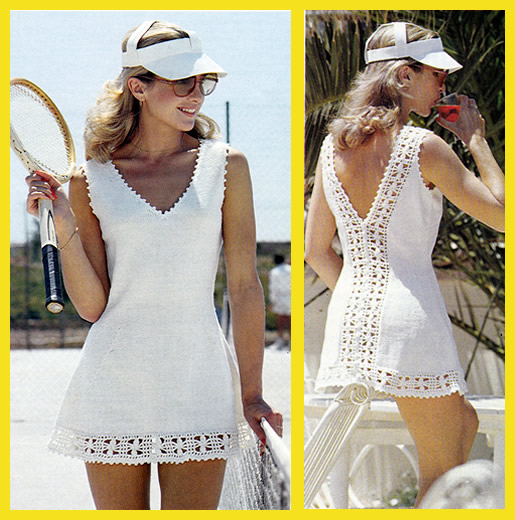
This is a knitted dress with crochet insets.....
"... to line up the prettiest back view".
No denying the charm of this dress (and model) though sadly I need them to be a little less revealing these days. But in the words of my 82 year old aunt - at the height of the mini skirt fashion when I was 13 - "well if I had legs like yours I'd bloomin' well show 'em off!".
Instructions.Special cluster stitch as follows:
Make Cluster: FrontUsing size 10 (3¼mm) needles, cast on 156 (164 : 172 : 180) stitches and starting with a knit row, work in stocking stitch until front measures 1½ inches, ending with a purl row. Shape as follows: Next row: {k 10 (11
: 13 :
14) k2togtbl} twice,
knit to last 24 (26 :
30 : 32)
stitches, {k2tog, k 10 (11:
13 : 14)}
twice. Repeat the last 6 rows 5 (4 : 4 : 4) times more. [132 (144 : 152 : 160) stitches ] Next row: {k 10 (11
: 13 :
14), k2togtbl} twice,
knit to last 24 (26 :
30 : 32)
stitches, {k2tog, k 10 (11
: 13 :
14)} twice. Repeat the last 4 rows until 84 (92 : 100 : 104) stitches remain, ending with a decrease row. 2nd and 3rd sizes only : ALL SIZES: Shape as follows: Next row: k 10 (11
: 13 :
14), m1, knit to last
10 (11 :
13 : 14)
stitches, m1, k 10 (11
: 13 :
14). Repeat the last 4 rows until there are 114 (120
: 128 :
134) stitches, ending
with an increase row. Next row: cast off 4, k 51 (54 : 58 : 61), k2tog, turn and leave remaining stitches on a spare needle or needle holder. Continue on these 52 (55
: 59 :
62) 52/55/59/62 stitches
for the first side as follows: Now decrease 1 stitch at the armhole edge on every row and at the
same time decrease 1 stitch at the neck edge on the next and every
alternate row until 37 (40
: 41 :
44) stitches remain.
Now decrease 1 stitch at each end of the next and every alternate row until 25 (26 : 27 : 28) stitches remain. Keeping armhole edge straight, continue decreasing at neck edge on every
alternate row until 21 (22
: 22 : 23)
stitches remain. Now decrease at the neck edge on the next and every following 4th row until 16 stitches remain. Work straight until armhole measures 7 (7½ : 8 : 8½) inches, ending with a purl row. Shape shoulder by casting off 5 stitches at the beginning of the next
and following alternate row. Work 1 row straight. With right side facing, rejoin yarn to the remaining stitches, k2tog,
knit to end. Left BackWith No 10 needles, cast on 61 (65 : 69 : 73) stitches, and starting with a knit row, work in stocking stitch until back measures 1½ inches ending with a purl row. Shape as follows: Next row: knit to last 24 (26 : 30 : 32) stitches, {k2tog, k 10 (11 : 13 : 14)} twice. Work 5 rows straight. Repeat the last 6 rows 5 (4 : 4 : 4) times more. [49 (55 : 59 : 63) sts] Next row: knit to last 24 (26 : 30 : 32) stitches, {k2tog, k 10 (11 : 13 : 14)} twice. Work 3 rows straight. Repeat the last 4 rows until 25 (29 : 33 : 35) stitches remain, ending with an decrease row. 2nd and 3rd sizes only: Work 3 rows straight. ALL SIZES: Shape as follows: Next row: knit to last 10 (11
: 13 :
14) stitches, ml, k
10 (11 : 13
: 14).
Work 3 rows straight. Repeat the last 4 rows until there are 35 (38
: 42 : 45)
stitches. Continue shaping bodice and at the same time shape back slope as follows: Next row: k2tog, knit to the last
10 (11 : 13
: 14)
stitches, m1, k 10 (11
: 13 :
14). Next row: knit to the last 10 (11
: 13 :
14) stitches, m1, k.10
(11 : 13
: 14).
Next row: purl to the last 2 stitches,
p2tog. Now decrease 1 stitch at back slope on the next and every following Continue shaping back slope and shape armhole as follows: Next row: knit. Continue decreasing at back slope on next and every following 3rd row, and at the same time decrease 1 stitch at the armhole edge on every row until 14 (17 : 18 : 21) stitches remain. Now decrease at the armhole edge on every alternate row and continue decreasing at back slope as before until 4 (5 : 6 : 8) stitches remain. Keeping armhole edge straight, continue decreasing at back slope as before
until 2 stitches remain. Right BackWork to correspond with the left back, reversing shapings. Your increase row on bodice will read: Crochet borderWith No 11 (3mm) hook, make 340 (356 : 372 : 388) chain. 1st row (right side facing): 1 tr
in 6th ch from hook, * 1 ch, miss
next ch, 1 tr in next ch; repeat from *
to end. This completes lower edge border, do not break yarn. Sewing in position as you go along, work left back border as follows: 1st row: 4 ch, miss first tr, 1
tr in next tr, 5 ch, miss 2 tr, 1 CL in next tr, 5 ch, miss 2 tr, 1 tr
in next tr, 1 ch, 1 tr in next tr, turn. Rows 2 to 6 inclusive, form border pattern. Continue in pattern until border fits up left back edge to top of slope,
when slightly stretched. Work right back border as follows: With right side facing, rejoin yarn to 9th stitch in from left-hand edge of bottom border and make 4 ch, 1 tr in next tr, 5 ch, miss 2 tr, 1 CL in next tr, 5 ch, miss 2 tr, 1 tr in next tr, 1 ch, 1 tr in 3rd of 4 ch. Finish to correspond with left border. To Make UpPress parts lightly on wrong side. Join shoulder and side seams, then join border to lower edge. Armhole Borders: With right side facing and No 12 (2½mm) hook, work 1 round dc all round armhole. Work picot edging as follows: Neck, Back and Lower Edge Border: With right side facing and No
12 (2½mm) hook, start at left back lower edge and work 1 row dc up
Next round: Work in dc to a point level with the start of the back slope shaping, then work picot edging up to shoulder, all round neck and down right back to point level with the start of back slope shaping. Then finish by working in dc to lower edge, working 16 button loops. To make a button loop: Work 3 ch, miss 2 dc. Now work picot edging along lower edge, join with ss in first dc. Press seams. Sew on buttons. |
Materials
|
This is styled reminiscent of the astonishingly popular seventies photo depicting the back view of a female tennis player (or more accurately "a student in tennis whites").

And not forgetting, the year after this photo was taken, we were all inspired by British tennis as Virginia Wade won the 1977 ladies singles at Wimbledon (without having to reveal her bottom).
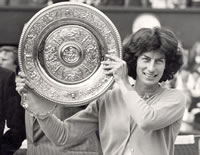
I was unable to watch the match as I was working during my student summer break - but in the evening at Victoria railway station - where they had only just installed the new electronic announcement boards - I read "Wade wins Wimbledon 4-6, 6-3, 6-1" demonstrating the sense of elation felt by all since this was a pretty unusual departure from the norm for good old British Rail at that time...
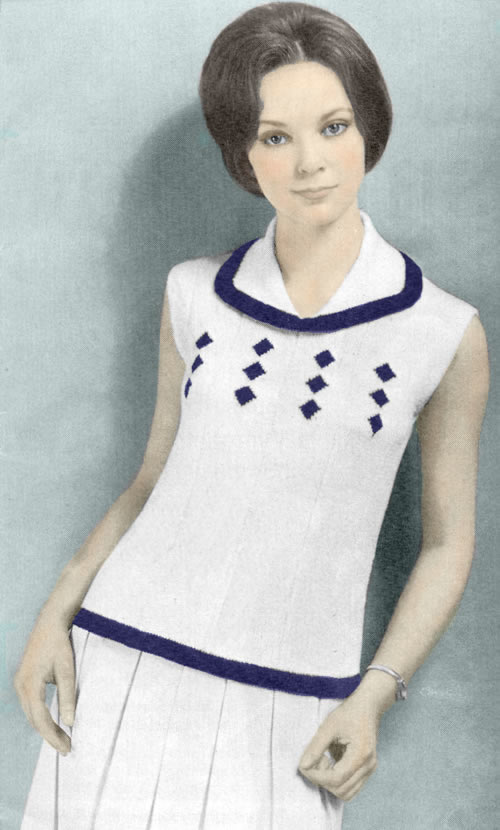
An irresistible summer top in clean cut navy an white.
As well as the understated pattern of navy diamonds, there is a subtle vertical line of patterning within the white body of the top, which draws the eye to emphasise the flattering shape.
Instructions. Instructions for larger sizes are given in brackets. Where one set of
figures is given this applies to all sizes. Back** Next row: Purl. [Editor's note: This row forms a ridge for the hem line.] Work a further 9 rows in stocking stitch starting with a purl row, increasing
2 (6 : 10)
stitches evenly across last row. Break B. With right side facing, change to No 10 needles and yarn W; pattern as follows: 1st row: k14 (18
: 22), *
p2, k21; repeat from * 3 times more,
p2, k14 (18 : 22). These 2 rows form the pattern. With right side facing, shape sides by increasing 1 stitch at each end
of the next and every following 12th row until there are 132 (140
: 148) stitches. Work straight until back measures 14 inches from purl ridge. With right side facing, shape armholes by decreasing 1 stitch
at each end of the next and following 5 (6
: 7) alternate rows. [120 (126
: 132) sts]. With right side facing, shape shoulders by casting off 6 stitches
at the beginning of the next 12 rows, then 5 (7
: 9) stitches at the beginning of the next
2 rows. FrontWork as for back from ** to **.
[132 (140 : 148)
sts] Wind off 4 small balls of yarn B. With right side facing, introduce diamond motifs, joining in a separate ball of B for each diamond. 1st row: k19 (23
: 27) W, p2 W, *
k10 W, join in B and k1 B, k10 W, p2 W; repeat from *
3 times more, k19 (23 : 27)
W. Now keep armhole edge straight but continue working diamond motifs until
3 complete patterns have been done. With right side facing, shape neck as follows: Next row: pattern 58 (61
: 64), k2tog, turn and leave remaining stitches
on a spare needle. With right side facing, shape shoulder by casting off 6 stitches at the beginning of the next and following 5 alternate rows. Next row: in pattern, cast off remaining 5 (7 : 9) stitches. With right side facing, rejoin wool to remaining stitches, k2tog, pattern to end, and finish to correspond with first side. CollarWith No 10 needles and yarn B, cast on 179 (181 : 189) stitches. Next row: k35, knit twice in the
next stitch, k2, knit twice in the next stitch, k101 (103
: 111), knit twice in the next stitch,, k2,
knit twice in the next stitch, k35. Next row: k38, k2tog, k2, k2tog tbl,
k107(109 : 117),
k2tog, k2, k2tog tbl, k38. With right side facing, change to W and continue as follows: Making UpPress parts lightly on wrong side under a damp cloth Turn under the 9 rows of stocking stitch to wrong side up to the purl
hem line all round the lower edge and slip-hem in position. Press all seams and hems. |
Materials
|
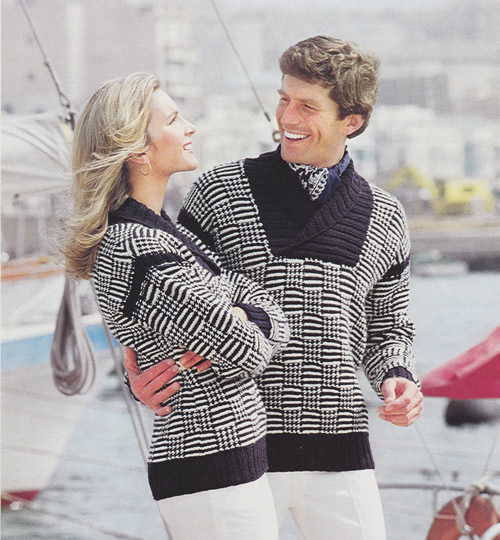
This has to be a favourite for me, combining a boating theme with navy and white.
It is a pattern from the seventies but was quite a new idea - a forerunner of those drop shoulders and cowl neck designs which were so ubiquitous in the eighties - and seemingly popular now.
Instructions.Instructions for six sizes with larger sizes given in brackets. The pattern is in two colours (dark and light) - Navy is represented by D (dark) and Cream represented by L (light). BackWith No 9 needles and yarn D, cast on 84 (92
: 97 : 100 : 108
: 112) stitches and work in rib as
follows: Repeat these 2 rows until rib measures 3 inches, ending with wrong side facing for next row. Change to No 5 needles and knit 1 row, increasing 1 stitch at centre:. [85 (93 : 97 : 101 : 109 : 113) sts] Join in yarn L, and work in pattern as follows: 1st row: right side facing,
in L, k6 (2 : 4
: 6 : 2 : 4),
sl1, {k1, sl1} 4 times, * k7, sl1, {k1, sl1} 4 times; repeat from * to
last 6 (2 : 4
: 6 : 2 : 4)
stitches, k6 (2 : 4
: 6 : 2 : 4).
17th row: in L, sl1, {k1,
sl1} 3 (1 : 2
: 3 : 1 : 2)
times, k7, * sl1, {k1, sl1} 4 times, k 7 ; repeat from * to last 7 (3
: 5 : 7 : 3
: 5) stitches , sl1, {k1, sl1} 3 (1
: 2 : 3 : 1
: 2) times. These 32 rows form pattern. Repeat them until back measures 15 (15 : 15 : 16 : 16 : 16) inches, ending with right side facing. Shape armholes by casting off 5 stitches at the beginning of the next 2 rows. [75 (83 : 87 : 91 : 99 : 103) sts]. Keeping continuity of pattern, work straight until back measures 23 (23 : 24 : 25 : 26 : 26) inches, ending with right side facing Shape shoulders by decreasing 1 stitch at each end of every row
until 51 (59 : 63
: 67 : 75 : 79)
stitches remain. FrontWork as for back to start of armhole shapings. Shape armholes by casting off 5 stitches at the beginning of the
next 2 rows. Next row: pattern 23 (25 : 26 : 28 : 31 : 33), slip these stitches on a spare needle, cast off 29 (33 : 35 : 35 : 37 : 37) stitches, pattern to end. Continue on these last 23 (25 : 26 : 28 : 31 : 33) stitches for the first side and work straight until front matches back at armhole edge, ending with right side facing. Shape shoulder by decreasing 1 stitch at end of next row, then at the same edge on every row until 11 (13 : 14 : 16 : 19 : 21) stitches remain. Work 1 row straight, then cast off 3 (4
: 5 : 5 : 6
: 7) stitches at the beginning of
the next and following alternate row. With wrong side facing, rejoin appropriate yarn colour to remaining stitches
and finish to correspond with first side, reversing shapings. SleevesWith No 9 needles and D, cast on 40 (40 : 44 : 44 : 48 : 48) stitches and work 3 inches in rib as for back, ending with wrong side facing. Change to No 5 needles. Join in L and pattern 4 rows as for 2nd (2nd : 3rd : 3rd : 4th : 4th), size of back. Shape sides by increasing 1 stitch at each end of the next and every following 8th row until there are 73 (73 : 81 : 81 : 89 : 89) stitches, taking increased stitches into pattern. Work straight until sleeve measures 17½ (17½ : 18½ : 19 : 20 : 20) inches down centre, ending with right side facing. Now increase 1 stitch at each end of the next and every alternate row until there are 83 (83 : 91 : 91 : 99 : 99) stitches. Break L. Change to No 9 needles. Work 7 rows rib as for back. To Make UpPress parts on wrong side following instructions on the ball band and
omitting ribbing. Collar: With right side facing, using the set of four (or circular) No 9 needles
and D, work as follows: Divide stitches evenly on 3 needles to facilitate working. Join side seams and sleeve seams up to rib. |
MaterialsAran weight yarn: 10 (11 : 12 : 13 : 14 : 15) 50g balls in Navy and 6 (7 : 7 : 8 : 8 : 9) in Cream. A pair each of Nos
9 (3¾mm) and 5 (5½mm) needles. TensionThis cable pattern is difficult to measure but it is equivalent to a basic tension of 19 sts x 36 rows to 4 ins measured over pattern on No 5 (5½mm) needles. Size mattersTo fit chest 34 (36 : 38
: 40 : 42 : 44)
inches, 86 (91 : 97
: 102 : 107 : 112)
cm. Abbreviationssl1: slip one stitch purlwise with yarn at back. m1: make 1. Increase 1 stitch by picking up horizontal loop lying before next stitch and working into the back of it k2tog or p2tog: work 2 sts together to decrease. A Word on the WoolThe original yarn was Patons Capstan - an Aran weight yarn knitting to a tension of 18 sts to 4 inches over stocking stitch. No clues as to the yardage but it was a fairly dense pure wool so I would not expect it to have a long yardage Disclaimer
|

Cute little slippers with ducklings, or kittens.
Easy and quick to knit, with their very effective little pom-pom heads.
[I'm guessing that with a little adaptation you could close in the top of the slippers and stuff them to make tiny duckling toys - if you are feeling adventurous....?!]
InstructionsThere are two sizes with instructions for the second size given in brackets. Both versions:Using either yellow (for duckling) or white (for kitten) and No 9 needles, cast on 20 (26) stitches and work as follows: 1st row (wrong side facing): sl1,
k8(11), p2, k9(12) 2nd size only Both sizes - continue as follows: 1st row: sl1, knit to end. Repeat the last 2 rows until work measures 2½ (3) inches ending with a 1st row. Next row: sl1, {m1, k3}, 2(3)
times, m1, k2, p1, {k2, m1} 3(4) times,
k 2(3), p1, k2, {m1, k3} 2(3)
times, m1, k1. [37(49) sts] Repeat the last 2 rows until work measures 4½ (5½) inches ending with right side facing. Next row: k1, {k2tog} 5(7) times, p1, k1 p1, {k2tog} 1(2) times,rib 5, {k2tog} 1(2) times, p1, k1 p1, {k2tog} 5(7) times, k1. Next row: rib 1(2), {p2tog} 3(4) times, rib 1, {p2tog} twice, rib 1, {p2tog} twice, p1, {p2tog} 3(4) times, rib 1(2). Next row: {k2tog} 3(2) times, {k3tog} 1(3) times, {k2tog} 3 times. [7(8) sts] Break yarn and thread through remaining stitches; draw up tightly and
fasten off securely. Completing the Duckling version:Make 2 pom-poms with remaining yellow yarn, each 1½ inches in diameter.
Trim to neaten and sew one to the front of each slipper. Completing the Kitten version:Make 2 pom-poms with remaining white yarn each 1½ inches in diameter.
Trim to neaten and sew one to the front of each slipper.  |
Materials
|

Cosy and snug wrap cardigan with a sash belt. I would probably knit it for myself as shown, but it may be more stylish if worn longer or over-sized and perhaps without pockets.
The original yarn was a soft heathered and slightly fluffy Shetland type. I think this would be lovely knitted in the hand-dyed yarn available from the Little Grey Sheep.
Instructions.Instructions are given for 4 sizes - larger sizes given in brackets. [Editor's note: I have copied the note above from the original pattern - it will make more sense when you start knitting as the the number of stitches you end up with at the end of each row increases and decreases as part of the pattern stitch.] BackWith No 11 needles, cast on 112 (120 : 126 : 132) stitches, and work 2 inches in k1/p1 rib. Next row: rib 14 (15 : 15 : 15), {ml, rib 14 (15 : 15 : 15)} 6 (5 : 6 : 6) times, ml, rib to end. [119 (126 : 133 : 139) sts] Change to No 9 needles and work as follows: Next row (right side facing):
k1, p3 (2 : 1
: 4), * k3, p6; repeat from
* to last 7 (6
: 5 : 8) stitches, k3, p3 (2
: 1 : 4), k1. 1st row (wrong side facing):
k4 (3 : 2
: 5), * p3, k6; repeat from
*
to last 7 (6 : 5
: 8) stitches, p3, k4 (3 :
2 : 5). These 14 rows form pattern for back. Keeping continuity of pattern shape armholes as follows: Next row: cast off 17 (19
: 21 : 21), k4 (1
: 7 : 1), *
p3, k6 repeat from * to last 7 (6
: 5 : 8) stitches, p3, k4 (3
: 2 : 5). Continue straight in pattern until back measures 25½ (26 : 26½ : 27) inches, ending with right side facing. Shape shoulders by casting off 8 (8 : 8 : 9) stitches at the beginning of the next 4 rows, then 7 (8 : 9 : 9) stitches at the beginning of the following 2 rows. Cast off remaining 39 (40 : 41 : 43) stitches. Pocket LiningsWith No 9 needles, cast on 30 stitches and work 29 rows stocking stitch,
starting with a purl row Left Front** Next row: rib 9 (11
: 15 : 14), {ml, rib 12 (12
: 16 : 12)} 3 (3
: 2 : 3) times, ml, rib to end: [58
(62 : 65
: 68) stitches] Change to No 9 needles and place pattern panels as follows: Next row (right side facing): k1, p3 (2 : 1 : 4), * k3, p6; repeat from * to last 9 (5 : 9 : 9), stitches, k3, p5 (1 : 5 : 5), k1. Now continue in pattern as for back Your first 2 rows will read: 1st row (wrong side facing):
k6 (2 : 6
: 6), * p3, k6; repeat from
* to last 7 (6
: 5 : 8) stitches, p3, k4 (3
: 2 : 5). Keeping continuity of pattern, work a further 27 rows, thus ending with 1st pattern row. Place pocket lining as follows: Next row: pattern 11 (10 : 9 : 12), slip next 34 stitches on a stitch holder and in place of these, pattern across stitches of first pocket lining, pattern 13 (18 : 22 : 22). Continue straight in pattern until 14 rows less have been worked than on back to start of armhole shaping, thus ending with 14th pattern row. Shape front edge as follows: Next row: k2tog, k4 (9
: 4 : 4), pattern to end. Decrease 1 stitch at the front edge on the next and every following 4th row until 54 (58 : 61 : 64) stitches remain, keeping stitches at front edge in reverse stocking stitch as placed. Work 1 row straight. Next row: k11 (7 : 11 : 11), pattern to end. Shape armhole as follows: Keep armhole edge straight and continue to decrease 1 stitch at front edge on next and every following 4th row until 23 (24 : 25 : 27) stitches remain. Note: When shaping at front edge do not continue panel pattern nearest this edge if there are insufficient stitches to work another complete pattern; instead take stitches into reversed stocking stitch. Work a few rows straight until front matches back at armhole edge, ending with right side facing. Shape shoulder by casting off 8 (8
: 8 : 9) stitches at the beginning
of the next and following alternate row. Right FrontWork as for left front from **
to **. Next row (right side facing): k1, p5 (1 : 5 : 5), * k3, p 6; repeat from * to last 7 (6 : 5 : 8) stitches, k3, p3 (2 : 1 : 4), k1. Next row (right side facing): k1, p3 (2 : 1 : 4), * k3, p6; repeat from * to last 9 (5 : 9 : 9), stitches, k3, p5 (1 : 5 : 5), k1. Now continue in pattern as for back Your first 2 rows will read: 1st row (wrong side facing):
k4 (3 : 2
: 5), * p3, k6; repeat from
* to last 9 (5
: 9 : 9) stitches, p3, k6 (2
: 6 : 6). Keeping continuity of pattern work a further 27 rows, thus ending after 1st pattern row, with right side facing for next row. Place pocket lining as follows: Next row: pattern 13 (18
: 22 : 22), slip next 34 stitches
on a stitch-holder and in place of these, pattern across stitches of second
pocket lining, pattern 11 (10 : 9
: 12). SleevesWith No 11 needles, cast on 46 (48 : 50 : 52) stitches and work 2 inches in k1/ p1 rib. Next row: rib 7 (7 : 7 : 6), {ml, rib 8 (5 : 4 : 5)} 4 (7 : 9 : 8) times, ml, rib to end. [51 (56 : 60 : 61) sts] Change to No 9 needles and place pattern panels as follows: Next row (right side facing):
k1, p5 (3 : 5
: 1), * k3, p6; repeat from
* to last 9 (7
: 9 : 5) stitches, k3, p5 (3
: 5 : 1), k1. 1st row: k6 (4
: 6 : 2), *
p3, k6; repeat from * to last 9 (7
: 9 : 5) stitches, p3, k6 (4
: 6 : 2). Continue in pattern, shaping sides by increasing 1 stitch at each end
of the 12th (10th : 8th
: 2nd), and then every following 4th row until there
are 101 (108 : 114
: 121),stitches , taking increased stitches into pattern. Cast off. To Make UpUsing a warm iron and slightly damp cloth, press parts lightly on wrong
side, omitting welts.
Front Borders
Left: With No 11 needles, cast on 9 stitches and work in rib
as follows: Repeat the last 2 rows until strip fits up left front and round to centre back of neck, when slightly stretched. Sew in position as you go along. Cast off in rib. Right: Work to correspond with left, with the addition of 7 buttonholes,
first to come ½ inches up from lower edge, 7th at start of neck shaping
and remainder spaced evenly. To make a buttonhole: with right side facing, rib 3, cast off 3, rib to end, then when knitting the next row back, cast on 3 over those cast off. [Editor's note: If you are making an over-sized cardigan, you may wish to omit the buttonholes and just have the tie belt for closure.] Pocket TopsWith right side facing and No 11 needles, k34 stitches from stitch holder,
increasing 1 stitch in centre. [35 sts] Catch down sides of pocket tops neatly on right side and pocket linings lightly on wrong side. BeltWith No 11 needles, cast on 13 stitches, and work 52 (54 : 56 : 58) inches in rib as for front borders. Cast off evenly in rib. Press seams. Sew on buttons. |
Materials
|

....or "coatigan" *.
Shown on a chap but I would like it for me... and let's face it - he looks pretty silly - even for 1976 as I remember it....
It's a very simple knit being made up of rectangles in garter stitch - if I had a loom wide enough I would actually like to have a go at weaving the fabric - but here is the knitted version - plus a man's vest or slipover which is illustrated with it.
[* I believe I am not the only one who hates this word - I am not sure it adds anything much to the meaning but .... it is the jargon of the moment]
Coat Instructions.Instructions for larger sizes given in brackets. Where one set of figures
is given this applies to all sizes. Left Front** Continue with double yarn and garter stitch and work 2 rows A; 6 rows C. Break off C and one strand of A. Change to No 6 (5mm) needles and continue in garter stitch with single
yarn, working in stripes as follows: These 42 rows form the striped pattern. Repeat them 4 times more, then rows 1-24 inclusive again. ** Continue in pattern but shaping neck as follows: Rejoin yarn at neck edge and keeping side edge straight, decrease 1 stitch at the neck edge the next 3 rows, then on the following 4 alternate rows, ending at side edge. Shape shoulder as follows: Now cast of 5 stitches at the beginning of the following 2 alternate
rows. Right FrontWork as for left front from ** to
**. Finish to correspond with left front reversing shapings. BackWith No 8 (4mm) needles and using yarn C double, cast on 95 (99
: 103) stitches. Continue with double yarn
and work 5 rows in C; 2 rows A; 6 rows C. Change to No 6 (5mm) needles and continue in garter stitch with single yarn, continue in garter stitch striped pattern as for left front. Work straight until back measures same as front to the start of the shoulder shaping, ending with same row as left front. Shape shoulders by casting off 4 (5
: 6) stitches at the beginning of the next
2 rows, 5 (5 : 5)
stitches at the beginning of the next 10 rows, then 4 (5
: 6) stitches at the beginning of the following
2 rows. SleevesWith No 8 (4mm) needles single yarn C, cast on 105 stitches. 1st row: *
k1, p1; repeat from * to last stitch,
k1. Repeat the 1st and 2nd rows until sleeve measures 7 inches, ending with a 1st row. Next row: k2 * k2tog, k5; repeat from * to last 5 stitches, k2tog, k3. [90 sts] Join in A and work in garter stitch striped pattern, as given for Left Front, repeating the 42 rows 3 times in all, and then rows 1-5 inclusive again. Cast off. Right Border (for a man - left border for a woman)With No 8 (4mm) needles single yarn C, cast on 15 stitches. 1st row (right side facing): k2 *
p1, k1; repeat from * to last stitch,
k1. Repeat the 1st and 2nd rows until border fits up the front - when slightly
stretched - to the start of the neck shaping, ending with a 2nd row. Left Border (for a man - right border for a woman)Work to correspond with right border, with the addition of 6 buttonholes, the first to come 6 inches up from the lower edge and the 6th to come ¾ inch below the start of the neck shaping and the rest spaced evenly in between. First mark the positions of the buttons on the opposite border, and work the holes to correspond. To make a buttonhole: Sew second border in position, taking care that the stripes are level with those on the opposite front. Pockets (make 2)With No 6 (5mm) needles and C, cast on 31 stitches and work in garter stitch stripes as follows: 5 rows C Break off B and A. Change to No 8 (4mm) needles and join in an extra strand of C - using
C yarn double, knit a further 5 rows. Make a second pocket in the same way. CollarWith No 8 (4mm) needles single yarn C, cast on 113 stitches. 1st row: *
k1, p1; repeat from * to last stitch,
k1. Repeat these 2 rows for 7 inches, ending with 2nd row, and cast off in rib. To Make UpPress parts lightly on wrong side following instructions on the ball
band. Join shoulder seams. Pin pockets on fronts, lower edge of pocket to come at start of 3rd broad
stripe in C, 1¼ inches from side seam. |
Materials
|


Here is a version of the coat that I made. I have written copious notes about its construction in a blog entry "The Age of Aquarius"!

Slipover Instructions.Instructions for larger sizes given in brackets. Where one set of figures
is given this applies to both sizes. The slipover is worked in one colour. Front ** 1st row: k2 *
p1, k1; repeat from * to last stitch,
k1. Repeat the 1st and 2nd rows for 4 inches, ending with a 2nd row. Change to No 6 (5mm) needles. Next row (right side facing): knit 5 (7 : 4), k2tog, * k4, k2tog; repeat from * to last 6 (8 : 5) stitches, knit to end. [87 (91 : 95) sts] Continue in garter stitch and work straight until front measures 16 (16
: 16½) inches ending with right side
facing. Shape armholes by casting off 5 (6
: 7) stitches at the beginning of the next
2 rows, then decrease 1 stitch at each end of the next and every alternate
row until 69 (71 : 73)
stitches remain. Continue shaping armhole and shape neck as follows: Next row: k2tog, k32 (33 : 34). Turn and leave remaining stitches on a spare needle. Continue on these 33 (34 : 35) stitches only for the first side, and work 3 rows straight, then decrease 1 stitch at each end of the next and every following 4th row until 27 (28 : 29) stitches remain. Now keep armhole edge straight and continue decreasing 1 stitch at the neck edge on every 4th row until 16 (17 : 18) stitches remain. Work a few rows straight until front measures 25 (25 : 25½) inches, ending at the armhole edge. Shape shoulder by casting off 4 (5
: 5) stitches at the beginning of the next
row, then 4 (4 : 4)
stitches at the beginning of the following 2 alternate rows. Work 1 row
straight. With right side facing, slip centre stitch on to a safety pin, and rejoin yarn to remaining stitches; knit to the last 2 stitches, k2tog. Finish to correspond with first side, reversing shapings. BackWork as for front from ** to **.
Now decrease 1 stitch at each end of the next and every alternate row until 67 (69 : 71) stitches remain, and then on every following 4th row until 61 (63 : 65) stitches remain. Work straight until back matches front to shoulder at armhole edge. Shape shoulders and back neck as follows: 1st row: k2tog, knit to end. Cast off remaining 4 (5 : 5) stitches. With right side facing, leave centre 23 stitches on a spare needle, rejoin yarn to remaining stitches, knit to end. Finish to correspond with first side. To Make UpPress as for coat. Join right shoulder seam. Neck Border: 1st row (wrong side facing): *
p1, k1; repeat from * to within 2
stitches of centre marked stitch, p2tog, p1, p2tog tbl, **
k1, p1; repeat from **
to end. Repeat 1st and 2nd rows twice more, and then 1st row again. Join left shoulder seam and border. Armhole Borders: Join side seams and armhole borders. Press seams. |
Materials
|

The trend for the winter is layers of knitwear, including long sleeveless cardigans, worn over knitted dresses, (which I would personally find too warm in this era of stifling central heating in most public spaces). However, there are other ways to wear it especially "between seasons" - and this is a nice example from the seventies, (but not too dissimilar to those around at the moment).
I have seen examples where front and back are split up the sides, which would give it a modern edge; this design is knitted "all in one" up to the armholes but if you are a more experienced knitter you could work out how to make fronts and backs separate up to about mid thigh.
Cardigan Instructions.Instructions for larger sizes given in brackets. Where one set of figures
is given this applies to all sizes. Pocket liningsWith No 8 needles, cast on 34 stitches and work 5½ inches in stocking stitch, ending with a knit row. Next row: p2, m1p, (p6, m1p) 5 times, p2. [40 sts] Leave stitches on a spare needle and make second pocket lining the same. Back and FrontsWith No 10 needles, cast on 290 (308
: 326 : 344) stitches and work 7 rows
k1/p1 rib. Change to No 8 needles. Repeat the last 24 rows twice more, then rows 1 to 22 inclusive again.
[Editor's note: If you have knitted fronts and back separate to this point, join them here - on the last or the following row.] Shape sides as follows: Next row: p1, *
k1, p2, k1, p2 tog, p6, p2tog, k1,p. 2, k1 ; repeat from *
to last last stitch, p1. [258 (274
: 290 : 306) sts] Continue in pattern as follows: 1st row: p1, *
(Tw2L, p1) twice, p4, (p1,Tw2R) twice; repeat from *
to last last stitch, p1. Repeat the last 20 rows once more, then rows 1 to 12 inclusive again. Place pocket linings as follows: Next row: pattern 17, * slip next 40 stitches on a stitch-holder, and in place of these, pattern across 40 stitches of one pocket lining *, pattern to last 57 stitches, repeat from * to *, pattern last 17 stitches. Work a further 7 rows straight in pattern, then work rows 1 to 18 inclusive again. Next row: p1, *
k1, p2, k1, p2tog, p4, p2tog, k1, p2, k1; repeat from *
to last stitch, p1. [226 (240 : 254
: 268) sts] **
Repeat the last 16 rows once more, then rows 1 to 14 inclusive again. Next row: as 15th. The last 2 rows form bodice pattern. Repeat them until work measures 35 inches at centre, ending with right side facing. Shape neck and at the same time divide for fronts as follows: Next row: cast off 7, pattern 49 (52 : 56 : 59), turn and leave remaining stitches on a spare needle. Continue on these stitches for RIGHT FRONT, shaping armhole
and neck as follows: Now decrease 1 stitch at each end of every row until 29 (32 : 32 : 35) stitches remain, then at each end of next and every alternate row until, 19 (22 : 22 : 25) stitches remain. Now keep neck edge straight and continue decreasing at armhole edge on following 1 (3 : 2 : 4) alternate rows. [18 (19 : 20 : 21) sts] Work straight until front measures 43 (43½ : 43½ : 44) inches at centre, ending with wrong side facing. Shape shoulder by casting off 6 (7 : 6 : 7) stitches at the beginning of the next row, then 6 (6 : 7 : 7) stitches at the beginning of the following 2 alternate rows. With right side facing, rejoin yarn to remaining stitches; cast off 8,
pattern 106 (114 : 120
: 128), turn, and leave remaining stitches on a Now decrease 1 stitch at each end of the next and every alternate row, until 74 (78 : 82 : 86) stitches remain. Work straight until back matches front at armhole edge, ending with right side facing. Shape shoulders by casting off 6 (7 : 6 : 7) stitches at the beginning of the next 2 rows, then 6 (6 : 7 : 7) stitches at the beginning of the next 4 rows. Leave remaining 38 (40 : 42 : 44) stitches on a spare needle. With right side facing, rejoin yarn to remaining stitches for LEFT FRONT, cast off 8, pattern to end. Next row: cast off 7, pattern to
end. Front Borders: Left: With No 10 needles, cast on 11 stitches. Leave stitches on a safety-pin at top and sew border neatly in position. Right: Work to correspond with left border with the addition of
12 buttonholes. 1st to come 7½ inches above lower edge, and 12th
to come 2¼ inches below start of neck shaping, with the remainder
To make a buttonhole: rib 4, cast off 3, rib to end; on the next row, cast on 3 stitches over those cast off. To Make UpUsing a warm iron and damp cloth, press parts very lightly on wrong side, omitting ribbing and taking care not to over-press and spoil the pattern. Armhole Borders: With right side facing and No 10 needles, pick
up and knit 116 (128 : 128
: 140) stitches round each armhole and work 7 rows k1/p1 rib. Join shoulder seams. Neck Border: With right side facing and No10 needles, work as
follows: Work 1 row k1/p1 rib as for border. Make 13th buttonhole in next 2 rows
as before, then work a further 4 rows in rib. Pocket Tops:With right side facing and No 10 needles, knit across each set of 40
pocket stitches, decreasing 1 stitch in centre. [39 sts] Press seams. Sew on buttons. |
Materials
|
|
 Hat Instructions.With No 10 needles, cast on 104 stitches, and work 6 rows k1/p1 rib. Change to No 8 needles. Work 16 rows in pattern as for main part from **
to **
as given in cardigan instructions to make one diamond pattern panel (see
photo). Shape crown as follows: Keeping continuity of pattern, work 1 row straight. Next row: p1, *
k1, p2, k1, p1, p2tog, p2, k1, p2, k1; repeat from *
to last stitch, Change to stocking stitch, starting with a knit row, and continue shaping as follows: Next row: k3, k2tog, *
k5, k2tog; repeat from * to last 4
stitches, k4 : 68 stitches Next row:
purl. Break yarn. Thread through remaining stitches, draw up tightly and fasten off. Press work very lightly on wrong side, omitting ribbing. |
Materials
|

This is an earlier version of a knitted cape and includes a (knitted) lining - so potentially nice and warm. I thought it was a good option to publish alongside the seventies version.
The lining is knitted but if you did not want to commit to all that knitting I think it might be simple enough to cut out the shapes in fabric to create the lining - as long as you choose a material that's not too stiff or thick, although the cape as shown seems to be styled with quite a firm structure.
Of course you could easily knit the cape in a plain stitch instead of the pattern illustrated.
Instructions.Instructions for only one medium size - could be adapted by using a thicker
yarn and bigger needles - but do work out your tension to check the size. Cape section (make 6)With No 7 (4½mm) needles and D, cast on 80 stitches and work in pattern as follows: 1st row (right side facing): in B
k5, * with wool at back, slip 2 purlwise,
k4; repeat from * to last 3 stitches,
slip 2 purlwise, k1. These 12 rows form the pattern. Keeping pattern correct and keeping a knit stitch at each end of every purl row, as before, shape sides by decreasing 1 stitch at each end of the next and every following 10th row, until 46 stitches remain. Now decrease 1 stitch at each end of every following 6th row until 34 stitches remain, then at each end of every 4th row until 20 stitches remain. Work 1 row. Make 5 more sections in same way. Lining section (make 6)With No 10 (3½mm) needles cast on 70 stitches and work 5 rows in stocking stitch, starting with a knit row. Next row: knit. Work a further 5 rows in stocking stitch, starting with a knit row. Change to No 8 (4mm) needles and continue in stocking stitch for a further
38 rows. Make 5 more sections in the same way. To Make Up Use a large tapestry needle and 12 inch lengths of wool for sewing,
Press parts very lightly on wrong side under a damp cloth. Now join one of the 2 remaining sections to one side of cape as follows
(to make armhole slits at the front): Join the lining in the same way, measuring the 4 inches up to the arm
slits from the purl ridge. Pin cape to lining, wrong sides together, lower edge of cape in line
with markers on lining ; tack in position. Right Front Border: With No 10 (3¼mm) needles and D, cast
on 13 stitches. Repeat these 2 rows until strip fits up right front edge when stretched,
ending with right side facing. Next row: cast off 7, knit to end. Slip stitches on a safety pin. Left Front Border: Work as for right border, ending with wrong
side facing. Sew one edge of border in position to cape, from lower edge to 9 inches
below neck, without stretching. Now ease the last 9 inches of the front
edge on to the remainder of the band. Neck Border: With right side of cape facing, No 10 (3¼mm) needles and D, k6 stitches of right border, pick up and knit 14 stitches from the top of each section, k6 border stitches. [96 sts] Work 5 rows stocking stitch, starting with a purl row. Work a further 4 rows in stocking stitch, starting with a purl row. Fold the neck border in half at the ridge, and slip-hem in position to
the lining. Sew on fastenings as in photo. |
Materials
|

Capes being the thing of the moment (though maybe not quite like this one).
Styled "Edwardian" from the early 1970s - hence the floppy hat and slightly whimsical setting a la Laura Ashley - I might choose to make this somewhat shorter, plain rather than striped, and use a tweed or textured yarn of some sort.
So.... a midi cape - and if that were not wonderful enough... it comes with matching trousers! How great is that?!
Cape Instructions.Instructions for larger sizes given in brackets. Where one set of figures
is given this applies to all sizes. BackWith No 10 needles and M, cast on 92 (98 : 104) stitches and work 4 rows k1/p1 rib. Next row: rib 7 (3 : 6) m1, * rib 6 (7 : 7), m1 ; repeat from * to last 7 (4 : 7) stitches, rib 7 (4 : 7). [106 (112 : 118) sts] Join in D, change to No 8 needles and using stocking stitch, start with a knit row, and work in stripes as follows: 1st and 2nd rows: in D. These 12 rows form the striped pattern. [Note: Carry yarns loosely up side of work.] Continue in pattern and work a further 12 rows straight. Shape sides: Work a few rows straight until back measures 32 inches (81 cm) at centre,
ending with right side facing. Continue decreasing 2 stitches as before, but on the next and every following 4th row until 38 (44 : 50) stitches remain. Work 3 rows straight, then decrease 2 stitches as before on the next and every alternate row until 28 (30 : 32) stitches remain. Work 1 row straight, and leave stitches on a spare needle or stitch holder. Left FrontWith No 10 needles and M, cast on 46 (48 : 52) stitches and work 4 rows k1/p1 rib. Next row: rib 3 (3 : 3) m1, * rib 8 (7 : 9), m1 ; repeat from * to last 3 (3 : 4) stitches, rib 3 (3 : 4). [52 (55 : 58) sts] Join in D, change to No 8 needles and using stocking stitch, start with a knit row, and work 24 rows straight in striped pattern. Continue in striped pattern, shaping side edge as follows: Repeat the last 12 rows until 34 (37 : 40) stitches remain. Work a few rows straight until front matches back to marker, ending with right side facing. Place a marker at each end of the last row. Now decrease 1 stitch as before, but on the next and every following 4th row until 20 (22 : 24) stitches remain. With wrong side facing, shape neck by casting off 4 (5 : 5) stitches at the beginning of the next row. Continue decreasing at the side edge on every 4th row from previous decrease,
and at the same time decrease 1 stitch at the neck edge
on the next and every alternate row until 9 (13
: 16) stitches remain. Now decrease 1 stitch at the side edge as before, but on the next and every alternate row, and at the same time continue decreasing at neck edge on the next and following 1 (3 : 5) alternate rows. [5 (5 : 4) stitches remain]. Now keep neck edge straight and continue decreasing at side edge as before on following 2 (2 : 1) alternate rows. [3 sts] Next row: purl. Right FrontWork to correspond with left front, reversing shapings and working 'togtbl' when shaping side edge. Side Panels (make 2)With No 10 needles and M, cast on 80 (84 : 88) stitches and work 4 rows k1/p1 rib. Next row: rib 1 (3 : 5), m1, * rib 7, m1 ; repeat from * last 2 (4 : 6) stitches, rib 2 (4 : 6). [92 (96 : 100) sts] Join in D, change to No 8 needles, and stocking stitch, and starting with a knit row, work 24 rows straight in striped pattern. Continue in striped pattern, shaping sides as follows: Next row: k2, k2tog, knit to last
4 sts, k2togtbl, k2. Repeat the last 12 rows until 56 (60 : 64) stitches remain. Work a few rows straight until work matches back to markers, ending with right side facing. Place a marker at each end of the last row. Continue decreasing as before, but on the next and every following 4th row until 28 (32 : 36) stitches remain. Work 3 rows straight, then decrease 2 stitches as before on the next
and every alternate row until 10 stitches remain all sizes. Leave stitches on a safety-pin. Make a second side in the same way. Left Front BorderWith No 10 needles and M, cast on 9 sts. 1st rows (right side facing): k2,
(p1, k1) 3 times, k1. Repeat the last 2 rows until the strip fits up the left front to the
start of the neck shaping, when slightly stretched, ending with right
side facing. Right Front BorderWork to correspond with the left border with the addition of 13 buttonholes. The first buttonhole is to come 4 inches (10 cm) up from the lower edge, and the 13th is 2 inches (5 cm) below the start of the neck shaping; the remainder are spaced evenly between. First mark position of buttons on left front with pins to ensure even spacing, then work holes to correspond. To make a buttonhole: To Make Up Using a cool iron and dry cloth, press parts lightly on the wrong side,
omitting the ribbing. In the same way, join the front panels to side panels, leaving 9 inch
(23 cm) slits for hands, bottom of slit to come 18½ inches (47 cm)
up from the lower edge.
Right Slit Border: Left slit border: work to correspond. Neck Border: Rib 9 from right border, pick up and knit 15 (16 : 17) stitches up right side of neck, k10 from side panel decreasing 1 stitch in centre, 28 (30 : 32) stitches from back decreasing 3 stitches evenly, 10 stitches from side panel decreasing 1 stitch in centre, then pick up and knit 15 (16 : 17) down left side, and finally rib 9 from left border. [91 (95 : 99) stitches. Work 5 rows in k1/p1 rib. Fold neck border in half to the wrong side and slip-hem loosely in position all round. Oversew loosely round double buttonhole. Catch down short ends of slit borders neatly to main work. |
Materials
|

Trousers Instructions.Instructions for larger sizes given in brackets. Where one set of figures
is given this applies to both sizes. The trousers are worked in one colour. Left Leg ** Next row: rib 4 (6 : 6 : 8 : 8 : 6), m1, * rib 11 (11 : 12 : 12 : 13 : 14), m1; repeat from * to last 5 (7 : 6 : 8 : 7 : 6) stitches, rib 5 (7 : 6 : 8 : 7 : 6). [94 (98 : 104 : 108 : 114 : 118) sts] Change to No 8 needles and stocking stitch, starting with a knit row, and work straight until leg measures 25 (25 : 25½ : 25½ : 26 : 26) inches (63 (63 : 65 : 65 : 66 : 66) cm), ending with right side facing. Shape leg as follows: Next row: (k1, m1, knit 45 (47
: 50 : 52 : 55
: 57), m1, k1) twice. Next row: (k1, m1, knit 47 (49
: 52 : 54 : 57
: 59), m1, k1) twice. Next row: (k1, m1, knit 49 (51
: 54 : 56 : 59
: 61), m1, k1) twice. Place a marker at each end of the last row. Cast off 2 stitches at the beginning of the next 2 rows, then decrease
1 stitch at each end of the next and every alternate row until 96 (100
: 106 : 110 : 116
: 120) stitches remain. Work 1 row straight. *** Shape back as follows: 1st row: k29, turn. Change to No. 10 needles and work 1 inch (2 cm) k1/p1 rib. Right Leg Work as for left leg from ** to
**. To Make UpUsing a cool iron and dry cloth, press parts lightly on the wrong side, omitting the ribbing. Joint front, back and inside leg seams. Cut elastic to fit waist and join in a ring; sew to the inside of the waist ribbing using herringbone-stitch over the over the elastic to form a casing. |
Materials
|
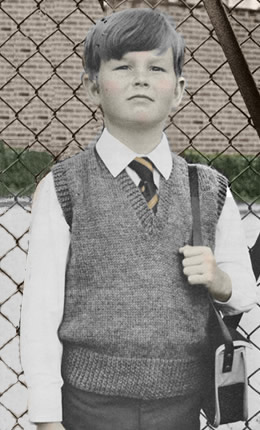
A classic sleeveless school pullover with instructions for 4ply fingering and double knitting.
[Illustrated on a rather serious classic school boy.]
Instructions:The instructions are give for a 28 inch chest with 3 larger sizes in
brackets. Casting onCast on using cable method. 4 ply Pullover BackUsing No 12 (2¾mm) needles cast on 98 [106;
112; 120]
stitches and work in K1/P1 rib for 2 inches Shape Armholes: Shape Shoulders: Cast off remaining stitches. 4 ply Pullover FrontWork as given for back until you reach the armhole shapings, ending with a wrong side row. Shape Armhole and Divide for Neck: Shape Shoulder: Continue to match the first side, reversing all shapings. 4 ply Pullover Neck BorderJoin right shoulder seam. Next row: Work in K1/P1 rib to within
2 stitches of the centre stitch; k2tog, p1, k2togtbl, rib to end. Repeat the last 2 rows 4 times more. 4 ply Pullover Arm BordersJoin left shoulder seam (including the neck border). For each armhole, with right side facing and using No 12 needles pick
up and knit 112 [120; 126;
132] stitches evenly round armhole.
Cast off ribwise. To Make UpPress, using a warm iron over a damp cloth. Double Knitting Pullover BackUsing No 11 (3mm) needles cast on 84 [90;
96; 102]
stitches and work in K1/P1 rib for 2 inches Shape Armholes: Shape Shoulders: Cast off remaining stitches. Double Knitting Pullover FrontWork as given for back until you reach the armhole shapings, ending with a wrong side row. Shape Armhole and Divide for Neck: Now decrease 1 stitch at the armhole edge on the following 5 rows, then
1 stitch on the following 4 alternate rows, and at the same time
decrease 1 stitch at the neck every following 3rd row from the last decrease
until 15 [17; 19;
21] stitches remain. Shape Shoulder: With right side facing rejoin yarn to the remaining stitches on the spare
needle and work to end. Continue with armhole and neck shapings to match the first side, reversing all shapings. Double Knitting Pullover Neck BorderJoin right shoulder seam. Next row: Work in K1/P1 rib to within
2 stitches of the centre stitch; k2tog, p1, k2togtbl, rib to end. Repeat the last 2 rows 3 times more. Double Knitting Pullover Arm BordersJoin left shoulder seam (including the neck border). For each armhole, with right side facing and using No 11 needles pick
up and knit 90 [96; 102;
108] stitches evenly round armhole.
Cast off ribwise. To Make UpPress, using a warm iron over a damp cloth. |
Materials 4 ply version: 5 [6; 7;
7] x 1 oz balls DK version: 7 [7; 8;
9] x 1 oz balls Tension4 ply version: DK version: Size mattersChest all round at underarm: on jumper, 26 [28;
30; 32]
inches. Abbreviationsk2tog/p2tog: decrease by knitting/purling 2 sts together. k2togtbl: decrease by knitting 2 sts together through back loops, sometimes called ssk (slip 1 knitwise, slip 1 knitwise, place 2 sts back on left needle and knit/purl 2 slipped sts together through back loops). p2togtbl: decrease by purling 2 sts together through back loops. A word on the woolThe yarn in ounces. When substituting yarn, ideally you need to calculate using the yardage
of the yarns - and with old patterns this is usually impossible, as the
yardage is not given. So you need to be aware that in some cases, where
the old yarn was synthetic or had a very good yardage, you may find that
you use as much as one 50g ball for every 1 oz ball. Disclaimer
|
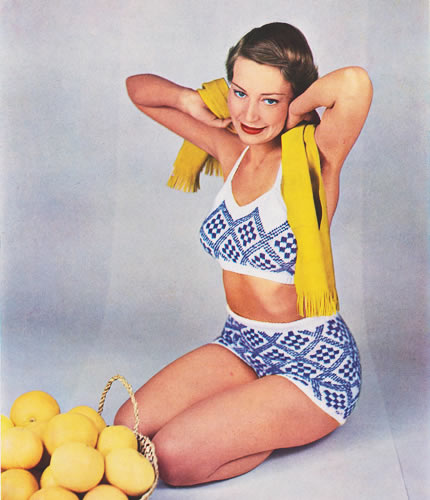
I have a weakness for blue and white so I find this very appealing. I note that they emphasise the firmness of the diamond stitch - whether this is for modesty or keeping its shape one cannot be certain.
I am not altogether sure of the relevance of the props - basket of grapefruit (tropical beaches?), an apparently woolly scarf ("gosh it's chilly in this photo studio"?).
Instructions.Strand unused wool loosely across back of work. Pattern rows as follows: These 30 rows form the pattern. [Editor's note: You can see how the pattern looks in the photo and on the chart but the chart is an adapted version specially designed to be used for the top.] Trunks (front)With L wool and No 13 needles, cast on 107 stitches and work 24 rows
k1, p1 rib. Work straight to the end of the 14th row of the 3rd pattern. Continue in pattern, shaping legs by casting off 8 sts at the beginning of the next 2 rows, and then 6 sts at the beginning of the following 14 rows. [23 sts remain and 3 complete patterns have been worked]. Work 6 rows straight in L on these 23 sts. Trunks (back)Work waist ribbing exactly as for front. Top (front)With L wool and No 13 needles, cast on 101 sts and work 1 inch in k1,
p1 rib. Change to No 10 needles and increase for bust thus: Continue straight in pattern, working from chart, and reading knit rows
from right to left, purl rows from left to right. Your first 2 rows will
read: Continue thus until 26th row of chart has been worked.
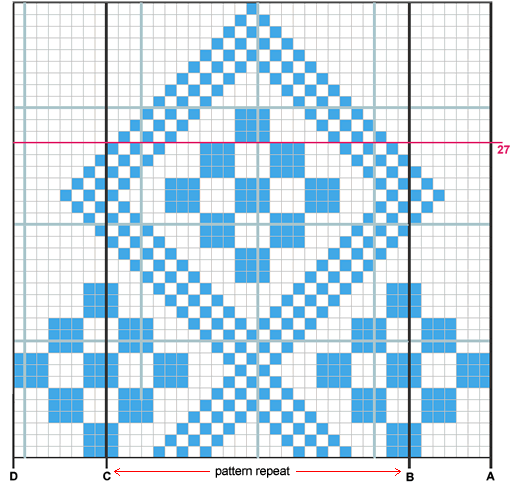
With right side facing, continue working chart, and at the same
time shaping top by casting off 6 sts at the beginning
of the next 2 rows, and 3 sts at the beginning of the following 2 rows. Continue in pattern on first half of work, decreasing 1 stitch at centre
Change to No 12 needles and continue in l.. wool only, casting off 3
sts With right side facing join wool to remaining stitches at centre front; cast off 1, then work to correspond with first shoulder, reversing shapings. Top (back)Left Back: Right back: Work to correspond with left, reversing shapings. To Make UpPress all pieces well under a damp cloth. TRUNKS: Join under-leg seam. With TOP: With right side facing, L wool, and No 13 needles, pick
up and knit 54 sts along top of left back. Work ¾ inch in k1,
p1 rib. With right side facing, begin at left side of front and pick up and knit
45 sts to top of left point, 26 down to centre, 26 to top of right point
and 45 sts down right side. With L wool and No 13 needles, cast on 9 sts and work 2 strips each
14 inches long in k1, p1 rib for ties. Sew in position, one at top |
Materials
|
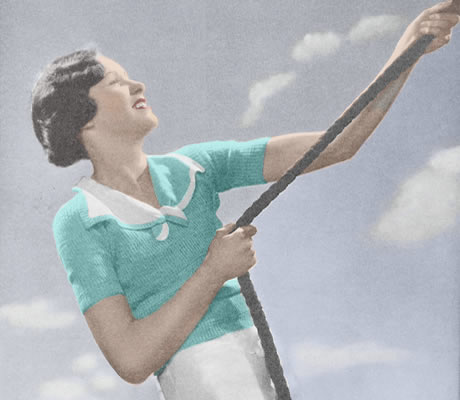
Very simple to knit, this open-air jumper, since the pattern is rib, broken by plain and purl rows at intervals. The attractive collar is just two triangular pieces knotted together at the centre front and centre back.
"A nicely casual affair with short sleeves and a scarf collar"
Instructions.The overall pattern stitch as follows: 1st row (wrong side facing): Knit. [Editor's note: The ribbed stitch will have the effect of making the fabric pull in slightly.] BackWith blue wool and No 12 needles cast on 120 stitches. Work 1½ inches
in k1, p1 rib, then start pattern as given above. After completing first pattern (18 rows), increase once at each end of
Continue straight on these sts until you have completed the 6th pattern from commencement (work should measure about 13 inches). Armhole shapings: Cast off. FrontWith blue wool and No 12 needles, cast on 130 stitches. Work exactly as for the back up to the armhole (148 stitches on the needles).
Divide for neck-opening: With right side facing, work 64, turn, leaving remaining stitches on
a spare needle. SleevesWith blue wool and No 12 needles cast on 72 stitches. Work 1¼ inches in k1, p1 rib, then work in pattern, increasing at each end of every 3rd row, and during the first pattern changing to No 10 needles on the 5th row, and to No 9 needles on the 11th row. When you have completed 2 whole patterns and 4 rows of the 3rd pattern (98 stitches on needle) shape for shoulder as follows: Work in pattern to last 4 stitches, turn; slip 1, work to last 4 stitches,
turn; slip 1, work to last 8 stitches, turn; slip 1, work to last 8 stitches,
[Editor's note: You are working short rows here to provide shaping. When you slip the stitches and then pick them up again you can get small holes or discontinuities. You can live with these as part of the pattern (in this design they may well be hidden by the collar) or you can read more about short rows and wrapping stitches >>HERE<<.] Cast off loosely 18 stitches at beginning of next 2 rows. Work second sleeve in same way. CollarThe collar is made up of two triangular pieces, knotted at the centre back and centre front. Using blue wool and No 10 needles, cast on 94 stitches. Work 7 rows in k1, p1, rib, decreasing at the beginning of the first and every alternate row. Changing to white wool, knit the next row plain, decreasing to 72 sts by knitting together every 4th and 5th stitches. Continue in stocking stitch for 24 rows, decreasing on every alternate
row at the opposite edge to the previous decreasings. Now start the edge that is stitched to the neck. With blue wool and No 10 needles, cast on 108 stitches. Sew this blue strip along the straight edge of the white triangle, mitreing the decreased end carefully with the decreased end of the blue ribbing with which triangle was begun. Repeat this triangle with colours reversed, and with shapings at opposite ends. Making UpPress only very lightly. |
Materials
|

This is an adorable romper; the stripes are created by knitting garter stitch ridges sideways using contrast yarn. Pom-pom ties are used as fasteners at the shoulders.
After last months picture of the Andy Pandy puppet, how could I resist making this outfit.
InstructionsThe romper is easy to knit, though - like exam questions - make sure you read the pattern and understand the pictures of the pieces clearly before you start. Pattern stitchesGarter Stitch: every row knitted. Trouser legsThis section is worked sideways in one piece up to the armhole. Dotted lines in picture show the centre sides and the ankle borders. 
Using 3mm needles and white yarn (A) , cast on 34 sts and knit 3 rows of striped pattern. Next row (wrong side) : Cast on 47 sts and purl across these and to end of row. [81 sts] Continue in striped pattern, shaping waist by decreasing 1 stitch at the beginning of the 9th and every following 10th row until 77 sts remain. Work straight until leg measures 23cm (9 inches) from the beginning,
ending with wrong side facing.
Next row (wrong side) : Cast off 47 sts and purl to end of row. [30 sts] Work straight on these 30 sts for 2 cm (¾ inch) ending with wrong
side facing.
Next row (wrong side) : Cast on 47 sts and purl across these and to end of row. [77 sts] Work straight until section measures 36 cms (14¼ inches) from the
beginning, ending with right side facing. Start shaping the waist again by increasing 1 stitch at the beginning
of the next and every following 10th row until there are 81 sts.
Work straight until section measures 47 cms (18½ inches) from the
beginning, ending with wrong side facing. Next row (wrong side) : Cast off 47 sts and purl to end of row. [34 sts] Work 2 rows stocking stitch in white (A). Ankle BordersWith 2½mm needles and white yarn A, knit up 70 sts along lower edge of leg. Next row: K1; (k2tog) 34 times; k1. [36 sts] Now work in garter stitch for 2 cm (¾ inch). Left FrontWith 3mm needles and white yarn A throughout, cast on 53 sts and work 1 cm (½ inch) in garter stitch. Next row (right side): Knit. Next row: K4, SL 1, k2tog, psso,
knit to the last 6 sts; k2tog, k4. Repeat these last 4 rows until 11 sts remain. Next row: K3, SL 1, k2tog, psso,
k3tog, k2. [7 sts] Cast off.  Right BackWork as for Left front. Right FrontWith 3mm needles and white yarn A throughout, cast on 53 sts and work 1 cm (½ inch) in garter stitch. Next row (right side): Knit. Next row: K4, SL 1, k1, psso, knit
to the last 7 sts; k3tog, k4. Rep these last 4 rows until 11 sts remain. Next row: K2, SL 1, k2tog, psso,
k3tog, k3. [7 sts] Cast off. Left BackWork as for Right front. Making UpJoin centre back seam and leg seams. Placing left front over right front and right back over left back, sew
bodice pieces to trousers. Make twisted cords and small pom-poms, and attach to shoulders for fastenings.
|
Materials
|

I think it is very awkward to put a small baby into trousers in the conventional way. Many of these vintage baby patterns from the 1980s have leg openings which I think are much more practical, so I adapted this pattern. I chose buttons but you can apply press studs if you think that is safer.
Instead of sewing the inside leg seams I picked up 111 stitches all around each side and knitted a few rows in 3 x 3 rib, working as follows:
Row 1: K3, *P3, K3; repeat from * to end of row.
Row 2: P3, *K3, P3; repeat from * to end of row.
Repeat these last 2 rows once and cast off in rib
For the other side I inserted a button hole row:
Work rows 1 and 2 in rib as before.
Next (buttonhole) row:
K3, (P1, yrn, P2tog), K3, P3; (K1, yfwd, K2tog);*
P3, K3, (P1, yrn, P2tog), K3, P3; (K1, yfwd, K2tog);
repeat from * once, (6 buttonholes worked), then,
P3, (K1, yfwd, K2tog), P3, (centre buttonhole worked), then,
(K1, yfwd, K2tog), P3, K3, (P1, yrn, P2tog), *
K3, P3, (K1, yfwd, K2tog), P3, K3, (P1, yrn, P2tog);
repeat from * once, K3.
Work row 2 again, then row one, and cast off in rib.

A twin set with a duck motif for Easter. However, the biggest charmer here is in the photo. Not only is the girl cute and looking like she having a lovely day out, but we have a real star in the shape of an original Andy Pandy himself. Even if the cardigan set does not appeal, these are cute little duckling motifs and the charts could be used for cushions or as cross stitch patterns.
Instructions:The individual ducklings are worked intarsia style, but main shade is
stranded loosely across back of work when not in use. ChartsThe charts are included with the pattern instructions below, but for a larger version of the charts you can right click on the icon below and choose "save link as" or "save target as" (browser dependent options) to download and save a pdf file. If you want to view chart images full size in the browser then right click on the image and choose "view image". Cardigan BackBegin by winding 4 balls each of Lemon (L) and Gold (G) wool. Change to No 11 needles and stocking stitch and work 30 pattern rows
from chart B, reading odd rows knit from right to left and even rows purl
from left to right.
When the 30 rows are completed, continue straight in stocking stitch in main shade (M) only until back measures 9 inches. Then with right side facing, begin to shape armholes by casting off 5 sts at the beginning of the next 2 rows, then k2tog at each end of every knit row until 83 sts remain. Work straight until back measures 14½ inches. With right side facing, shape shoulders by casting off 8 sts at the beginning of the next 6 rows; cast off remaining stitches. Left FrontWith No 12 needles and main shade (M), cast on 50 sts and work 2 inches k1/p1 rib, increasing 1 stitch at the end of the last row. [51 sts] Change to No 11 needles and stocking stitch and work 42 pattern rows
from chart C, reading odd and even rows as on back and joining in a separate
ball of G for each bird.
When the 42 rows are completed, continue straight in stocking stitch in M only until front measures 7 inches. Here shape front edge: Work 3 rows straight. Continue thus, decreasing 1 stitch at front edge on the next and every
following 4th row. Meanwhile, when front matches back at side edge, with
right side facing, shape armhole by casting off 5 sts at the beginning
of the next row, then k2tog at this edge on the following 5 knit rows,
after which you keep the armhole edge straight. Work straight until front matches back. With right side facing, shape shoulder by casting off 8 stitches at the beginning of the next and following 2 alternate rows, armhole edge. Right Front:Work as for left front, reversing all shapings. Sleeves (both alike):With No 12 needles and B. wool, cast on 52 sts and work 2 inches in k1,
p1 rib. With right side facing, shape top by casting off 3 stitches at the beginning of the next 2 rows, then k2tog at the beginning of every row until 46 sts remain, and then at each end of every row until 20 sts remain. Cast off. Front Borders:Join shoulder seams. To make a buttonhole: right side facing, rib 4, cast off 2, rib to end. On the next row casting on 2 over those cast off. Jumper Front:** Change to No 11 needles and work 2 rows in stocking stitch, starting
with a knit row.
When the 26 rows are completed, continue straight in stocking stitch
in M until front measures 9 inches. Then, with right side facing, shape
armholes by casting off 4 sts at the beginning of the next 2 rows,
then k2tog at each end of the next and every following knit row until
80 sts Work straight until front measures 12½ inches. Then, with right side facing, shape neck as follows:- Next row (right side facing): K30, k2tog, turn, and leave remaining stitches on a spare needle. Continue on these 31 sts , decreasing 1 stitch at the neck edge on every
row until 27 sts remain. Then decrease on every alternate row Work a few rows straight until front measures 14 inches. With right side facing, shape shoulder by casting off 8 sts at
the beginning of the next and following 2 alternate rows, (armhole edge). Finish to correspond with first shoulder. Jumper Back Work as for front from ** to ** . [80 sts] Work straight over all stitches until back measures 11½ inches.
Next row (right side facing): K42,
turn, and leave remaining stitches on a spare needle. To make a buttonhole: with right side facing, knit to last 3 sts, wool forward, k2tog, k1. When back measures same as front, with right side facing, shape shoulder by casting off 8 sts at the beginning of the next and following 2 alternate rows, (armhole edge); leave remaining 18 sts on a spare needle. With right side facing, rejoin wool to last 38 sts, cast on 4 sts for underlap. Next row: Knit. Finish to correspond with right shoulder, omitting buttonholes. Jumper SleevesWith No 12 needles and M, cast on 63 sts, and work ¾ inch k1/p1 rib, rows on right side having a k1 at each end. Change to No 11 needles and stocking stitch, shaping sides by increasing 1 stitch at each end of the 3rd and every following 4th row until there are 71 sts. Work a few rows straight until sleeve measures 2¾ inches. With right side facing, shape top by casting off 3 sts at the
beginning of the next 2 rows, then k2tog at the beginning of every row
until 47 sts remain, and then decrease at each end of every row until
19 sts Cast off. Jumper NeckbandJoin shoulder seams. With right side facing, using No 12 needles and M, pick up and knit 87 sts all round neck, including those on spare needles at back and front. Work inch k1/p1 rib, making 4th buttonhole after inch has been done and remembering to keep 4 sts at each end in garter stitch as before. Cast off in rib. Making UpPress parts carefully on wrong side under a damp cloth. Cardigan: embroider eyes and beaks of ducklings as for jumper. |
Materials 3 ply yarn: A pair each No 11 (3mm) and No 12 (2¾mm) needles. Four small buttons for jersey and 5 larger ones for cardigan. Tension32 sts and 40 rows to 4 inches on No 11 (3mm) needles in stocking stitch. Size mattersChest all round at underarm: on jumper, 25 ins; on cardigan, 26 ins;
A word on the woolOriginal called for Patons Beehive Fingering 3-ply. You can find some
nice 3 plies available to meet the tension specified. Disclaimer
|

One of my earliest POMs was for a "flag dishcloth" as I really like this traditional Guernsey pattern. These are 5ply socks which reflect this design on the upper part of the sock - the feet are knitted plain. This is a nice wool weight if you want a slightly thicker sock, and no need to be limited to navy or cream (nice though that is), as 5ply is generally available in a good range of colours.
It can also be a good way to use up left over 5 ply, especially if you bought the wool for a guernsey in large cones.
Instructions (work 2 alike).Using No 11 needles, cast on 102sts. First Round: * K2tog, k1, p2tog, p1. Repeat from * to end. [68 sts] [Editor's note: Casting on 2 or 3 times the required stitches and then immediately decreasing on the first row provides a method of making sure you have a nice loose cast-on for the top of the sock. Otherwise chaps have a habit of yanking on their socks and right away breaking the first row of stitches, (ask me how I know...).] Work 2 rounds in k2, p2 rib, then change to No 12 needles and work 8 more rounds in rib. Next Round: Knit. Change to No 11 needles and knit 1 round. Flag PatternThis pattern is worked down the leg as far as the ankle. 1st Round: * (p1, k1) 3 times; p2,
k9; repeat from * to end. Repeat these 10 pattern rows 3 more times.
Next Round: Knit. Knit 3 rounds. Divide for heelNext Row: K14; turn. Divide the remaining stitches on to two needles and leave to pick up later for the instep. 2nd Row: Slip 1; k27. Repeat 2nd and 3rd rows, 12 times more. Turn HeelNext Row: K18, slip 1, k1, psso (pass the slipped stitch over), turn. Next Row: P9, p2tog, turn. Repeat the last 2 rows until all stitches are taken up and 10 sts remain,
and (right side of work facing) knit across the 10 sts, then, pick up
and knit 14 sts along side of heel. Shape instep:Knit one round on all stitches. Next round: 1st needle: knit
to the last 3sts, k2tog, k1. Repeat these two rounds until 56 stitches remain. Continue on these stitches until work measures 5½(6, 6½) inches, or desired length for foot. Shape Toe:1st round: 1st needle: knit
to the last 3sts, k2tog, k1. 2nd round: Knit. Repeat these 3 rounds until 28 sts remain. Making UpKnit stitches from 1st needle on to end of 3rd needle. |
Materials2 x 50g balls British Breeds Guersey 5ply One set of 4 number 12 (2¾mm) needles, (or 2½mm if necessary),
and, A stitch marker. Tension26sts and 32 rows to four inches on No 11 (3mm) needles. Size mattersTo fit men's shoe sizes: 10 (10½, 11). Abbreviationsk2tog/p2tog: knit/purl 2 sts together. SL 1: slip 1 stitch SL 1, k1, psso: slip 1, knit 1, pass the slipped stitch over; also known as "ssk" (slip, slip, knit). Disclaimer
|

Wonderfully stylish mid-1950s tweed coat-style cardigan. I had to leave the background in the photo - indicating knitwear alla moda - and an exotic photo-shoot.
"Double-knitting and bouclet are worked together to produce this attractive tweed-knit fabric."
The style is simple enough to knit (all boxy shapes) and one feels could be adapted to larger sizes. However the real issue here will be choosing an appropriate yarn; the pattern indicates it is mostly knitted in a bouclé yarn knitted double and yet the resulting tension seems relatively fine (over the pattern stitch).
Instructions.The DK is used singly throughout and the Bouclet is used double with
either one ball of white together with one ball of black or two balls
of black, as stated in the pattern instructions. BackWith No 9 needles and black and white bouclet held together, cast on 142 sts fairly loosely and work in pattern as follows: 1st row
(right side facing): Knit in double boucle. These 8 rows form the pattern. Continue straight in pattern until back measures 14½ inches at centre. Place a coloured thread at each end of the row here to mark the start of the armholes as no actual shaping is done. Continue straight in pattern until back measures 24½ inches. With right side facing, shape shoulders by casting off 10 sts at the beginning of the next 10 rows; cast off remainder. Pocket linings (make 2 the same)Begin by making pocket linings. Left Front:With No 9 needles and black and white bouclet held together, cast on 82 sts and work 2½ inches straight in pattern ending with same pattern row as the pocket lining. Here start pocket opening. Next row (right side facing): pattern across 15 sts; (slip last 67 sts on a spare needle or a needle holder for the time being); pattern across 32 sts of one of the pocket linings [47 sts] Work 5½ inches straight in pattern on these 47 stitches, ending with a row on the right side of the work. Next row (wrong side facing): cast off 32 fairly loosely and pattern to end; leave these 15 sts on a second spare needle or a needle holder. With right side facing, rejoin wool to the remaining 67 sts. Next row (right side facing): pattern across 15 sts on spare needle, then on to the same needle pattern across the last 67 sts [82 sts] Continue straight in pattern over all stitches until front matches back
to Then keep the neck edge straight, and at the same time, when front Right Front:Work as for the left, reversing all shapings and making To make a buttonhole: For the right front, your 1st row of the pocket shaping will read: Next row (right side facing): pattern
across 67 sts and slip on a spare needle or a needle holder for the time
being. With right side Finish to correspond with left front reversing the instructions in line with the above. Sleeves:With No 12 needles and double black bouclet, cast on 62 sts and work 1½ inches k1, p1 rib. Break off 1 ball of black and join in 1 ball of white bouclet. Work straight until sleeve measures 15½ inches. Cast off right across fairly loosely. NeckbandJoin shoulder seams. With right side facing, No 12 needles and double black bouclet, begin
at right shoulder seam and pick up and knit 42 sts across back of neck,
* turn and rib back, picking up and purling
4 sts from side of neck at end of row; turn and rib back, picking up and
knitting 4 sts from Rib to end of row; cast off in rib. To Make UpPress parts on wrong side under a damp cloth. Face both front edges on wrong side with ribbon, turning under 1 stitch of the knitting as you do so and taking care not to stretch the knitting. Cut holes in the ribbon to correspond with those in the knitting, then oversew around the holes with matching sewing cotton. The original pattern intended for you to cover button moulds with rounds
of single black bouclet in double crochet, drawing crochet With right side facing, No 12 needles and double black bouclet, pick
up and knit 26 sts down front piece of each pocket slit. Press all seams. |
Materials
|

|

A really pretty top using the ubiquitous but nonetheless charming old shale (or old shell) stitch. Originally it was knitted in fine white cotton bands interspersed with a fine slightly fluffy yarn, giving it a summery feel. However - how charming it would be in red and white for a small person's party outfit at Christmas. I am not sure how I would arrange the colours for a winter version - I favour the dominant red colour for the plain garter stitch - but it might be interesting to have the white as the fluffy bands simulating fur trimming.
The pattern is for an entire outfit with pants, and some cute little cotton sandals (of dubious value...!).
Below we have simply lovely photo from Sandy in Shellharbour, Australia, showing the complete outfit. She has added a of a little pair of bootees of her own design rather than the "sandals" supplied in the pattern.
Such a pretty colour!

Instructions for Angel TopThe angel top is worked in a combination garter stitch (every row knitted) and a Wave pattern using "old shale" (or shell) stitch. When working the Wave pattern, carry the yarn not in use loosely up the side of the work. Angel Top - main sectionThis section is worked in one piece up to the armhole.
Using 3mm needles and pink yarn (A) , cast on 192 sts and knit one row. Continuing with yarn A begin Wave pattern as follows: 1st row (right side) : Knit. Join in white yarn (B), working 5th - 14th rows in white: 5th row: Sl 1; *
(k2tog) 3 times; (k1, yfwd) 6 times; k1; (k2tog) 3 times; repeat from
* to last stitch; k1. These 14 rows form the pattern, Repeat the pattern 3 (4) times more,
then work the 1st to 3rd rows again. Divide for armhole: Next row (wrong side): K57, increase in the next 2 sts, k74, increase in the next st, and leave these 137 sts on a stitch holder; increase in the next st, knit to end. Continue on these remaining 59 sts to make the Left Back. Work rows 5-14, break yarn B and continue in yarn A only. Next row: Knit Continue in garter stitch with yarn A until work measures 24 (27½) cm, or 9½ (10¾) inches, ending with a right side row. Cast off, placing a marker for the collar on the 26th stitch from the end. With right side facing, rejoin white yarn B to sts on stitch holder and pattern 78 (as 5th row of Wave pattern); turn and leave remaining sts on stitch holder. Continue in pattern on these 78 sts for Front and work rows 6-14. Next row: Knit Continue in garter stitch with yarn A until work measures 20 (23½) cm, or 7¾ (9¼) inches, ending with a right side row. Shape Neck: Next row (wrong side): K27 and leave on a stitch holder; cast off 6 sts; knit to end. Continue on remaining 27 sts for first side: 1st and every alternate row: Knit 2nd row (wrong side): cast off 3
sts, knit to end. Work a few rows on remaining 19 sts until Front matches Left Back to
shoulder.
With right side facing, rejoin white to 59 sts on stitch holder and pattern
59 (as 5th row of Wave pattern). Angel Top - sleevesWith 2½mm needles and yarn A, cast on 30 sts and work 10 rows in
garter stitch. Change to 3mm needles, join in white yarn B and beginning with 5th row of the Wave pattern, work in pattern until sleeve measures approximately 11 (14½) cm, or 4¼ (5¾) inches, ending with a 14th pattern row. Break off yarn B and continue in yarn A only.  Angel Top - collarWith 3mm needles and yarn A, cast on 120 sts and work 3 rows in garter
stitch. 1st row: Sl 1 , *
k1, yfwd, k4, k2tog, sl 1, k1, psso, K4, yfwd; repeat from *
to last 2 sts, k2. Rep these 2 rows twice more. 7th row: Sl 1 , *
k1, k2tog, k3, k2tog, k3, sl 1, k1, psso; rep from * to last 2 sts, k2.
[93 sts] Angel Top - neck bandWith 3mm needles and yarn A, cast on 60 sts and work 6 rows in garter
stitch. Making Up the Angel TopDo not press. |
Materials
|

Instructions for PantsThe pants are worked entirely in garter stitch (every row knitted) in one piece, starting at the front waist, working down to the crotch, and then up the back, ending at the back waist.  Begin at front and with 2½mm needles cast on 48(56)
sts and work 2cms, or ¾ inch, in k1/p1 rib. Divide for leg openings:Next row: Knit 13(17) and leave on a stitch holder; k22, turn, and leave remaining 13 (17) sts on a stitch holder. Continue on these centre 22 sts and work 9(10)
cms 3½(3¾) inches in garter
stitch,ending with a right side row. With wrong side facing, rejoin yarn to sts on first stitch holder and
knit to end. ** Begin shaping side by decreasing
1 st at the beginning of the next and following 6th(4th)
row. Decrease 1 st at the beginning of the next and following 4th row 2(1)
times. [8(13) sts] Decrease 1 st at the beginning of the next and following 1(2)
alternate rows. [6(10) sts] Cast off 2 sts at the beginning of the next and following 0(1)
alternate rows. [4(6) sts] With right side facing, rejoin yarn to sts on 2nd stitch holder and knit
to end. [13(17) sts] Shape Front SidesWorking right side of pants as left side from ** until 6(8) sts remain, ending at side edge. Continue shaping sides and join all 3 parts to close leg openings: Next row (wrong side): cast off 2
sts, k4(6) (including st left on needle
after cast-off), k22 from centre, then k4(6)
from left side. [30(34) sts] Next 2 rows: Cast off 2 sts, knit
to end. Shape Back2nd SIZE BOTH SIZES 1st SIZE BOTH SIZES Cast off in rib. Making Up the PantsLeg Borders: With right side facing and using set of 4 needles, knit up 46(51) sts round each leg opening and work in rounds. 1st round: Purl Join side seams. |
Materials
|

Instructions for SandalsWith 2mm hook make 20 chain foundation row. SOLE1st round: 1 dc in 2nd ch from hook, 1 dc in each of next 17ch, 3 dc in next ch, then back along other side of foundation: 1 ch: 1 dc in each of next 18 ch, 3 dc in next ch, sl st to join. Work 2 more rounds, working 3 dc in stitch at each end of sole as before. 4th round: 1 ch; (1 dc in each of next 19 sts, 3 dc in next st, 1 dc in each of 3 end sts, 3 dc in next st, 1 dc in next st) twice; sl st to join. 5th round: 1 ch; (1 dc in each of next 20 sts, 3 dc in next st, 1 dc in each of 5 end sts, 3 dc in next st, 1 dc in each of next 2 sts) twice; sl st to join. [66 sts] Work 1 round dc on these 66 sts to complete sole and fasten off. With right side facing, mark 33 sts round one end of sole and work back of sandal working back and forth in rows: 1st row: Rejoin yarn. 3 ch; miss
1 st; 1 tr in next st; (1 ch, miss 1 st, 1 tr in next st) 15 times, turn.
Fasten Off. Crab StitchCrab stitch is worked exactly as you do double crochet - but from right to left instead of left to right (assuming you are right handed and normally crochet from left to right). It seems very awkward but just force yourself to do it; push the hook through the stitch to the right of your needle, pull through a loop, then yoh and pull through both loops on hook. It creates a very attractive twisted ribbed edge. There a is you tube extract inserted at end of this item - or go search the web for "crab stitch" for a variety of explanations. TOEMake 18 ch. STRAPS for TOP of SANDALMake 26 ch and work Foundation Row as for Toe. [25 sts] 2nd and 3rd rows: 1 ch, 1 dc in each
stitch to end. Miss 11 sts and rejoin yarn to next stitch 1 ch, 1 dc in each of next 2 stitches. [3 sts] Work 3cms (1¼ inches) in dc on these 3 sts, then continue in crab
stitch round all edges, making a buttonhole at each side of 3 dc strip,
To Make a Buttonhole2 ch, miss 2 rows, 1 dc in next row. ANKLE STRAPMake 17 ch. TO MAKE UPSew Toe and Sandal Straps in place on sole, (see photo). |
Materials
|
* not used in this pattern.
Here is a You Tube item showing how to do crab stitch - a picture painting a thousand words and so on.

Ponchos are being cited as a trend at the moment - and also apparently: fringes. So here you have the perfect combination. From the 1970s (of course) this is a rather good plain shape and very simple to knit all in garter stitch - if you like that kind of thing, or yearn to recreate a piece of history.
"See how cool I am with my striped poncho in natural earth tones..."
"Look! What's that over there?"
"Whatever you say, I'm not looking - you are merely trying to compensate for your lack of cool stripeyness."
Instructions.Instructions given for striped version with pattern rows as follows: 1st - 16th rows: knit in main shade. These 20 rows form the stripe pattern. The plain version is worked in exactly the same way but using only one
colour. Back and Front (alike)(Worked sideways, starting at left side for Back and right side for Front). With No 8 (4mm) needles and main shade (MS), cast on 58 stitches and joining in contrast (C) as required, work in garter stitch (every row knit) and stripe pattern throughout, starting with 2nd pattern row, shaping as follows: 1st and following alternate rows (wrong side):
Knit. Now increase 1 stitch at the beginning of the next row, and at the same edge on every row until there are 106 stitches. Work 1 row. Increase 1 stitch at the beginning of the next and every alternate row, until there are 112 stitches. Work 3 rows. Now increase 1 stitch at the beginning of the next and every 4th row, until there are 117 stitches, then at the beginning of every following 6th row until there are 123 stitches. Work 80 rows, thus ending with wrong side facing for next row. Shape neck by decreasing 1 stitch at the beginning of the next row and at the same edge on every row until 113 stitches remain. Now decrease 1 stitch at the end of the next and every alternate row until 108 stitches remain. Work 34 rows. Increase 1 stitch at the beginning of the next and every alternate row until there are 113 stitches. Work 1 row. Now increase 1 stitch at the beginning of the next row and at the same edge on every row until there are 123 stitches. Work 80 rows. Decrease 1 stitch at the end of the next and every 6th row until 116 stitches remain, then at the end of every following 4th row until 111 stitches remain. Work 1 row. Now decrease 1 stitch at the end of the next and every alternate row until 106 stitches remain. Work 1 row. Decrease 1 stitch at the end of the next row and at the same edge on every row until 90 stitches remain. Work 1 row. Cast off 2 stitches at the beginning of the next row, then 3 stitches at the beginning of the following alternate row. Work 1 row. Now cast off 4 stitches at the beginning of the next and following 2 alternate rows, then 5 stitches at the beginning of the following 3 alternate rows. Cast off the remaining 58 stitches.
Borders and Making UpDo not press. Back Neck Border: Front Neck Border: Using a flat seam, join shoulder seams leaving 3 inches open at each side of the neck. Back shoulder opening borders: Front shoulder opening borders: To make a button loop: 3 chain, miss 2 dc, dc into next dc. Neatly catch down the base of the borders, front over back. Cut remaining yarn into 10 inch lengths and taking 4 strands together
each time, knot all round outer edge, matching main shade to main shade
and contrast to contrast, (as in the photo), to form a fringe. Sew two sets of buttons in position as in photograph (1 button on back,
the other to correspond on front).
Sew remaining 6 buttons on shoulders to correspond with button loops. Press seams. |
Materials
|
 |

I am very keen on this clever slip stitch method of making a honeycomb pattern. This cardigan is from the 1980s knitted in a bouclé chunky yarn. I thought it makes a good option if (as I do) you love a design in the latest Rowan magazine (56), but want something quicker and easier to knit. I have mocked up a colour scheme to show what it might look like, using 2 contrast spots instead of 6, making the sleeves plain and adding coloured bands; you could also make bracelet length sleeves (also a favourite of mine) but maybe less appropriate in a chunky weight cardigan.
One benefit of the design as it stands is that you could potentially use up left over yarn in the contrast spots - you could even have every set of spotted rows a different colour for a fun design.
Instructions.The pattern is given in 3 sizes; the smallest size first and the 2nd and third sizes in brackets. Where only one number is given it applies to all 3 sizes. BackWith Main (M) wool and No 8 (4mm) needles cast on 56 stitches. Work in k1/p1 rib for 7 cm, 2¾ ins, finishing with a right-side row. Next row: Rib 4 (8, 0), * increase in the next stitch, rib 3 (3, 4); repeat from * to last 0 (0, 4) stitches. For 3rd size increase in next stitch rib 3. [69 (73, 77) sts] Change to No 4 (6 mm) needles. With M, knit one row and purl one row.
Now work in pattern thus: 1st row: with 1st contrast, sl1,
* k3, sl1, repeat from * to end. 7th row: with 2nd contrast, k2, *
sl1, k3, repeat from * , ending last repeat with k2. 13th to 16th rows - with 3rd contrast
work as 1st to 4th rows. 19th to 22nd rows - with 4th contrast
work as 7th to 10th rows. 25th to 28th rows - with 5th contrast
work as 1st to 4th rows. 31st to 34th rows - with 6th contrast
work as 7th to 10th rows. These 36 rows form the pattern, and are repeated throughout. Note: you can carry yarns not in use loosely up the side of the work to avoid too many joins. Continue until work measures 37 cm, 14½ inches, from beginning, finishing with a wrong-side row. Shape Armholes: Keeping pattern correct, cast off 4 stitches at the beginning of the
next 2 rows. Then, decrease one stitch at the beginning of every row until
53 (57, 61)
stitches remain. Left frontWith 4mm needles and M, cast on 27 (31,
31) stitches. Work in k1/p1 Next row: * Rib 3 (4, 4), increase in the next stitch; repeat from * to last 3 (1, 1) stitches; rib 3 (1, 1). [33 (37, 37) sts] Change to No 4 (6 mm) needles. With M, knit one row and purl one row. Continue in pattern as for back and work straight until front is same
length as back to armhole, finishing at side edge, with same patt row.
Shape Armhole: Keeping pattern correct, cast off 4 stitches at the beginning of the
next row. Then, decrease one stitch at the same edge of the next 4 alternate
rows. [25 (29, 29)
sts] Continue without further shaping until work is same length as back to shoulder, finishing at armhole edge. Shape Shoulder: Work one row. Right frontWork as for left front, reversing shaping. Sleeves (both alike)With 4mm needles and M, cast on 32 stitches. Work in Next row: Work in rib, increasing in every 6th stitch. [37 sts] Change to 6mm needles. With M, knit one row and purl one row. Then beginning with the 1st pattern row, continue in main pattern as for the back, still increasing on every 8th row until there are 53 stitches, working new stitches into the pattern as soon as possible. Continue without further shaping until work measures 45cm, 17½ inches,
finishing with the same pattern row as on the back at armhole shaping. Shape Top: To Make UpDo not press. Neckband: With 4mm needles and M, pick up and knit 22 (23,
23) stitches up right neck, knit across stitches
from back increasing 2 stitches evenly, pick up and knit 22 (23,
23) stitches down left neck. [71 (73,
75) sts] Buttonband: With 4 mm needles and M, cast on 7 stitches. Work in rib as for neckband until band is long enough, when slightly stretched, to fit up left front. Cast off in rib. Mark positions for 8 buttons, the first and last to come about 1cm, Buttonhole band: Work as for buttonband, making buttonholes to match marked positions by casting off 3 centre stitches in one row and casting on 3 stitches in next row. Set in sleeves, gathering top edge slightly to fit into armholes. |
Materials
|

By the sea in 1950 - a quick (ish) knit in fine yarn.
"This intriguing affair is knitted short for a sun top or as long as you like for a jumper.
For evening wear decorate the lattice ribs of the sun-ray yoke with sequins or beads."
Instructions.These instructions are for a sun top - which is essentially a cropped top ending at the waist, and a "jersey" version which is slightly longer. In both versions the front and back are knitted separately in stocking stitch (one row knit, one row purl) and then joined to form a patterned yoke with intergral cap sleeve. Sun Jersey FrontWith No 11 needles cast on 112 stitches and work 16 rows in stocking-stitch, starting with a knit row. Continue in stocking stitch, shaping waist as follows:- Change to No 13 needles and work 1½ inches straight, ending with a purl row. Change back to No 11 needles. Next row: increase in 1st stitch,
k27, increase in each of next 2 sts, k28, increase in each of next 2 sts,
k27, increase in last stitch. [94 sts] Continue in stocking stitch, shaping sides by increasing 1 stitch at
each end of the next and every following 6th row until there are 114 stitches.
** With right side facing, divide for yoke as follows:- Next row: k53; turn and leave remaining stitches on a spare needle. Continue on first 53 sts, working 3 more increasings at the side edge
on every 6th row as before; then, keeping this edge straight, at the same
time start to shape the yoke by casting off 4 sts. at the beginning of
the next 7 purl rows, then 2 at beginning of following 4 purl rows. With right side facing, shape armhole by casting off 6 sts at the beginning of the next row; then k2tog at this edge on next 6 knit rows, while at the same time continuing to shape the neck by casting off 2 sts at the beginning of the next 2 purl rows and then p2tog at the beginning of the following 4 purl rows. Fasten off. Return to remaining stitches and slip centre 8 sts on a spare needle or safety pin. With right side facing, rejoin wool to last 53 sts and work to correspond
with first shoulder, reversing all shapings. Sun Jersey BackWork exactly as for front until there are 114 sts, then continue in stocking
stitch, increasing at side edges on every 6th row as before until there
are 118 sts. ** With right side facing, divide for yoke as follows:- Next row: k55; turn and leave remaining stitches on a spare needle. Continue on these 55 sts, working 1 more increase at side edge as before, then keep this edge straight, and at the same time shape yoke by casting off 4 sts. at beginning of next 5 purl rows. [36 sts] With right side facing, shape armhole by casting off 8 sts at the beginning of the next row; then k2tog at this edge on next 7 knit rows, while at the same time continuing to shape the neck by casting off 2 sts at the beginning of the next 10 purl rows. Fasten off. Return to remaining stitches and slip centre 8 sts on a spare needle or safety pin. With right side facing, rejoin wool to last 55 sts and work to correspond
with first back shoulder, reversing all shapings. YokeBack: With No 11 needles, cast on 32 sts, then with right side
facing, on to this needle, pick up and knit 40 sts down right side of
back, k8 from spare needle, pick up and knit 41 sts up left back. Now work in pattern thus:- 1st row (right side facing): k3;
* wfd, slip 1, k2tog, psso, wfd,
k6; repeat from * ending last repeat
k3 instead of k6. These 4 rows form the pattern. Work 6 more rows. Next row (decrease row on 3rd pattern row):
k8, k2tog, * k7, k2tog; repeat from
* to last 8 sts, k8. [137 sts] Continue in pattern, decreasing 1 stitch in centre of each stocking stitch
panel as laid out above on every following 8th row until 2 sts remain
in each panel. [Editor's note: This is one of those things that is easier to do with the knitting in front of you than to explain. Each decrease row reduces the number of sts by 16. So on the 7th row following your 4 initial pattern rows, you do your first set of decreases as above [137 sts]; your next decreases are on the 15th row where you also decrease one stitch at each end of the row as well as in the panels so this decreases 18 sts in the row [119 sts]; on the next 8th row you decrease 16 sts in the panels only [103 sts]; and finally on the next 8th row you decrease in the panels as well as each end - 18 sts [85 sts remain]. Note that you have to place your decreases in the stocking stitch panels by centering them by eye rather than counting.] Now work straight until the yoke is 4 inches deep. Front: With No. 11 needles, cast on 32 sts, then with right side
facing, pick up and knit 54 sts. down left front, k8 from spare needle,
pick up and knit 54 sts up right front. Finish exactly as for the back, but you will have 100 sts on needle at end of the decrease rows instead of 85. [Editor's note: So - same sequence as on the back but this time each decrease row reduces the number of sts by 19. So on the 7th row following your 4 initial pattern rows, you do your first set of decreases using the same layout for the decrease row as given for the back [161 sts]; your next decreases are on the 15th row where you also decrease one stitch at each end of the row as well as in the panels so this decreases 21sts in the row [140 sts]; on the next 8th row you decrease 19 sts in the panels only [121 sts]; and finally on the next 8th row you decrease in the panels as well as each end - 21 sts - and voilà - 100 sts remain.] Cropped Sun Top FrontWith No 13 needles, cast on 102 sts and work 2½ inches k1, p1 rib. Change to No 11 needles and stocking stitch and increase at each end
of the 1st and every following 6th row until there are 114 sts. Now work as for Sun Jersey front from ** to end. Cropped Sun Top BackWork exactly as for front until there are 114 sts then continue in stocking
stitch, increasing at side edges on every 6th row as before until there
are 118 sts. Now work exactly as for the back of Sun Jersey from **
to end. Cropped Sun Top YokeWork exactly as given for the Sun Jersey. Making UpPress pieces on wrong side under a damp cloth. Work a row of double crochet all round armholes and lower edge of the
Jersey. Press seams. |
Materials
|


What every girl wants: sun.... sand.... and an oversized beach ball.
Continuing the red and white summer theme - the latest in swimwear for the 1930s.
[O - and did I mention? - it's very practical and fits marvellously, (provided you have a 33-34 inch bust), and we can all breathe easily as it has a REGULATION skirt].
"You couldn't find a swim-suit with more snap about it than this one! And it takes all the prizes on the practical side, too . . . . is simple to knit, fits marvellously and has the forethought to choose a stitch that doesn't stretch out of shape (bramble pattern, shown in detail on page 32, broken with bars of rib through which the belt is slotted). The suit is low at the back, and in front the shoulder straps slot through the amusing little striped revers to tie at the base of the neckline; it has, of course, the regulation skirt with brief, almost legless, trunks beneath."
Instructions.These instructions are given in one size only for a sun-suit with skirt and integrated knickers. FrontStart with the front of the KNICKERS. With red wool, cast on 32 stitches. Work in stocking stitch, always knitting
into backs of cast-on stitches. After the first row, cast on 3 stitches
at the end of every row until there are 116 on the needle. Continue on these for 4 inches, ending with a knit row, then decrease
1 stitch at each end of every 4th row till 104 stitches remain. Now start at lower edge of SKIRT. With red wool, cast on 104 stitches. Work 6 rows in k1, p1 rib, then work in pattern as follows:- 1st row (right side facing): (k1,
p1) 3 times; p20, (k1, p1) 4 times; p36, (k1, p1) 4 times, p20, (k1, p1)
3 times. These four rows form pattern. Repeat until work measures 13 inches from lower edge, ending with the 4th row of pattern. Now place needle containing the knicker stitches right side towards you,
behind needle containing skirt stitches, and knit in pattern, as
first row, knitting together 1 stitch from each needle. Keeping the continuity of pattern, shape for waist by decreasing 1 stitch at each end, in side ribbing, in every 4th row, until 2 stitches remain in rib at edges (4 stitches decreased each side). Work 4 more rows in pattern, then make belt slots as follows:- Next row: k1, p1, p20. Turn. Continue in pattern, increasing 1stitch at each end in the 2nd and every
following 4th row until there are 104 stitches.** 1st row: (k1, p1) 5 times, p16, rib
8, p36, rib 8, p16, rib 10. Now continue to work all across in rib, decreasing 1 stitch at each end
of every row until 92 stitches remain. Next row: k2tog, rib to last 2 stitches,
k2tog. Rejoin in wool at centre and work the other side to match. BackWork exactly as for front to end of waist shaping, Work right across in rib for 4 rows. Now begin to shape low back. Next row: Rib to last 2 stitches,
k2tog. ReversThese are worked in stripes of 2rows red, 2 rows white. Start with LEFT REVER. With red wool, cast on 26 stitches. 1st and 2nd rows: Knit (in red). 9th row: pick up red, knit to end. For RIGHT REVER, work as follows:- With red wool cast on 26 stitches. 1st and 2nd rows: Knit (in red). 9th row: pick up red, knit to end. BeltWith white wool cast on 2 stitches. Work in k1, p1, rib, casting on 2
stitches at the end of every alternate row until there are 14 stitches
on the needle. Work in rib on these stitches for 45 inches. Shoulder straps (make 2)With white wool cast on 2 stitches. To Make UpPress all pieces well with damp cloth and hot iron. Sew up side seams and knicker seams. Place lower edge of slot in front trimming to top of the 10 cast off stitches at top of front. Sew along lower edge of this slot, then sew straight edge of trimming along edge of the V of front opening. Shaped edge of trimming is not fastened down. Sew unshaped end of shoulder straps to back, draw through slot at front to required length, then stitch to the top of the slot and knot at bottom of V opening. Draw belt through slots at waist and tie in bow, at back or front, as preferred. |
Materials
|


"Cherry and white pin-stripes are used both up and down and across here. Wear this woolly as above, jumper fashion, or over a blouse."
I much admired this jumper some time ago but never got round to making it myself. However, here it is if you want to try it out. I think it would look nice in red and white as intended or with beige like This Attractive Affair **, knitted in Rowan's Cotton Glacé - but do read all the information about substituting the yarn before you decide how best to tackle this pattern!
In 2008 I made the Engaging Bouclé Top (also from the same 1935 feature). It worked out very well and I wear it quite often even now.
** This Attractive Affair is a 1930s pattern from A Stitch In Time Volume 2 by Susan Crawford and Jane Waller. You can purchase it at Susan's website or from Amazon.
Instructions.The top and the lower part of the jumper are worked separately, and the ribbed welt added last of all. The pattern is twisted garter stitch, 2 rows red and 2 rows white, alternately. For twisted garter stitch: knit every row plain, but work always into the backs of the stitches. BackStart with lower section, worked sideways. With red wool and No 10 needles cast on 10 stitches. Work as follows in the twisted garter stitch pattern explained above: 1st row: red. [Editor's note: This gradual addition of stitches makes waist shaping.] Now continue in pattern on the 64 stitches on the needle till you have worked 41 red stripes at the casting-on end (the casting on at the beginning of 10th row will be the first of these stripes). At the beginning of the second row of next red stripe,
cast off 14, work to end. [50 sts] Cast off remaining 10 stitches in red. Next work Back Yoke. Hold right side of work towards you. Continue in pattern on the 98 stitches that remain till 55 red stripes have been completed. Next row: white. Continue in pattern on on the latter 32 stitches for first shoulder. Join in red wool to the remaining 32 stitches at the neck-edge and work
the other shoulder to correspond, beginning the casting off with the wrong
side of the work facing. Left frontAs you did on the back, start with the lower section, which is worked sideways. With red wool and No 10 needles cast on 64 stitches (centre front edge).
Work 2 rows red, 2 rows white, until you have completed the 23rd red stripe. [Editor's note: This gradual reduction of stitches makes waist shaping.] For the yoke: with right side of work facing and using red wool
and No 10 needles, knit up evenly 64 stitches along the top (wider) edge,
starting at the 7th stripe. Right frontCast on and work lower section as for left front, but start the casting off at the beginning of the 2nd row in the 23rd red stripe, this bringing the shaping to opposite end of needle.
For the yoke: with the right side of work facing and using No 10
needles and red wool, knit up 64 stitches, finishing at the 7th stripe
from under-arm edge. Work the yoke to correspond with left yoke, reversing
shapings. SleevesWith No 10 needles and red wool, cast on 90 stitches. White bordersFor back waist ribbing: For each of the front waist ribbing: For each cuff: The ribbed front border is worked all in one. In the 9th row, start a buttonhole by working 6, casting off 6, working 6; in the next row finish it by casting on 6 to replace those cast off. * Rib 16 rows, then make
another buttonhole. Making UpJoin side seams and sleeve seams; insert sleeves. |
Materials
|


Cute little sweaters with rabbit motifs. Also supplies a pattern for a skirt and little shorts.
"Small girls and boys will love these Bunny Rabbit sets. Hers has a cute flared skirt, and his, neat little trousers. We knitted them in vivid red and white for tough wear."
Instructions.Instructions for one size given for jumper, cardigan, shorts, and skirt. JumperFront** [Editor's note: I used to work twisted rib a little differently to the one described here. I would knit into the back of the knit stitches on right side rows, and purl into the back of the purl stitches on wrong side rows. This leads to very rigidly defined columns of knit stitches on the right side. It looks very attractive but it is less elastic than normal ribbing. ] Change to No 10 (3¼mm). Next row: Knit. Change to No 9 (3¾mm) and, joining in contrast white (W), work the two clour pattern rows 1-4 as follows: 1st row (right side facing): Knit:
* 1R, 1W; repeat from *
to end. Change back to No 10 (3¼mm) needles and work 4 rows stocking-stitch
in R, starting with a knit row. [Editor's note: You might need a second bobbin of red here - if you read later on they suggest you work with 3 bobbins as above and two balls of red - it depends which you find easier..] Continue in stocking-stitch working from chart
over the centre 44 stitches, reading odd rows knit from right to left,
and even rows purl from left to right. 1st row (right side facing): Knit
21 R.; work centre 44 stitches from chart thus:
4 R, join in W bobbin, 10 W, join in R bobbin, 16 R, join in 2nd bobbin
W, 10W., join in a second ball R, 4 R; then knit remaining 21 R. With right side facing, continue in R over all stitches and work 4 rows stocking-stitch. Change to No 9 (3¾mm) needles, join in W and work the two-colour pattern rows 1-4 as before. Break W. Change back to No 10 (3¼mm) needles and continue in stocking-stitch in R, until front measures 8½ inches down centre. With right side facing, shape armholes by casting off 4 stitches at the begining of the next 2 rows, then decrease 1 stitch at each end of every row until 66 stitches remain. Work straight until front measures 11½ inches. With right side facing, shape neck: Next row: Knit 26; turn and leave
remaining stitches on a spare needle. Continue on first 26 stitches, decreasing 1 stitch at the neck edge on every row until 16 stitches remain. Work a few rows straight until front measures 13 ins. With right side facing, shape shoulder by casting off 6 stitches at the begining of the next row, then 5 stitches at the begining of the following 2 alternate rows. With right side facing, slip the centre 14 stitches on to a spare needle. BackWork as for front from **
to **
With right side facing, divide for back opening. Next row: Knit 33, turn and leave remaining stitches on a spare needle. Continue on first 33 stitches until back matches front at armhole edge.
With right side facing, rejoin wool to remaining stitches, and finish
to correspond with first side, reversing shapings. SleevesWith No 11 (3mm) needles and main wool (R) cast on 44 stitches and work 11 rows in k1/p1 rib, knitting into the back of each knit stitch on every row to form a twisted rib. Change to No 10 (3¼mm). Next row: Knit, increasing 1 stitch
at each end of the row. Change to No 9 (3¾mm) needles, join in W, and work two-colour pattern rows 1-4 inclusive again. Break W. Change back to No 10 (3¼mm) needles and continue in stocking- stitch
in R, shaping sides by increasing 1 stitch at each end of the next and
every following 6th row until there are 60 stitches. With right side facing, shape top by casting off 4 stitches at the beginning
of the next 2 rows, then decrease 1 stitch at each end of the next and
every alternate row until 32 stitches remain. Neck borderJoin shoulder seams. Working backwards and forwards (not in the round), continue as follows: Change to No 10 (3¼mm) needles and two-colour pattern. 1st row (wrong side facing): Purl:
* 1R, 1W; repeat from *
to end. Change back to No 11 (3mm) needles and work 7 rows stocking stitch in R, starting with a purl row. Cast off loosely using a bigger needle. To Make UpPress parts on wrong side under a damp cloth, avoiding ribbing. Buttonhole Band Join side and sleeve seams; insert sleeves. TrousersRight HalfWith No 11 (3mm) needles and main wool (R), cast on 82 stitches loosely and work 12 rows stocking-stitch, starting with knit row. Make a hem on the next row by folding the work in half, purl side inside,
and knitting 1 stitch from the needle together with 1 stitch from the
cast-on edge all along. With right side facing, shape back as follows using short row shaping: Next 2 rows: K10, turn and purl back.
Work straight until front seam (short edge) measures 8 ins. With right side facing, shape leg by decreasing 1 stitch at each
end of every row until 76 stitches remain. 1st row (right side facing): Knit:
* 1R, 1W; repeat from *
to end. Change to No 11 (3mm) needles and work 9 rows stocking-stitch. Cast off loosely using a bigger needle. Left HalfWork as for right half, reversing back shaping, i.e. having wrong instead
of right side facing. Your first two rows will read :- To Make UpPress parts lightly on wrong side under a damp cloth. SkirtBack and front alikeWith No 11 (3mm) needles and R wool, cast on 154 stitches loosely, and
work 6 rows stocking-stitch, starting with a knit row. Change to No 10 (3¼) needles and join in W. 1st row (right side facing): Knit:
* 1R, 1W; repeat from *
to end. Change back to No 11 (3mm) needles. Next row: Knit. Make a hem on next row by folding work in half, purl side inside, and knitting 1 stitch from needle together with 1 st. from cast-on edge all along. Next row: Purl, increasing 1 stitch at each end of the row. [155 sts] With right side facing, shape as follows: Next row (1st decrease row): K14,
(slip 1, k2tog, pass slipped stitch over, k28) 4 times, slip 1, k2tog,
pass slipped stitch over, k14. [145 sts] Next row (2nd decrease row): K13,
(slip 1, k2tog, pass slipped stitch over, k26) 4 times, slip 1, k2tog,
pass slipped stitch over, k13. [135 sts] Continue decreasing 10 stitches thus on next and every following 12th
row until 6th decrease row has been worked, and 95 stitches remain. Now shape skirt by decreasing 10 stitches as before but on on next and
following 6th row [75 sts]. Change to k1/p1 rib and work 1 inch, knitting into the back of each knit
stitch on every row to form a twisted rib. To Make UpPress work lightly on wrong side under a damp cloth, avoiding ribbing
at waistband. |
Materials
|

Maybe sad to say, I am very smitten with the idea of this "Poncho Sweater" from the seventies. Picturing on location with a bicycle clinches it. It's knitted in a chunky pure wool from the era of back to nature fibres (after the decade with all that courtelle crepe).
Instructions.Instructions for large size given in brackets. Where one set of figures
is given this applies to both sizes. BackCommence at top. 7th row: K8 (10),
MB, * k9, MB, repeat from * to These 12 rows form the pattern. Work 12 more rows and then conunence side shaping. 1st row: K2tog tbl; knit to the last
2 sts; k2tog. Next row: P2 (4), P2tog, * p6, p2tog, repeat from * to the last 3 (5) sts, purl to end. [69 (73) sts]. Change to 5½mm needles. Front - Left sideWith 6½mm needles cast on 70 (72) sts. 1st row: Knit. Commence side shaping. Front - Right sideWith 6½mm needles cast on 70 (72) sts. 1st row: Knit. Commence side shaping. Next row: Work to end of right side. Complete exactly as for back. HoodWith 5½ mm needles cast on 163 stitches. Next row: Cast off 28 stitches;
knit to the last 28 stitches; cast off these stitches. Turn and rejoin yarn to remaining 107 stitches. Next row: K8, MB, * k9, MB, repeat from * to the last 8 stitches; k8. Next row: P38 stitches, cast off
31 stitches, purl to end. Shape back. To Make UpPress each piece lightly with a warm iron and a damp cloth. Ties - make 2Using 2 strands of yarn 66cm (26 inches) long, make a twisted cord and knot the end. Thread the folded end of he cord through the edge of the knitting at the neck, open up the cord, thread knotted end through cord and draw up. |
Materials
|
 |


I thought this looked like highly wearable jumper with a very flattering neckline. From the picture it looks like it has bracelet length sleeves - which I very much favour - but the instructions imply they are full length; I like the look of the pushed-up sleeves in the photo so much that I think I would knit them shorter. There is shaping through the body but this could be omitted - you would need to cast on 106 (112) instead of 94 (100) and knit straight to the armhole.
The pattern suggests using a violet colour but I envisioned it in chartreuse.
Instructions.Instructions for large size given in brackets. Where one set of figures is given this applies to both sizes. Back‡‡ With No 10 (3¼mm) needles cast on 94 (100) stitches and work 1 inch in k1/p1 rib. Change to No 9 (3¾mm) needles and pattern as follows: 1st row (right side facing): k10, * cross2K, k10 (11), repeat from * to last 12 stitches, cross2K, k10. 2nd row: p10, * cross2P, p10 (11), repeat from * to last 12 stitches, cross2P, p10. 3rd row: p10, * cross2K, p10 (11), repeat from * to last 12 stitches, cross2K, p10. 4th row: k10, * cross2P, k10 (11), repeat from * to last 12 stitches, cross2P, k10. These 4 rows form the pattern.

Continue straight in pattern until back measures 4 inches. ‡‡ With right side facing, shape armholes by casting off 5(5)
stitches at the beginning of the next 2 rows, then decrease 1 stitch at
each end of the next and every following alternate rows until 86 (90)
stitches remain. With right side facing, shape shoulders by casting off 9 (9)
sts at the beginning of next 4 rows, then 9 (10)
sts at the beginning of next 2 rows. FrontWork as back from ‡‡ to ‡‡. With right side facing, shape armholes and divide for neck as follows: Next row (right side facing): cast
off 5 (5) stitches, pattern 47 (50). Next row: cast on 2, pattern to end, taking the 2 cast-on stitches into the ridge pattern. [49 (52) sts] Continue shaping armhole by decreasing 1 stitch at this edge on next and following 4 (5) alternate rows. [44 (46) sts] Work a few rows straight until front opening measures 2 inches. With wrong side facing, cast on 10 sts for collar, pattern to end, taking the 10 cast-on stitches into the ridge pattern. [54 (56) sts] Work straight until outside edge of collar measures 2 inches from the
10 cast-on stitches. Continue straight in pattern until front matches back at armhole edge. With right side facing, shape shoulders by casting off 9 (9)
sts at the beginning of the next and following alternate row, then 9 (10)
sts at the beginning of the following alternate row. With right side facing, rejoin wool to remaining 54 (57) sts, pattern to end. Next row (wrong side facing): cast off 5 (5) stitches, pattern to end. Now decrease 1 st at armhole edge on following 5 (6) alernate rows. [44 (46) sts]. Finish to correspond with first shoulder, with reversed shapings. SleevesWith No 10 needles, cast on 48 (50) stitches and work 2½ inches in k1/p1 rib, increasing 2(3) sts evenly across last row. Change to No 9 needles and pattern across as follows: 1st row (right side facing): k6, * cross2K, k10 (11), repeat from * to last 8 stitches, cross2K, k6. 2nd row: p6, * cross2P, p10 (11), repeat from * to last 8 stitches, cross2P, p6. 3rd row: p6, * cross2K, p10 (11), repeat from * to last 8 stitches, cross2K, p6. 4th row: k6, * cross2P, k10 (11), repeat from * to last 8 stitches, cross2P, k6. These 4 rows form the pattern. Continue in pattern increasing 1 stitch at end of next and every following
8th row until there are 76 (79) stitches,
taking the increased stitches into the pattern as they are made. With right side facing, shape top by casting off 4 (4) sts at the beginning of the next 2 rows, then decrease 1 stitch at each end of the next and every following alternat row until 30 (37) sts remain, then at each end of every row untl 14 (15) sts remain. Cast off. To Make UpPress parts very lightly on wrong side under a damp cloth, taking care
not to spoil the ridge pattern. |
Materials
|

Another scarf/hood combination from the 1940s that is the partner of last year's pattern. It has a firm headband to frame the face, and a pocket construction at the back (see photo below) to keep that forties hairdo in good shape. The scarf ties are double thickness.
The Back with elastic casing:Cast on 300 stitches Repeat the 3rd and 4th rows until 108sts remain. Repeat the 3rd row 4 times. 12th row: Slip 1, purl to the last
stitch k1. The Head Piece:Cast on 300 stitches Repeat the 3rd and 4th rows until 108sts remain. 1st row: K2tog, knit to the last
2sts k2tog. Repeat the 1st and 2nd rows until 68sts remain. The Border:Cast on 120sts. To Make Up the StormcheaterPress each piece separately on the wrong side under a damp cloth. 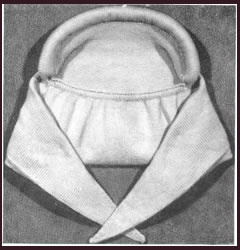 |
Materials4 ozs 3ply wool. One pair No 10 (3¼mm) knitting needles. 9½ inches elastic. TensionApprox. 32sts to 4 inches on No 10 needles. Size mattersTo fit an average sized head. Abbreviationsk2tog: (decrease) knit 2 sts together. A word on the woolOriginal knitted in Sirdar Majestic 3-ply Wool. Disclaimer
|

A lovely old-fashioned pair of knitted slippers. Make them using a luxury yarn in a striking colour for a quickly knitted Christmas gift.
InstructionsInstructions in 3 sizes, each size separated by forward slash (/). Both slippers are worked alike. Slipper (make 2)With No 11 needles, cast on 90/95/100
stitches and work 12 rows in garter stitch (that is: every row knitted). Change to pattern as follows: 1st row: k4, *
p2, k3; repeat from * to last 6 stitches,
p2, k4. 3rd row: k1, *
wfwd, slip 1, k2tog, psso, wrn, p2, *
to last 4 stitches, wfwd, slip 1, k2tog, psso, wrn, k1. Repeat these 4 rows 3 times more, then rows 1-3 inclusive again: 19 pattern rows. Work 5 rows in garter stitch. Cast off. Make a second slipper in the same way. To Make UpPress parts lightly on wrong side under a damp cloth. Fold foot pieces in half and join centre back and foot seams neatly with a flat seam. Thread ties through holes made in 19th row of the patterning. Press seams. Note: |
Materials
|
An extra Christmas gift just for you. Don't bother to thank me - it's priceless I think you'll agree.
Perfect if you are thinking of elf-themed fancy dress this Christmas - and I can recommend that you use any left-over felt to make a matching elfish pointy collar.

They miss out the key instruction at the end of the making up section .... "Do not wear".
Joking apart, this method of threading ribbon or fabric strips through a crocheted mesh base is a good technique for creating an interesting textured fabric to work with. I have seen it used to good effect making, for example, an evening clutch bag, using more luxurious starting materials.

This is a lovely 1950s Autumn jacket which is defined as "chunky" though this means "not fine" in modern parlance, as the wool weight is a pretty standard double knitting.
I love this style and always meant to make for myself but have not yet done so - hence it is untested, and the original instructions are available in only one size. The instructions are not intended for a beginner - you need to keep your eye on right and wrong sides, and preserving the button band stitches - but having said that, I think it is fairly clearly explained.
Instructions.Fancy rib pattern worked as follows: 1st row (wrong side facing): *
k2, p3tog; repeat from * to last 2 sts, k2 These 2 rows form pattern. BackWith No 8 (4mm) needles cast on 90 stitches loosely and work 4 inches
in stocking stitch, ending with a purl row. Next row: Purl, increasing 3 sts, evenly across the row [93 sts] Work straight in stocking stitch until back measures 7 inches from lower edge. With right side facing continue in stocking-stitch, shaping waist as
follows: Next row: k2tog, k25, k2tog, k27;
sl1, k1, psso; k25; k2tog. [81 sts] With right side facing continue shaping as follows: Next row: Increase in 1st stitch,
k26; increase 1 by picking up horizontal thread before next stitch and
knitting into back of it; k31; increase 1 as before; k26; increase in
last stitch [89 sts] Next row: Increase in 1st stitch,
k27; increase 1 by picking up horizontal thread before next stitch and
knitting into back of it; k33; increase 1 as before; k27; increase in
last stitch [93 sts] Next row: Increase in 1st stitch,
k28; increase 1 by picking up horizontal thread before next stitch and
knitting into back of it; k35; increase 1 as before; k28; increase in
last stitch [97 sts] Next row: Increase in 1st stitch,
knit to last stitch, increase in last stitch [99 sts] Next row (wrong side facing): P9; * purl twice in next stitch, p6; repeat from * to end [89 sts] Next row (right side facing): * p2, wrn, p1, wrn; repeat from * to last 2 sts, p2. [147 sts] With wrong side facing. change to fancy rib pattern, starting with 1st
pattern row and work straight until back measure 23½ inches down
centre ending with 1st pattern row [89 sts] Pocket LiningsWith No 8 needles, cast on 26 sts and work 6 inches in stocking stitch
ending with a knit row. Make second pocket in the same way. Left FrontWith No 8 needles, cast on 95sts and work as follows: Next row (right side facing): purl to last 23 sts; k11, sl1 purlways, k11. Change to pattern with button border in stocking stitch and remainder
in pattern as follows: 1st row (wrong side facing): p23;
* k2, p3tog; repeat from *
to last 2 sts, k2 Repeat these 2 rows until front measures 7 inches, ending with 1st pattern
row [67 sts] Next row: K5; increase 1, k4, cast off 26, k20 sl1 purlways, k11. Next row: P32, pur1 across one set of 26 pocket stitches in place of those cast off; p10 [68 sts]
Next row: K2tog, k27. k2tog, knit
to end. Next row: K2tog, k26. k2tog, knit
to end. Next row: K2tog, k25. k2tog, knit
to end. [62 sts] With right side facing, continue shaping as follows: Next row: Increase in 1st stitch,
k 25, increase 1, knit to end. Next row: Increase in 1st stitch,
k 26, increase 1, knit to end. Next row: Increase in 1st stitch,
k 27, increase 1, knit to end. Next row: Increase in 1st stitch,
k 28, increase 1, knit to end. Next row: Increase in 1st stitch, knit to end [71 sts] Work straight until front measures same as back at side edge. With right side facing, shape armhole by casting off 6 sts at the beginning of the next row, then k2tog at this edge on the following 4 alternate rows [61 sts] Next row: Purl. Next row: * p2, wrn, p1, wrn; repeat from * to last to last 25 sts; p2, k11, sl1 purlways, k11. [85 sts] With wrong side facing, continue in fancy rib pattern as follows: 1st row (wrong side facing): P23;
* k2, p3tog; repeat from *
to last 2 sts, k2 Repeat these 2 rows until front measures 20 inches, ending with 1st pattern row. Shape neck as follows: Next row: * p2, wool round needle, p1, wool round needle; repeat from * to last 25 sts; p2tog, k11, sl1 purlways, k11. Continue decreasing thus inside the 23 border sts on the following 10 alternate rows. Pattern back (1st pattern row). [50sts] Work a few rows straight in pattern, until back measures same as front
ending with 1st pattern row. With right side facing, continue in p2/k1 rib keeping stocking-stitch border as before, and shape shoulder by casting off 9 sts at the beginning of the next and following 2 alternate rows - armhole edge. Leave remaining 23 sts on a spare needle or stitch holder. Right FrontWith No 8 needles, cast on 95sts and work as follows: Next row (right side facing): K11, sl1 purlways, k11, purl to end. Change to pattern as follows (button border in stocking stitch as before): 1st row (wrong side facing): *
k2, p3tog; repeat from * to last 25sts; k2,
p23. Repeat these 2 rows for 1½ inches, ending with 1st pattern row. With right side facing, make double buttonhole in next 2 rows as follows: k4, cast off 3, k4, sl1, k4, cast off 3, k4, work to end and back, casting on 3 sts over those cast off Finish as for left front reversing all shapings, making another 5 double buttonholes as above at 3-inch intervals. Your pocket row will read: SleevesWith No 10 needles, cast on 48 sts loosely and work 5 inches in stocking stitch, ending with a purl row. With right side facing, change to No 8 needles and continue in stocking-stitch,
shaping sides by increasing 1 stitch at end of 3rd and every following
6th row until there are 78 sts. With right side facing, shape top by casting off 4 sts at the beginning of the next 2 rows, then k2tog at the beginning of every row until 40 sts remain; then k2tog at each end of every row until 20 sts remain. Cast off. To Make UpPress stocking-stitch parts only under a damp cloth. Join shoulder, side and sleeve seams; insert sleeves. Now with No 8 needles, k23 border sts. from spare needle at top of right
front and work straight on these sts, slipping centre stitch as before
until border fits to centre back of neck. Cast off. Oversew round double buttonholes. |
Materials
|
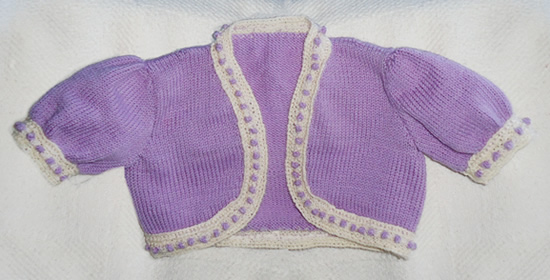
The bolero as such a popular wardrobe accessory for women in the 1950s - it went with all those off-the-shoulder/strapless little numbers (see footnote **) which was the only way to make them respectable day-wear.
This toddler adaptation with its cute puffy sleeves was clearly intended for a little girl.
InstructionsThe instructions are for two sizes - the larger size is given in bold
blue in curly brackets thus: "Intended to fit 1{2}
year old.". BackWith No.10 needles and main shade (M), cast on 70 {76} sts and work straight in stocking stitch, starting with a knit row, until back measures 2¼ {2¾} inches. With right side facing, shape armholes by decreasing 1 stitch at each end of next and every following alternate row until 58{64} sts remain. Work straight until back measures 5¾ {6¼} inches. With right side facing, shape shoulders by casting off 8 {9} sts. at beginning of next 4 rows. Cast off remaining 26 {28} sts. loosely. Left frontWith No 10 needles and M, cast on 18 {21} sts and work 2 rows in stocking stitch, starting with a knit row. Continue in stocking stitch, shaping the front edge by increasing 1 stitch
at the end of the next row, then at this edge on every following row until
there are 27 {30} sts. Right frontWork to correspond with left front, reversing all shapings. SleevesWith No 12 needles and M, cast on 43 {43}
sts and purl 1 row. Next row (right side facing): k2tog,
across entire row. BordersJoin shoulder seams. Main border: With No. 12 needles and contrast yarn C, cast on 7 sts and work in pattern as follows: 1st row (wrong side facing): Using
contrast C, * k1, p1; repeat from
* to last st, k1. These 6 rows form the pattern. Pin in position as you go along Sleeve Borders: In the same way work a strip in the pattern to
fit all round each sleeve edge. To Make UpPress parts gently on the wrong side under a damp cloth. |
MaterialsOriginal materials called for: 2 {2}
ozs Patons Beehive Fin- A pair each Nos 10 and 12 (3¼mm and 2¾mm) needles. Tension30sts and 38 rows to 4 ins over stocking stitch on No 10 needles. Size mattersWidth all round at underarm. 18 {20}
inches; length from top of shoulders, 6½ {7}
ins; sleeve seam, 2½ {2½}
ins. A word on the wool.I used some vintage 3 ply yarn which had no label (but I believe is wool) for the main shade, and some Patons pure wool 3ply in white for the contrast. Disclaimer
|
**Footnote: Have you seen Dana Wynter's outfit at the start of Invasion of the Body Snatchers (1956)?? Here - take a peek - it did have a bolero but she immediately removed it on entering the room.

All this for a visit to the dentist - ok,ok, he was her old boyfriend whom she was trying to impress....
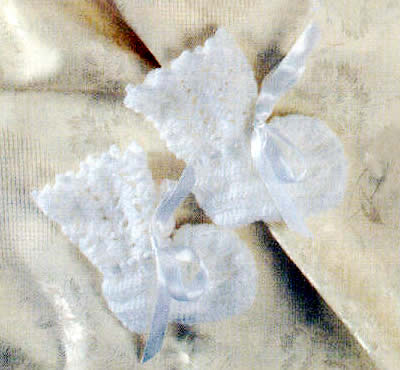
Well - it's so much talked about I could not let it pass without a little commemoration could I?
Just make sure you make them for your own special baby - I am sure the Palace is exploding with little woolly items (and in one of the hottest month's on record...).
This crochet pattern is a staggered shell, which I found a little tricky to follow, so use the detail photo at the end for guidance as to what it should look like.
Instructions.Special pattern stitch: And a reminder of English crochet stitches: Double crochet: draw a loop through next stitch, draw a loop
through both loops on hook. [American single]. Bootees (make 2)Beginning at the sole: make 15(17;20;23)ch loosely. 1st round: Miss 3 ch, 3 tr in next
ch, 1 tr in each of next 1(1;2;2)
ch, 1 htr in next ch, 1 dc in each of next 2 ch, 1 htr in next ch, 1 tr
in each of next 2(3;3;4)
ch, 1 d tr in each of next 3(4;6;8)
ch, 9 dtr in last ch. 2nd round: 3 ch, "inc", 1 tr in next st, "inc", 1 tr in each of next 10(12;15;18) sts, ("inc", 1 tr in next st) 4 times, "inc", 1 tr in each of next 10(12;15;18) sts, ("inc", 1 tr in next st) twice, sl st in 3rd ch at beginning. You now have 46(50;56;62) tr, counting the initial 3 ch as 1 tr. 3rd round: Working into the back loops only (leaves a ridge to mark sole): 3 ch, 1 tr in each tr to end; sl st in 3rd ch at beginning. 4th round: 3 ch, 1 tr in each tr to end; sl st in 3rd ch at beg. Repeat the 4th round 0(0;1;1) time(s). Shape InstepYou are now going to work back and forth across the instep in rows. 1st row: 3 ch, 1 tr in each of next
28(30;33;36)
tr, miss next tr, sl st across next 2 tr. Turn. Repeat the 2nd row 4(4;4;6) times. Next row: Miss 2 sl st, 1 tr in each of next 10 tr, 1 tr in each tr to end; sl st in 3rd ch at beg of 1st row to rejoin the round. You now have 28(32;38;38) tr. Next round: 4 ch, miss 1(1;2;2) tr, 1 tr in next tr, * 1 ch, miss 1 tr, 1 tr in next tr, repeat from * to last 1(1;2;2) sts, miss last 1(1;2;2) sts, sl st in 3rd of 4 ch to join the round. You now have 14(16;18;18) holes. Next round: 1 ch, 1 dc in same place
as sl st, * 1 dc in next 1 ch sp,
1 dc in next tr, repeat from * to
last ch sp, 1 dc in 1 ch sp, 1 dc in same place as first dc, DO NOT
JOIN the round. Turn, and work in rows as follows: First size only: 1st row (wrong side): 1 ch, 2 dc in first dc, * 3 ch, miss 3 dc, (1 dc, 3 ch, 3 tr) in next dc, miss 2 dc, (1 dc, 1 ch, 1 dc) in next dc, repeat from * ending last repeat with 2 dc in last dc instead of (1 dc, 1 ch, 1 dc). 2nd, 3rd and 4th sizes: 1st row (wrong side): 1 ch, 2 dc in first dc, * 3 ch, miss 3 dc, (1 dc, 3 ch, 3 tr) in next dc, miss 2 dc, (1 dc, 1 ch, 1 dc) in next dc *; repeat from * to * (0;1;1) times; 3ch, miss (2;3;3) dc, (1 dc, 3 ch, 3 tr) in next dc, miss (2;3;3) dc, (1 dc, 1 ch, 1 dc) in next dc (3;1;1) times; repeat from * to * (1;2;2) times, ending last repeat with 2 dc in last dc instead of (1 dc, 1 ch, 1 dc). All sizes: You now have 4(5;5;5) patterns. 2nd row: (3 ch, 1 tr) in first dc, * 3 ch, (1 dc, 3 ch, 3 tr) in next 3 ch sp, miss next 3 ch sp, (1 tr, 1 ch, 1 tr) in next 1 ch sp, repeat from * ending last repeat with 2 tr in last dc instead of (1 tr, 1 ch, 1 tr). 3rd row: (3 ch, 1 tr) in first tr, * 3 ch, (1 dc, 3 ch, 3 tr) in next 3 ch sp, miss next 3 ch sp, (1 tr, 1 ch, 1 tr) in next 1 ch sp, repeat from * ending last repeat with 2 tr in top of turning ch instead of (1 tr, 1 ch, 1 tr). Repeat the 3rd row 1(1;3;3) times. Next row: (3 ch, 1 tr) in first tr, * 3 ch, 1 dc in next 3 ch sp, 3 ch, miss 1 sp, (1 tr, 1 ch, 1 tr) in next 1 ch sp, repeat from * ending last repeat with 2 tr in top of turning ch instead of (1 tr, 1 ch, 1 tr). Next row: (3 ch, 2 tr) in first tr, * miss 1 sp, (3 tr, "Picot", 3 tr) in next dc, miss 1 sp, (3 tr, "Picot", 3 tr) in next 1 ch sp, repeat from * to last pattern, miss 1 sp, (3 tr, "Picot", 3 tr) in next dc, miss 1 sp, 3 tr in top of turning ch, "Picot". Fasten off. Make UpUsing a flat seam, join back seam. |
Materials
|
Picture of pattern detail:
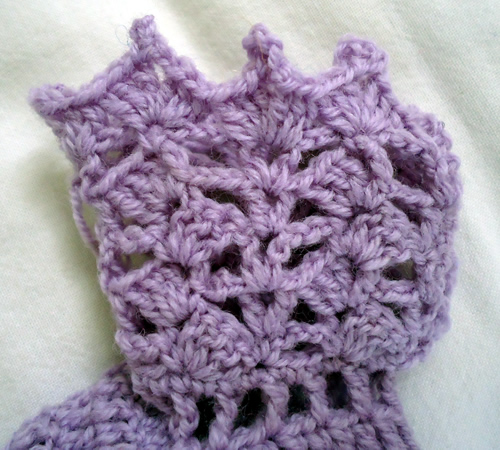
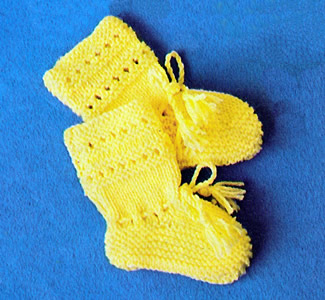
Well - it's so much talked about I could not let it pass without a little commemoration could I?
Just make sure you make them for your own special baby - I am sure the Palace is exploding with little woolly items (and in one of the hottest month's on record...).
This is the knitted set which is fairly plain with a discreet eyelet pattern, and should be quite simple to make.
Bootees (make 2)With No 10 needles, cast on 33 sts. and knit 1 row. 1st - 4th rows: Knit. Repeat the last 2 rows 4 times more. Next row: as 5th row. Work 14 rows in stocking stitch on these 13 sts. Rejoin yarn to inside edge of 10 sts, then knit up 10 sts along side
of foot; knit across 13 sts on needle, knit up 10 sts from other side
of foot, finally knit across remaining 10 sts. [53 sts] Shape toe: 1st row: (k1, k2tog, k21, k2tog)
twice; k1. Cast off. Make UpPress lightly on wrong side. Join seam. |
Materials
|
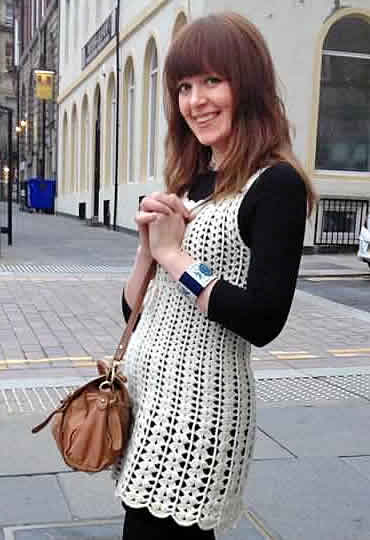
This is a lovely - and typical - dress from the burgeoning decade of the 1970s. Crafts and bohemian dress was the thing that defined the start of the era, (while Punk defined the end of it). Back to nature - self sufficiency - flowing maxi dresses and floppy hats - Golden Hands and all that followed (... quite a lot of macramé if I remember rightly).
Elaine made this version and Kate models it layered as a tunic - but with the weather we are being promised for the next few days** as Wimbledon comes to its climax, it might be just as appropriate to wear as originally designed - Grecian goddess style...
Instructions.Special pattern stitches as follows: Bar-st front (worked on right side rows): yarn over, then starting
with hook at front of work insert hook from right to left behind stem
of next st and through to front again, yarn over and draw loop through
up to same height as shells, then complete tr in usual way. [Editor's note: Elaine made this dress more than once, and she made a small adjustment to the pattern which worked well. Instead of making the skirt back and front separately, she joined the bodice back and front together at the side seams, and then worked the skirt in the round. Just make the appropriate amount of chains (3 or 4) at the start of each round and join at the end with a slip stitch. It saves having to make a join all the way down the side of the skirt.] Bodice BackUsing size 5 (5½mm) hook make 57(63:69) ch. 1st row (right side facing): Work
a shell of [2 tr, 1 ch, 2 tr] into 6th ch from hook, *
miss 2 ch, 2 ch, 1 tr into next ch, miss 2 ch, work 1 shell into next
ch; repeat from * to last 3 ch, miss 2 ch,
1 tr into last ch. 9(10:11)
shells. Repeat the last 2 rows until work measures 3½ ins. Shape Armholes 1st row (right side facing): Sl st
across to space of first shell, 3 ch, 1 bar-st into bar-st, *
1 shell, 1 bar-st; repeat from * to last shell, 1 tr into space of last
shell, turn. ‡ Continue in pattern until armholes measure 3½(3¾:4) inches. ‡‡Shape Neck 1st row (right side facing): Work
in pattern until 2 shells have been worked. 1 bar-st, 1 tr into space
of next shell, turn. Repeat the last row until armhole measures 6½(6¾:7) ins measured straight. Fasten off. Leave 1(2:3)
shells at centre unworked and rejoin yarn to centre of next shell. Bodice FrontWork as given for Back to ‡.
Continue in pattern until armholes measure 2½(2¾:3)
inches, ending with a right side row. Skirt BackWith right side of back facing rejoin yarn to lower edge and work across
starting ch as follows:- Fasten off. Skirt FrontWork as given for Skirt Back. Finishing and EdgingPress pieces very gently with a damp cloth, (or just dampen and pin out
to block). Edgings: Press seams and edgings. Optional Belt: |
Materials
|
A word on the wool.Potentially any double knitting quality can be used (knitting tension would be about 22sts x 30 rows to 4 inches or 10 cm). The recommended quantity of 13-17 ozs (1oz = 28g) is for a synthetic/nylon type yarn and the yardage on these tends to be 30-50% longer than pure wools or cottons, so be prepared to use up to twice as much weight in yarn as stated. This would be good made in cotton as a summer dress (can't imagine it in nylon... or rather I probably can - though here are some good synthetics these days). If choosing cotton, a blend or soft cotton would probably be better to give it more drape. Elaine used a pure lambswool double knitting yarn from Kingcraig, who have an eBay store, and Kate wears this version as a tunic. |
|

Doesn't this picture have a wonderful fresh spring feel? As if summer is just around the corner. It looks just right with a summer dress, to fling casually over the shoulders for those cooler English summer breezes - or for a more formal look - buttoned up with a scarf plus a narrow tweed skirt (and possibly gloves!) to complete the outfit (see photo at the end).
This design has been calling to me for quite some time but as usual I have yet to find the time to try it out. So here it is untested.
"raglan armholes and and firm ribbed bands for this useful cardigan in white to go with everything"
Instructions.Figures in bold blue given in brackets, refer to the larger size; where
only one figure is given, this refers to all sizes. BackWith No 13 needles cast on 123 (133) stitches
and work 10 rows in k1/p1 rib, starting the first row, k1. 1st row (right side facing): *
p3, k2; repeat from * to last 3 sts, p3. These 4 rows form the pattern. Continue straight in pattern until back measures 12½ (13)
inches at centre. Now with right side facing, shape shoulders as follows: Left FrontLeft. With No 13 needles, cast on 58 (63)
sts and work 10 rows in k1/p1 rib as before. With right side facing, shape armholes by casting off 5 (5) stitches at the beginning of the next row, then k2tog at this edge on every following alternate row until 48 (53) stitches remain. Work straight until back measures 20 (20½)inches, ending with a wrong side row. Now with right side facing, shape shoulder and neck edge as follows: Next row (armhole edge): cast off
3 (4) stitches; pattern to end. Continue in pattern, decreasing 1 stitch at the neck edge on the next
15 (15) rows, and at the same time
shape at the shoulder edge by casting off 3 (4)
stitches; at the beginning of the next and following 3 alternate rows,
then 3 (3) stitches at the beginning of the
following 5 alternate rows. Right FrontWork as for left front reversing all shapings. SleevesWith No 13 needles, cast on 59 (59) sts, and work 2½ inches k1/p1 rib, increasing 4sts evenly across on last row. [63 (63) sts] Change to No 8 needles and work pattern as for back, shaping sides by increasing 1 stitch at each end of the 7th and every following 6th row, until there are 97 (97) sts, taking the eextra stitches into the pattern as they are made. Work straight until sleeve measures 16 inches or required length. With right side facing, shape top by casting off 2 sts at the beginning of the next 2 rows. ** Repeat from ** to **
3(5) times more: [85 (81)
sts] Next row(right side facing): p2,
p2tog, p1. Front Borders and NeckbandPin sleeves into armholes - top of sleeve fits right across shoulders to neck edge. Sew carefully in position. Front Borders: With No 13 needles, cast on 13 stitches and work
a strip in k1/p1 rib to go up right front, round back of neck, and down
left front. Sew border strip in position as you go along. Cast off. To Make UpPress parts only very lightly on wrong side under a damp cloth.
|
Materials
|
A word on the wool.Yarns called "quick knit" "quickerknit" and such variations evolved as a compromise for baby designs. They were half way between traditional DK and 4 ply. These days, there are quite a few yarns that might have a suitably similar tension as "light weight" double knits. Debbie Bliss Baby Cashmerino ( 125m per 50g ball) is one such yarn being of superb quality, highly practical, and knitting to this convenient gauge. If I were going to knit this cardigan, this is what I would use. BUT - how much you might need is open to question. Most of the baby quick-knits
were blended or completely synthetic and thus probably had a better yardage
than pure wools. The name of the original yarn "Botany" implies
it might have been a pure wool but who knows what "Patonised"
implied and I have no idea of the yardage. The French manufacturer Phildar has traditionally offered ranges in this kind of yarn weight, but in practical wool/synthetic blends, currently for example: Laine Merino Alpaga, Phildar Partner 3.5, Fil Oxygene - all coming in at around 110-130m per 50g equivalent. Bergere de France is a manufacturer whose yarns I know little of but they seem to have at least two suitable offerings eg: Annecy, Coton Fifty. It was a bit of a surprise to me to find that I can't find much in the
way of baby yarns with this designation any more. |
|
|

|

This looks like a little Victorian cherub, though the pattern is much later. It uses a combination of smooth and fluffy 4 ply yarns in a relatively simple crochet motif.
I think the bonnet is particularly cute.
Instructions:The items are made by piecing together a basic motif: Using blue colour (B), make 8 chain and join into a ring with a slip
stitch. Bonnet:Make 14 motifs the same and join together as shown in diagram.
Back of bonnet: 1st row: 1 dc into 2nd ch from hook,
1 dc into each of next 27 ch Continue in dc increasing 1 stitch at each end of every 4th row until
there are 36 dc. Making up the Bonnet: Pin one edge of front piece up sides and all round top edge of back piece.
With right side of work facing and B, crochet the 2 pieces together but
working 4 dc into edge of back piece only between motifs Fasten off. Mitts:Starting with the front of the mitts: Using B, make 21 ch Now work the back of the mitts: Work 2 motifs as given for bonnet and join together as before. With right side of motifs facing, start in corner and work along one
long edge as follows:- Turn and work 9th and 10th rows as given for front of mitt. Thumb: Using B, make 2 ch. Join thumb seam from top down as far as marker. Making up the mitts: Make another mitt in the same way but inserting thumb on opposite side
to first mitt when making up. |
Materials2 ozs 4 ply, in Powder Blue and One No 12 (2¾mm) crochet hook. TensionEach motif measures about 2 inches square. 6½ dc to an inch over
plain dc. Size mattersBonnet: All round front edge measures 15½ inches. Crochet abbreviations:ch: chain [Editor's note: Remember these are English crochet instructions where dc is equivalent to US single crochet - see "Terminology" in the side bar.] A word on the wool.Original yarn was Patons Beehive 4ply and Fuzzy Wuzzy angora. Disclaimer
|
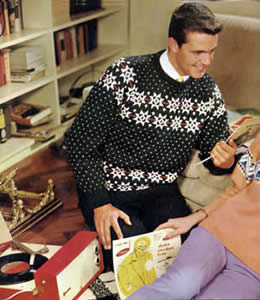
"Carefree and colourful sweater for him uses sparkling motif designs to wear out and about over the week-end when the sun shines"
Carefree it may be.. but a double knitting fair-isle for Spring? That's a novel idea. However, I'm sure "a thick sweater to wear on a wet Spring weekend" is also a suitable maxim, so here we are.
[Editor's note: Here we are indeed.... I wrote this at the end of February - and now on March 11th we have sub-zero temperatures and blizzards raging in the South of England (and the Channel Islands). So this sweater choice.... "just perfick" for March.]
The main picture is a low resolution photo that does not quite show the pattern detail to the full; this is because I just had to include the wonderful backdrop to the sweater with record player and vinyl albums. These cool cats are from the early sixties but are listening to 1950s American jazz. You can see more clearly how the pattern looks in the chart at the end.
InstructionsTwo sizes are given, with the larger size created by using a larger sized
needle. Do check your tension with whatever yarn type you use, as the
fair-isle patterning will tend to make the knitted fabric tighter than
normal. Back:** [Editor's note: The original instructions are written out line by line as reproduced below. I have created a chart which you can see at the end of the pattern.] Change to No 8 (4mm) [7 (4½mm)] needles, join in white (W), and star pattern as follows: 1st row (right side facing):
knit: 1W; * 5C, 1W; repeat from *
to end. Break C and join in Nasturtium Red (N). 8th row: purl: *
5N, 3W, 3N, 3W, 4N; repeat from *
to last stitch, 1N. Repeat rows 7 through to 1 inclusive, in that order. (That is, the reverse
of what you just knitted). Rejoin W and continue as follows:- 19th row: knit: , *
3C, 1W, 2C, repeat from * to last
stitch, 1C Break C and join in N Break N and rejoin C repeat rows 26 - 19 inclusive in that order (that
is, reversed as in previous sequence) Continue in snowflake pattern as follows:- 1st row: purl. Rejoin W Rejoin W Repeat the last 8 rows 5 [4 or 5] times more, then rows 1-5 inclusive again. Shape armholes: Cast off 8 sts. at the beginning of the next 2 rows. Rejoin W. 1st row: k2tog W; knit: 5C,
* 1W, 5C; repeat from *
to last 2 stitches, k2tog W. 8th row: purl: 2N, *
3W, 3N, 3W, 9N; repeat from * to last
11 stitches, 3W, 3N, 3W, 2N. 9th row: k2tog, knit: 1W, *
(1C, 2W) 3 times, 7C, 2W; repeat from *
to last 10 stitches, (1C, 2W) twice, 1C, 1W, k2tog. 16th row: purl. Next row: k2tog W, knit: 5C, *
1W, 5C; repeat from * to
last 2 stitches, k2tog W. Next row: purl. Next row: purl. Keeping continuity of pattern continue decreasing 1 stitch at each end of every alternate row until 47 stitches remain. Pattern back and leave stitches on a spare needle. Front:Work as for back from ** to **. Shape neck: Next row: k2tog, k16, k2tog, turn and leave remaining stitches on a spare needle. Continue in pattern on first 18 stitches, decreasing 1 stitch at each end of every knit row until 2 stitches remain. K2tog and fasten off. With right side facing, return to remaining stitches, slip centre 25 stitches, on a spare needle, rejoin wool to last 20 stitches, k2tog., pattern to last 2 stitches, k2tog. Finish to correspond with first side. Sleeves:With No 10 needles and C, cast on 56 stitches and work 3 inches k1, p1 rib. Next row: *
k2, knit twice in next stitch, repeat from *
to last 2 stitches, k1, knit twice in last stitch. [75 sts] Change to No. 8 [7] needles, join in W and continue in snowflake pattern as follows:- 1st row: knit:
1C, 1W, * 5C, 1W; repeat from *
to last stitch, 1C. 2nd row: purl. 5th row: knit: 5C, *
1W, 5C; repeat from * to end. 6th row: purl. Keeping continuity of pattern increase 1 stitch at each end of the next and every following 6th row until there are 109 stitches. Work straight until 13 complete patterns and 2 rows of 14th have been done from start. Now shape top working as for back from †† to †† : 55 stitches remain. Next row: purl. Keeping continuity of snowflake pattern decrease 1 stitch at each end of every row until 5 stitches remain. Leave these stitches on a spare needle. To Make UpPress parts on wrong side under a damp cloth, avoiding ribbing. Join remaining raglan seam. Press all seams, avoiding ribbing. |
Materials
|
Chart of the first pattern section as given for the Back. This shows the pattern detail not fully visible in the main photo.
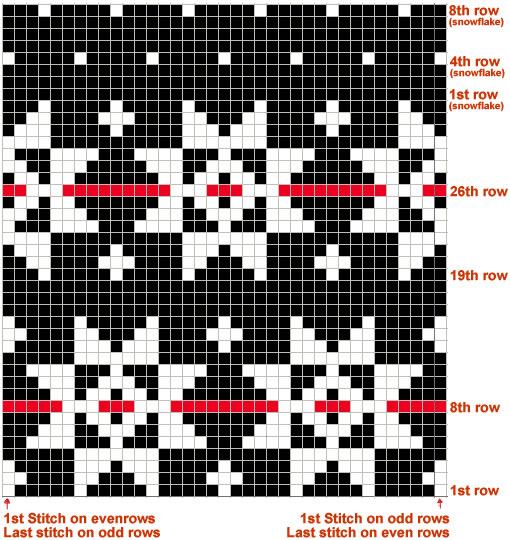
From the original photo I can just make out the records in the foreground - the ones on the sofa behind the models defeat me...
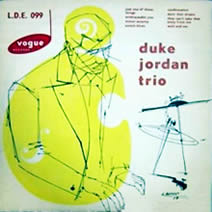
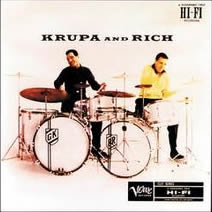
The Duke Jordan Trio look like they are on the turntable (if not our model's companion is bending the vinyl in the sleeve to an ill-advised angle). The album was recorded on January 28th 1954. Tracks are: Jordu, Scotch Blues, Wait And See, Darn That Dream, Embraceable You, Just One Of Those Things, They Can't Take That Away From Me, and, Confirmation.
Next up for consideration (our model is reading the sleeve notes) is "Krupa and Rich" - both drummers - with an eponymous recording from 1956.
Examples of the music can be found on You Tube.
It has to be a Dansette doesn't it?
I have to admit I was totally ignorant about this famous brand until very recently. I can't exactly say they were before my time, as they were manufactured between 1952 and 1969, and we did have a record player in that era which was likely to have been a Dansette, but I cannot remember it well enough to say one way or the other.
As to the model in the picture - it looks a bit like the "Bermuda" shown on this fabulous site, though there are some differences. It seems likely as Julie says: "The Dansette Bermuda is by far the model we have the most of in all colours".

A lace baby shawl made in a 3 ply fingering weight, which makes it a bit more feasible to contemplate as a viable project than the traditional 2 ply, while yet remaining fine and lacey. Added to that, it is made up in sections, rather than a single piece which makes it easier to handle, with all the decreasing lace stitches.
Note added September 2018: since I first transposed this pattern I have had a number of queries so I have recently checked the pattern by knitting it myself from the instructions, and as a consequence corrected some scripting errors (random capital letters and typos), plus I have added the number of stitches after each alternate pattern row on the border pieces. I hope this will help, because despite the fact that the stitches overall are gradually decreasing, on some rows the stitch count increases.
I hope I have caught all the remaining issues, but, as ever, I always welcome anyone sharing any problems they may encounter while knitting it.
InstructionsThe shawl is made in 5 pieces: first a centre square, and then 4 mitred borders that are sewn on each side of the centre. Centre SquareWith No 8 needles, cast on 162 stitches. 1st row: knit. Repeat the last 4 rows until work measures 21 inches. Borders (make 4)With No 9 needles, cast on 206 stitches. 1st row: knit. Repeat 2nd and 3rd rows twice more [200 sts]. Change to pattern as follows:- 1st row: p2tog, p4, k2tog, wrn, p2,
* (k1, wfd) twice, k2, k2tog, p1,
sl1, k1, psso, k1, k2tog, p1, sl1, k1, psso, k1, k2tog, p1, sl1, k1, psso,
k2, (wfd, k1) twice, p2, k2tog, wrn, p2; repeat from *
5 times more, p2, p2tog. [186 sts] Cast off 162 stitches. Make 3 more pieces the same. To Make UpPin parts out and press very lightly under a damp cloth (so not to flatten the pattern stitches too much). |
Materials
|

A lovely warm idea that has never lost its popularity: a scarf/hood combination. This has an interesting construction with the scarf being double sided, and the hood being more a like a pocket with the intention that it should form soft folds when worn. [I'm more used to a pixie hood type design with a centre back seam].
Hood Scarf:Using the main colour wool (MC) cast on 108 sts. 1st row: Slip 1, knit to end of row. ** Join in the first contrast (B) and working the 1st and 2nd rows as shown on the chart proceed as follows: 1st row: *
Knit 2MC, 3B, 3MC, 3B, 1MC, repeat from *
to end of row. Break off first contrast (B) and join in the second contrast
(Y).
Repeat from ** to ** twice. Continue in stocking stitch until the work measures 40 inches Work 18 rows in stocking stitch. Hood Border:Work a border along one 16 inch side of the hood opening as follows: Next row (right side): Slip 1, purl
to the last stitch k1. 1st row: *
Knit 2MC, 3B, 3MC, 3B, 1MC, repeat from *
to end of row. Break off first contrast (B) and join in the second contrast
(Y). Commencing with the 3rd row, proceed as shown on the chart, changing
the colours when necessary, until the 15th row has been worked. Proceed as follows: To Make Up the Scarf.Sew the ends of the scarf together on the wrong side. |
Materials5 ozs 3ply in main shade plus "medium-sized" balls in each of four contrast colours eg blue, yellow, green and pink. One pair No 9 (3¾ mm) knitting needles. TensionApprox. 30sts to 4 inches on No 9 needles. Size mattersWidth round face edge is 16 inches. A word on the woolOriginal knitted in Sirdar Majestic 3-ply Wool Disclaimer
|

Toddler slippers for a quickly knitted Christmas gift. The top of each slipper is knitted, and is designed to be attached to a purchased leather sole. You could make your own out of leather (but be prepared to line it - perhaps with quilt batting and fabric, fleece fabric, or a shaped piece of knitting. If you design your own knitted sole you can make it non-slip by sewing on sole-shaped cut-outs from cushioned fabric ("slip-a-grip"); various brand options can be purchased on a roll from kitchen suppliers, or you can buy specialist sewing fabrics for this purpose.
Below I've added a great You Tube link for instructions on how to make your own non-slip soles.
InstructionsBoth slippers are worked alike. The following special abbreviation is used throughout the pattern, making a wide ribbed cable. Tie 5: Insert right-hand needle between 5th and 6th stitches from point of left-hand needle, draw loop through and place on point of left-hand needle, then k2tog, p1, k1, p1, k1.
Slipper (make 2)With No 11 needles, cast on 45 stitches and work 2½ inches in k1/p1
rib, rows on right side having a k1 at each end. Slip first and last 6 stitches on safety-pins for heel. With right side facing, rejoin wool to the centre 33 stitches and with No 9 needles continue in pattern for instep as follows:- 1st row: p4, (rib 5, p5) twice, rib
5, p4. Repeat the last 2 rows once more. 5th row: p4, tie 5, p5, rib 5, p5,
tie 5, p.4. Repeat 1st and 2nd rows twice more. 11th row: p4, rib 5, p5, tie 5, p5,
rib 5, p4. These 12 rows form pattern. Repeat, them once more, then rows 1-6 inclusive again. Continue in pattern decreasing 1 stitch at each end of next and following 2 alternate rows: 27 stitches remain. Now decrease 1 stitch at each end of every row until 15 stitches remain. Cast off. Join side edges of ribbing to form back seam. For the heel: Next row: p twice in 1st Stitch,
p to last stitch, p twice in last stitch. FinishingPin out patterned part and heel of each slipper and press on wrong side
under a damp cloth, avoiding ribbing. Pin tops to slipper soles and sew firmly in position. |
Materials
|
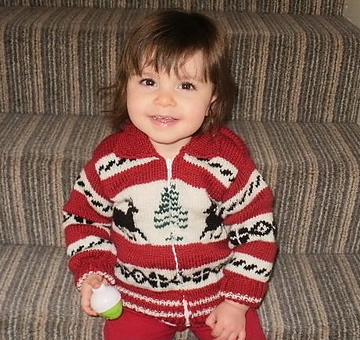
This looks so cute and would make a lovely Christmas cardigan for a toddler. The fair-isle design is not too challenging and hopefully you have plenty of time to knit for this year's festivities.
One size only I'm afraid, but you could increase it slightly by increasing the yarn weight and needle size.
This was beautifully knitted by Sara for her daughter, who also models it. The original (boy) model seen after the pattern instructions.
InstructionsBack and fronts are worked together and then divided and worked separately at the armholes. Note that all the charted patterns are worked in shades "dark" and "light". The medium shade is used for bands of colour. Back and Fronts:Using No 8 (4mm) needles and Medium shade, cast on 127 sts. Change to No 7 (4½mm) needles and work remainder of Back and Fronts
in stocking stitch, (knit on right side, purl on wrong side). Commencing with a knit row, work 4 rows Medium, then 3 rows Light. Starting with a purl row, work rows 1-7 inclusive. from Chart A, reading chart from left to right on purl rows and right to left on knit rows.  Starting with a knit row, work: Work rows 1-20 inclusive from Chart B, working from right-hand side to
the centre stitch; work the centre stitch; then work back to the right-
hand side on every row.  Divide for Back and Fronts:Next row (2lst row of Chart B): K26
in Light, cast off 11 sts in Light; (1st left on needle after cast-off),
k25sts in Light, k1 st in Dark, k26 sts in Light, cast off 11 sts in Light.
(1st left on needle after cast-off), knit remaining 25 sts in Light. Next row (22nd row of Chart B): P2
in Dark, p24 in Light. Using Light, work 2 rows. Work 3 rows in Light, decreasing 1 stitch at the neck edge on every row. [20 sts] Starting with a purl row, work rows 1-3 inclusive from Chart C.  Starting with a purl row, work 2 rows Light, 1 row Medium. Back:Slip the group of 53 sts back on to the working needles, and with wrong side facing rejoin Light proceeding for Back as follows: Next row (22nd row of Chart B): P24
in Light, p5 in dark, p24 in Light. Work 3 rows in Medium. Next row: Using Medium, k2tog; knit to the last 2 sts, k2tog. [49sts] Armhole shaping is now complete. Starting with a purl row, work rows 1-3 inclusive from Chart D.  Using Medium for the remainder of the Back, continue until the armhole
measures 5 ins, (that is 5 ins from the 11 cast-off sts), finishing at
end of a purl row.. Right Front:Slip remaining 26 sts back on to the working needles, rejoin Light, and with wrong side of work facing proceed for Right Front as for Left Front, reversing all shapings, and noting that the first 4 rows will read: Next row (22nd row of Chart B): Purl
24 in Light, 2 in Dark. Sleeves[Editor's note: The sleeves are knitted top down, making for easy length adjustments (or repairs).] Using No 7 needles and Medium, and commencing at the top of the Sleeve,
cast on 49 sts. Work rows 1-3 inclusive from Chart D. Work rows 1-7 inclusive from Chart E.  Work 3 rows in Light, 9 rows in Medium, and 3 rows in Light.
Next row: Using Medium, (p1, p2tog, p2, p2tog) 7 times. [35 sts] Change to No 8 needles, and commence the cuff, working stripes in rib
as for back and fronts welt as follows: Back CollarUsing No. 8 needles and Medium slip 13 sts. from Back neck on to the
working needles, and with right side of work facing proceed in rib as
on welts, increasing 1 st. at both ends of the 3rd and every following
alternate row until there are 33sts. Right part of CollarUsing No. 8 needles and Medium, cast on 2 sts. 1st row: Increase in the 1st stitch,
k1. Cast off. Left part of CollarUsing No. 8 needles and Medium, cast on 2 sts. 1st row: Increase in the 1st stitch,
k1. Cast off. To Make UpOmitting the ribbing, with wrong side of work facing block each piece by pinning out round edges. Omitting ribbing, press each piece using a warm iron and damp cloth. Using a back-stitch seam join shoulder and sleeve seams and stitch sleeves into position. Using a flat seam, stitch cast-off edge of Right Portion of Collar to
shaped edge of Back Collar noting that turnings should be placed nearest
to neck edged. Stitch side of Collar into position. Stitch zip into position. Press seams. |
Materials
|

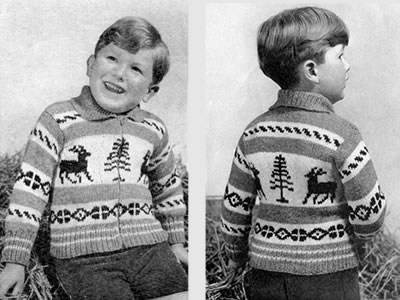
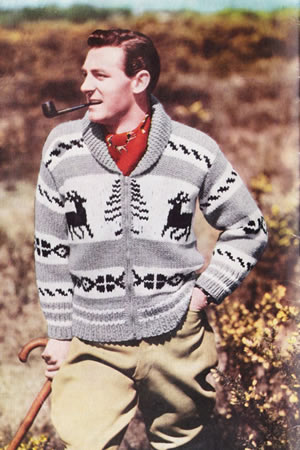
Some 10 years after the entry for the child's version, I discovered an adult cardigan. Astonishingly, it is made using exactly the same instructions - practically word for word - just using a very thick wool.
They published it first as part of the Stitchcraft Moorland (DK) booklet, calling it a North American Indian Coat (pictured above), using 3 strands of the yarn held together, and later as a separate pattern leaflet "by special request" using the new Big Ben yarn, calling it a Western Frontier Jacket (pictured at the end).
With such economy on a rewrite, it's still one (much bigger) size only.
InstructionsBack and fronts are worked together and then divided and worked separately at the armholes. Note that all the charted patterns are worked in shades "dark" and "light". The medium shade is used for bands of colour. Back and Fronts:No 2 (7mm) needles and Medium shade, cast on 127 stitches and work ribbed
welt as follows: Continue using Medium, repeat 1st and 2nd rows 3 times. The ribbed welt is now complete. The remainder of Back and Fronts is worked in stocking stitch, (knit on right side, purl on wrong side), breaking off and joining in colours as required. [Editor's note: You may need to use a circular needle to contain this many stitches in bulky yarn, but you will still work back and forth as if on 2 needles.] Commencing with a knit row, work 4 rows Medium, then 3 rows Light. Starting with a purl row, work rows 1-7 inclusive from Chart A, working 16 stitch repeat 7 times, plus the odd 15 stitches as marked, Read the chart from left to right on purl rows and right to left on knit rows.  [Editor's note: After working Chart A the adult instructions call for a slightly longer length than the child's version.] Then, starting with a knit row, work 3 rows in Light. Work rows 1-20 inclusive from Chart B, working from right-hand side to
the centre stitch; work the centre stitch; then work back to the right-
hand side on every row.  Divide for Back and Fronts:Next row (21st row of Chart B): knit
26 in Light, cast off 11 stitches in Light; (1st left on needle after
cast-off), knit 25 stitches in Light, knit 1 stitch in Dark, knit 26 sts
in Light, cast off 11 stitches in Light. (1st left on needle after cast-off),
knit remaining 25 stitches in Light. [Editor's note: After dividing for back and fronts, the adult instructions again need a slightly longer length in the armhole,. Left Front:Shape armhole and commence to shape front slope: Next row (22nd row of Chart B): purl
2 in Dark, purl 24 in Light. Next row (23rd row of Chart B): knit
26 in Light. Using Medium, work 3 rows. Next row: Using Medium, k2tog, knit to the last 2 stitches, k2tog. [22stitches] This completes the armhole shaping. Starting with a purl row, work rows 1-3 inclusive from Chart C, working the 4 stitch repeat 5 times, reading from left to right on purl rows and from right to left on knit rows.  Next row: Using Light, knit to the
last 2 stitches, k2tog. Starting with a purl row, work 2 rows Light, 1 row Medium. Back:Slip the group of 53 stitches back on to the working needles, and with wrong side facing rejoin Light proceeding for Back as follows: Next row (22nd row of Chart B): purl
24 in Light, p5 in dark, p24 in Light. Work 3 rows in Medium. Next row: Using Medium, k2tog; knit to the last 2 stitches, k2tog. [49sts] Armhole shaping is now complete. Starting with a purl row, work rows 1-3 inclusive from Chart D, working the odd stitch as marked, then the 4 stitch repeat 12 times.  Using Light work 3 rows. Using Medium for the remainder of the Back, continue until the armhole
measures 8½ ins, (that is 8½ ins from the 11 cast-off stitches),
finishing at the end of a purl row.. Right Front:Slip remaining 26 stitches back on to the working needles, rejoin Light, and with wrong side of work facing proceed as for the Left Front, reversing all shapings, and noting that the first 4 rows will read: Next row (22nd row of Chart B): purl
24 in Light, p2 in Dark. ...and then as stated above, complete as for Left front reversing shapings. Sleeves[Editor's note: The sleeves are knitted top down, making for easy length adjustments (or repairs).] Using Medium, and commencing at the top of the Sleeve, cast on 49 stitches and work 8 rows in stocking stitch. Continue in stocking stitch as follows: Work rows 1-7 inclusive from Chart E, working the 16 stitch repeat 3 times, and the odd stitch as marked.  Work 3 rows in Light, 9 rows in Medium, and 3 rows in Light.
Using Medium, work 1st and 2nd rows of rib as on the body. Cast off in rib. Back CollarSlip the 13 stitches from the Back neck on to the working needles, and with right side of work facing proceed in rib as on the welts, increasing 1 stitch at both ends of the 3rd and every following 4th row until there are 27 stitches on the needle. Continue on these stitches until the rib measures 8 inches from the beginning. Sides of CollarWith right side of back collar facing, using Medium colour, knit up 24 stitches along one of the the increase edges, and proceed in garter stitch (every row knit), decreasing 1 stitch at the neck edge on the next and every following alternate row until 2 stitches remain. [Editor's note: The decrease edge is the one which will be sewn to the front slope to make the shawl collar. When the collar is folded over the ribbed section will be visible at the back of the jacket, and the garter stitch sides will be visible at the front of the jacket.] Cast off. Work the other side of the collar to match. To Make UpOmitting the ribbing, with wrong side of work facing block each piece by pinning out round edges. Omitting ribbing, press each piece using a warm iron and damp cloth. Using a back-stitch seam join shoulder and sleeve seams and stitch sleeves into position. Using a flat seam, stitch Collar in position. With right side facing, work 1 row of double crochet along each front edge where the zip is then stitched into position. Press seams. |
Materials
|

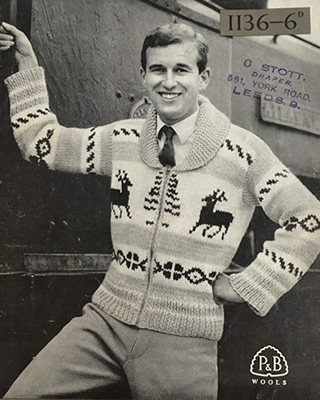
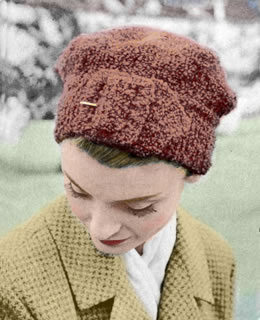
Charming retro hat with decorative band and buckle.
I learned from the Debbie Bliss Magazine Autumn/Winter 2012 that one of my favourite designers, Louisa Harding, has been facing up, with her husband, to his challenge of being treated for lymphoma. In appreciation for the help of Macmillan nurses, Louisa is taking part in Macmillan's Nepal Hiking Challenge and seems well on her way to raising her goal of £5000.
To help achieve the target She has put together a series of seven knitting patterns called 'Himalayan Hiking Hats'. She will have her photo taken wearing each one of the hats on the first 6 days of the trek. The seventh hat pattern in the series will be knitted 'en route' and photographed on the 7th (last) trekking day.
Download the hat patterns from her site and show your support by sending a donation.
Instructions.The main hat is knitted in reverse stocking stitch, with the band in garter stitch. The design is intended for a textured yarn. CrownUsing the 5 No 10 needles, cast on 8 stitches, placing 2 stitches on each of 4 needles. 1st (and every alternate) round:
purl 6th round: *
k2, knit twice in next stitch; repeat from *
all round. [32 sts] Continue increasing 8 stitches thus on every alternate round until there
are 36 stitches on each needle. [144 stitches] Next round: *
k16, k2tog; repeat from * all round.
[136 sts] Cast off. BandCast on 16 stitches, and work a strip in garter-stitch (every row knit)
22 inches long - or length required to fit round head with 3 inches to
spare. Now decrease 1 stitch at each end of the next and every alternate
row until 2 stitches remain; k2tog and fasten off. This forms a point. Stitch the cast-on edge of the band to the buckle, then slot the shaped end through the buckle pulling it through until the band fits round the head snugly. To Make UpPin band in position evenly all round crown noting that the purl side
of the crown is the right side. |
Materials
|
A word on the wool.Patons Rimple was a softly textured bouclé yarn, (97% wool, 3% nylon), which knitted to a double knitting tension. This hat is knitted on finer needles than usual so the knitted fabric will be denser and stiffer, giving the hat more body. There are a few double knitting bouclé yarns available though many tend to be chunky weight. Debbie Bliss seems to have discontinued the Cashmerino Astrakhan but you can still obtain it at some outlets on the internet (and often discounted). Rowan have recently brought out a British Sheep Breeds "fine" bouclé but this still seems to knit up to a chunkier tension. You can try and obtain the right tension with finer needles - and I think this would produce an excellent knitted fabric for the hat - but be warned that knitting bouclé tightly on small needles is very hard work. I cannot supply the yardage of Rimple, and can only guess that "Harlequin" was a multi-coloured tweed. | |
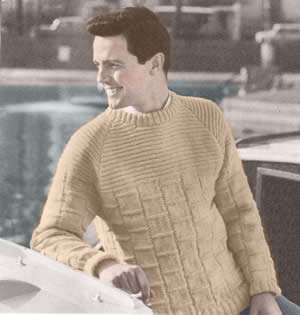
This is almost a guernsey style man's sweater. The "chequered pattern" is similar to the "Jacob's Ladder" in the guernsey tradition, although the raglan sleeve would not be traditional, and the double knitting yarn is a little heavier than the usual 5 ply.
I particularly like the change to to the ridged pattern for the yoke, and the raglan sleeves. I guess if you were up to a challenge, you could thread all the stitches for the yoke sections on one circular needle, and knit in the round as one piece, avoiding any potential bulky seaming. If I ever knit this, I may try that, but you do need to work it out first, as the decreasing for the sleeve sections is usually in a different sequence from the backs and fronts.
"...typical "man appeal" style that will make it a winner..."
InstructionsThese 8 rows form ridge pattern: Back:Using No 10 (3¼mm)needles cast on 104(108)stitches and work 2½ inches in k2, p2 rib, increasing 10(12)stitches evenly across the last row: [114(120)stitches] Change to No 8 (4mm)needles and pattern: 1st row (right side facing): knit. These 16 rows form pattern. With right side facing, shape raglans by casting off 5(5)stitches
at the beginning of the next 2 rows, then decrease 1 stitch at each end
of the next and every following 4th row until 90(96)stitches
remain. With right side facing, change to ridge pattern as given at the beginning,
and work 2 rows straight, then continue decreasing 1 stitch at each end
of the next and every following 4th row until 76(86)stitches
remain. Work 3 rows straight. Front:Work exactly as for the back until 54(56)stitches remain in raglan. Work 1 row in pattern. With right side facing, divide for neck as follows:- Next row: k2tog, pattern 15(15),
turn, and leave remaining stitches on a spare needle. With right side facing, slip centre 20(22)stitches on a spare needle, rejoin wool to remaining stitches, and pattern to the last 2 stitches; k2tog. Finish to correspond with first side. Sleeves:With No 10 needles, cast on 52(52)stitches and work 2½ inches k2, p2 rib, increasing 6 stitches evenly across the last row: [58 (58)stitches] Change to No 8 needles and work in pattern. 1st row (right side facing):
knit. Continue in pattern shaping sides by increasing 1 stitch at each end of the 5th and every following 6th row until there are 86(86)stitches. Work straight until sleeve seam measures about 19½ inches, ending with same pattern row as you did when you started the raglan on the back. With right side facing, shape raglan top by casting off 4(4)stitches
at the begining of the next 2 rows, then decrease 1 stitch at each end
of the next and every following 4th row until 64(64)
stitches remain. With right side facing, change to ridge pattern as for back and work
2 rows straight, then continue decreasing 1 stitch at each end of the
next and every following 4th row until 50(50)
stitches remain. Now decrease 1 stitch at each end of the next and every following alternate
row until 10(10) stitches remain.
Neck Band:Join raglan seams matching patterns carefully. With the set of 4 No 10 needles and right side facing, start at left
raglan seam on front and pick up and knit 18 stitches down left
side of neck; Work in rounds of k2, p2 rib for 2½ ins. To Make UpPress parts lightly on wrong side under a damp cloth. |
Materials
|
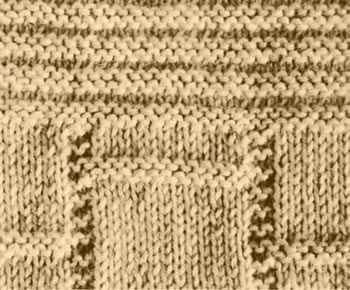
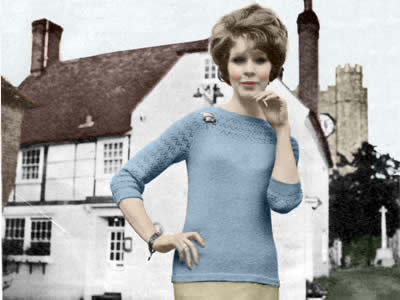
For an even cooler trend for summer - which seems all too possible this year in the UK - another early sixties light woollen top with bracelet length sleeves (my favourite). This design seems very representative of the 1960s to me, with its plain simplicity and straight body-line, combined with heavier design work emphasising the sleeve.
"...decorative stitches and scooped necklines make pretty tops to wear on summer days..."
Note: I have not knitted this pattern, so if you have a problem with it, then please let me know so I can try and help.
InstructionsInstructions are for 3 sizes with the larger sizes; where one set of
figures is given this applies to both sizes. Back and Front alike.With No 12 (2¾mm) needles cast on 132/140/148
stitches loosely and work 24 rows in stocking-stitch, starting with a
knit row. With right side facing, change to No 11 (3mm) needles and continue in stocking stitch, starting with a knit row, and work straight until work measures 14 ins. down centre, ending with a purl row. Shape armholes: by casting off' 7/5/9 stitches at beg. of next 2 rows, then decrease 1 stitch at the beginning of every row until 96 stitches remain. Shape neck: Next row(right side facing): k2tog,
k16, turn, and leave remaining stitches on a spare needle. Repeat the last 2 rows until 2 stitches remain; p2, then k2tog and fasten off. With right side facing, slip centre 60 stitches on a spare needle, rejoin wool to remaining stitches, k16, k2tog. Next row: purl to last 2 stitches,
p2tog. Finish to correspond with first side. SleevesWith No. 11 needles, cast on 99/111/111 stitches. 1st row: knit. Shape top as follows: 1st row: cast off 9, purl to end.
YokeJoin raglan seams. Stitches for yoke are arranged on the circular needle for easy working but pattern is worked backwards and forwards with a backopening. Using a spare No 11 needle, divide 60 stitches at back onto 2 needles. With right side facing and using the circular No 11 needle, knit 30 stitches from left side of back, pick up and knit 11 stitches up shaped edge, purl 45 sleeve stitches, pick up and knit 11 stitches down shaped edge of front, k60 stitches from spare needle, pick up and knit 10 stitches up shaped edge, purl 45 sleeve stitches, pick up and knit 11 stitches down shaped edge of back, then knit remaining 30 stitches: 253 stitches Next row: knit. Continue as follows:- 1st row: k6, *
wfd, k2tog, k4; repeat from * to last
stitch, k1. Repeat rows 1-11 inclusive once. Repeat rows 1-11 inclusive once. Change to No 12 needles and work 20 rows stocking stitch, starting with a knit row. Cast off loosely. CuffsWith No 12 needles and right side facing, pick up and knit 60/66/66 stitches along each sleeve edge. Work 37 rows stocking stitch, starting with a purl row. Cast off loosely. To Make UpPress parts lightly on wrong side under a damp cloth. |
MaterialsOriginal materials called for: 8/9/9
ozs Patons Beehive Fin- A pair each Nos 11 and 12 (3mm and 2¾mm) needles, and a circular No 11 needle for the yoke. 6 small buttons. Tension32 sts and 40 rows to 4 inches over stocking-stitch on No 11 needles. Size mattersOriginal sized for bust 32-33/34-35/36-37
inches; Abbreviationswfd: "wool forward": make a stitch by bringing the wool to the front of the work and then passing the yarn over the needle when you make the next stitch. sl1: slip one stitch. psso: pass the slipped stitch over. k2tog or p2tog: knit or purl 2 sts together (decrease one stitch). A word on the wool.This is a good time to look for fine yarns as all the main companies seem to be offering them in a wider range of qualities and colours. 3 ply weight might be a bit harder to find (outside baby wools) - but
I believe you could get the right tension by varying needle sizes and
using the laceweight yarns such as Rowan
Fine Lace (80% baby alpaca, 20% merino; 400m per 50g) or Debbie
Bliss Rialto Lace (100% merino; 390m per 50g). Jamiesons have an excellent range of colours in "2ply laceweight" which states: This yarn can be used in vintage patterns which call for "3ply yarns". . Disclaimer
|
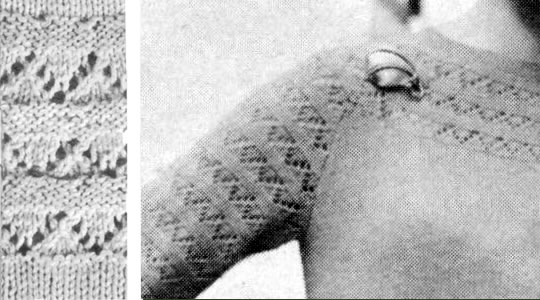
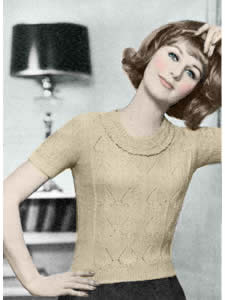
Well we certainly have a cooler trend for summer here in the UK, so this early sixties short sleeved light woollen top might be just the right thing. For myself, I prefer either sleeveless or three-quarter sleeves, (which might prove a relatively simple adaptation), but I think the collar is a very pretty and original design.
"...designs for the warm spells use fine wools and feminine touches for trimming..."
Note: I have not knitted this pattern, so if you have a problem with it, then please let me know so I can try and help.
InstructionsInstructions are for 2 sizes with the larger size given in brackets, (bold blue); where one set of figures is given this applies to both sizes. Front** Change to No 10 (3¼mm) needles and pattern as follows: 1st row (right side facing): P21
(25) *
k2, p7, p2tog, m1k, k1, m1k, p2tog, p7; repeat from *
to last 23 (27) sts; k2, p21 (25). These 30 rows form the pattern. Continue straight in pattern until 3 patterns and 20 rows have been completed. With right side facing, continue in pattern and
shape armholes by casting off 5 sts at beg, of next 2 rows,
then decrease 1 stitch. at each end of the next and every following alternate
row until 100 (104) sts remain. Work
one more row in pattern. With right side facing, shape neck as follows:- Next row: pattern 43 (45),
turn and leave remaining stitches on a spare needle. With right side facing, shape shoulder by casting off 9 (10) sts at the beginning of the next and following alternate row, then 10 (10) sts at the beginning of the following alternate row. With right side facing, rejoin wool to remaining stitches, cast off centre 14 sts, pattern to end. Finish to correspond with first shoulder. BACK SLEEVES BackWork as for front from ** to**
; [100 (104)] sts SleevesWith No 12 needles, cast on 80 (80) sts and work 1¼ inches in k1/p1 rib, increasing 4 sts evenly across on last row. [84(84) sts] Change to No 10 needles and pattern arranging stitches as follows: 1st row (right side facing): p20,
[k2, p7, p2tog, m1k, k1, m1k, p2tog, P7] twice, k2, P20. Continue thus keeping continuity of lace pattern until 20 rows have been completed. With right side facing, continue in pattern and shape top by casting
off 3 sts at the beginning of the next 2 rows, then decrease 1 stitch
at each end of the next and every following alternate row until 38 sts
remain. Work one row. Neck FrillWith No 12 needles, cast on 16 sts. 1st row (right side facing): k5,
p6, k5. Repeat rows 5-28 inclusive 16 times more, then rows 5-20 once. Cast off. With No. 12 needles, cast on 5 sts and work 23 ins. k1, p1 rib, rows on right side having a k1 at each end. Cast off. To Make UpPress work very lightly under a damp cloth.. Join neck frill neatly; pin into position all round neck so that garter- stitch in the centre of the border and the frill overlap on to main work. Catch down neck edge just below top frill on wrong side, then catch down other edge to main work at garter-stitch border at back of lower frill, (so stitching is hidden by the frill). Thread ribbed strip through slots in neck border and join neatly. 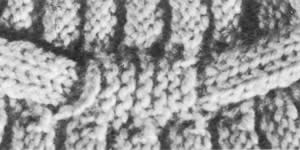 Press all seams. |
MaterialsOriginal materials called for: 8 (9) ozs
Patons Nylox Knitting 4-ply in "Palamino" A pair each Nos 12 and 10 (2¾mm and 3¼) needles. Tension28 sts and 36 rows to 4 inches over stocking-stitch on No 10 needles. Size mattersOriginal sized for bust 34-35 (36-37)
inches; length from top of shoulders: 20½ (21½)
inches; sleeve seam: 3½ (3½)
inches. Abbreviationsm1p: pick up loop lying before next stitch and purl into back of it. m1k: pick up loop lying before next stitch and knit into back of it. psso: pass the slipped stitch over. k2tog or p2tog: knit or purl 2 sts together (decrease one stitch). A word on the wool.Patons Nylox was designed as a sock wool with 25% nylon as the name implies.
It was quickly appropriated for children's items as it was hard wearing
and fine weight. By the 1960s, nylon was the material of choice, producing
almost indestructable knitwear in brilliant non-fade colours - so this
versatile nylon-rich wool was an ideal choice for lighter-weight summer
clothes. Any standard 4ply yarn is suitable, and currently there are a lot of them about in a good range of colours for grown-ups, such as Debbie Bliss Rialto 4ply, Rowan Pure Wool 4ply, and Susan Crawford's Excelana 4ply aimed at vintage knitters. Disclaimer
|
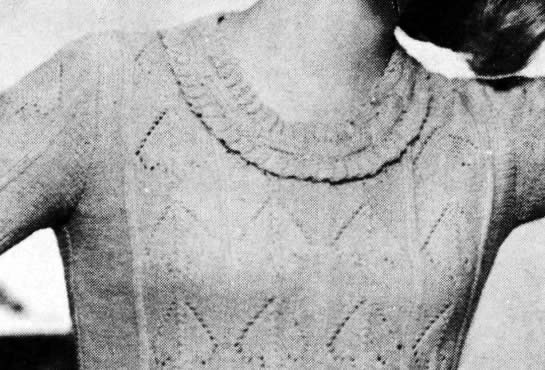

This is so very easy to knit and looks so cute over a (Liberty?) cotton baby frock. No idea how practical it is to keep in place, but it has secure back fastening straps and is perfect as a gift or for that special summer baby occasion.
InstructionsThe shawlette is worked in garter stitch (every row knitted) throughout. You start your knitting at the bottom of the back and work up towards the neck, where you divide and complete each front section separately. It is designed to cross over at the front, and button into place at the back. Using No 12 needles, cast on 50 sts and work in garter stitch for ½ inch (approximately 8-9 rows). Next row(make eyelets): K6; **
wrn, k2tog; repeat from ** to last
6 sts; k6. Start to shape the back as follows: 1st row: K6, wrn; knit to last 6 sts; wrn, k6. Repeat these two rows, (increasing 2 sts on each alternate row), until there are 115 sts. Your work then measures approximately 5¾ inches from the beginning. Now start to shape the right front, working each side of the neck separately. Next row: K6, wrn, k40, turn. Working only on these 47sts: 1st row: Knit. Repeat these two rows, (decreasing 1 stitch on each alternate row), until 15 sts remain. Next row: K6, wrn, k3tog, k6 Repeat the last 2 rows until 6 sts remain (your last decrease row will be "k2tog, k5"). Work strap, buy continuing to knit on these 6sts for 2¼ inches. Next row (make buttonhole): K2, cast
off 2, knit 2. Now pick up the sts left on the spare needle and join yarn to neck edge where you left off. Cast off 23 sts then, start to shape the left front, by knitting to the last 6sts, wrn, k6 [47 sts]. Working only on these 47sts: 1st row: Knit. Repeat these two rows, (decreasing 1 stitch on each alternate row), until 15 sts remain. Next row: K6, s2,k1,pass 2 slipped
sts over; wrn, k6 Repeat the last 2 rows until 6 sts remain (your last decrease row will be "k5, s1,k1,psso"). Work strap, buy continuing to knit on these 6sts for 2¼ inches, and finishing with a buttonhole as for the right front. To Make UpDo not block or press. |
Materials
|
Here's a view showing you the back.


It may seem unseasonal to feature thick woolley socks in May but it's been the wettest April for many decades apparently, so it seemed appropriate.
This is a useful pattern for a couple of reasons. One is that it's knitted in Aran weight yarn - though you need several balls so not exactly good for using up scraps; the other is that they are perfect socks for Wellingtons (see the photo - try not to be frightened by the model's excessive yet manly body hair!).
They should be hard wearing as they are knitted to a firm tension, and I have knitted a couple of highly successful pairs in the past (now given away as gifts, so not illustrated).
Instructions.Cast on 60 sts, 20 on each of three needles. Next round: *
p3, k1, p1; repeat from * to end of
round. Shape ankle1st round: Pattern 10, p2tog; pattern
8, p2tog; pattern to end of round. [58 sts] Next round: Pattern 5, p2tog; pattern
16, p2tog; pattern to end of round. [56 sts] Slip the first 28 stitches on the first needle for the heel, and continue to work with these for the heel. Divide remaining stitches on two needles and leave for instep. Shape heel 1st row: k27, turn. Continue thus, working one stitch less on every row until the row ‘p10, turn’ has been worked. Next row: k10; pick up the loop which
lies immediately below the next stitch and knit it together with the next
stitch, turn. Continue thus working one stitch more on every row until all the stitches are worked onto one needle again. [28 sts] Next row: k14, thus completing heel. Slip the instep stitches back onto one needle again, so you have the
stitches distributed over the 3 needles 14/28/14, and you are ready to
start he next round. Shape toe 1st round (1st needle): knit to
the last 3 sts; k2tog, k1. Making upGraft or cast off the stitches from two needles together. |
Materials7 x 50g balls Aran weight yarn. One set of four No 9 (3¾mm) needles, pointed at both ends. Tension21sts x 29 rows to 4ins over stocking stitches. Size mattersLength of foot: 11 inches (adjustable). Abbreviationsk2tog: work 2 sts together to decrease. k2tog tbl: knit 2 together through back loops (also known as "ssk"; or slip1, knit1, pass the slipped stitch over). A Word
|
|
|
|

This type of bonnet was very popular in the 1950s - at least it was much favoured by Paton and Baldwin, using their Fuzzy Wuzzy angora**. I think, following the 1940s roll, it went with the more modern shorter hairstyles, and was possibly the half-way house to what was essentially the demise of the hat for everyday wear. Anyway - I am sure they explored every possible variation on this basic style.
**Perhaps not the best marketing brand for today's knitters.... However, angora wool is very light weight and was sold in half ounce balls; this gives you the clue that it was relatively expensive, so a tiny little cap - or perhaps bolero - was ideally affordable. (And did I mention fluffy? even I - never allergic to anything - am prone to fits of sneezing when wearing angora).
Note that there are two versions of the bonnet for different yarn weights.
Instructions for the double knitting bonnetPattern stitch is worked over 6 rows: 1st row (right side facing): *
p3, k3, p3; leave wool forward (wfd), k2tog; repeat from *
to last 9 sts; p3, k3, p3. [Editor's note: The above pattern repeat of 6 rows is as given in the original instructions. If you compare the photo below with my version, you will see the eyelet arrangement is slightly different between the two. I worked (k2tog, wrn) and then (wrn, k2tog) alternately on the right side rows; this does not fit with the 6 row repeat of the mock cables. I have not written out my resulting 12 row repeat for you, but if you want to do this it is quite simple to keep track of the two patterns as you knit, one having a 4 row repeat, and the other, a 6 row repeat. Knit to the correct number of rows overall, and make sure you keep it consistent when you get to the decrease rows. ]

To Make:Cast on cast on 64sts using the knit cast-on method to give a loose edge.
Work 9 rows in stocking stitch (one row knit, one row purl), ending with
a knit row. Now make the hem for the hair-band casing as follows: Hem row (purl side facing, which is the
right side of the work): Fold the hem so that the cast on edge
is aligned at the back of the needle containing your working sts; *
knit one stitch on the needle with one loop from the cast on edge; repeat
from * to end. Now commence the pattern - work the 6 pattern rows five times. Start the shaping: 31st row (first shaping row): p3,
k3, p3; * leave wfd, k2tog, p2tog,
p1, k3, p1, p2tog; repeat from * to
last 11sts; leave wfd, k2tog, p3, k3, p3. [56sts] 37th row (second shaping row): p3,
k3, p3; * leave wfd, k2tog, p2tog,
k3, p2tog; repeat from * to last 11sts;
leave wfd, k2tog, p3, k3, p3. [48sts] 43rd row (third shaping row): p3,
k3, p3; * leave wfd, k3tog, k2, sl1,
k1, psso; repeat from * to last 11sts;
leave wfd, k2tog, p3, k3, p3. [40sts] Next row: Cast off 9sts; knit to
the last 9sts; cast off 9 and fasten off. To CompletePin out and press the work lightly on the wrong side with a warm iron
over a damp cloth. With the right side of the bonnet facing you, join the wool to one side
edge, at the inner edge of the hem (ie do not crochet the ends of the
hem together, as you need to thread your plastic hair band into it), and
work one row of double crochet all around the neck edge, finishing atthe
same position on the opposite side of the front. Draw the edge in slightly
as you work. Slip the hair band through the front casing, and then seam the short ends to close it off. Sew in and neaten all ends. |
MaterialsOriginal materials called for: 2 ozs double knitting wool. One pair of No 7 (4½mm) needles. One No 11 (3mm) crochet hook. 1½ yards elastic thread. A plastic hair band. Tension21 sts and 29 rows to 4 inches. Size mattersTo fit "an average head". Abbreviationsinc: increase by working into the front and back of the next stitch. dc: double crochet. A word on the wool.Original yarn Sirdar Majestic. I used Phildar Partner 6 in a lovely red shade, (50% nylon, 25% wool,
25% acrylic).
Disclaimer
|
Here is the same bonnet in a finer yarn. Normally, I would say finer yarns make a better result, (I know: "it depends"...). However, I actually prefer the double knit version of this style which seems better proportioned.

Instructions for the 3-ply bonnetPattern stitch is worked over 6 rows: 1st row (right side facing): *
p5, k3, p5; leave wool forward (wfd), k2tog; repeat from *
to last 13sts; p5, k3, p5. To Make:Cast on cast on 103sts using the knit cast-on method to give a loose
edge. Work 11 rows in stocking stitch (one row knit, one row purl), ending
with a knit row. Now make the hem for the hair-band casing as follows: Hem row (purl side facing, which is the
right side of the work): Fold the hem so that the cast on edge
is aligned at the back of the needle containing your working sts; *
knit one stitch on the needle with one loop from the cast on edge; repeat
from * to end. Now commence the pattern - work the 6 pattern rows eight times. Start the shaping: 49th row (first shaping row): p5,
k3, p5; * leave wfd, k2tog, p2tog,
p3, k3, p3, p2tog; repeat from * to
last 15sts; leave wfd, k2tog, p5, k3, p5. [93sts] 55th row (second shaping row): p5,
k3, p5; * leave wfd, k2tog, p2tog,
p2, k3, p2, p2tog; repeat from * to
last 15sts; leave wfd, k2tog, p5, k3, p5. [83sts] 61st row (third shaping row): p5,
k3, p5; * leave wfd, k2tog, p2tog,
p1, k3, p1, p2tog; repeat from * to
last 15sts; leave wfd, k2tog, p5, k3, p5. [73sts] 67th row (fourth shaping row): p5,
k3, p5; * leave wfd, k2tog, p2tog,
k3, p2tog; repeat from * to last 15sts;
leave wfd, k2tog, p5, k3, p5. [63sts] 73rd row (fifth shaping row): p5,
k3, p5; * leave wfd, k2tog, k1, k3tog,
k1; repeat from * to last 15sts; leave
wfd, k2tog, p5, k3, p5. [53sts] Next row: Cast off 13sts; knit to
the last 13sts; cast off 13 and fasten off. To CompletePress and complete as for the double knitting version of the bonnet. |
MaterialsOriginal materials called for: 1oz of 3-ply fingering wool. One pair of No 11 (3mm) needles. 1½ yards elastic thread. A plastic hair band. Tension30 sts and 44 rows to 4 inches. Size mattersTo fit "an average head". Abbreviationsinc: increase by working into the front and back of the next stitch. dc: double crochet. A word on the wool.Original yarn Sirdar Majestic. Disclaimer
|
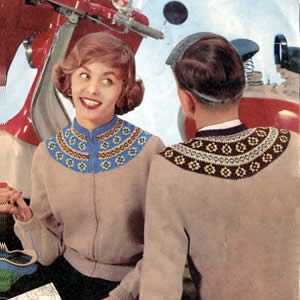
This pair of cool cats are really going places. (You can tell - they've got a map and goggles and a scooter and .... everything.
The jackets are plain stitch with a fair-isle yoke, and as the title suggests, a zip closure at the front. Sizes are not very large as the pattern seems to be intended to appeal to the youth of the day. (Small hope I fear).
"Gay Patterning for him and her in to-days fashion" [sic]
InstructionsBack and fronts are worked separately then joined to work the yoke. A simple pattern around the yoke is worked from the charts. The sleeves are set-in, not raglan. Back:Using No 13 (2¼mm) needles and main shade, cast on 124 {136}sts Next row: Rib 6 {5}, * inc. in next st, rib 10 {8}; repeat from * 10 {14} times; inc. in next st, rib to end. [135 {151}sts] Change to No 11 (3mm) needles and proceed in stocking stitch until work measures 12½ {13¾} ins from the beginning. Shape armholes by casting off 9 {12} sts at the beginning of the next 2 rows. Decrease 1 st at both ends of the next and every alternate row until 103 {113} sts remain. Work 10 {16} rows. Shape Back Yoke as follows: Next row: Work across 46 {49} sts, cast off 11{15}; work to end. Continue on this group of 46 {49}
sts as follows: Continue on these sts. until work measures 7½ {8¾} ins from beginning of armhole shaping. Cast off. Rejoin wool to remaining group of sts, and complete to match the other side. Right Front:Using No 13 (2¼mm) needles and main shade, cast on 64 {70}sts Next row: Rib 8 {5}, * inc. in next st, rib 11 {9}; repeat from * 4 {6} times; increase in the next st, rib to end. [69 {77}sts] Change to No 11 (3mm) needles and proceed in stocking stitch until work measures the same as the back up to the armhole, finishing at the side edge (at the end of a knit row). Shape armholes by casting off 9 {12} sts at the beginning of the next row. Decrease 1 st at the armhole edge of the next and every alternate row until 53 {58} sts remain. Continue straight on these sts until work measures 2 {2½}
ins from beginning of armhole shaping, finishing at the front edge (after
a purl row). Shape Back Yoke by casting off 7 {9}
sts at the beginning of the next row. Cast off 4 sts at the beginning
of every alternate row at the neck (front) edge until 38 {41}
sts remain; then cast off 3 sts on every alternate row until 20 {23}
sts remain. Continue on these sts until work measures the same as the back up to the cast off. Cast off. Left Front:Work to match Right Front reversing all shapings. Sleeves: Using No 13 (2¼mm) needles and main shade, cast on 64 {68}sts Next row: Rib 5 {6}, * inc. in next st, rib 5 {4}; repeat from * 9 {11} times; increase in the next st, rib to end. [74 {80} sts] Change to No 11 (3mm) needles and proceed in stocking stitch increasing 1 st at both ends of the next and every following 8th row until there are 104 {114} sts. Work straight until sleeve measures 18 {18½} ins from the beginning. Shape top by casting off 3 sts at the beginning of the next row
6 rows, and then 2 sts at the beginning of the next row 8 rows. Decrease
1 st at both ends of every row until 50 {60}
sts remain; then decrease 1 st at both ends of every following 3rd row
until 26 {36} sts remain. Cast off 4 {6} sts sts at the beginning
of the next row 4 rows. Front Bands (work 2):Using No 13 (2¼mm) needles and main shade, cast on 5 sts. 1st row: K2, p1, k2 Rep. these 2 rows until work measures 14½ {16½}
ins from the beginning (when slightly stretched). Change to main contrast,
Royal Blue {Brown} and continue in
rib until Band measures 19 {21} ins,
from the beginning (when slightly stretched), finishing at the end of
a 2nd row. Slip thesse sts on to safety-pin and leave. Yoke:Join back to fronts at the (tiny) shoulder seams. With right side of work facing, using No 13 (2¼mm) needles and main shade, knit up 289 {369} sts around the yoke, then turn and purl one row. Work the 1st to 13th rows from Chart A.   From here ensure you work the decrease rows according to the size you are knitting. 14th row: 15th row (both sizes): Using Brown (B) and Pale Yellow (Py), * k1B, k1Py, repeat from * to last stitch, k1B. Work the 16th to 23rd rows as rows 1 to 8 from Chart B. Left: her colourway. Right: his colourway.
24th row: 25th row (both sizes): Using Brown (B) and Pale Yellow (Py), * k1Py, k1B, repeat from * to last stitch, k1Py. Work 26th to 37th rows as the 2nd to 13th rows from Chart A. 38th row: 39th row (both sizes): Using Brown (B) and Pale Yellow (Py), * k1B, k1Py, repeat from * to last stitch, k1B. Work 40th to 47th rows as the 1st to 8th rows from Chart B. 48th row: 49th row (both sizes): Using Brown (B) and Pale Yellow (Py), * k1Py, k1B, repeat from * to last stitch, k1Py. 50th row (both sizes): Using Royal
Blue {Brown}, Purl. Proceed for Neckband as follows: Using Royal Blue {Brown}, k2, p1, k1, p1 across these front band sts; knit across the Yoke sts; slip sts from top of 2nd Band on to empty needle, and p1, k1, p1, k1, k2 across these sts. [109 {115} sts] 1st row: *
K1, p1, repeat from * to last stitch,
k1. To Make UpOmitting the ribbing, with wrong side of work facing block each piece by pinning out round edges. Omitting ribbing, press each piece using a warm iron and damp cloth. Using a flat seam for the ribbing and a back-stitch seam for the remainder, join side and sleeve seams. Stitch Sleeves into position. Flat stitch Front Bands into position. Fold Neckband at centre and stitch down on wrong side of work. Stitch zip into position. Press seams. |
Materials
|
Her colourway - detail:
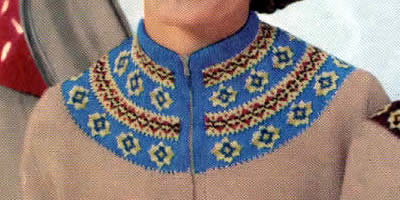
His colourway - detail:
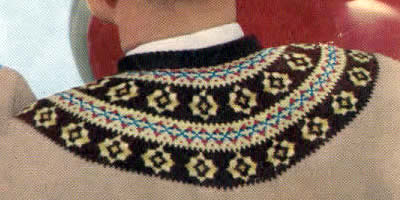
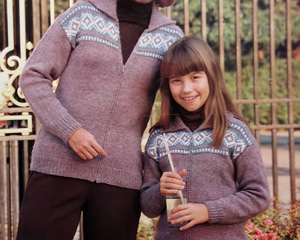
Another take on the zipped jacket from a later era. This design is easier than the Norwegian-style jacket in its construction, and uses a heavier (double knitting) weight yarn, which makes for a quicker knit. The patterning is simpler too - knitted straight, that is, without having to worry about incorporating increases and decreases into the design as you knit.
InstructionsInstructions are given for seven sizes - larger sizes indicated in brackets. Back:Using No 9 (3¾mm) needles and main shade A, cast on 73 [79
: 85 : 89 : 95 : 99 : 105] sts and work 14[14
: 14 : 18 : 18 : 18 : 18] rows in k1, p1 rib. ** Proceed as follows:  Break off yarn C, join in A. Next row: Using yarn A k1.
purl to last st, k1. Proceed as follows: Cont in stocking stitch until work measures 16½ [18½ : 20½ : 23 : 23 : 23 : 23] ins, ending on a wrong side. Shape Shoulders: Left Front:Using No 9 (3¾mm) needles and main shade A, cast on 36 [40 : 42 : 44 : 48 : 50 : 52] sts. 1st row: S1, k1, *
p1, k1, repeat from * to last 2 sts,
k2. repeat 1st and 2nd rows 6 [6 : 6 : 8 : 8 : 8 : 8] times increasing once at the end of the last row for sizes 26, 30, 32, and 38ins only. 37 [40 : 43 : 45 : 48 : 50 : 53] sts. Change to No 7 (4½mm) needles and and proceed as follows:- Keeping continuity of stocking stitch and garter stitch border throughout,
continue until work measures 11½ [13½ : 15½
: 17½ : 17½ : 17½ : 17½] ins,
(the same number of rows up to the same point on the Back must be worked
at this point), ending on right side, increasing once at the begining
of the last row for sizes 28, 34, and 36 ins only. 37 [41 : 43
: 45 : 49 : 51 : 53] sts. Break off main shade yarn A, and join in first contrast B. 5th row: For all 7 sizes Keeping the two front edge sts in garter stitch, and joining in and breaking off colours as required, work 1st to 13th row from Chart B, working size required as indicated. The odd numbered rows are knit, the even numbered rows are purl. 
1st row: Using yarn A k2, purl to last stitch, k1. 2nd row: For all 7 sizes: Break off yarn A. Shape Neck 5th row: Shape Shoulder: Cast off remaining 9 [10 : 11 : 11 : 12 : 13 : 14] sts. Right Front:Using No 9 (3¾mm) needles and main shade A, cast on 36 [40 : 42 : 44 : 48 : 50 : 52] sts. 1st row: S1, k2, *
p1, k1, repeat from * to last st,
k1. repeat 1st and 2nd rows 6 [6 : 6 : 8 : 8 : 8 : 8] times increasing once at the beginning of the last row for sizes 26, 30, 32, and 38ins only. 37 [40 : 43 : 45 : 48 : 50 : 53] sts. Change to No 7 (4½mm) needles and and proceed as follows:- Keeping continuity of garter stitch border and stocking stitch throughout,
continue until work measures 11½ [13½ : 15½
: 17½ : 17½ : 17½ : 17½] ins,
(the same number of rows up to the same point on the Back must be worked
at this point), ending on right side, increasing once at the end of the
last row for sizes 28, 34, and 36 ins only. 37 [41 : 43 : 45
: 49 : 51 : 53] sts. Break off main shade yarn A, and join in first contrast B. 5th row: For all 7 sizes Keeping the two front edge stitches in garter stitch, joining in and
breaking off colours as required, work 1st to 13th rows from Chart C,
working size required as indicated. 
Next row: Using yarn A k1, purl to last 2 sts, k2. Shape Neck Next row: 1st row: Using yarn B, knit
to end. 5th row: Shape Shoulder: Cast off remaining 9 [10 : 11 : 11 : 12 : 13 : 14] sts purlwise. Sleeves (both alike): Using No 9 (3¾mm) needles, and main shade A, cast on 41 [41
: 41 : 43 : 43 : 43 : 43] sts, and work 16 [16 :
16 : 20 : 20 : 20 : 20] rows in k1, p1 rib. Shape Neck The Collar:Using No 7 (4½mm) needles and yam A cast on 26 [26 : 25 : 29 : 29 : 29 : 29] sts. 1st row: S1, k1, *
p1, k1, repeat from * to
the last stitch, k1 To Make UpOmitting ribbing, press each piece lightly using a warm iron and damp cloth. Sew up shoulder and sleeve seams. Sew up side seams leaving 6 [6
: 6½ : 7½ : 7½ : 8 : 8] ins free to form
the armholes. Press seams. |
Materials
|
 |
|
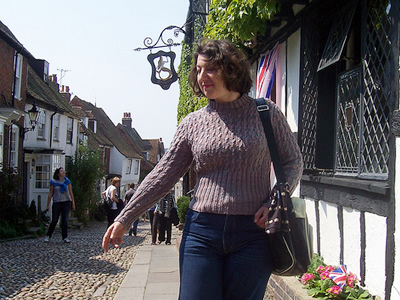
Sara, playing her part again as the ultimate 1950's sweater-girl. Unlike the original model (I'm guessing) Sara knitted this elegant creation herself. It's another shapely close-fitting design and has a deep twisted-rib welt which extends flatteringly high over the waist before the cable pattern begins.
InstructionsInstructions for medium size in round brackets thus ().
Large size in square brackets thus []. Where
one set of figures is given, this applies to all sizes. Front:Using No 11 needles, cast on 84 (88)
[96] sts and work 6 inches k2, p2 rib. Change
to No 10 needles and work a further 2 inches in rib, increasing (6)
[8] sts. evenly across on last row of medium
and large sizes only. {84 (94) [104]
sts} 1st row (right side facing): * k4, p2; then "twist 2" by knitting into front of 2nd stitch on left needle, and then into front of 1st stitch and slipping both sts off needle together; p2; repeat from * to last 4 sts, k4. 2nd row: *
p 4, k2, p2, k2; repeat from * to
last 4 sts; p4. These 10 rows form the pattern. Continue in pattern, shaping sides by increasing 1stitch at each end of the next and every following 4th row until there are 96 (106) [116] sts, and incorporating the increased sts into the pattern as you go. Work straight until front measures 13½ (14) [14] inches at centre. With right side facing, shape armholes by casting off 6 (6) [6] sts at beginning of the next 2 rows, then k2tog at each end of the next and every following alternate row until 76 (82) [90] sts remain. Workstraight until front measures 18½ (19) [19½] inches at centre. With right side facing, divide for neck: Next row: Pattern 29 (32) [34], k2tog; turn and leave remaining sts on a spare needle. Continue on first 30 (33) [35] sts, decreasing 1 stitch at neck edge on alternate rows until 24 (27) [27] sts remain. Work straight until front measures 21 (21½) [22] inches at centre. With right side facing, shape shoulder by casting off 8 (9)
[9] sts at the beginning of the next and
following 2 alternate rows, (this is the armhole edge). Fasten off. Then return to the remaining sts on the spare needle, and slip the centre
14 (14) [18]
sts on to a spare needle or stitch holder; rejoin the wool to the last
31 (34) [36]
sts at the neck edge (right side facing), k2tog, pattern to end. Back:Work exactly as for front until armhole shapings have been completed:
76 (82) [90]
sts Work straight in pattern over all sts until back measures
same as front up to the shoulder. Sleeves:Using No 11 needles, cast on 52 (52)
[56] sts and work 4 inches in k2/p2 rib.
Change to No 10 needles and continue in rib until 8 inches have been worked
from the start, increasing 2 (2) [8]
sts. evenly across on the last row: 54 (54)
[64] sts taking increased sts into the pattern
as you go. Cast off. Neckband:Join right shoulder seam. With right side facing and No 10 needles, pick up and k. 92 (92) [96] sts all round neck, including those on spare needle at front and back. Work 1 inch k2/p2 rib; change to No 11 needles and work a further inch in rib. Cast off loosely in rib. To Make UpPress parts on wrong side under a damp cloth, taking care not to spoil the pattern. Join side, left shoulder and sleeve seams; insert sleeves. Press seams. |
Materials
|
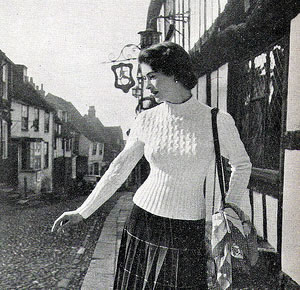

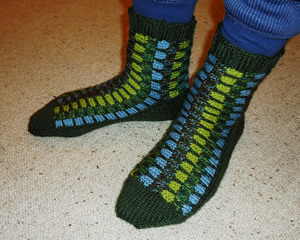
Father George: so fond of his bedsocks that they get worn out. [Since he is not bedridden I can only surmise he does not restrict their use to the bedroom!] Hence - by request - here are some more.
The patterned section of the sock is knitted sideways using a variation of a honeycomb stitch; it's an opportunity to use up really small amounts of double knitting yarn. I rotated 4 contrast colours but you could use a different colour for every set of rows; the key is to keep some consistency in the main colour.
Instructions.The first section of these socks is knitted sideways making a "T"
shape where the upright of the "T" is the upper foot, and the
cross bar curls around the leg to form the cuff, meeting at the back seam. First section (knit 2)Starting at the back leg seam, with main shade (M) cast on 23 sts on 2 needles and knit one row. Commence pattern. Join in contrasts (C1, C2 etc): Repeat rows 1-10 using different contrasts, once more. Next row(wrong side facing): Cast
on 40 sts, and then work across them and all sts, as for 1st row of pattern. [63sts] Continue to work the pattern on these 63 sts, working rows 1-10 three
times, and then rows 1-4. Next row(wrong side facing): Using main shade, cast off 40 sts, and purl across remainder. [23sts] Continue to work the pattern on these 23 sts, working rows 6-10, then
rows 1-10 once, times, and then rows 1-4. Second section (heel and sole).The remainder of the socks are worked entirely in the main shade. For the heel: with right side of the first section facing, oriented like an upside down "T" pick up 11 sts from each side of the instep:
Pick up and knit 11 sts from the left side first, ending at the cast on edge (which will be the centre back, and then turn the work over and bend round the second side, and pick up 11sts from the right side. The sock cuff now forms a circle with the back seams together, but not yet sewn.
Turn and purl 1 row across these 22 sts. Next row(right side facing): *
Sl1, k1, repeat from * to end. Repeat the last 2 rows 10 times more. Turn the heel: Next row: Sl1, k12, k2tog, k1. Turn. Continue to work short rows and decrease in this way until all sts have been incorporated. [14sts]. Next row(right side facing): Sl1,
k13, pick up and knit 13 sts down side of heel. Turn. Now work the instep decreases and sole: Next row: K1, sl1, k1, psso; knit
to last 3 sts, k2tog k1. Turn. Repeat the last 2 rows until 22 sts remain. Continue to work a further 50 rows to make the sole - upper and lower
foot sections should be about the same length. ToeNow we move to working in the round. Knit 11 sts on first double-pointed needle, 11sts on second, then with
right side facing, using third needle, pick up and knit 24 sts across
the toe edge of the first section. Next round: K1, sl1, k1, psso; knit to last 3 sts on third needle, k2tog k1. Complete the round by knitting the 11 sts on each of the first and second needles. [44 sts] Next round: K1, sl1, k1, psso; knit
to last 3 sts on third needle, k2tog k1; on first needle, k1, sl1, k1
psso; knit to end; on second needle, knit to last 3 sts, k2tog k1. Repeat the last 2 rounds until 16sts remain. Making upSew seams on each side of the sole, using a flat seam technique (not mattress stitch for example). Using double pointed needles and main shade, pick up 60-66 sts round top of sock and knit a k3/p3 rib for about 8 rows (or as long as you want), to form the welt. Cast off loosely. Sew in all ends. |
Materials2 x 50g balls of double knitting yarn, and a variety of left over DK colours. One pair and one set of four No 8 (4mm) needles, pointed at both ends. Tension22 stitches = 4ins Size mattersLength of foot, 9 inches (adjustable). AbbreviationsM is main shade (olive). sl1: slip the next stitch k2tog or p2tog: work 2 sts together to decrease. psso: pass the slipped stitch over, (also known as "ssk"; effectively you are "knitting 2 together through back loops") A Word
|
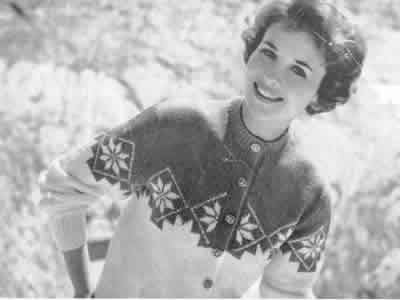
The third (and final) fair-isle design for November is a 1950s or early 60s cardigan in a double knitting weight yarn. No clues as to the original colour scheme here, and although for today it would seem appropriate to go with the grey palette, I am sure the original would have been more colourful.
InstructionsThe Back and Fronts are worked in one piece up to the armhole shaping. Back and Fronts:Using No. 10 (3¼mm) needles and light colour, cast on 146 sts. Change to No 7 (4½mm) needles and proceed as follows: 1st row: Knit Continue increasing in this manner on next and every following 4th row
until there are 183 sts. Next row: P7, (increase in next stitch p12) 13 times, increase in next stitch, purlto end. [197 sts] Work rows 1 to 16 from Chart (odd rows knit, even rows purl), working
bracketed repeat 7 times across row and odd stitch at end of 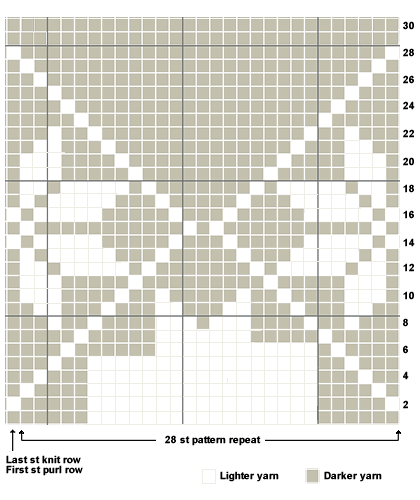 Divide for Back and Fronts:Next row (17th row of chart): Pattern
44 cast, off 10, pattern 88 (there now being 89 sts. on needle after cast-off);
cast off 10, pattern to end.
Proceed on first group of 44 sts. for first front as follows: Keeping pattern correct by working rows 18 to 30 inclusive of Chart,
shape armhole by decreasing 1 st. at armhole edge on next and every
alternate row until 39 sts. remain. Using darker colour for remainder of front, continue in stocking stitch until work measures 5 ins, from beginning of armhole shaping, finishing at front edge. Shape neck: by casting off 4 sts. at beg. of next row. Shape shoulder: by casting off 10 sts. at beg. of next and every alt, row until all sts. are cast off. Rejoin wool to next group of 89 sts. and proceed for Back as follows: Keeping pattern correct from Chart, shape armholes by decreasing 1 st
at both ends of next and every alternate row until 81sts remain. Continue
on these sts. until work matches first front up to shoulder shaping. Rejoin wool to remaining group of 44 sts. and complete to match first
front reversing all shapings. Sleeves:Using No. 10 needles and Light, cast on 50 sts. Change to No. 7 needles and proceed in stocking stitch, increasing 1
st. at both ends of 5th and every following 9th row until there are 73
sts. Next row: P3; (increase in the next stitch, p5) 11times; increase in the next stitch; purl to end. [85 sts] Work rows 1 to 16 inclusive from the chart, noting that bracketed repeat is worked 3 times across row, and odd st. at end of knit row and beginning of purl row as marked on chart throughout. Keeping pattern correct from chart until 30th row of chart has been completed,
and working remainder of sleeve in dark colour, shape top by casting off
4 sts at the beginning of the next 4 rows, 3 sts at the beginning of the
next 4 rows, and then 2 sts at the beginning of the next 4 rows. Right Front Band:Using No. 10 needles and light colour, cast on 11 stitches. 1st row: K2; (p1, k1) 4 times; k1. Left Front Band:Omitting buttonholes, work to match Right Front Band. Neckband:Using a back-stitch seam join shoulders of Back and Fronts. Next row: *
k1, p1, rep from * to last stitch,
k1. Work 3 more rows in rib. To Make UpOmitting k1/p1 rib, with wrong side of work facing, block each piece
by pinning out round edges. "In order to preserve the lovely crepe appearance of Totem fabrics, these must be pressed very lightly as over-pressing will spoil the appearance of the finished fabric." Using a flat seam for k1/p1 rib, and a back-stitch seam for remainder,
join sleeve seams and stitch sleeves into position. Flat stitch front
bands into position. |
Materials
|
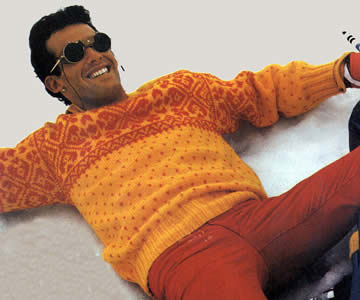
The second nordic-style sweater for November in a slightly lighter weight yarn. Like the previous design it has a straight inset sleeve, as well as the bright ("modern") colour combination of the 1980s. The pattern includes instructions for plain leg warmers.
InstructionsThis pattern uses 3 familiar stitch types: Double Rib: repeated sequence of k2, p2 rib. Back:Using No 9 (3¾mm) needles and main shade (O), cast on 86 /
90 / 94 sts work 3½ inches
in double rib. Change to No 7 (4½mm), needles and stocking stitch,
increasing 15 sts evenly across first row [101/ 105/
109 sts]. Continue joining in contrast (R)
for dotted fair-isle stocking stitch pattern as per the lower section
of chart. When the fair-isle motif is complete, change back to No 7 needles and continue in dotted fair-isle until work measures 27½ / 28 / 28½ inches. Shape shoulders: Then cast off 8 sts, (all sizes), knit 6 / 7
/ 8 (7/8/9
sts on right hand needle), and turn leaving the remaining sts unworked
but still on the needle to pick up in a moment, . Return to the sts still on the needle for the neck and left side. Place the centre 43 sts on a stitch holder for the back neck, and then rejoin yarn to the remaining sts and knit 1 row. Then cast off 8 sts, (all sizes) purlwise, purl 6 /
7 / 8 (7/8/9
sts on right hand needle), and turn, knit back 1 row. Front:Using No 9 (3¾mm) needles and main shade (O), cast on 90 /
94 / 98 sts work 3½ inches
in double rib. Change to No 7 (4½mm), needles and continue in dotted
fair-isle stocking stitch pattern as for the back, increasing 15 sts evenly
across first row [105/ 109 / 113
sts]. When work measures 18 inches (same as back to armhole), shape the armholes
by casting off 8 / 9 / 10
sts at beg of next 2 rows [89 / 91
/ 93 sts]. When work measures 25½ / 26
/ 26½ inches, shape neck: When work measures 27½ / 28 / 28½ inches, work shoulder shaping as you did for the back, casting off at armhole edge on every alternate row as follows: 8 sts (twice), 7 / 8 / 9 sts (once). Sleeves:Using No 9 (3¾mm) needles and main shade (O), cast on 54 / 58 / 62 sts work 3½ inches in double rib. Change to No 7 (4½mm), needles and continue in dotted fair-isle, increasing 17 sts evenly across first row [71 / 75 / 79 sts]. Increase 1 st at each end of every 8th row 9 times, [89 / 93 / 97 sts]. When work measures approximately 11½ / 12½ / 13½ inches, . (11 change to No 6 needles and work the fair-isle motifs. Cast off when you have completed the second border pattern, before you start the dotted fair-isle. To Make UpPress parts lightly on wrong side with a damp cloth Stitch one shoulder seam. Using No 9 needles and main shade, pick up
and knit 98 / 102 /
106 sts evenly round neck. Work 1¼
inches in double rib. Stitch second shoulder seam and neck border seam. Sew in sleeves. Stitch side and sleeve seams. |
Materials
|
This is the main chart showing the fair-isle design described in the pattern. It leaves a lot to work out yourself, showing the centre point and allowing you to work our where to start your row for each of the sizes.
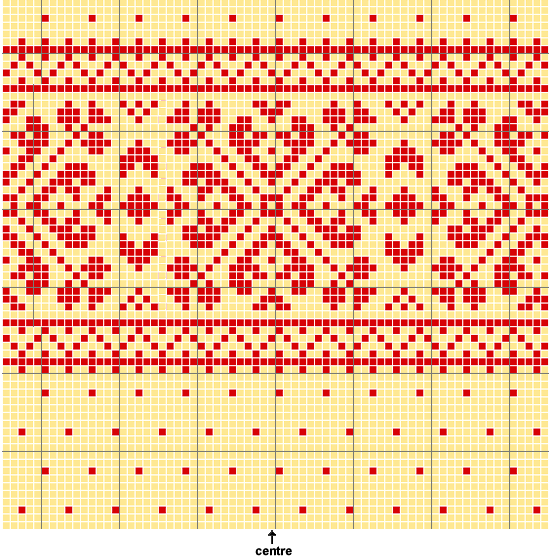
Working it out yourself is made more difficult since the main panel pattern
is a 34 stitch repeat, while the border above and below is a 6 stitch pattern repeat like the dotted body pattern.
You can match up your first border with the dots, and use the chart below to see where to start and end your main panel pattern.
Then match your second border spacing it the same as the first one.
This is the chart marked with start and end points for the back showing the 3 sizes, and the 34 stitch repeat. The front has 4 extra stitches up to the amhholes, so start 2 sts further out for the front.
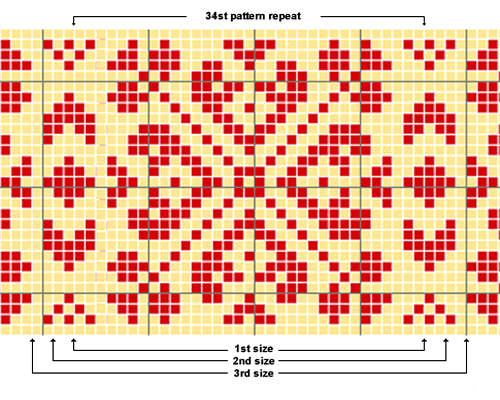
This is a similar chart for the sleeve marking with start and end points for the 3 sizes.
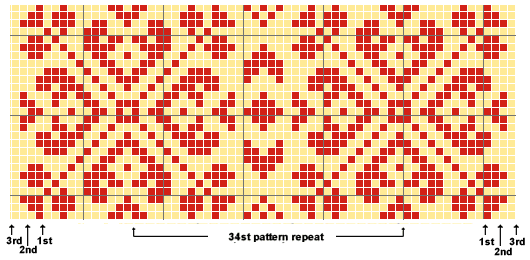
[Editor's note: I worked out and drew the charts myself, and made lots of trivial errors before I was satisfied that they were right. So if you are having difficulty with the charts, or if you think there may be a mistake, please do let me know.]
LegwarmersThe legwarmers are worked in rib throughout. InstructionsUsing No 11 (3mm) needles and main shade, cast on 62sts, and work in
double rib for 4¾ inches. Cast off loosely. [Editor's note: You are working from the ankle upwards; you cast on for the bottom of the item and cast off at the top, so it needs to be loose.] Stitch the seam using a flat seam technique. Work a second legwarmer in the same way. |
Materials
|
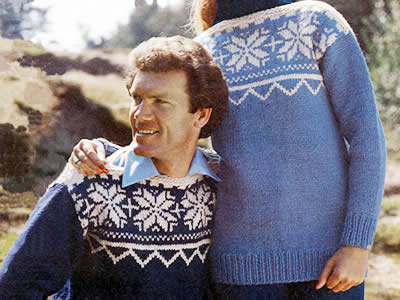
My title refers to the current season's fashion for nordic style sweaters - snowflake, as well as (astonishing to me) reindeer. This sweater's shape betrays its original design era, but that does make it simple to construct - and wear. Update to better reflect the current themes by choosing monochrome colour schemes, using black or greys with cream.
"Traditional motifs in cream make striking winter sweaters; simple easy styling, with straight necklines and drop shoulders, is easy to knit in thick soft yarn on big needles."
InstructionsT-shaped chunky sweater with simple snowflake pattern worked from the charts. Back and Front alike:With No 6 (5mm) needles and main shade, cast on 47 / 51 / 55 / 59 / 63 / 65 / 71 / 73 / 77 sts and work in K1/P1 rib for 2½ / 2½ / 2½ / 3 / 3 / 3 / 3½ / 3½ / 3½ inches, ending with wrong side facing for next row. Next row (wrong side): Rib 3 / 3 / 5 / 4 / 4 / 5 / 5 / 5 / 6; m1; * rib 8 / 9 / 9 / 10 / 11 / 11 / 12 / 9 / 13; m1; repeat from * to last 4 / 3 / 5 / 5 / 4 / 5 / 6 / 5 / 6 sts; rib to end. [53 / 57 / 61 / 65 / 69 / 71 / 77 / 81 / 83 sts]. Change to No 4 (6mm) needles and work in stocking stitch, starting with a knit row, until work measures 13½ / 14½ / 16 / 15 / 16 / 17 / 17½ / 18½ / 19½ inches, ending with a purl row. 1st to 3rd size: Join in contrast colour and work 2 rows. All sizes: 1st to 3rd size: Work rows 1 to 24 from chart A, repeating the 20 pattern sts 3 times across and working the first 0 / 2 / 4 sts and last 1 / 3 / 5 sts on knit rows and first 1 / 3 / 5 sts and last 0 / 2 / 4 sts on purl rows as indicated.  4th to 9th size: Work rows 1 to 36 from chart B, repeating the 20 pattern sts 3 / 3 / 4 / 4 / 4 / 4 times across and working first 6 / 8 / 0 / 3 / 5 / 7 sts and last 7 / 9 / 1 / 4 / 6 / 8 sts on knit rows and first 7 / 9 / 1 / 4 / 6 / 8 sts and last 6 / 8 / 0 / 3 / 5 / 7 sts on purl rows as indicated.  All sizes: Break main shade, and complete in contrast. Next 2 rows: Knit. Next row: K3 / 1 / 3 / 1 / 0 / 5 / 4 / 2 / 4, k2tog, * k2 / 2 / 2 / 2 / 3 / 2 / 2 / 2 / 2, k2tog; rep from * to last 4 / 2 / 4 / 2 / 0 / 6 / 5 / 3 / 6 sts, knit to end. [47 / 49 / 53 / 55 / 61 / 63 / 67 / 69 / 73 sts] Next row: Knit Cast off. Sleeves:With No 6 (5mm) needles and main shade cast on 25 / 27 / 27 / 29 / 29 / 31 / 31 / 33 / 33 sts and work in rib as on body sections for 2½ / 2½ / 2½ / 3 / 3 / 3 / 3½ / 3½ / 3½ ins, ending with right side facing for next row. Change to No 4 (6mm) needles and work in stocking stitch, starting with a knit row, shaping sides by inc 1 stitch at each end of 3rd / 3rd / next / 7th / next / 5th / 3rd / 9th / 5th and every following 4th / 5th / 5th / 5th / 5th / 5th / 4th / 4th / 4th row until there are 51 / 51 / 55 / 55 / 59 / 59 / 67 / 67 / 69 sts. Work straight until sleeve seam measures 14 / 15½ / 17 / 18½ / 19 / 19 / 19½ / 20 / 20 ins, ending with a purl row. Cast off. To Make UpOmitting garter stitch and ribbing, press parts lightly on wrong side with a damp cloth When making up a chunky garment it may be easier to use an oddment of
finer yarn in a toning shade for the sewing. Join shoulder seams leaving 7 / 7½ / 8 / 9 / 9½
/ 9½ / 10 / 10½ / 10½ ins open at centre
for neck opening. |
Materials
|
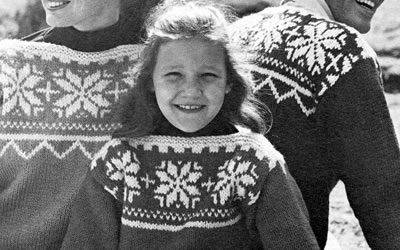
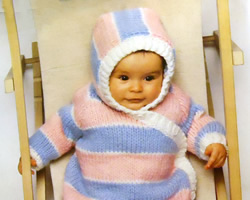
This is a vintage baby-bag pattern probably intended for babies up to 3 months in age. It's very simple to knit and fastened around the edge with easy poppers. It's tempting to knit this in beautiful, soft, lofty yarns - however, it does need to be washable, if not so very hard wearing.
OK - maybe not so many colours - but so cute!
InstructionsThe striped pattern is worked as follows: 1st row: Knit in main shade These 22 rows are repeated to form the striped pattern. BodyThe body is worked in one piece; you start off knitting short, shaped pieces for the back and front separately then join them both onto one needle. The pattern as written should work out that the stripes match up when you join them together - make sure they do - and you may want to use a circular needle for the 86 stitches in chunky yarn. Back: With No 4 (6mm) needles and second contrast (Pink), cast on 25 sts and
purl one row. 1st row(right side): Cast on 3, knit
to end. Change to white yarn for 1 row: Change to blue yarn for 9 rows: Change to white yarn for 1 row: Change to pink yarn and work in sts for 5 rows starting with a purl row. Front: With No 4 (6mm) needles and first contrast (Sky Blue), cast on 23 sts
and purl one row. 1st row(right side): Cast on 3, knit
to end. Change to white yarn for 1 row: Change to pink yarn: [Editor's note: You have ended with right side facing about to start your 6th row in pink yarn.] Right side facing, continuing in pink yarn, knit 41sts from front, and then 45 sts from back (stitches on holder). [86 sts] Continue straight until work measures 20 inches (51cm) - (measure the
back segment), ending with a wrong side row. Right side facing, tie coloured thread or place marker, between the 41st and 42nd sts and between the 84th and 85th sts. Next row (right side facing): Cast
off 4sts, work to end, and increase (cast on) 3 sts. [85sts] [Editor's note: You are now about to start the raglan shaping on the front, having completed 7 rows in colour blue with right side facing to begin 8th row in blue.] Next row(right side facing and keeping striped sequence correct): Cast off 3 sts, k 33 (34sts on needle). Turn, leaving remaining 48sts on a spare needle. 2nd row: Cast off 2 sts, purl to
end. [32sts] Change to white yarn for 1 row: Change to pink yarn for 10 rows: Change to white yarn for 1 row: Change to blue yarn for rest of front: The front should now measure 4¾ins (12cm) from beginning of raglan
shaping, and 2 sts remain. Back raglan shaping: With right side facing, take up 43sts of the back and leave the remaing
5 sts at the end of the row on a holder. Keeping striped sequence correct work as follows: cast off 2 sts at the
beginning of the next 6 rows, and one stitch at the beginning of the next
16 rows. With right side facing, take up the remaining 5 sts on the holder, and
keeping striped sequence correct work as follows: 1st row (right side facing): Cast
off 2 sts, knit to end. Change to white yarn for 1 row: Change to pink yarn for 10 rows: Change to blue yarn to complete: The work should now measure 4¾ins (12cm) from beginning of raglan
shaping, and 2 sts remain. Here's a photo of what it looks like (Figure 1):
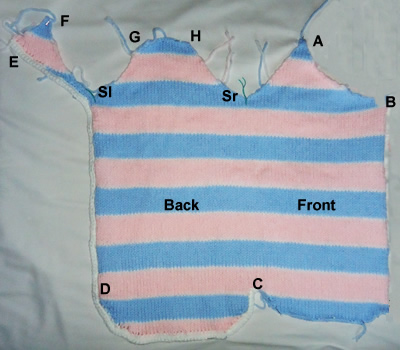
Sleeves:With No 6 (5mm) needles and main shade, cast on 26sts. and work 4 rows in k1/p1 rib, ending with a wrong side row. Change to No 4 (6mm) needles and striped stocking stitch starting with 1 row of main shade (White). Then work in blue as follows: 2nd - 10th row: Stocking stitch in
blue yarn 12th row: Purl one row in white. 13th - 20th row: Stocking stitch
in blue yarn 23rd row: Knit one row in white. Work 7 rows straight in blue. Work measures 7ins (18cm), ending with
right side facing to start raglan shaping. Shape raglan by casting off 3sts at the beginning of the next 2 rows, 1st at each end of every following 3rd row, twice, 6 sts remain. Cast off. HoodWith No 4 (6mm) needles and first contrast, cast on 17 sts and work in
striped pattern starting with 3 rows of the first contrast. Cast on 22sts at the beginning of the next right side row. [39 sts] Continue straight until work measures until work measures 11½ins (29cm), ending with wrong side row, and 2 rows of second contrast. Cast off 22sts at the beginning of the next right side row. [17 sts] Continue straight until work measures until work measures 18ins (46cm), ending with wrong side row, and 2 rows of first contrast. Cast off. Here's a photo showing how the hood looks (Figure 2):
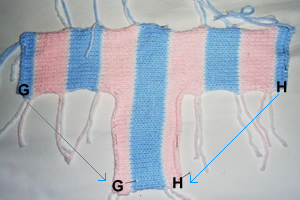
Front and Hood Band:With No 6 (5mm) needles and main shade, cast on 211sts and work 4 rows in k1/p1 rib, arranged as follows: 1st row: K2 *
p1, k1, repeat from * to last stitch;
k1. End with a wrong side row. Next row: Knit and leave sts on a holder. To Make UpSew up sleeve seams, and sew raglan seams together. Sew up hood seams, bringing together points G and H to make the hood
shape as shown in Figure 2 and then sew the back of
the hood to the back neck of the body between points G and H in Figure
1. With No 6 (5mm) hook and main shade work 2 rows dc along edge of sleeping
bag back from E to D and all around to C (refer back to Figure
1), working tightly across the bottom of the back section so that
it is slightly gathered and curls up to form the bottom of the bag. Here's a photo of the bottom section of the back of the bag (Figure 3):
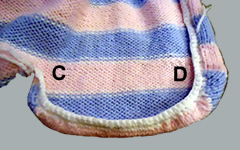
Sew on front and hood band stitch by stitch from C all around to A and then around edge of hood from A to E fitting the edge of the band into the corner by the edge of the hood, at point E. Sew on snap fasteners evenly from C to D to E on right side of work and from A to B to C on wrong side edge of front. Press all seams heartily. (That is: carefully with a damp cloth). Sew on decorative buttons if required. |
Materials
|
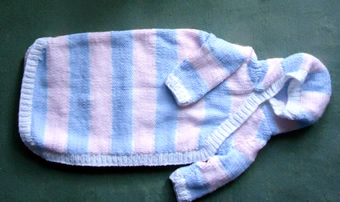
|
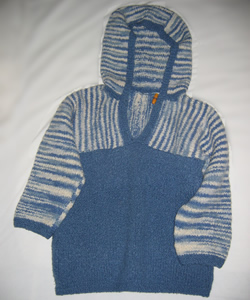
A pattern from the mid 1970s, knitted in a bouclé wool called Jaeger Catkin. As it was a speciality wool, I decided to splash out and buy the recommended stuff to get the right effect. Originally, I "improved" the pattern by making bell shaped sleeves, which, I seem to remember, were highly fashionable at the time. I wore it like this, day after day throughout my year in Southampton University in 1977.
In the 1980s, I unravelled the sleeves and reknitted them straight.... I can only assume I wore it again at that time.
Although I can still just squeeze into this sweater, it is really too small for me now - which some may consider a Good Thing - but I still love it.
Instructions.The sleeves and yoke of this tunic are knitted from cuff to cuff and the back and front (knitted in the usual vertical manner) are sewn onto it at the armhole. Back and Front alike.Work 2 pieces as follows: Using No 8 (4mm) needles and main shade (M), cast on 65 [69
: 73 : 77]
sts loosely and knit 7 rows in garter stitch (every row knit). Change
to No 5 needles, and beginning with a knit row work 6 inches in stocking
stitch, ending with a purl row. Next row: K12 [13
: 13 : 14],
k2tog tbl, knit to the last 14 [15
: 15 : 16];
k2tog; knit to end. Left Sleeve and Yoke** Using No 8 needles and main shade (M), cast on 57 [61 : 61 : 65] sts loosely and knit 7 rows in garter stitch. Break off M. Change to No 5 needles, and join in contrast colour (C). Beginning with a knit row continue in stocking stitch, until sleeve measures 19 [19 : 19½ : 19½] inches from the beginning, ending with a purl row. Place coloured marker at each end of last row. Work a further 8 [8 : 10 : 10] rows in stocking stitch.
Next row: K28 [30 : 30 : 32], pick up loop lying before next st and m1, k1, m1; k28 [30 : 30 : 32] Work 9 [9 : 11 : 11] rows in stocking stitch. Next row: K29 [31 : 31 : 33], pick up loop lying before next st and m1, k1, m1; k29 [31 : 31 : 33]. {61 [65 : 65 : 69] sts} Work 13 [15 : 15
: 17] rows in stocking stitch, ending
with a purl row. Divide for neck: Next row: K30 [32 : 32 : 34], and turn, leaving the remaining sts on a holder. Complete this side first. Work a further 15 [16 : 16 : 17] rows. Cast off. With right side of work facing, slip the first 10 sts on to a holder, and rejoin yarn to remaining 21 [23 : 23 : 25] sts. Work a further 12 [12 : 12 : 14] rows. Break off C. Change to No 8 needles, join in M and knit 7 rows. Right Sleeve and YokeWork as given for left sleeve and yoke from ** to **. Divide for neck: Next row: K21 [23 : 23 : 25], and turn, leaving the remaining sts on a holder. Complete this side first. Work a further 11 [11 : 11 : 13] rows. Break off C. Change to No 8 needles. Join in M and knit 7 rows. With right side of work facing, slip the first 10 sts on to a holder,
and work 16 [17
: 17 : 18]
rows. Cast off. To Make UpPress the sleeve pieces very lightly under a damp cloth with a warm iron on wrong side, omitting the 9 st borders. Join centre back yoke seam. Neck border: Hood: Next row: K9 [12 : 12 : 12]; (m1, k2 [2 : 2 : 3]) 5 [8 : 8 : 3] times; (m1, k1 [1 : 1 : 2]) 12 [2 : 2 : 10] times; (m1, k2 [2 : 2 : 3]) 5 [8 : 8 : 3] times; m1; k9 [12 : 12 : 12]. {73 [77 : 77 : 79] sts}. Change to No 5 needles. 1st row (right side): Knit to end.
Repeat the last 2 rows until hood measures 11½ ins from beginning, ending with a wrong side row. Next row: K4, slip these 4 sts on
to a holder, cast off next 20 [21
: 21 : 22]
sts; k25 [27
: 27 : 27]
sts, (including stitch on needle); k4 and slip these 4 sts on to a holder. With wrong side of work facing, rejoin yarn to rem 25 [27 : 27 : 27] sts and beg with a purl row, cont in stocking stitch until side edge fits along cast off edge of hood to within 4 sts on holder. Cast off. Sew cast off edges to side edge of centre piece. Left border: Right border: Join borders and sew in position around hood. [Editor's note: I used a duffle toggle and loop to fasten neck rather than a cord.] |
Materials
|
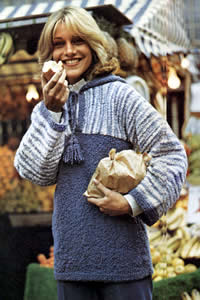
|
|
You can see similar patterns - some with front pockets - in the vintage patterns section: |
||
Sweater with hood and stripes |
Mother and daughter tunics |
|

All dressed up in a charming pinafore, suitable for a spring or summer
celebration, perhaps, in a lighter cotton-blend 4ply. Alternatively, try an angora
or mohair blend for a more wintry festive feel.
The pattern for the dress underneath is also given, although, today, we seem to be fully equipped with central heating everywhere, so this combination may prove to be
too hot for most children.
InstructionsThe pinafore is worked in one piece up to the armhole shaping. Panel Pattern over 5 stitches: 1st row: k2, yfwd, k2tog tbl, k1 With No 12 (2¾mm) needles cast on cast on 223/239/255 sts. and work 5 rows garter-stitch, that is: every row knit. Change to No 10 (3¼mm) needles and pattern as follows : 1st row (right side facing): knit. Shape skirt and place panel pattern as follows: 1st decrease row: k5/13/5, (panel pattern 5 as 1st row, k5, k2tog, k4) 13/13/15 times, panel pattern 5 as 1 st row, k5/13/5. [210/226/240 sts] Keeping continuity of panel pattern, work 11/17/25 rows straight. 2nd decrease row: k5/13/5, (pattern 5, k4, k2tog, k4) 13/13/15 times, pattern 5, k5/13/5. [197/213/225 sts] Work 15/17/29 rows straight. 3rd decrease row: k5/13/5, (pattern 5, k4, k2tog, k3) 13/13/15 times, pattern 5, k5/13/5 [184/200/210 sts] Work 15/17/29 rows straight. 1st and 2nd sizes: Continue decreasing
13 sts thus on next and following 16th/18th
row [158/174 sts]. All sizes: Divide for front and backs: Continue straight on these 21/23/25 stitches for right back until work measures 14½/16½/18½ inches, ending with right side facing. Shape shoulder by casting off 3sts at the beginning of the next
and following alternate row. With wrong side facing, rejoin yarn to remaining stitches from holder; cast off 34/38/42, (for armhole), p43/47/51, turn and leave remaining stitches on a spare needle or stitch-holder. Continue straight on these 43/47/51 stitches for front until work measures 12/13½/15½ inches, ending with right side facing. Divide for neck: Work 1 row straight. Cast off remaining 2/3/4 sts. With right side facing, rejoin yarn to remainiing stitches, cast off centre 27/29/31, then finish to correspond with first side, reversing shapings. With wrong side facing, rejoin yarn to remaining stitches on holder, cast off 34/38/42, (for armhole) purl to end. Finish to correspond with right back, reversing shapings. Shoulder Frills:With No 12 needles, cast on 103/111/119
sts. and work 3 rows garter-stitch. To Make UpUsing a warm iron and a damp cloth. press parts lightly on wrong side. Join shoulder seams. Make borders: With right side facing and 3mm hook, work 2 rows
dc up left back, round neck and down right back. increasing and decreasing
at corners as required. Press seams. Sew on buttons. |
MaterialsOriginal materials called for: 3/3/4
50g balls 4 ply fingering. A pair each Nos 10 and 12 (3¼mm and 2¾mm) needles. 4 small buttons. Tension28 sts and 36 rows to 4 inches over stocking-stitch on No 10 needles. Size mattersThree sizes given for 22/24/26
inch chest; length from top of shoulders: 14½/16½/18½ inches. Abbreviationstbl: through back of loops ch: chain A word on the wool.The original colour combination is white for the apron with "Damask Rose" for the dress. Disclaimer
|
Eyelet pattern and sleeve frill detail:



This is the plain and simple dress designed to go under Miss Muffet's pinafore.
InstructionsThis is an A-line dress, knitted completely plain, with a high round neck and long sleeves. Back** Change to No 10 needles and stocking-stitch, and, starting with a knit row, work 8 rows straight. 1st decrease row: k26/28/30, k2tog, k2tog tbl, k54/56/60, k2tog, k2tog tbl, k26/28/30. [110/116/124 sts] Work 11/13/15 rows straight. 2nd decrease row: k25/27/29, k2tog, k2tog tbl, k52/54/58, k2tog, k2tog tbl, k25/27/29. [106/112/120 sts] Work 11/13/15 rows straight. 3rd decrease row: k24/26/28, k2tog, k2tog tbl, k52/54/58, k2tog, k2tog tbl, k24/26/28. [102/108/116 sts] Work 11/13/15 rows straight. Continue decreasing 4 stitches thus on the next and every following 12th/14th/16th
row until 82/88/96
sts; remain. Work a few rows straight until back measures 12/13½/15 inches, ending with right side facing. Shape armholes by casting off 4 sts. at the beginning of the next
2 rows, then decrease 1 stitch at each end of every row until 62/68/72
stitches remain. Work a few rows straight until back measures 14/16/17½ inches, ending with right side facing. Divide for back opening: Continue straight on first set of stitches until back measures 16½/18½/20½ inches, ending with right side facing. Shape shoulder by casting off 4 stitches at the beginning of the
next and following 2 alternate rows, then 2/3/4
stitches at the beginning of the following alternate row. With right side facing, rejoin yarn to remaining stitches and finish to correspond with the first side, reversing shapings. FrontWork as for back from **
to **. Divide for neck: Shape shoulder by casting off 4 stitches at the beginning of the
next and following 2 alternate rows. With right side facing, leave centre 16/18/20
stitches on a stitch-holder, and rejoin yarn to remaining stitches and
finish to correspond with first side, reversing shapings. SleevesWith No 12 needles, cast on 40/44/46
sts. and work 7 rows garter-stitch. Shape top by casting off 4 stitches. at the beginning of the next
2 rows, then decrease 1 stitch at each end of the next and every alternate
row until 34 stitches remain. Cast off. To Make UpUsing a warm iron and a damp cloth. press parts lightly on wrong side. Join shoulder seams. Neckband: With right side facing and No 12 needles, start at top
of left back and work as follows:- Left Back Border: With 3mm hook, work 2 rows dc along left back
edge. Join side and sleeve seams; insert sleeves. |
MaterialsOriginal materials called for: 4/4/5
50g balls 4 ply fingering. A pair each Nos 10 and 12 (3¼mm and 2¾mm) needles. 3 small buttons. Shirring elastic for cuffs. Tension28 sts and 36 rows to 4 inches over stocking-stitch on No 10 needles. Size mattersThree sizes given for 22/24/26 inch chest; length from top of shoulders: 16½/18½/20½ inches; sleeve seam: 9½/10½/12 inches. Abbreviationstbl: through back of loops ch: chain A word on the wool.The original colour combination is white for the apron with "Damask Rose" for the dress. Disclaimer
|
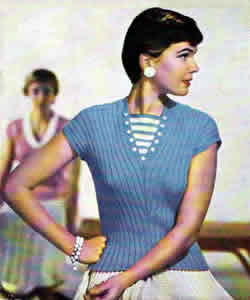
Mid-fifities fashion in fresh blue and white summer colours. The stripes and buttoning give the design a slightly off-kilter nautical look. My version used a stronger blue than the original.
If you are tantalised by the ghostly image of the other sweater in the background then look at these instructions - it is not actually that very knitted top (the one in the background of the photo above has beads - you'll have to trust me on that), but it is very similar, and also dates from the summer of 1956.
My own version is now complete so the pattern is "checked out", and I hope to add a photo soon.
InstructionsKnitted in 2 pieces with a V-neck, and detachable vestee. BackWith No 12 (2¾mm) needles cast on cast on 138sts and work as follows: 1st row (right side facing): k2;
(p2, k4) 22 times; p2, k2. Start centre shaping: Continue thus, keeping continuity of rib and increasing 1 stitch at each
side of centre 2 purl sts on next and every following 4th row until there
are 180 sts, remembering that when increasing for purl sts to purl
into back of loop and when increasing for knit sts to knit into
back of loop,that is: the next 2 sets of increasings will be purl and
the following 4 sets of increasings knit. With right side facing, change to garter stitch, (that is, every row
knit), Then, continuing in garter stitch, shape shoulders by casting off 4 sts
at beginning of next 10 rows, then 12 sts at beginning of following 4
rows. FrontWork exactly as for back until there are 172 sts. Work 3 rows straight, then start to introduce the garter stitch at the centre as follows: 1st row (right side facing): Rib
82, k3, m1k, k2, m1k, k3, rib 82. Divide for neck: Next row: K9, rib 80. Repeat the last 2 rows once more. Put a coloured marker at the end of the row to mark the start of the armhole. Continue in rib and garter stitch, shaping the armhole edge only by k2tog at the beginning of the next and every following 4th row, and at the same time make a buttonhole in the garter stitch border on the 2nd and every following 12th row until 5 in all are done, excluding first buttonhole at the centre front. To make a buttonhole:- With wrong side facing, k2, k2tog, wind wool twice round needle, k2tog, k3, rib to end. On the next row: knit and purl into the two twists as before. When the 5 buttonholes are done, continue in rib and garter stitch, still continue to decrease at the armhole edge on every 4th row until 15 sts have been decreased at this edge, and 75sts remain. Work 3 rows straight. Change to garter stitch over all sts, With right side facing, continue in garter stitch and shape the shoulder by casting off 4sts at the beginning of next and following 4 alternate rows, then 14sts at the beginning of following 3 alternate rows. Cast off remaining 13 stitches. With side facing, rejoin wool to remaining sts, and work, to correspond with first shoulder, reversing the shaping. VesteeWith white wool and No 11 needles, cast on 10 sts and knit 4 rows. 5th row: Knit, increasing 1 stitch
at each end. Work 3 rows straight in stocking stitch, keeping the 4sts at each end in garter-stitch throughout. Repeat last 4 rows once more. Join in blue. Next row (in blue, right side facing): K3, increase in next stitch, knit to last 4sts, increase in next stitch, k3. Work 3 rows straight in blue with border as before. Next row (in white): K4, p34, k4. This completes the 5th white stripe. Break white, join in blue and knit 5 rows. To Make UpPress work very lightly taking care not to spoil rib. Sleeve Edgings: With right side facing, No 11 needles and contrast
yarn, pick up and knit 92 sts between markers on back and front. Knit 8 rows; cast off. Join side seams. |
MaterialsOriginal materials called for: 7 ozs Patons Beehive Fingering 3-ply in main shade (powder blue) and a small ball (less than 1oz) in white. A pair each Nos 11 and 12 (3mm and 2¾mm) needles. 11 small white buttons. My version is knitted in 5 x 50g balls of Adriafil Avantgarde 3 ply using
Nos 13 and 12 needles. TensionRibbing is difficult to measure, but it is equivalent to a basic tension
of 8 sts and 10 rows to an inch over stocking-stitch on No 11 needles. Size mattersOriginal sized for bust 34-36 inches; See "adapting the size". Abbreviationsm1p: pick up loop lying before next stitch and purl into back of it. m1k: pick up loop lying before next stitch and knit into back of it. A word on the wool.I have so many words on the wool I am not sure where to begin. Jamiesons have an excellent range of colours in "2ply laceweight" which states: This yarn can be used in vintage patterns which call for "3ply yarns". I can suggest looking at Susan Crawford's new Excelana range from John Arbon textiles. I have great hopes of this venture solving my knitting issues in the future: 4 ply available now and hopefully 3 ply in the future. I have not yet experimented with either of these two latter yarns. Disclaimer
|
Adaptations:I made quite a few casual adaptations to "improve" the design for my figure - but as usual this had a knock-on effect in some other areas - so I describe what happened here. Adaptation 1: When changing to garter stitch the ribbing pulls at the garter stitch section and causes puckering. You can see this happening slightly in the original photo. To compensate for this, on the first knit row of the garter stitch (right side facing) I knitted across the 4 knit sts and and the k2tog for the 2 purl sts. This changed the number of sts for the casting off. So for the Front sections I worked k2tog 10 times on the p2 sections of the rib; I then shaped the shoulder by casting off 3sts at the beginning of next and following 4 alternate rows, then 13sts at the beginning of the following 2 alternate rows, then 12sts at the beginning the final 2 alternate rows. For the Back, I worked it slightly differently without decreasing
across the back of the neck. So I worked k2tog across the first 11 p2
sections of the rib, but incorporated the centre 7 p2 sections into the
garter stitch as k2, then k2tog across the last 11 p2 sections of the
rib. Adaptation 2: I lengthened the garter stitch sections by about 2 inches to make the V neck lower. This was to avoid "waist boobz" (please see Kate's blog, "needled" ** on the subject). Adding 2 inches at the shoulder, lengthens the whole sweater, so I knitted 2 inches less at the start of the sweater - as it is not overly short in the first place. Having done this, you may find the armhole markers are (up to 2 inches) too low, so check this before you do the sleeve edging and sewing up the side seams. In my case, I have chubby little arms so wanted the armhole slightly larger in any case. ** Unlike Kate I have a large bosom
with a low bust point, so need no assistance in producing waist boobz
- in fact I seek to reverse the effect. See Kate's lovely design "by-the-sea-shore" where she reverses the "waist boob" effect. It is also an off-kilter nautical design in a way so sits nicely with this entry. |
|
Adapting the size:The original pattern is for one size: 34-36 inch bust. The sweater is designed to fit snugly, but is ribbed which allows some leeway on the exact fit. It is designed to be knitted in 3 ply at about 30 sts to 4 inches. I have used a 4 ply at about 28 sts to 4 inches, and the size would have been acceptable for me - a UK size 12 or "medium". I think this may be suitable for using a thicker yarn with larger needles and getting a larger result. |
|

A very early pattern to make these charming light weight gloves using fine 2ply yarn. You could also use a mercerised cotton for summer gloves, but (as the pattern encourages) check your tension carefully.
Note that these glove patterns are very elderly and thus you have to make allowances in the instructions. They talk about "plain knitting" and they don't give a lot of explanation about how you turn the work and pick up the stitches. Generally they expect you to fend for yourself; I have not tested this pattern so if you would like to double check what I have written or if you want a second opinion I'm happy to try and help.
Instructions:The gloves are worked in blackberry stitch (also known as trinity stitch)
on 2 needles. The nature of this stitch means that the number of stitches
can vary from row to row; this can seem a little puzzling as it means
the instructions for the right and left hand gloves seem not to be symmetrical
- but they should work out OK. Right-hand Glove:Using two Needles, cast on 54 sts. 1st row: k1, purl to last stitch,
k1. These 4 rows form the basic pattern. Repeat from 1st to 4th row five times. The Thumb Next row: k1, p32, k1. Turn Then proceed as follows:- 1st row: k1, p20, k1. Repeat 1st to 4th row three times. Then proceed as follows:- 1st row: k1, (k1, k2togtbl, k4, k2tog,
k1) twice, k1. Break off wool and run end through remaining sts.
First Finger Next row: k1, p34, increase once
in next stitch. Turn. Then proceed as follows:- 1st row: k1, p17, k1. Repeat from 1st to 4th row four times, then 1st and 2nd rows once, decreasing one stitch in last row. Then proceed as follows:- 1st row: (k1, k2togtbl, k4, k2tog,
k1) twice. Finish off as given for Thumb. Second Finger With right side of work facing, join in wool and knit up 4 sts. from 2 cast-on sts. at base of First Finger, p5, k1. Turn. Next row: k1, (k1p1k1 in next stitch; p3tog) four times, cast on 4sts. Turn. Then proceed as follows:- 1st row: k1, p19, k1. Repeat from 1st to 4th row five times, then 1st and 2nd rows once, increasing
one stitch in last row. Third Finger With right side of work facing, join in wool and knit up 5sts. from 4 cast-on sts. at base of Second Finger, p5, increase in the next stitch. Turn. Next row: k1, (p3tog; k1p1k1 in next stitch) three times, p3tog, p1; cast on 4sts. Turn. Then work exactly as given for First Finger. Fourth Finger With right side of work facing, join in wool and knit up 4 sts. from 4 cast-on sts. at base of Third Finger, p5, k1. Then proceed as follows:- 1st row: k1; (k1p1k1 in next stitch;
p3tog) four times; k1. Repeat from 1st to 4th row three times, then 1st row once. Then proceed as follows:- 1st row: (k1, k2togtbl, k3, k2tog,
k1) twice. Finish off as given for First Finger. The Frill With wrong side of work facing, pick up 52 sts, from cast-on edge of glove. Join in wool. 1st row: k1, * k2tog; repeat from * to last st, k1. Work 3 rows in plain knitting. 5th row: k1, *
increase once in next st, repeat from *
to last st, k1. [There should now be 52 sts. on needle]. Continue in this manner until there are 164 sts. on needle. Next row: k1, * p2, k8, repeat from* to last 3 sts, p2, k1. Cast off knitways. Left-hand Glove:Using two Needles, cast on 54 sts. Work exactly as given for Right-hand Glove until Thumb is reached. The Thumb Next row: k1, p31, cast on 11 sts.
Turn. Then proceed as follows:- 1st row: k1, p20, k1. Repeat 1st to 4th row three times. Decrease and finish off as given for the Thumb of Right-hand Glove. Using needle containing 21 sts, join in wool and knit up 11 stitches
from 11 cast-on sts, at the base of the thumb; p21, k1 across remaining
stitches. First Finger Next row: k1, p35, cast on 5 sts.
Turn. Then work exactly is given for First Finger of of Right-hand Glove. Second Finger With right side of work facing, join in wool and knit up 4 sts. from 5 cast-on sts. at base of First Finger, p5, cast on 4sts. Turn. Next row: k1, (p3tog; k1p1k1 in next stitch) four times, p3tog; k1. Turn. Then proceed as follows:- 1st row: k1, p17, k1. Repeat from 1st to 4th row five times, then 1st and 2nd rows once, decreasing
one stitch at the end of the last row. Third Finger With right side of work facing, join in wool and knit up 5sts. from 4 cast-on sts. at base of Second Finger, p6, cast on 3sts. Turn. Next row: k1, (k1p1k1 in next stitch; p3tog) four times, k1p1k1 in next stitch; k1. Turn. Then proceed as follows:- 1st row: k1, p19, k1. Repeat from 1st to 4th row four times, then 1st and 2nd rows once, increasing
one stitch in last row. Fourth Finger With right side of work facing, join in wool and knit up 4 sts. from 3 cast-on sts. at base of Third Finger, p6, k1. Then work exactly as given for Fourth Finger of Right-hand Glove. Work the Frill as given for Right-hand Glove. Making Up:With a damp cloth and hot iron press very lightly. |
Materials1 oz Patons Beehive Fingering 2ply. One pair of No 12 (2¾ mm) needles. Tension3 patterns (12 sts) to 1 inch. Adjust your needle size to obtain the right tension. Approximately 36sts 4 inches on No 12 needles over stocking stitch. Size mattersWidth all round above thumb, 5½ ins. [Editor's note: 5½ins seems a bit small? You may find that despite my notes on the wool weight below that you could use a "4ply" yarn with a larger gauge and/or adjust the needles to get the fit you need. Measure your hand and do a swatch....always Good Advice!] Abbreviationswon: wool over needle. Makes an extra stitch which forms a small pattern hole when knitted on the next row. p3tog: purl 3 stitches together (decrease 2) k1p1k1: knit and purl into front, then knit into back of next stitch (increase 2) k2tog: knit 2 stitches together (decrease). k2togtbl: knit 2 stitches together through back loops or "ssk" (slip slip knit) is a method of knitting 2 stitches together but into the backs of the stitches rather than the usual "k2tog" which knits into the fronts. A word on the woolAlthough it may be a literal 2ply, I think the stated tension implies it is more like a 3 ply weight. Throughout this site I state that it's hard to get 3ply yarns these days - and now I find Jamieson's have a different web address (now corrected on my links I hope) and a range of yarns that is new to me. The yarns are properly described as to the number of strands plied together, (eg "2ply jumper weight"), but also helpfully tell you what the wool weight is equivalent to. So they have an excellent range of colours in "2ply laceweight" which states: This yarn can be used in vintage patterns which call for "3ply yarns". I really wish I had discovered this for some of my other projects. They also have a "cobweb lace" which might be a traditional 2 ply weight. I can't wait to experiment. Disclaimer
|

From the same early pattern source as Gloves for a Lady I - slightly less lacy but still an open-work light weight design using fine yarn.
Note that these glove patterns are very elderly and thus you have to make allowances in the instructions. They talk about "plain knitting" and they don't give a lot of explanation about how you turn the work and pick up the stitches. Generally they expect you to fend for yourself; I have not tested this pattern so if you would like to double check what I have written or if you want a second opinion I'm happy to try and help.
Instructions:The gloves are worked in an openwork ladder stitch created by working
"yarn over needle" or eyelets on every row. Right-hand Glove:Using two Needles, cast on 80 sts Work 2 rows in plain knitting. Repeat 30th row 6 times, increasing 2 sts in last row. Repeat 3rd row thirty-two times. The Thumb Next row: k1, (p1, won, k2tog) eleven
times; k1. Turn Working on these 20 sts, repeat 3rd row twenty-two times (length of Then proceed as follows:- 1st row: knit plain. Break off wool and run end through remaining stitches.
Working on these 50 sts, repeat 3rd row of main pattern twenty-five times. First Finger Next row: k1, (p1, won, k2tog) ten
times; k1. Turn Working on these 17 sts, repeat 3rd row of main pattern twenty-five times. Then proceed as follows:- 1st row: k14, k2tog, k1. Break off wool and run end through remaining stitches. Second Finger With right side of work facing, join in wool and knit up 3 sts from 3 cast-on sts at base of First Finger, k2tog, p1, won, k2tog, k1. Turn. Next row: k1, (p1, won, k2tog) four times, p1, cast on 3sts. Turn. Working on these 17 sts, repeat 3rd row of main pattern thirty times. Decrease and finish off as given for First Finger. Third Finger With right side of work facing, join in wool and knit up 3 sts from 3 cast-on sts at base of Second Finger, k2tog, p1, won, k2tog, k1. Turn. Next row: k1, (p1, won, k2tog) four times, p1, cast on 3sts. Turn. Working on these 17 sts, repeat 3rd row of main pattern twenty-eight times. Decrease and finish off as given for First Finger. Fourth Finger With right side of work facing, join in wool and knit up 3 sts from 3 cast-on sts at base of Third Finger, k2tog, p1, won, k2tog, k1. Turn. Next row: k1, (p1, won, k2tog) four
times, k1, cast on 3sts. Turn. Working on these 14 sts, repeat 3rd row of main pattern eighteen times.
Then proceed as follows:- 1st row: knit plain. Finish off as given for First Finger. Left-hand Glove:Cast on 80 sts and work exactly as given for Right-hand Glove until Thumb is reached. The Thumb Next row: k1, (p1, won, k2tog) eight
times, p1, cast on 9 sts. Turn. Work on these 20 sts exactly as given for Thumb of Right-hand Glove. Using needle containing 15sts, join in wool and knit up 11 stitches
from 9 cast-on sts, at the base of the thumb; wfwd, k2tog, (p1,won, k2tog)
7 times, k1, across remaining 24 sts. First Finger Next row: k1, (p1, won, k2tog) ten
times; p1, cast on 3 sts. Turn Then work on these 17 sts, exactly is given for First Finger of Right-hand Glove. Second Finger With right side of work facing, join in wool and knit up 3sts from 3
cast-on sts at base of First Finger; k2tog, p1, won, k2tog, p1, cast
on 3sts. Turn. Next row: k1, (p1, won, k2tog) five times; k1, Turn. Then work on these 17 sts, exactly is given for Second Finger of Right-hand Glove. Third Finger With right side of work facing, join in wool and knit up 3sts from 3
cast-on sts at base of Second Finger; k2tog, p1, won, k2tog, p1, cast
on 3sts. Turn. Next row: k1, (p1, won, k2tog) five times; k1, Turn. Then work on these 17 sts, exactly is given for Third Finger of Right-hand Glove. Fourth Finger With right side of work facing, join in wool and knit up 3sts from 3 cast-on sts at base of Third Finger; k2tog, p1, won, k2tog, k1. Turn. Next row: k1, (p1, won, k2tog) four times; k1, Turn. Then work on these 14 sts, exactly is given for Fourth Finger of Right-hand Glove. Work the Frill as given for Right-hand Glove. Making Up:With a damp cloth and hot iron press very lightly. |
Materials1 oz Patons Beehive Fingering 2ply. One pair of No 13 (2¼ mm) needles. Tension10 sts to 1 inch over pattern (not stretched). Approximately 36sts 4 inches on No 12 needles over stocking stitch. Size mattersWidth all round above thumb, 5 ins. [Editor's note: 5ins seems a bit small? You may find that despite my notes on the wool weight below that you could use a "4ply" yarn with a larger gauge and/or adjust the needles to get the fit you need. Measure your hand and do a swatch....always Good Advice!] Abbreviationswon/wfwd: wool over needle/wool forward. Makes an extra stitch which forms a small pattern hole when knitted on the next row. k2tog: knit 2 stitches together (decrease). k2togtbl: knit 2 stitches together through back loops or "ssk" (slip slip knit) is a method of knitting 2 stitches together but into the backs of the stitches rather than the usual "k2tog" which knits into the fronts. A word on the woolAlthough it may be a literal 2ply, I think the stated tension implies it is more like a 3 ply weight. Throughout this site I state that it's hard to get 3ply yarns these days - and now I find Jamieson's have a different web address (now corrected on my links I hope) and a range of yarns that is new to me. The yarns are properly described as to the number of strands plied together, (eg "2ply jumper weight"), but also helpfully tell you what the wool weight is equivalent to. So they have an excellent range of colours in "2ply laceweight" which states: This yarn can be used in vintage patterns which call for "3ply yarns". I really wish I had discovered this for some of my other projects. They also have a "cobweb lace" which might be a traditional 2 ply weight. I can't wait to experiment. Disclaimer
|

Here we have Jill modeling her charming version of the Paris Line Cardigan from January 1955. It is so successful and comfortable to wear she is planning a second version for the summer.
Instructions.Figures in brackets refer to larger sizes; where only one figure is given,
this refers to all sizes. The BackWith No 9 needles cast on 106 (118) {126}
stitches and work 10 rows in k2/p2 rib, starting and ending k2 on the
first row, and increasing 7 (7) {11}
stitches evenly across on last row by working twice into every 14th (16th)
{11th} stitch. [113 (125)
{137} sts] 1st row (right side facing): k1,
* p3, k1; repeat from * to end. These 8 rows form the pattern. Next row (right side facing): * k2,
p2; repeat from * to last 2 sts., k2. Continue straight in rib until back measures 23 (23½)
{23½} inches. Pocket Linings (make 2)With No. 8 needles, cast on 26 (26) {30}
sts. and work 4½ (4½) {4½}
inches stocking stitch ending with a purl row; leave stitches on a spare
needle or stitch holder. Left FrontLeft. With No. 9 needles, cast on 63 (71)
{79} sts. and work in rib as follows: Repeat these 2 rows 4 times more, and on last row increase 2 sts. as
follows: 1st row (right side facing): k1;
(p3, k1) 10 (12) {14}
times; p1; (k2, p2) 5 times; k3. Repeat these 8 rows until work measures 5 (5) {5} inches from start. Next row (insert pocket): Pattern
8 (12) {14};
(k2, p2) 6 (6) {7}times;
k2; pattern 8 (12) {14};
rib 23. Next row (wrong side facing): rib 23; pattern 8 (12) {14}; cast off 26 (26) {30} in rib; pattern 8 (12) {14}. Next row: pattern 8 (12) {14}; pattern across 26 (26) {30} stitches of one of the pocket linings, in place of those cast off; pattern 8 (12) {14}; rib 23. Continue in pattern with 23 sts. at front edge in rib until front measures same as back at side edge and ending with same pattern row. Then with right side facing, shape armholes by casting off 6 (8)
{8} stitches at the beginning of the next
row, then k2tog at armhole edge on alternate rows until 53 (59)
{65} stitches remain. Work straight until
back measures 17 (17½) {17½}
inches, increasing 6 (4) {2}
sts. evenly across on patterned part of last row: [59 (63)
{67} sts] Right FrontWith No. 9 needles, cast on 63 (71) {79}
sts. and work in rib as follows: Repeat these 2 rows once more. Increase row: rib 3, increase in
next stitch, rib to last 28sts, increase in next stitch, rib to end: [65
(73) {81} sts] Next row: k3, (p2, k2) 5 times; p1;
(k1, p3) 10 (12) {14}
times; k1. Finish to correspond with left front, reversing all shapings and making 4 more buttonholes as before up front edge, the last one to come about 1 inch below start of yoke ribbing, and the remaining 3 evenly spaced between. Mark position of buttons on left front with pins, then work holes to correspond. The first row of pocket top will read: SleevesWith No. 10 needles, cast on 54 (54) {54} sts. and work 3 inches k2/p2 rib, having a k2 at each end on the right side, and increasing 3 sts. evenly across on last row: 57 (57) {57} sts. Change to No 8 needles and work 8 rows in pattern as for back. Continue in pattern and shape sides by increasing 1 stitch at each end of 7th and every following 8th row until there are 73 (73) {73}sts, then on every following 4th row until there are 83 (83) {83}stitches, taking the extra stitches into pattern as they are made. Work straight until sleeve measures 18 inches or required length. With right side facing, shape top by casting off 4 sts. at beginning of next 2 rows, then k2tog at the beginning of every row until 45 (45) {45} sts. remain, then at each end of every row until 25 (25) {25} sts. remain. Cast off. To Make UpPress parts lightly on wrong side under a damp cloth. Roll Collar: On the left front, continue in rib on the remaining 29 (30) {34} sts. working short rows to provide shaping thus: ** Work ½ (½) {1}
inch in rib, ending at the front edge. Join side and sleeve seams; insert sleeves. Catch down pocket linings. |
Materials
|

|

Stitch Detail |

Well if you don't actually have the life of ease, this might help you attain it - firstly with the relaxation of knitting it, and then in the casual dress code it will encourage once completed.
This pattern is straight from the 1970s, but does seem to have that timeless quality* about it.
The Magpie Aran yarn is exactly the nutty brown tweed colour I always imagined for the cardigan, (yellow/cream Arans are not a good colour for me). However Magpie, though a very robust wool, soft it is not, and I think this design would be great in a lovely soft airy yarn; luckily there is plenty of choice these days in this kind of wool weight.
* I do admit that I hate that word "timeless"- it seems to be an unwritten rule that once said it will ensure the item to which it applies becomes dated and laughable even more quickly than other items of the same vintage. However, in this case I think it really does apply, and (if it's any comfort) I don't think it was high fashion even in the 1970s, which is probably why it took so long for me to be inspired to finally make it up.
Instructions.Figures in brackets refer to larger sizes; where only one figure is given,
this refers to all sizes. The BackWith No 9 needles cast on 98 (104 : 110: 116 : 122) sts. Repeat the last 2 rows 3 times more, then 1st row once, increasing 1st at both ends of last row on lst, 3rd and 5th sizes. Increase row: K8 (10 : 14: 16: 20), kfb *p7, (k2, pfb) 6 times, k2, p7 *; (k1, p1, then k1, p1 in next st) 4 times, k2; repeat from * to *, kfb, knit to end. [118 (122 : 130 : 134: 142) sts] Change to No 7 needles and pattern as follows: 1st row: (kb1, p1) 5 (6 : 8 : 9 :
11) times; * k7, (p2, k2) 6 times, p2. k7
*; p18; repeat from *
to *, (p1, kb1) to end. These 12 rows form the pattern. Continue in straight until work measures 20 ins, ending with right side facing for next row. Shape Armhole: Continue straight until armhole measures 7½ (7½ : 8: 8: 9) ins, ending after a wrong-side row.
Continue on the last set of stitches. Next row: Cast off 8, pattern to
end. Repeat the last 2 rows once more. Join yarn to neck edge of remaining sts and work to match lst side, reversing shapings. Pocket linings (make 2)[Editor's note: You may note from the photograph that I omitted pockets on my cardigan - actually I think it looks best with pockets, and I plan to add them in later, but if you don't want them, simply leave out these sections.] With No 9 needles cast on 38sts. 1st row: K2, (p2, k2) to end. Repeat the last 2 rows for 5 inches, ending after 1st row. Next row: P3, increase in the next stitch, rib to the last 4 sts, increase in the next stitch, p3. Leave the stitches on a spare needle or stitch holder. The Right FrontWith No 9 needles cast on 58 (61 : 64 : 67 : 70) sts. 1st row: K1, (kb1, p2) to end. Repeat the last 2 rows once more. Next row (buttonhole): Rib3, cast
off 3, rib to end. Work 3 more rows in rib, increasing 1st at the end of the last row on the 1st, 3rd and 5th sizes. [59 (61 : 65 : 67 : 71) sts] Increase row: K8 (10 : 14: 16: 20), kfb; repeat from * to * as increase row on back; (k1, p1, then k1, p1 in next st) twice, k2; turn, leaving the remaining 8 sts on a safety-pin to work the buttonhole band later. Change to No 7 needles and continue to work on 60 (62 : 66 : 68 : 72) sts as follows: 1st row: P10; repeat from *
to * as 1st row of back, then (p1, kb1) to
end. Keeping bramble stitch and cable pattern correct, decrease 1 stitch at
the end of the following 21st row, then the following 12th row. Next row (place pocket): P10, slip
the next 40 stitches on to a stitch holder or spare needle; Continue in pattern, decreasing 1 stitch at side edge on the following
10th row. Then continue straight on the remaining 57 (59 : 63 : 65 : 69)
stitches until work measures 13 inches. Shape Armhole: Shape Neck: Shape Shoulder: The Left FrontWith No 9 needles cast on 58 (61 : 64 : 67 : 70) stitches. Repeat the last 2 rows 3 times more, then 1st row once, increasing 1st at the beginning of the last row on the lst, 3rd, and 5th sizes. Increase row: Rib 8 stitches, and
leave these 8 stitches on a safety-pin to work the left front band later. Change to No 7 needles and pattern thus: 1st row: (Kb1, p1) 5 (6 : 8 : 9 :
11) times; repeat from * to *
as 1st row of back, then p10. Continue in pattern as now set, and complete to match right front, reversing
shapings and the position of the pocket. The SleevesWith No 9 needles cast on 44 (44 : 50 : 50 : 50) sts. Increase row: **
(k2, kfb) once (once : twice : twice : twice), Change to No 7 needles and pattern as follows: 1st row: (Kb1, p1) 3 (3 : 5 : 5 :
5) times; repeat from * to *
as for the 1st row of the back; (p1, kb1) to end. Continue in pattern as now set, increasing 1 stitch at both ends of following 5th row and every following 5th (5th : 6th : 6th : 5th) row until you have 80 (80 : 86 : 86 : 92) stitches, working the increased stitches into the pattern as end panels. Continue straight until work measures 17 (17 : 18 : 18 : 18) inches. For 1st, 2nd, and 3rd sizes, end with wrong side facing, and for 4th and 5th sizes end with right side facing to begin the next row. Mark the ends of the last row (with a piece of coloured thread or a stitch marker). Shape Top: The Pocket TopsWith right side facing, slip the 40 stitches on the stitch holder for the left front pocket on to No 9 needles. 1st row: K1, (k2tog tbl, p2) twice; (kb1, p2) 8 times; k2tog tbl, p2, k2tog tbl, k1. [36 sts] 2nd row: K1, pb1, (k2, pb1) to last
stitch, k1. Repeat the process for the stitches on the stitch holder for the right front pocket. The Front BandsWith wrong side facing, slip the 8 stitches of left front on the safety-pin back on to on to No 9 needles. Work in rib as set, increasing 1 stitch at the end of the 1st row. [9 sts]. Continue in rib until band will fit front edge. [Editor's note: I have found it difficult to judge the fit of front bands knitted in this way. My method now is that when I have knitted about the right length, I test the length against the main body by laying the work flat and totally relaxed with the front band laid in position up the front. When the front band is about ½ to 1 inch shorter than the main body it fits nicely into position very slightly stretched.] Leave the stitches on a spare needle. The Neck BandJoin shoulder seams. With No 9 needles and right side facing, rib across the 9sts of the right band, pick up and knit 29 sts up right front neck, 37 sts round back neck, 29 sts down left front neck, and finally rib across 9sts of left front band. Work 6 rows in rib matching in with the bands, making the last (top)
buttonhole on the 4th and 5th rows. To Make UpJoin side seams. |
Materials
|
|

|

This is a very flattering hat - speaking as one who has difficulty with hats, which always leads to sartorial dilemmas in weather such as we have in the UK at the moment. However, not only flattering and warm, but amazingly speedy to knit, which can be very useful at this time of year. I completed it in one afternoon.
Instructions.The main part of the hat is a simple six-row pattern where you increase at the beginning and decrease at the end of every alternate row to create the diagonal effect. At the same time you alternate 3-row bands of stocking stitch and reverse sticking stitch. SideCast on 20sts. 1st row: Knit These 6 rows form the pattern. BrimWith right side facing, pick up and knit 72sts along one edge of the
side piece - that is 3 sts to each knit and purl stripe. Work 10 rows in k1/p1 rib, and then cast off in rib. Join side piece and brim neatly with a flat seam. Press seam lightly. CrownCast on 14sts, and work in stocking stitch, starting with a purl row (this is right side of work), and increasing at each end of the first and every alternate row until there are 28 sts. Knit one row. Then continue, decreasing at each end of next and every following alternate row until 14sts remain. Cast off. To Make UpPin crown in position to side of hat on wrong side, so that purl side
of crown is on the outside. Back stitch in position very neatly on wrong
side with a tailored seam Fold ribbed brim in half to wrong side and slip stitch in position round lower edge. Place on head. Wrap in Christmas paper. Put under tree. |
Materials
|
|
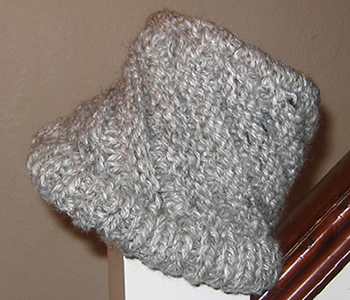
|
Handspun YarnI bought some Spelsau
fleece at Woolfest in 2009; there was a workshop on knitting direct from
the fleece but I intended to spin my sample. I made a 2 ply yarn which
was softer than I had expected, but kempy (as I had not attempted to remove
the coarser fibres). There was only a small amount - I did not measure
the yardage, but I started with 100g, the yarn was chunky weight, and
I knitted 2 strands of yarn together by combining it with an aran-weight
handspun merino/silk blend to achive the bulky weight required. As you
can see, the fleece was a lovely combination of natural grey tones. The description of the Spelsau fleece is as follows (taken from the reference above):
|
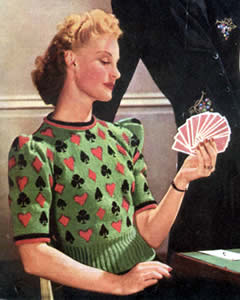
This is a wonderful period jumper from 1940. I often thought I might try and adapt it but never made a decision as to how. Recently a friend on the internet borrowed the pattern to make it "as is" - quite an undertaking with all that patterning. She wanted to make it for a local Poker Club - but, as I explained, this is a Bridge Jumper - no playing poker in it mind!
So here is the pattern as it appeared originally - I will include any notes and advice from our test knitter if and when they are forthcoming.
InstructionsThese are the instructions as they appear in the original pattern. They are untested with modern yarn and needles. FrontWith No 12 needles and main shade (G) cast on cast on 108 stitches and work 4½ inches in Knit 2, Purl 2 rib, increasing at the end of the last row. Change to No. 10 needles, and work 2 rows stocking stitch; then, still in stocking stitch, change to coloured pattern as follows: 1st row (right side facing): Knit
8 in main shade (G), * 3 in black
(B), 13G, 1 in red (R), 13G, repeat from *
to last 11 stitches, 3B, 8G. 15th-20th rows: Work in stocking stitch in main shade only. 21st row:
Increase in first stitch; knit 8G, *
1R, 13G, 3B, 13G, repeat from * to
last 10 stitches, 1R, 8G, increase in last stitch. These 40 rows form the pattern.
Shape armhole as follows: Continuing in pattern, cast off 5 stitches at the beginning of the next
2 rows, then decrease at each end of the next 5 rows (105 stitches). Shape neck as follows: 1st row: Knit 6G, 3B, 13G, 1R, 59G,
1R, 13G, 3B, 6G. Working on these last 42 stitches:- 4th row: Purl 4G, 2B, 1G, 1B, 1G, 2B, 10G, 3R, 18G. Continue in pattern, decreasing at neck edge on next and every alternate row until 36 stitches remain and the 15th pattern row has been worked. Shape shoulder as follows: 1st row (wrong side facing): Cast
off 10 stitches at armhole edge, purl to end. Repeat these last 2 rows once. Cast off. BackWork as for the front until 3rd pattern is completed, then Next row: Knit 6G, 3B, 13G, 1R, 13G, 3B, 14G, turn. Work on these 53 stitches for the right shoulder (slip remaining stitches
on to a spare needle or stitch holder). Shape shoulder as follows: cast off 11 stitches at armhole edge on the next 3 alternate rows. Cast off remaining 20 stitches. Return to stitches left on spare needle or stitch holder. Join main shade wool at centre, cast on 4 stitches for under-lap and work to match the right shoulder, shaping at opposite edges. SleevesWith No 12 needles and main shade wool, cast on 73 stitches. 1st row: Knit 6G, *
1R, 13G, 3B, 13G, repeat from * once,
1R, 6G. Now shape top: work 4 rows in G stocking stitch, casting off 2
sts at the beginning of the first 2 rows, then decreasing at each end
of the next 2 rows. Work 2 rows straight, then decrease at the beginning of the next 4 rows.
* Work 2 rows straight, then decrease
at the beginning of the next 2 rows. Repeat from *
once. Roll for neck and SleevesWith No. 12 needles cast on 7 stitches in R and 7 stitches in B. Repeat these 2 rows until roll is required length. Cast off. To Make UpPress all parts except ribbing on the wrong side under a damp cloth.
Make three crochet buttons thus: |
MaterialsOriginal materials called for: 12ozs Patons Super Bouclet. A pair each Nos 10 and 12 (3¼mm and 2¾mm) needles. A press-stud. Editor's note: The closure for the back opening uses 3 buttons and loops that are self-made using crochet, so you will need an equivalent size crochet hook for finishing. Tension 28sts to 4 inches on No 10 needles. Size mattersTo fit 33-35 inch bust; length from top of shoulder: 20 inches; sleeve
seam: 6 inches. Abbreviationsincrease: by knitting into the front and back of the next stitch. k2tog: decrease by knitting 2 sts together. dc: double crochet - known as single crochet in the US. A word on the wool.The tension and needle size for this pattern imply a standard 4 ply yarn would work. Given that bouclé yarn tends to work up fairly firmly, it might be possible to substitute a double knitting yarn to make a larger size. Editor's note: My experience of these vintage patterns leads me to suggest that you may need far more yarn than the quantities indicate. In some cases I have needed one 50g ball (which is actually 1¾ozs) to replace each 1oz ball. Disclaimer
|
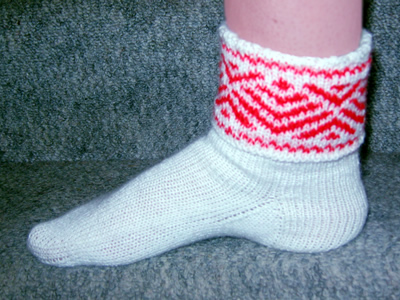
As the nail-biting tournament in South Africa dominates this month, here we have: 1940s sport socks.
I thought they were nicely in England's colours, but not exactly football socks -
I think they mean a nice decorous sport like tennis, don't you?
Red and white is the original colour scheme from the 1940s. (Possibly the original did not include quite such a Dayglo shade of red.) However, the pattern seems vaguely Scandinavian and wintery to me - I could see them perhaps in Christmas colours of a more muted red with green.
Meanwhile... Ingerland, Ingerland, Ingerland...
Instructions.Starting at top with the cuff, using the main colour, cast on
64 stitches on three needles (21,22, 21). 3rd Round: *
k1 contrast (C), k1 main (M); repeat from *
to end of round.
This completes the cuff. Break colour C and continue in main colour only.
Turn the work inside out to make a fold-over cuff and start to work the rounds in the opposite direction. Work in k2, p2 rib for 3 inches [Editor's note: about 30 rows.], decreasing 8 stitches in the last round only, by knitting together every 7th and 8th stitch. Next Round: k2tog, knit to last 2 stitches, k2tog. [54 stitches] Now work in stocking-stitch (knit every round) for 2 inches. HeelKnit 13 stitches of first needle on to third needle (this is the heel needle), then turn and purl back 26 stitches; divide the remaining 28 stitches equally onto the other two needles. Work back and forth over heel needles as follows: 1st Row: slip 1 stitch knitwise, knit
across remaining stitches. Next Row (right side facing): knit across first 16 stitches, k2tog; turn. Next Row: p7, p2tog; turn. Next Round: needle 1: knit across
heel needle, then pick up 14 stitches down left side of heel; needle 2:
knit across next two, needles (thus transferring these stitches on to
one needle); needle 3: pick up 14 stitches across other side of heel and
k4, from needle 1. Hereafter, work in rounds of stocking stitch but, on every other round, k2tog at end of first needle, and (s1, k1, psso) at beginning of third needle until 54 stitches remain. Work straight until piece measures 2 inches less than that required for overall foot length. [Editor's note: This was about 50 rows for my UK size 4 foot. (EU 37, US 6½.] ToeThere should be 13 stitches on first needle, 28 on the second needle, and 13 on the third needle. End of round is centre of sole. Work 1 round, decreasing at each end of second needle, then one round straight. Now there are 13 stitches on first needle, 26 on the second needle, and 13 on the third needle. Next Round: knit to within 3 stitches
of the end of the first needle, k2tog, k1; on second needle, k1, (s1,
k1, psso), knit to within last 3 stitches, then k2tog, k1; on third needle,
k1, (s1, k1, psso), knit to end of round. Repeat the last 2 rounds until 16 stitches remain. Graft the stitches together. Making upSew in all ends. Fold down cuff. |
Materials3ozs Patons Real Shetland Wool. A set of four No 11 needles, pointed at both ends. Tension30 stitches = 4ins Size mattersLength of foot, 9 inches (adjustable). AbbreviationsM is main shade (white). psso: pass the slipped stitch over, (also known as "ssk"; effectively you are "knitting 2 together through back loops"). A Word
|
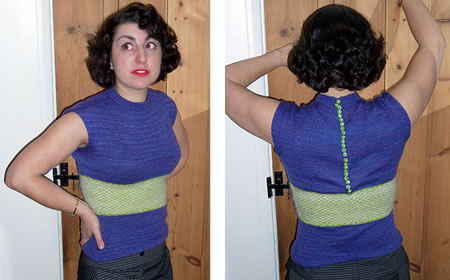
Another beautifully crafted early 1950s recreation by Sara; a neat little design which so suits her figure. Instructions are for one size only, and Sara made hers using Posh Yarns Diana 2ply, which seems to match the tension of the original 3 ply yarn. You might achieve more flexibility in fit and yarn choice if you opt for a standard 4ply instead.
FrontWith No 12 (2¾mm) needles and main shade cast on cast on 120 sts
loosely and work 24 rows in stocking stitch, starting with a knit row.
Make a hem on the next row by knitting 1 stitch from needle together
with 1 stitch from cast-on edge. Change to No.11 needles and work 4 rows stocking stitch, then shape basque as follows: Next row: k33, k2togtbl, k50, k2tog,
k33 Continue decreasing thus on next and every following 6th row until 108
sts. remain. Shape waist as follows: Next row: *k8,
k2tog; repeat from * to last 8 sts,
k8 Begin working the check pattern, introducing the two contrast colours
C1 and C2.
1st row (right side facing): *
k2 C1, k2 C2; repeat from * to end.
Continue in pattern repeating the 4 rows as set above, increasing 1 stitch at each end of the next and every following 6th row. Incorporate the extra sts keeping the chack pattern correct. When work measures 10 inches at centre....
With right side facing, cast on 10 sts at the beginning of the next 2
rows for the sleeves, [150 sts]. Cast off 10, k50; turn and leave remaining sts on a stitch holder. Now decrease 1 stitch at the neck edge on the next 10 rows; then, keep the neck edge straight, but at the same time cast off 5 sts on every alternate row at the armhole edge until all sts are gone. Return to the remaining sts on the stitch holder; slip the centre 30
sts on to a stitch holder, and rejoin the wool to the remaining 60 sts. BackWork as for the front to the end of the check pattern. Work 2 rows in main shade, then divide for back opening. Cast off remaining stitches. Rejoin the wool to the remaining stitches at the centre and work to correspond with the right half of the back. To Make UpPress work on wrong side under a damp cloth. Neck: With right side facing, main shade, and No 12 needles,
pick up and knit 90 sts all round the neck, including 30 sts from the
stitch holder on the front. Join side and under-arm seams; work 2 rows dc round each sleeve edge. Turn back 1 inch of sleeve to form a cuff and catch in position at shoulder and under-arm. [Editor's note: Sara
leaves the sleeves plain after this point - instructions below introduce
additional trim.] Work 3 rows dc down left side of back opening, including neckband, then 3 rows down right side making 24 button loops in 3rd row. Sew on buttons. |
MaterialsOriginal materials called for: 5 ozs Patons Beehive Fingering 3ply in main shade (lipstick red) and 1oz each of grey and white. A pair each Nos 11 and 12 (3mm and 2¾mm) needles. A No 12 (2¾mm) crochet hook. 24 small buttons. Tension 8 sts and 10 rows to an inch. Size mattersOriginal sized for bust 33-34 inch bust; See "adapting the size". Abbreviationsk2tog: decrease by knitting 2 sts together. k2togtbl: decrease by knitting 2 sts together through back loops, sometime called ssk (slip 1 knitwise, slip 1 knitwise, place 2 sts back on left needle and knit 2 slipped sts together through back loops) Crochet abbreviations:ch = chain Remember these are English crochet instructions where dc is equivalent to US single crochet - see "Terminology" in the side bar. A word on the wool.Sara used Posh Yarn Diana 2 ply - about 600 yards for the main colour, and about 90 yards for the green contrast. For the white she used Capricorn Yarns brushed mohair 4 ply. Disclaimer
|
Adapting the size:As with many of these 50s patterns, only one size is given: 33-34 inch bust. The sweater is designed to fit snugly, but probably will not fit most of us. It is designed to be knitted in 3 ply at about 30 sts to 4 inches. You can gain some leeway by changing the yarn - this is a simple shape so it should cope with that - you should check the length you want and adjust the inches you knit accordingly. Sara cleverly converted the pattern to a top down knit on the fly, and this would be ideal to try that that if you are bold enough. |
|
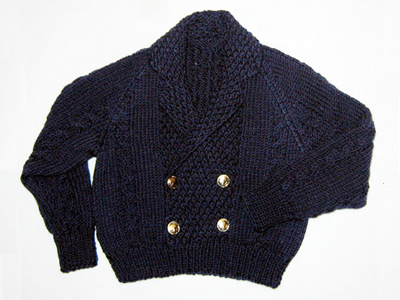
Here is a cute little knitted reefer for a small child (6-24months). It dates from pre 1960s where children's knitwear was not inspiring, but as soon as I saw this I wanted to make it - I am a sucker for any nautical theme, especially for kids (and dolls...)
Instructions.This pattern is given for 2 size options - the instructions for the larger
size are blue bold type in curly brackets. BackWith No 10 (3¼mm) needles cast on cast on cast on 55{61}
sts and work rib as follows: 12th rib row: Rib 3{6}, (increase in next st, rib 6) 7 times, increase in next st, rib to end. [63{69}sts] Change to No 8 (4mm) needles and proceed in cable pattern as follows: 1st row (right side facing): K9{10};
p1, k4, p1; k11{13}; (p1, k4, ) twice,
p1; k11{13}; p1, k4, p1; k9{10}. Continue in pattern until you have completed row 28{32}. Shape raglan: (keep continuity of pattern as you work these rows). [Editor's note: you should be about to begin Row 5 of the pattern sequence for the smaller size and Row 3 (a cable row) for the larger size.] Next row: Cast off 3sts, work to
end. Repeat last 2 rows 18{20} times,
[19{21}sts] FrontWith No 10 (3¼mm) needles cast on cast on cast on 55{61} sts and work rib for the first 11 rows as you did for the back. 12th rib row: Rib 3{6}, (increase in next st, rib 7) 6 times, increase in next st, rib to end. [62{68}sts] Change to No 8 (4mm) needles and proceed as follows: 1st row (right side facing): K9{10}; p1, k4, p1; k8{9}; (p1, k1, ) 8{9} times; k1. Turn and continue working on these 40{44}sts to make the left front (these instructions are intended for a boy - see editor's note below) and slip remaining 22{24} sts on to a stitch holder and leave to work later. [Editor's note: If you want to make this for a girl - maybe in white? - then you will perhaps want to reverse these instructions by working the first 22{24} sts, casting on 20sts and working on these 40{44} sts as written, omitting the button holes. Pick up the rest of the sts to work the right front - and don't forget to work the buttonholes on the right front!] 2nd row: (K1, p1) 9{10} times; purl to the last st, k1. [Editor's note: The centre panel on each of the front pieces is worked in double moss stitch, and I found it convenient to put a stitch marker after I had worked the first 18{20} sts of row 2, to show the limit of this section.] 3rd row: K9{10};
p1, C2B, p1; k7{8}; *
p1, k1; repeat from * to end. Keeping cable and moss stitch panel correct throughout, work 16{20} rows, working buttonholes as before on the 9th of these rows (row 21 for both sizes). Shape raglan: (keep continuity of pattern across the cables and
the centre moss stitch panel as you work these rows). Next row: Cast off 3sts, work to
end. Repeat last 2 rows 10{11} times,
[26{29}sts] ** Keeping continuity of the pattern,
continue to decrease at the armhole edge as before until 18{20}
sts remain of the moss stitch panel. Completing the other side to make the right front: Slip the sts from the stitch holder on to a No 10 needle, point facing
centre of work (right side facing you), and cast on 18{20}sts.
[40{44}sts]. 1st row (right side facing): K2;
(p1, k1) 8{9} times; k7{8};
p1, k4, p1; k9{10}. Shape raglan: (keep continuity of pattern across the cables and the centre moss stitch panel as you work these rows). Next row (wrong side facing): Cast
off 3sts, work to end. Repeat the last 2 rows 10{11} times, [26{29}sts] Next row: Cast off 5sts, work across
in pattern to the last 3 sts, k2tog, k1. Complete to match the left side of front, working from ** to end. Right sleeve:Using No 10 needles, cast on 32{34}sts. Work 13{15} rows in k1, p1 rib. Next row: Rib 3{4}; (increase in next st, rib 4) 5 times; increase in next st, rib to end. [38{40}sts] Change to No 8 needles and proceed in stocking stitch with cable panels set as follows: 1st row (right side facing): K3{3};
(p1, k4, p1, k7{8}) twice; p1, k4,
p1; k3{3}. Continue in pattern as on last 6 rows, increasing 1 st at both ends of
next and every following 6th row, until there are 50{54}sts;
work the extra sts in stocking stitch. Shape raglan by working rows as you did for the back: Next row: Cast off 3sts, work to
end. Repeat last 2 rows 18{20} times,
[6{6}sts] Right sleeve:Work as for the right sleeve, but working C2F instead of C2B. [Editor's note: The sleeves are identical apart from the way the cables twist, and obviously you can choose to sew them into the Reefer in whatever orientation you prefer.] To Make UpBlock each piece from the wrong side, pressing very lightly using a warm iron and a damp cloth, omitting the ribbing. Join side, raglan, and sleeve seams using a flat seam. Stitch down the 20 cast-on stitches at the waist on the inside. |
Materials
|
|
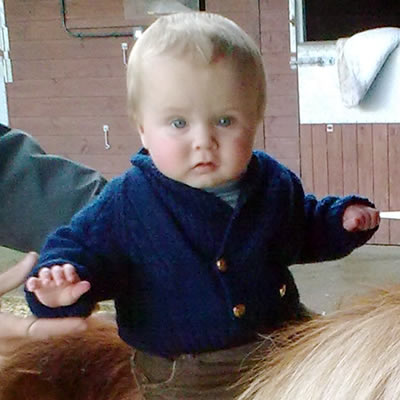
|
|
|
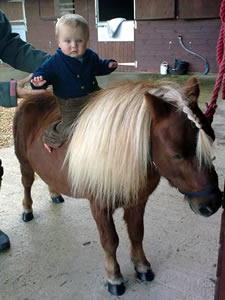
|
|
|
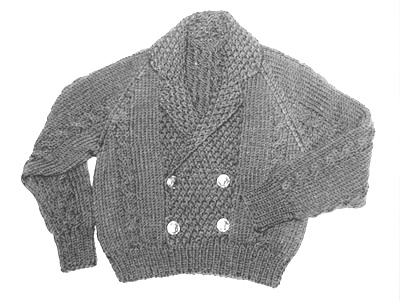
|

Knitted in a light weight yarn and originally designed in the 1950s to wear under or over a sweater with a lower neckline. The original is a "fringed cable yoke" (in case you want to show it off over the sweater) but I have omitted the fringing; I wear it as a convenient alternative to a scarf. The yarn I used is more a 4ply than a 3ply weight so my version is very slightly bulkier and longer than the original.
Instructions.Cables are worked as follows: Cable 8: Slip next 4sts. onto a cable
needle and leave at back of work; k4, then k4 from cable needle. Now begin the yoke, which is worked in one piece. Cast on 288 sts fairly loosely and work in cable pattern as follows: 1st row (right side facing): P4,
* k8, p8; repeat from *
to last 12 sts, k8, p4. Repeat the 1st and 2nd rows 3 times more. 9th row: P4, *
cable8, p8; repeat from * to last
12 sts, cable8, p4. Work 5 rows straight keeping the continuity of the cable rib pattern. 24th row (decrease row): K4, *
p7, k3, k2tog, k2; repeat from * to
last 11 sts, p7, k4. [236 sts] Work 4 rows straight keeping the continuity of the cable rib pattern. 30th row (decrease row): K4, * p3, k2tog, p2, k6; repeat from * to last 11 sts, p3, p2tog, p2, k4. [218 sts] Work 2 rows straight keeping the continuity of the cable rib pattern. 33rd row: P4, * cable6, p6; repeat from * to last 10 sts, cable6, p4. Work a further 2 rows straight keeping pattern as before. Continue thus, working a cable on every 8th row from previous cable, at the same time decreasing alternately in the knit and then in the purl panels, that is: decrease 1 stitch in each of the 15 knit panels on next row, then 1 stitch in each of the 17 purl panels on the following 6th row, omitting the 4 border stitches at each end. Repeat these 2 decrease rows with 5 rows straight between each and always keeping continuity of cable rib pattern until you have worked 10 decrease rows in all, when 113 sts remain and 3 sts remain in each of the knit and purl panels with the 4 border stitches at each end. Work a further 4 rows straight. Next row: P4, * cable3; repeat from * to last 7 sts., cable 3, p. 4. Work a further 5 rows straight in rib, then work another row cabling across the 3 knit stitches as before. Repeat last 6 rows until work measures 8 inches, then work a further 2 rows in rib. Cast off. To work the buttonholes: Optional fringing: To Make UpSew in all ends. |
MaterialsOriginal materials called for: 2 ozs. Patons Beehive Fingering 3-ply. ** A pair of No 12 (2¾mm) needles. TensionOriginal yarn knits 34sts x 42 rows to four inches over stocking stitch on No 12 needles. Substitute yarn knits 27sts x 38 rows to four inches on 2½mm needles. Size mattersOne size. Depth: 8 inches, excluding fringe. **A word on the wool.I used a vintage Phildar yarn called Anouchka (80% acrylic 16%, mohair, 4% wool), in a bright red. It knits to a tension of 27sts x 38 rows on 2½mm needles, and I used No 13 (2¼mm) regardless of tension. CrochetDouble crochet in the UK is equivalent to US single crochet - see "Terminology" in the side bar. Disclaimer
|
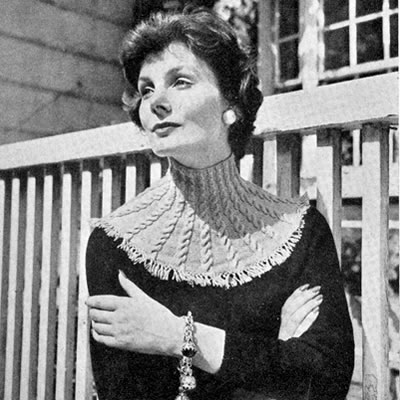 |
|
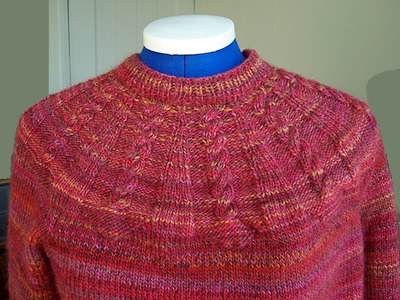
Fabulous sweater-girl look from the 1950s created by Sara.
This is a close-fitting design with some negative ease.
Sara created hers from the top down translating the instructions as she went along; she did not write down her adaptation, but it is far from impossible to convert it dynamically, as Sara did, with this type of design.
Instructions are provided for one size only, but some modifications are possible.
Instructions.The cable over 6 sts is worked as follows: Cable: Slip next 3 sts. onto a cable
needle to back of work; k3, then k3 from cable needle. Back and front alike:With No 11 (3mm) needles cast on 84 sts and work 3½ inches in
k1, p1 rib. Change to No 10 (3¼ mm) needles and stocking-stitch,
increasing 1 stitch at each end of 7th and every following 6th row until
there are 102 sts. Work a second identical piece for the front. Sleeves (make 2):You have the option of log or short sleeves - work one or other set of intructions. Long sleeve: With No 11 needles
cast on 48 sts and work 3 inches in k1, p1 rib. Change to No 10 needles
and stocking-stitch, increasing 1 stitch at each end of 7th and every
following 6th row until there are 76 sts. Short sleeve: With No 11 needles
cast on 66 sts and work 1 inch in k1, p1 rib. Change to No 10 needles
and stocking stitch, increasing 1 stitch at each end of 3rd and every
following 4th row until there are 76 sts. Work straight until sleeve measures
4½ inches, then shape top as for long sleeve. Yoke:You should now have 2 identical pieces for the back and front, and two identical pieces for the sleeves, all on spare needles or stitch holders. With right side facing and the set of No 10 needles..... [Editor's note: If you are using a circular needle, thread the stitches on in the order: sleeve, front, sleeve, back. Put a stitch marker to mark the beginning/end of the round, as front and back look the same. Also remember that the yoke decreases in size until it becomes the neck opening so you may wish to change between lengths of circular needle and finally move to 4 needles as the round becomes smaller.] Work in rounds as follows: 1st round: K5, *
k7, p2, k17; repeat from * ending
last repeat k12 instead of k17. 12th round: K2tog, k2, *
p6, cable, p6, k3, k2tog, k3; repeat from *
to last 22sts, p6, cable, p6, k4. [250 sts] 18th round: K3, *
p6, cable, p6, k2, k2tog, k3; repeat from *
to last 22sts, p6, cable, p6, k2, k2tog. [240 sts] 24th round: K2tog, k1, *
p6, cable, p6, k2, k2tog, k2; repeat from *
to last 21sts, p6, cable, p6, k3. [230 sts] 30th round: K2, *
p5, cable, p5, k2, k2tog, k1; repeat from *
to last 19sts, p5, cable, p5, k1, k2tog. [200 sts] 36th round: K2tog, *
p4, cable, p4, k1, k2tog, k1; repeat from *
to last 16sts; p4, cable, p4, k2. [170sts] 42nd round: K1, *
p3, cable, p3, k2tog, k1; repeat from *
to last 14 sts; p3, cable, p3, k2tog. [140 sts] 48th round: P2tog, *
p1, cable, p2, k2tog, p1; repeat from *
to last 10sts, pl, cable, p2, k.l. [110 sts] Divide stitches onto No 11 needles, 45 across front and 45 across back.
Work 7 rows k1, p1 rib across front of neck; cast off in rib. Work back
of neck in the same way. To Make UpPress parts on wrong side under a damp cloth. |
MaterialsOriginal materials called for: 14 ozs. for long sleeves, 11 ozs. for short sleeves of Patons Moorland Double Knitting**. Example knitted in Twilleys Freedom Spirit DK - 8 x 50g balls - about 900m. 1 pair each of No 11 (3mm), and No 10 (3¼ mm) needles, and a set of 4 No 10 (3¼ mm) needles, or circular needle.[Editor's note: Please see the important notes about the wool used for the modern version, the consequent needle sizes used, and the sizing.] A cable needle. Two press-fasteners. TensionOriginal yarn knits 24sts x 32 rows to four inches on No 10 needles. Substitute yarn knits 22sts x 28 rows to four inches on No 8 (4mm) needles. Size mattersOriginal sized for bust 33-35 inches; length from top of shoulders 20½ inches; sleeve seam: 17 or 4½ inches. See "adapting the size". **A word on the wool.If you have some vintage Patons Moorland DK - you may like to note that I surmise they used this brand name for more than one version of this wool; I have some Moorland from the 1980s and I believe it is a relatively thick DK, which would be hard to contemplate knitting on No10 needles. Sara used Twilleys
Freedom Spirit DK, (120m per 50g ball), which knits as 22sts x 28
rows to 4ins on 4mm needles. See "adapting the size". Disclaimer
|
Adapting the size:The original pattern is for one size: 34-35 inch bust. The sweater is designed to be tightly fitting, and the nominal sweater size is just under 34 ins, so it intends there to be slight negative ease. The original wool and needle sizes indicate a "fine double knitting" wool with a tension of 24sts to 4 inches on 3¼mm (relatively fine) needles. The sizing is a bit small for an average size these days, so moving to a conventional DK wool (22 sts to 4 ins on 4mm needles) makes a nominal size of about 36½ins, making the sweater suitable for up to a 37-38 ins bust. Also - whatever wool and needle size you opt for - note particularly the suggestion to move to a larger needle size when working the yoke. If you increase the size by further gauge changes with thicker wool, you will find that the sweater may be less suited to the close fitting styling, and you lose the 50s "look". |
|
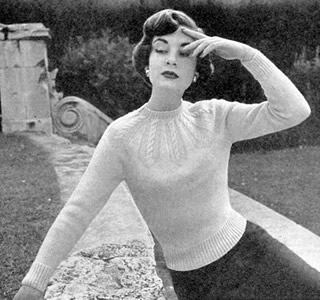
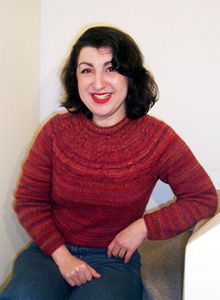
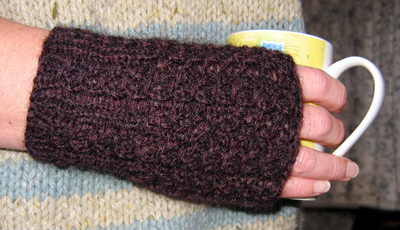
In need of an additional gift that you can speedily knit? - then this is for you. (Unless you live in the tropics, when it would probably never be for you).
I made these mittens to go with the beret Featherbed by Louisa Harding from her book Little Cake. I like Louisa's work, and yarns; however, I made her beret in Rowan Kid Classic as I needed a particular colour, and in consequence had sufficient left to make mittens, using a similar stitch pattern.
Using Kid Classic was fine but made for an even more lightweight beret - I think I would like to try the recommended yarn for a slightly bulkier feel as intended.
The mittens are lovely and warm and .... feathery.
Instructions:(Make two gloves alike) Cast on 36 stitches, arrange evenly over 3 needles. 1st round: *
K3, p1, k1, p1; repeat from * 6 times to
end of round. 5th round: *
Slip1, k2, then pass the slipped stitch over the 2 knitted sts; p1, k1,
p1; repeat from * 6 times to end of round.
[30sts] Repeat rounds 5 through 8 four times more times. 21st round: as 5th. 23rd round: *
K3, p1, k2, p1; repeat from * 6 times to
end of round. 39th round: *
K3, p1, k2, p1; repeat from * 5 times. 40th round: Begin the next round continuing with the waste yarn, and k5. Slip these 5 sts back onto the left needle and knit them again using working yarn. Then finish the round as follows: k1, yon, p1; * k3, p1, k2tog, yon, p1; repeat from * 5 times to end of round. [43sts] 41st round: Slip1, k2, then pass the slipped stitch over the 2 knitted sts; p1, k2tog, k1, p1; * slip1, k2, then pass the slipped stitch over the 2 knitted sts; p1, k2, p1; repeat from * 5 times to end of round. [36sts] 42nd round: * K1, yon, k1; p1, yon; slip1, k1, psso; p1; repeat from * 6 times to end of round. [42 sts] Repeat rounds 23 through 26 twice more. Cast off 42 sts (not too tightly). Work the thumb. Go back to the waste yarn and carefully remove it, placing the resulting
live sts on two double-point needles; there will be 7 Now set off working in a round; starting with the 7 sts below the opening, arrange the sts as follows: Place the first 2 sts on a needle and leave for the end of the round. Join in the yarn and using another needle, k3, p1, then k2tog (the last
of the 7 lower sts and the first of the 8 upper sts), yon, then purl the
second stitch from the upper needle. This is "needle one" and
has 7 sts. 1st round: *
Slip1, k2, then pass the slipped stitch over the 2 knitted sts;
p1, k2, p1; repeat from * once to end of
round. [12sts] Cast off 14 thumb sts loosely. Making up: |
Materials1 x 50g ball Rowan Kid Classic. Small length of waste yarn in contrasting colour, (something slippery like cotton preferably). One set of 4 No. 8 (4 mm) needles. TensionKid Classic knits to a tension of 18sts and 24 rows to 4 inches on 6mm
needles. Size mattersWidth all round above thumb, 7 ins. To alter the size use larger or smaller needles as required. Abbreviationsyon: yarn over needle - makes an extra stitch which forms a small pattern hole when knitted on the next row. psso: pass the slipped stitch over. Effectively you are "knitting
2 together through back loops" Disclaimer
|
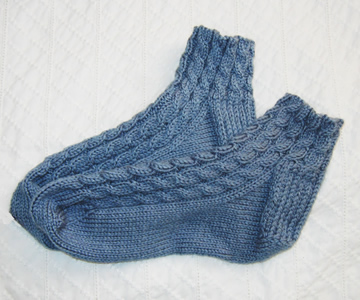
Father George recently handed back his bedsocks as they had holes in the heels. I dutifully mended them, but thought this a good excuse to give him another pair.
These socks are one size, but easily stretch to fit comfortably around a man's foot, as well as fitting round my own foot (small lady's), albeit loosely. If you want cosy house socks for a female foot then simply adjust the length. These are intentionally short at the ankle, but again you can easily knit them longer for the size you need.
InstructionsWith No. 9 needles, cast on 60 stitches loosely, and arrange over 3 needles. 1st round: *
K4, p2; repeat from * to end of round. These are the six basic pattern rounds. Repeat these six rounds twice more, (or as many times as you need to
lengthen the sock at the ankle), and then the first round once again. Divide for heel flap. Next Row: Knit the first 28 sts of the round on to one needle to work for the heel. Divide the remaining 32 sts across 2 needles, and leave to work the instep later. If you have worked the pattern correctly there will be a symmetrical set of complete cables across the 32 instep sts, starting and ending with p2. Return to your heel sts, and turn the work so that you can work back and forth across the heel sts using 2 needles. Next Row: Slip1 purlwise then purl
across the remaining 27 sts. [28 sts]. Repeat the last 2 rows 12 times more. Turn the heel. Work short rows as follows: Next Row: Slip1 purlwise then purl
across 15sts, p2tog, p1. Turn Continue working in this way until all the sts have been incorporated [16sts], ending with a knit row, and right side facing. Continuing to work onto the same needle (needle 1), pick up and knit
15 sts along side of heel. [Editor's note: I
am not one to encourage a sloppy attitude to knitting, but... Shape the instep: 1st round:
1st needle: knit to the last 3sts, k2tog, k1. Repeat these two rounds until 60sts remain (14 on the first needle, 32 on the second needle, 14 on the third needle). Continue on these sts, (continuing the cable pattern on the upper foot
as set), until you have completed 12 cable patterns from the very beginning
of the work, or until work measures 2 inches less than the desired foot
length. Shape toe: Continue in stocking stitch only (no more cables), as follows: knit the sts from Needle 1, then knit the first st from Needle 2 and put it on Needle 1. Knit 30 sts from Needle 2, then place the last st onto Needle 3. Knit across 15 sts on Needle 3. 1st round:
1st needle: knit to the last 3sts, k2tog, k1. Repeat these 2 rounds until 32 sts remain, ending with 1st round. Then repeat round 1 twice more [24 sts]. Making up. Knit the sts from needle one, break the thread leaving a long tail. Graft
the two sets of 12 sts together. Make a second sock to match. |
MaterialsAbout 1 x 50g skein (139 metres) Phildar
Oxygene, colour 38, Neptune. One set of 4 No. 9 (3½mm) double- pointed needles. Tension23 sts x 30 rows to 4 inches measured over stocking stitch on No 9 (3½mm) needles. Size mattersThe pattern as written should fit a foot of 11 inches in length. AbbreviationsC4B: "cable 4 back"; slip the next 2sts onto a cable
needle and leave at the back of the work, k2, then k2 from cable needle. psso: pass the slipped stitch over. Effectively you are "knitting
2 together through back loops" Disclaimer
|
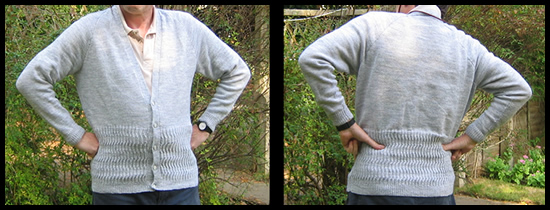
No - really - the boyfriend....
I say this as, had you seen the modelled photo from the 1970s, it may have led you to wonder. The orginal cerise colour in combination with the lacy pattern seems to be a bit feminine - but - hey! - we were looking at the beginnings of the "New Man" in the 1970s, right? (but it looks just perfect on my "old" man).
Sad to say, I think I possess the actual original yarn in the suggested (pink) colour for this pattern, but I chose to style it in an elegant pearl grey, using a practical superwash wool blend.
Obviously it could be made to suit a man or a woman.
Instructions.This is a raglan cardigan, designed for a man and given in 3 sizes. Main size is given for a 40 inch chest and other 2 sizes are given in brackets. Pattern:The twisted rib pattern is worked over 24 rows as follows: 1st Row: S1, k1, *
p2, k2; repeat from * to end. Back:Using No 12 needles, cast on 153 {161 : 169} sts. 1st Row: S1, k1, *
p1, k1; repeat from * to last stitch;
k1. Repeat the first and second rows 7 times more, then the first row once. 18th Row: S1, *
inc once in the next stitch purlwise; (k1, p1) 3 times; k1 *
; Change to No 10 needles. Next Row: S1, * k2tog, k7 *; repeat from * to * 8 times; k2tog, k2{6 : 10}; k2tog; k2{6 : 10}; repeat from * to * 8 times; k2tog, k6, k2tog, k2. [153 {161 : 169} sts] Next Row: S1, purl to the last st, k1. Continue in st-st until work measures 17 {17 : 18} inches, ending with a purl row. Shape Armholes: Right Front.Using No 12 needles cast on 83 {87 : 91} sts. 1st Row: S1, k1, *
p1, k1; repeat from * to last stitch;
k1. Repeat the first and second rows 7 times more, then the first row once Slip the last 12 sts of the row on to a stitch holder or safety pin to continue the front border later. Turn and continue knitting the right front on 78 {82 : 86} sts. Change to No 10 needles, and work the 24 rows of the pattern three times, then the first 6 rows again, as you did for the back. Next Row: S1, (k2tog, k10) twice;
k2tog, k11{13 : 15};
k2tog, k11{13 : 15};
k2tog, k10, k2tog, k9, k2tog, k2. Next Row: S1, purl to the last st,
k1. †† Continue in stocking stitch until work measures the same as the Back Shape Armhole: Work 82 {82 : 78}
rows decreasing once at the front edge on the next and every following
10th row - and at same time decrease once at the armhole edge on
the next and every alternate row. For the largest 44 inch size, work 4 more rows, decreasing once at the front edge on the 3rd row and at the same time decrease once at the armhole edge on every row. [19 sts] For the small (40 inch) and medium (42 inch) sizes, work 12 {4}
rows decreasing once at the armhole edge only on the next and every alternate
row. [7 {15}sts]. Then work a further 4 {12 : 16} rows decreasing once at the armhole edge only on every row. [ 3 {3 : 3} sts] Next Row: S1, k2tog. Left Front:Using No 12 needles cast on 83 {87 : 91} sts. 1st Row: S1, k1, *
p1, k1; repeat from * to last stitch;
k1. Repeat the first and second rows 4 times more. 17th Row: S1, k1, * p1, k1; repeat from * to last 12 sts. Slip the last 12 sts of the row on to a stitch holder or safety pin to continue the front border later. Turn and continue knitting the left front on 71 {75 : 79} sts. 18th Row: S1, *
inc once in the next stitch purlwise; (k1, p1) 5 times, *;
Change to No 10 needles, and work exactly as given for the Right Front until †† is reached. Continue in stocking stitch until work measures the same as the Back Shape Armhole: Complete as given for the right front, reversing all shapings.
Sleeves:Using No 12 needles cast on 63 {63 : 67} sts. 1st Row: S1, k1, *
p1, k1; repeat from * to last stitch;
k1. Change to No 10 needles, and proceed in stocking stitch, increasing one stitch at each end of the 5th and every following 6th row until there are 109 {109 : 113} sts on the needle. Continue without further shaping until the work measures 19 inches, ending with right side facing for the next row. Shape Top: Work 44 {44 : 36} rows, decreasing 1 st at each end of the next and every folowing 4th row. [ 71 {71 : 79} sts] Then work 56 {56 : 64} rows, decreasing 1 st at each end of the next and every alternate row. [ 15 {15 : 15} sts] Cast off. Making up:Press pieces gently under a damp cloth according to the instructions
on the yarn ball-band. Right front border:Place the 12 sts from the welt of the right front (kept on a safety pin) back on No 12 needles. With wrong side facing, rejoin the yarn and commence the rib as follows: Next Row: Inc in the next stitch purlwise, k1; (p1, k1) 5 times. Next Row: S1, k1, *
p1, k1; repeat from * to last stitch;
k1. Repeat the last two rows over the 13sts until border is of sufficient Left front border:Place the 12 sts from the welt of the left front (kept on a safety pin)
back on No 12 needles. With right side facing, rejoin the yarn and commence
the rib as follows: Next Row: S1, *
p1, k1; repeat from * to end. Repeat the last two rows over the 13sts placing buttonholes at desired
intervals as follows: Next Row (wrong side of work): S1,
(p1, k1) twice, p1; cast off 2 sts; (p1, k1) twice. Continue in rib until border is of sufficient length to go up front, across sleeve top and halfway across back of neck. Cast off in rib. Completion:Sew ends of borders together. Sew borders to front edges. Sew on buttons to correspond with button holes. |
Materials4 ply: 9 : 10 : 11 50g balls [Editor's note: I used ony 7 balls of Luxe - see "Word on the Wool" below] 1 pair of No 10 (3¼mm) and 1 pair of No 12 (2¾mm) knitting needles. 5 buttons. Tension30 stitches to 4 inches over stocking stitch. Size mattersTo fit 40:42:44
inch chest; actual size 41:43:45
inches. Abbreviationsinc: increase in the next stitch by knitting (or purling) twice into it. yrn/yon/yfwd: yarn round needle / yarn over needle / yarn forward. Makes an extra stitch which forms a small pattern hole when knitted on the next row. k1tbl: knit through back loop of the stitch. This has the effect of twisting the yrn or yon stitch that you made, making it tighter. s1: slip one stitch. psso: pass the slipped stitch over. Effectively you are "knitting
2 together through back loops" A Word
|
Here, George tries to emulate the original model's pose. Sadly, he is inhibited by the lack of a Hendrix hairstyle and droopy moustache.
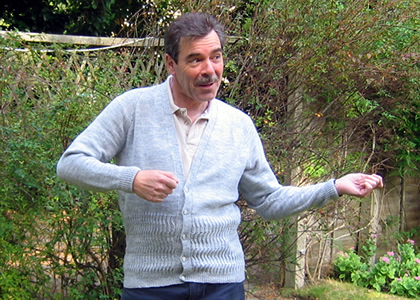
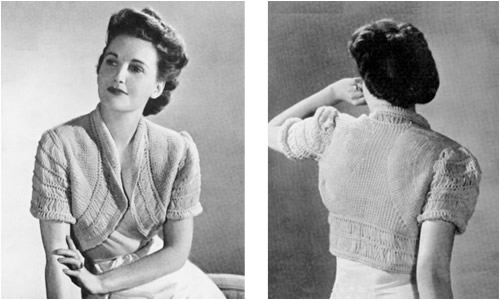
I cannot do better than quote the original introduction from the 1940s.
"The charm of this little bolero is that it makes either a dainty bed-jacket, or attractive Angora coatee, for day or evening wear. The pretty shape makes it fit beautifully and you will find the openwork sleeves and border simple and quick to do."
I will add that you should choose your colours and styling carefully, otherwise its roots as a bed-jacket may be too obvious. When I knitted Rowan's Carolina by Sharon Miller in pale blue/grey - which is lovely in my opinion - I find myself unable to wear it as day wear and feel it needs to be in a more striking colour for evening wear. (Matches my pyjamas nicely though...)
Note that this pattern is untested, and reproduced here as per the original.
Instructions.The body of the bolero is worked in fancy rib over 2 rows as follows: 1st Row: Knit. BackCast on 84 stitches and work in ribbed pattern as above. Now cast off 1 stitch at beginning of every row till 16 sts remain. Work 20 rows straight. Continue to work in pattern but increase 1 st at each end of the next
and every following 3rd row until there are 26 sts on the needle. Side PiecesUsing three needles, pick up and knit 110 stitches up right side of back
piece, then cast on 122 stitches. Arrange the sts as follows: Join into a round and work 20 rounds in pattern. Next Round: *
k2, k2tog; repeat from * to end. Work second side to correspond. BorderWith five needles, using 2 strands of wool together, and right side facing, pick up and knit 42 stitches across lower edge of back, 60 stitches round right side, 13 across back of neck and 60 stitches round left side. 1st Round: Knit. Repeat 12th and 13th rounds, then 12th round again. SleevesStarting at the top with two needles and double wool, cast on 36 stitches and knit 4 rows garter stitch (every row knitted). † Repeat from † once, then 5th row again. Next Row: Cast on 6 stitches, knit
to end, dropping all loop stitches. † Repeat from † once, and then
again omitting decreasings. Making upPress very lightly only. |
MaterialsOriginal quoted 5ozs Beehive Non-Shrink Baby Wool 3ply. Five No 7 (4½mm) double-pointed needles, or one pair of needles and a circular needle. No 8 (4mm) crochet hook. [Alternative 9 (½ oz) balls Patons Fuzzy-Wuzzy Angora and five No 8 (4mm) needles] Tension28 stitches to 4 inches over pattern rib in back; 40 stitches to 4 inches
over pattern rib in side pieces. Size mattersTo fit size 32-36 inch bust; length from top of shoulder to lower edge,
16 inches; sleeve seam, 4½ inches. Abbreviationsk2tog: knit 2 sts together (decrease). dc: double crochet remembering that this is UK notation, and in the US is referred to as single crochet. ch: chain A Word
|
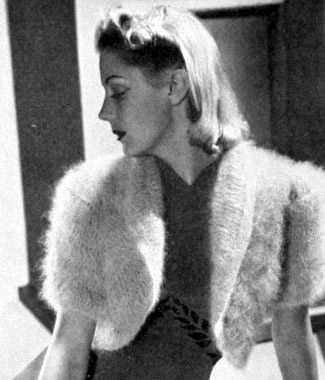
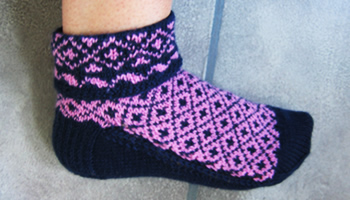
Early 1950s tennis socks originally knitted in crisp navy and white wool. I love cuffed socks but detect that some others (my sister) clearly do not. These have the design made specifically to fold down though - so there's no way out.
Instructions.The pattern works the instep and the sole separately on two needles to enable you to work the fair isle pattern across the instep only. It is not possible to achieve this in the round. However, you join the two together as you knit. Using No 12 needles with main shade (M), cast on 59 sts loosely and join in a round. Work 4 rounds in moss (also known as seed) stitch [every row k1 p1]. Next Round (increasing): K3; (m1, k8) 7 times. [66 sts] Cuff border:Change to No 11 needles and join in contrast (C) and work wave pattern border by repeating the 6 stitch pattern 10 times:
1st Round: *
k3 contrast (C), k3 navy (N); repeat from *
to end. Now continue with cuff diamond pattern, repeating the 8 stitch pattern 8 times across one round:
6th Round: *
k1(C), k2(N), k1(C), k2(N), k2(C); repeat from *
to end. Now break off C and continue with N only; change to No 12 needles and work 7 rounds knitting. Then turn the work so you are working the rounds in the other direction. This reverses the work to allow the cuff to fold over with the right side visible. Work 8 more rounds knitting; at the end of the first round knit into
the stitch below the first stitch of the round and knit it together with
the last stitch of the round to avoid a small hole in the work. Join in C, working main diamond pattern, repeating the 8 stitch pattern 8 times:
1st Round: *
k1(N), k2(C), k1(N), k2(C), k2(N), ; repeat from *
to end. These 8 rows form the pattern. Continue with N only and divide for the heel, however do not break off C. Divide for heelNext Row: Using navy wool only, knit the next 31 stitches on to one needle to work for the heel. Divide the remaining 33 sts across 2 needles, and leave to work the instep later. If you have worked the pattern correctly there will be a symmetrical set of complete patterns across the 33 instep sts. Make sure that it looks like this (you will have just completed row 5, the middle row in the picture):
[ Editor's note: If it doesn't look like this... you can compensate by knitting more or fewer sts for the heel flap until you get to the pattern boundary. Then when you purl back on the row below, follow the instructions as set to get your 30 sts. You should have your instep sts set correctly as above. If you still haven't then there is likely a mistake in your fair isle pattern.] Return to your heel sts, and turn the work so that you can work back and forth across the heel sts using 2 needles. Next Row: Purl back across 15 sts,
p2 together, purl remaining 14 sts. [30 sts]. Heel flapNext Row: *
Slip 1, knit 1; repeat from * across
all 30 sts. Repeat last 2 rows 13 times more. Turn heelTurn the heel by working short rows: Next Row: Slip the first stitch,
p16, p2tog, p1; turn. Continue in this way until all the sts have been incorporated in the row, ending with a knit row. [18 sts] Turn. Purl one row. Pick up and purl 16 sts down side of heel flap to bring the navy wool back to work the patterned instep. Leave these 16 sts along with the 18 heel sts, on a spare needle or stitch holder. Upper foot panelTake 33 sts left on needles 1 and 2, and slip them on to one needle. Continue to use the navy yarn and pick up the contrast C, which should
be waiting for you at the beginning of a purl side instep row (row 6 of
the pattern). Begin working back and forth across these 33 sts, keeping
the continuity of the pattern starting with a purl row and working from
row 6 of the chart where you left off; work alternate rows in knit and
purl. Continue for 5½ inches or 4 inches less than overall desired foot
length, ending with a knit row. Break contrast yarn, and continue in navy only. Turn the work and purl across 15 sts; p2tog; p16. Continue with wrong side facing, using another No 12 needle, pick up
and purl about 27sts from the slipped sts down the right side of the upper
foot panel, and from the edges of the first 5 rows you knitted. Using the same No 12 working needle, pick up and purl 17 sts from side of heel flap, then purl 9 sts from the heel. Using another No 12 working needle, purl the 9 remaining heel sts, and then purl the 16 sts you already picked up from the other side of the heel flap. Mark the stitch with a piece of waste wool, as before. Continuing with this needle, purl along the left side of the upper foot panel, picking up 27 sts from the edges of the first 6 rows you knitted and from the slipped edge sts.
The work is arranged on 3 needles. The picture shows the working needle
in the process of knitting across the sole,
and the waste wool markers in white. Purl across the 32 sts at the top of the panel. Then using one of the
spare needles, purl down the right side of the panel again, as far as
the stitch marker.] Do not turn the work. SoleUsing the No 12 working needles, you are going to knit back and forth across the sole (between the markers) in stocking stitch, knitting the last stitch from each row together with one stitch from the upper foot panel. 1st Row: (Wrong side facing) Slip1,
p24 from first needle, (16 sts up side of heel and 9 sts from heel flap),
then purl 24 sts from second needle, up to 1 stitch before the stitch
marker. Purl the last stitch of the sole section together with the first
of the instep sts. [50sts between the markers] 2nd Row: (Right side facing) Pass
the waste wool marker between the sts. Slip 1, ssk2tog; knit to the last
3 sts before the marker; k2tog, ssk the last stitch of the row together
with the next instep stitch as before. [48sts between the markers] Turn. Repeat 2nd and 3rd rows, shaping the sole by decreasing 2 sts on the knit rows, until 28 sole sts remain between the markers. Then continue without shaping as follows (continuing to weave in the markers as before): Next Row: Slip 1, purl to the last
stitch before the marker; purl together the last of the sole sts with
the first instep stitch as before. Repeat the last 2 rows until all the sts from the sides of the upper
foot have been joined to the sole. Do not join any of the sole sts to
the 32 sts left on the 4th needle at the end of the panel. ToeNow you continue to work the sole and upper foot sts together in a round, as follows: With right side facing, using your working needle (needle 1), knit across
32 sts from the upper foot. Knit the next 14 sts from the sole on to the
next needle (needle 2), and knit the final 14 sts from the sole on to
the next needle (needle 3). You have 60 sts arranged with 30 sts on needle 1, and 15 sts on each off needles 2 and 3. Continue to work in rounds as follows: [ Editor's note: This is where you can adjust the length of the foot if your feet have not grown to a multiple of half inches. Work a couple of extra plain rounds here before starting the decreasing.] 1st Round: Needle 1: k1, ssk2tog;
knit to the last 3 sts; k2tog, k1. Repeat rounds 1 and 2 until 24 sts remain. Slip the sts from needles 1 and 2 on to one needle and graft together with the sts on needle 3. Making upSew in all ends. Fold down cuff. |
Materials4 ply: 2 ozs navy, 1 oz contrast colour. One set each of 4 double pointed needles (dpns) size 11 (3mm) and 12
(2¾mm). Tension30 stitches and 32 rows to 4 inches over pattern. Size mattersLength from top to bottom of heel, top turned down, 5 inches; length of foot 9 inches (adjustable). AbbreviationsN is main shade (navy). m1: make one by picking up the loop between sts and knitting into the back of it ssk/ssk2tog: (slip, slip, knit) - or (slip1, knit 1, pass the slipped stitch over). Effectively you are "knitting 2 together through back loops".
A Word
|
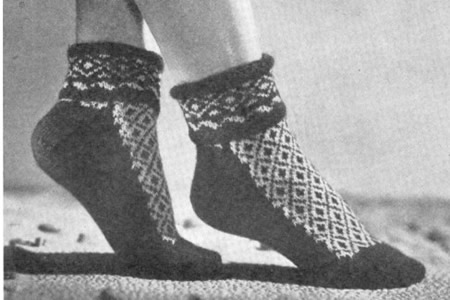
Original photo from Stitchcraft April 1950, constructed using a different pattern on 2 needles with seam under sole. Generally, seams in socks are avoided so they are more comfortable to wear; a seam right under the ball of the foot cannot be ideal as sportswear. I imagine these socks were for visual impact rather than practicality.
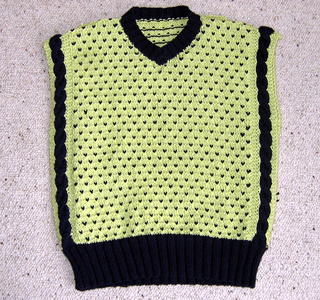
I really liked the look of this vest top from the 1980s. I thought it would suit me, as it is sleeveless, and suitable to team with wide pants (as were popular in the eighties - and I am told are suitable for my current age and shape!).
The original was made in a flecked wool, and I did not notice that it was dotted all over. So having made the discovery of the dots, I like it even more.
The dots add to the complexity when knitting, but the shape is very simple and quick to knit.
Instructions.This pattern is worked in several sections including intarsia techniques, (to insert the vertical colour for the cable stripes); and jaquard (to make the dots). For the cables, and edge stitches, do not strand yarn across wrong side of work, but use separate balls: this will be 2 bobbins for the Navy cables and 2 bobbins for the Citron edge stitches. Twist the colours on wrong side where they meet to avoid a hole. Use your main ball of wool for the centre section in Citron (main
shade), again twisting it where it meets the navy cable bobbin. Here is a picture of the wrong side of the work:
[ Editor's note: Yes this does mean you have to sew in all those ends ]
Back:With No 10 needles and contrast colour, cast on 70 [74, 78, 86, 90, 94, 102, 106, 114] sts and work in K2, P2 rib for 3 [3, 4, 4, 5, 6, 6, 6, 6] cm, (rows on right side having K2) at each end. End with right side facing for next row and increase 1 st at end of last
row (71 [75, 79, 87, 91, 95,
103, 107, 115] sts). These 8 rows form the pattern. Continue in pattern until back measures 34 [37, 41, 43,
46, 48, 49, 51, 51] cm, ending
with right side facing for next row. Front:Work as for back until front measures 26 [29, 33, 35, 37, 39, 39, 41,41] cm, ending with right side facing for next row. Keeping continuity of the pattern, divide for neck as follows: Pattern 33 [35, 37, 41, 43, 45, 49, 51, 55] sts, k2tog, turn and leave remaining sts on a spare needle. Continue on these 34 [36, 38, 42, 44, 46,
50, 52, 56] sts for first side, decrease 1 stitch at neck edge
on every row until 30 [30, 30, 34, 38, 40,
40, 42, 44 ] sts remain, then on every alt row until 23 [24,
25, 29, 30, 32, 35, 36,
39] sts remain. 1st, 2nd, and 3rd sizes: All sizes: To Make UpDo not press. Join right shoulder seam. Left Neck Border:With right side facing, using No 10 needles and Contrast, knit up 30 [30, 30, 34, 38, 38, 42, 42, 42] sts down left side of neck and work 7 [7,9, 9, 9, 9, 11, 11, 11] rows in p2, k2 rib, rows on wrong side having a p2 at each end. Cast off evenly in rib. Right Neck Border:With right side facing, using No 10 needles and Contrast, starting at
centre front, knit up 30 [30, 30, 34, 38, 38,
42, 42, 42] sts to shoulder. Knit across 25 [27, 29, 29,
31, 31, 33, 35, 37] sts from
back of neck increasing 3 [1, 3, 3, 1, 1,
3, 1, 3] sts evenly (58 [58, 62, 66, 70, 70,
78, 78, 82] sts). Join left shoulder, then sew border in position, placing right over left. Press seams. Sew on button at neck. |
MaterialsPure wool double knitting 50g balls: 2 [3, 3, 4, 4, 4,
4, 5, 5] in main shade, and, 1 [1, 2, 2, 2, 2,
2, 3, 3] in contrast. Cable needle. 1 button. Tension22 sts x 30 rows to four inches on 4mm needles in stocking stitch. Size mattersTo fit chest/bust 24 [26, 28, 30, 32, 34,
36, 38,40] inches; length from top of shoulders 13½ [14½,
16, 17, 18, 19, 19½,
20, 20] inches. A Word
|
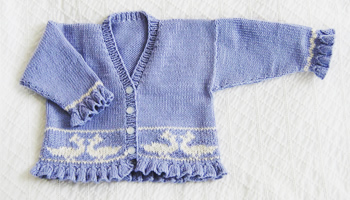
Cute cardigan for a little girl with folk pattern of birds. Acceptable enough for a baby boy using a "masculine" colour (blue?!) and adapting the welts from their frilly form to a conventional rib.
Instructions:The body of the cardigan is knitted in one piece. There are options for a plain welt as well as the frilled version - perhaps to better suit a boy. Frilled welt: 1st row: *
P2, k7; repeat from *to last 2 sts;
p2. Alternative plain ribbed welt: 9th row: K31, place marker; k62, place marker; k31. Duckling border: Starting with wrong side facing, set the 31 stitch pattern across the
row as follows: Row 1: *p1 in blue, p29 in white, p1 in blue*; p0; repeat from * to * twice; p0; repeat from * to *.
Row 15: as row 1. Next row: (right side facing) Knit
in main shade. Continue with main shade only stocking stitch until work measures 6 inches,
including the frill, ending with a purl row and right side facing for
next row. Divide for fronts and back: Next row: Purl. Repeat the last 4 rows, decreasing at front edge only until 21 sts remain.
Continue without shaping until armhole edge measures 5 inches, ending
with a purl row. Left front: Next row: Knit. Repeat the last 4 rows, decreasing at front edge only until 21 sts remain.
Complete to match the right front, ending with a knit row. Back: Work straight in stocking stitch until back matches fronts at armhole edge, ending with a purl row. Next row: K21, cast off 20, k21. Join shoulders. Sleeves (both alike): 1st row: *
P2, k7; repeat from *to last 2 sts;
p2. Alternative plain ribbed welt: Now join in contrast and work 3 rows as follows. Continuing in main shade only, increase one stitch at each end of the next and every following 4th row, until there are 61sts. Work straight until sleeve is 8 inches long (including the frill), or to required length. Cast off loosely, using one size larger needle. Work second sleeve the same. Button border: [Editor's note: My
method for picking up sts evenly is to pick up 2 sts for every 3 row ends.
I use a double pointed needle and slip it into all the alternate row ends
- the ones that tend to stick out more as little bumps. Then using my
working needle, I knit into 2 bumps from the dpn and then pick up an extra
stitch in between the bumps. Next row: Slip the first stitch;*
k1; p1; repeat from * to last st;
k1. Work one more row in rib, then cast off loosely in rib, using a larger size needle if required. Making up: Press lightly with a damp cloth. |
Materials 3 x 50g balls Debbie
Bliss Baby Cashmerino (125m per 50g ball), in main shade (colour shown
Lavender 605). One circular No 9 (3½mm) needle. Tension24sts and 32 rows to 4 inches on No 9 (3½mm) needles in stocking
stitch. Size mattersInstructions for 6-12 months size. A word on the woolDebbie Bliss Baby Cashmerino is a lovely yarn, (55% merino wool, 33%
microfibre, 12% cashmere). Disclaimer
|
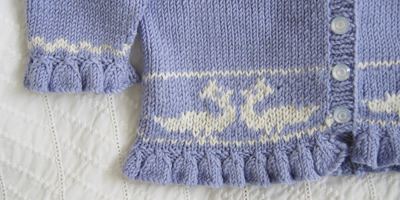
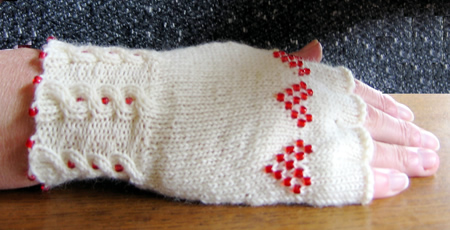
I was inspired to make these mitten patterns by brightly coloured offerings from 1975. This is the posh version, even cuter than the intarsia version I think.
They are a close fit on my hands, but though my hands are small, I tend to have short fingers only; the measurement around my hand is just over 7 inches.
Instructions:Begin working the RIGHT GLOVE: Thread 12 beads on to the yarn. Cast on 48 stitches, using "backward loop method" as follows: loop 2, slide a bead up next to the loops; loop 4, slide next bead into place; slide next bead into place; and so on to the last bead and then end with loop 2 [48 loops].
Knit one row. Begin fancy rib as follows: 1st round: *
P1, k2, p1, k2, p2; repeat from * to end
of round. 6th (cable) round: *
P1, CB5 (cable over 5 sts "back" by slipping the next 3 sts
on to a cable needle and leaving at the back of the work; k2, then (p1,
k2) from cable needle), p2; repeat from *
to end of round. Thumb gusset 1st round: K24, p1, k2, p1, k20. Now set aside the thumb stitches and continue with the main glove - at the same time work the first row of the pattern from the chart, setting the position of the beaded hearts as follows, repeating the 9 pattern sts 3 times: Row 1: K4; hook bead and slip this
beaded st, passing the yarn behind, and pulling it firmly as you go into
the next st; (k8, hook bead) twice; k5; slip the next 18 sts on to a safety
pin; cast on 2 sts, k24 to complete the round. [54 sts]
Continue straight, working from the chart for the 9 rows, and completing the three hearts. Row 10: K1, m1, k52, m1, k1. [56 sts] Work 4 rows straight. Divide for fingers Next round (forefinger): Knit
the first 20 sts of the round and place on a stitch holder; place the
last 20sts of the round on a second stitch holder; Knit 16; cast on 2
sts. [18 sts] Next round (middle finger):
Slip the last 7sts on the first stitch holder (the ones nearest to the
forefinger) onto a needle and knit them; pick up and knit 2 from the cast
on sts at the base of the forefinger; slip the first 7sts on the second
stitch holder (the ones nearest to the forefinger) onto a needle and knit
them; cast on 2 sts. [18 sts]. Next round (third finger): Work and complete as for middle finger. Next round (little finger):
Pick up 2 sts at the base third finger; slip the remaining 6 sts on the
second stitch holder onto a needle and knit them; slip the remaining 6
sts on the first stitch holder onto a needle and knit them. [14sts] Thumb: LEFT GLOVE: Thread 12 beads on to the yarn, cast on 48 stitches, and knit one row,
as for right glove. Begin fancy rib as follows: 1st round: *
P2, k2, p1, k2, p1; repeat from * to end
of round. 6th (cable) round: *
P2, CF5 (cable over 5 sts "forward" by slipping the next 2sts
on to a cable needle and leaving at the front of the work; k2, p1, then
k2 from cable needle), p1; repeat from *
to end of round. Thumb gusset You work the thumb gusset in the same way as you did for the right glove, but set the position of the thumb differently as follows: 1st round: K20, p1, k2, p1, k24. Continue in this way as for right glove, but following the stitch layout as set until you reach row 25. 25th and 26th rounds: K23, p1, k18, p1, k27. [70 sts] Now set aside the thumb stitches and continue with the main glove - at the same time work the first row of the pattern from the chart, setting the position of the beaded hearts as follows, repeating the 9 pattern sts 3 times: Row 1: K24; slip the next 18 sts
on to a safety pin; cast on 2 sts; k5; hook bead and slip this beaded
st, passing the yarn behind, and pulling it firmly as you go into the
next st; (k8, hook bead) twice; k4. [54 sts] Once you have set the position of the thumb and the bead hearts, you can work the rest of the left glove exactly as for the right glove. Making up: |
MaterialsExample shown is knitted in 1 x 50g ball Sunbeam St Ives 4 ply in cream 3103. One set of 4 No. 12 (2½ mm) needles. A tiny crochet hook for placing the beads. 66 beads size 6/0 TensionApprox. 32sts and 44 rows to 4 inches on No 12 needles. Size mattersWidth all round above thumb, 7 ins. To alter the size use larger or smaller
needles as required. A word on the woolThe wool I used was from my store room. BeadingFor those of you who think "Less is More" you might prefer to work a single bead heart, positioned on row 20, with the first bead on the 7th st from the edge. Disclaimer
|
Cast on loop method |
|
Hooking Beads.This method means you don't have to pre-string the beads on your yarn - I think it is good for placing a few beads amid a lot of knitting, when you don't want to carry just a few beads across miles of yarn before you use them, and you also don't want to break your thread. This information appeared in Knitty.com. (Spring 2006 edition) in an article by Sivia Harding.
|
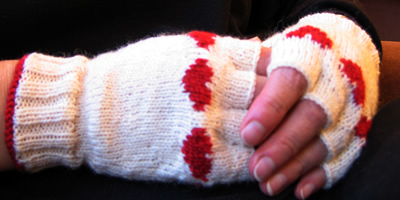
I was inspired to make these mitten patterns by brightly coloured offerings from 1975. By the time I had tried out a number of versions - and had many more examples of right-hand gloves than I want or need - my final designs differ substantially from the original. But they are cute aren't they?
They are a close fit on my hands, but though my hands are small, I tend to have short fingers only; the measurement around my hand is just over 7 inches.
Instructions:Begin working the RIGHT GLOVE: Using contrast colour, cast on 48 stitches; purl one row, and join into a round. Change to main colour and knit one row. Thumb gusset 1st round: K24, p1, k2, p1, k20. Now set aside the thumb stitches and continue with the main glove as
follows: Work 2 rounds straight. Cut 6 lengths of contrast wool, about 28 inches in length, and 6 of main
shade; do not use bobbins, just the lengths of wool.
Row 1: K4 from the ball of main shade, k1 using first strand of contrast yarn, k8 using first strand of main shade, k1 contrast using second strand of contrast, k8 using second strand of main shade, and so on the the last 4 sts; k3 in last strand of main shade, slip the last st. Still using the last working needle, pick up the st below the first st of the round and knit into it, then pass the slipped st over this st. Turn the work. [Editor's note: Use the pop-up from the above picture for more detailed photos of this technique.] Row 2: P3 in main shade, p3 in contrast,
p6 in main shade, and so on; use the intarsia method
and twist the two yarns together when you change colour. Continue in this
way until you get to the last stitch in the row, and slip this stitch.
Still using the first working needle, pick up the st below the last st
of the round and purl into it, then pass the slipped st over this st.
Turn the work. Now go back to working in the round, and continue in main shade only,
using the main ball of wool. Divide for fingers Next round (forefinger):
Knit the first 20 sts of the round and place on a stitch holder; place
the last 20sts of the round on a second stitch holder; Knit 16; cast on
2 sts. [18 sts] Next round (middle finger):
Slip the last 7sts on the first stitch holder (the ones nearest to the
forefinger) onto a needle and knit them; pick up and knit 2 from the cast
on sts at the base of the forefinger; slip the first 7sts on the second
stitch holder (the ones nearest to the forefinger) onto a needle and knit
them; cast on 2 sts. [18 sts]. Next round (third finger): Work and complete as for middle finger. Next round (little finger):
Pick up 2 sts at the base third finger; slip the remaining 6 sts on the
second stitch holder onto a needle and knit them; slip the remaining 6
sts on the first stitch holder onto a needle and knit them. [14sts] Thumb: LEFT GLOVE: 1st round: K20, p1, k2, p1, k24. Continue in this way as for right glove, but following the stitch layout as set until you reach row 25. 25th and 26th rounds: K23, p1, k18, p1, k27. [70 sts] Now set aside the thumb stitches and continue with the main glove as
follows: Once you have set the position of the thumb, you can work the rest of the left glove exactly as for the right glove. Making up: |
MaterialsExample shown is knitted in 1 x 50g ball 4 ply in main shade, and small amount of contast colour. One set of 4 No. 12 (2½ mm) needles. TensionApprox. 32sts and 44 rows to 4 inches on No 12 needles. Size mattersWidth all round above thumb, 7 ins. To alter the size use larger or smaller needles as required. A word on the woolThe wool I used was from my store room. IntarsiaHere is a nice little video clip about intarsia knitting. Don't be put off by her continental knitting method. Disclaimer
|
|
Intarsia.Text and Pictures taken from Ethknits "How to knit" page. Hold the working yarn in your right hand and the yarn to be woven in your left. |
|
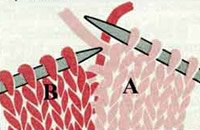 |
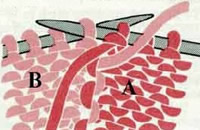 |
|
Changing on a knit row: Knit with yarn A until you want to change. Pull yarn A over to the left and wrap yarn B across the back of A as you knit the next stitch. |
Changing on a purl row: Purl with yarn A until you want to change. Pull yarn A over to left and wrap yarn B under A as you bring it across to purl the next stitch. |
|
You can see from the purl row picture that the edge resembles a sideways knitted row as on each row you cross the yarns over. This way you should get no holes. Don't worry if you see holes where the yarn is loose in some places. When you finish your work you will have lots of ends to sew in and you can pull these tight and sew up any holes that still appear. |
|
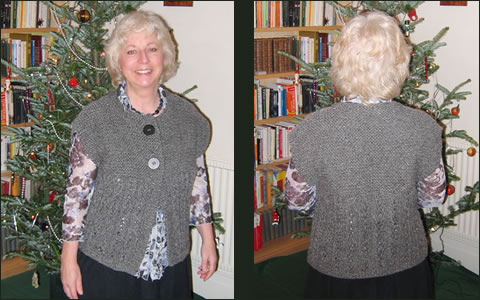
Speedy, speedy knitting from the 1970s. Flattering sleeveless top, warm and simple to knit.
Instructions.The pattern is worked back and forth on circular needles, in 5 stitch repeats over four basic rows: 1st Row: Wrong side facing, {p3,
k2}. Body:Note: The back and fronts are knitted as one piece up to the armholes. With smaller circular needles cast on {100/110}120 stitches and work 6 rows in garter stitch, noting that the first row is a wrong side row. Next Row: (Wrong side facing, 1st
pattern row), knit 4 and slip this 4 sts on to a safety pin or stitch
holder. Change to larger circular needles and commence pattern thus: k2,
*p3,k2; repeat from *
to the last 4 sts. Turn, slipping the last 4 sts onto a safety pin, without
knitting them. [{92/102}112 pattern sts] Next Row: (2nd pattern row), p2, *k1, yfwd, slip1, k1, psso, p2; repeat from * to end. Next Row: (3rd pattern row), as first pattern row. Next Row: (4th pattern row), p2, *k2tog, yfwd, k1, p2; repeat from * to end. Continue in pattern for 10 inches (or desired length), ending with a
4th row pattern, and wrong side facing to begin the next row. †† Leave the main work on the circular needles to one side now, still with wrong side facing - the row you have just knitted is not completed until after you make the front borders. Front Borders:At this point you need to go back to the 4sts you left on safety pins on each side of the work, to make the front borders. Using the pair of smaller needles, and working each set of 4sts separately, rejoin the wool and continue to knit the borders; it is important you join the wool and start knitting from the correct side of each border to continue in the right sequence for garter stitch. This means that, provided you have followed the instructions exactly
as above, for both borders, you need to join the wool at the edge which
will later be sewn to the main body. Work each border in garter stitch until, when very slightly stretched,
the border fits the length of the main body that you have just knitted,
finishing the left border on a wrong side row, and the right border on
a right side row. For both borders the yarn end will be at the edge next
to the main body. Break the yarn. Now return to your main work, on the circular needle. With wrong side facing, take up your last row of plain knitting (see the marker above ††) and complete the row by knitting the 4 sts of the right front border - make sure the border is not twisted. [{96/106}116sts]. Turn the work (right side facing) and knit across all {96/106}116 sts and then complete the row by knitting the 4 sts of the left front border - make sure the border is not twisted. [{100/110}120sts]. Now divide for front and back, with wrong side facing, knit the
first {25/29}32 sts (includes your extra
4 sts at front border) and place these sts on a stitch holder, to make
the left front, later. Continuing without turning, cast on 3 sts using the working yarn, knit
these 3 sts, knit {46/52}56 sts cast on 3
sts. Leave the remaining 32 sts on a stitch holder, to make the right
front, later. [{52/58}62 sts]. Back:With right side facing, work straight in garter stitch (every row plain)
for 8 inches (or the required length for the arm hole), ending with right
side facing. Shape shoulders by casting off {3/3}3 sts at the beginning of the next 4 rows, {3/4}4 sts at the beginning of the following 2 rows, {4/4}5 sts at the beginning of the following 2 rows, and {4/5}5 sts at the beginning of the following 2 rows, and leave the remaining {18/20}22 sts on a stitch holder. Left front:With right side facing return to the left front, slipping the {25/29}32 sts you left on the stitch holder back on to a left hand working needle. Rejoin the wool at the armhole edge to start your next row.
[Editor's note: it
is worth double checking here that:
If you have completed the steps as written, this should be how it works out.] Cast on 3 extra sts with the working wool; knit across these 3 sts followed
by the {25/29}32. [{28/32}35
sts]. Continue to work in garter stitch until 8 rows less than on back
have been worked to the start of the shoulder shaping, ending at the armhole
edge with right side facing to commence the next row. ** Shape shoulder by casting off {3/3}3
sts at the beginning of the next and following alternate row, {3/4}4
sts at the beginning of the following alternate row, {4/4}5
sts at the beginning of the following alternate row, then cast off the
remaining {4/5}5 sts. Right front:With wrong side facing return to the right front, slipping the {25/29}32 sts you left on the stitch holder back on to a left hand working needle. Rejoin the wool at the armhole edge to start your next row. [Editor's note:
it is worth double checking here that:
If you have completed the steps as written, this should be how it works out.] Cast on 3 extra sts with the working wool; knit across these 3 sts followed by the {25/29}32 sts, [{28/32}35 sts]. Commence working in garter stitch and make buttonholes on the following 6th and 28th (wrong side) rows as follows: Buttonhole row 1: (wrong side), knit
to the last 6 sts, cast off 2, knit to end. Continue to work in garter stitch until 8 rows less than on back have
been worked to the armhole edge, ending at the armhole edge with wrong
side facing to commence the next row. Work to complete the right front exactly as the left from ** to **. Neck Border:With right side facing and smaller needles, starting at the top of the
right front border, k{8/9}10 sts from stitch
holder, pick up and k9 sts up right side of neck, k{18/20}22
sts from back neck, pick up and k9 sts down left side of neck, then k{8/9}10
sts from stitch holder. [{52/56}60 sts].
To Make UpPress very lightly on wrong side under a damp cloth. Join shoulder seams,
using a flat seam, (or by grafting, working from the wrong side and making
a purl ridge on the right side). |
|
MaterialsAbout 7 x 100g balls of a chunky or "big" wool that knits to
the required tension on 7½mm needles. No 2 (7mm), and No 1 (7½mm) circular needles. Two 1½ inch buttons. Tension11sts x 16 rows to four inches measured over stocking stitch on 7½mm needles. Size mattersI made the main size shown in black text, which is a slightly large on me (UK size 12-14, maximum size 38 inches). The original pattern was multi-sized, so I have included {2 smaller size options}, in red ink with curly brackets, as shown. They are sized to fit {34/36}38 inches, and actual sizes more like {35/38}42 inches. Length from top of shoulder in my version is approximately 21 inches. See "adapting the size". A word on the wool.I used a pure wool Aran knitted double throughout, and this was about 450m as if knitted with a single strand of bulky wool. Original knitted in Patons Pablo. Abbreviations: yfwd: yarn forward - bring the yarn to the front of the work and when you knit the following stitch, you will have created an extra stitch, in a way that makes a decorative eyelet hole. "Yarn forward" or "yarn over needle" is often used in conjunction with knitting 2 sts together (so you avoid increasing the overall number of sts) in knitted lace patterns.
garter stitch: the simplest stitch pattern of all - every row is knittted, (when worked back and forth on two needles), and the back and the front of the work look the same. It makes a fabric that stretches vertically. Disclaimer
|
|
Adapting the size:Altering the size is fairly simple, as you are knitting a big rectangle, with the pattern being a 5 stitch repeat. Working to the required gauge, means that every addition of 5 sts gives you almost 2 inches extra room. Once you get to divide the work, you change to working garter stitch (no pattern), and can work it out so that half the sts go to make the back, leaving a quarter each for the two fronts. If you do not have stitches divisible exactly by four you can put the extra ones into the back, and incorporate them into the back neck. |
|
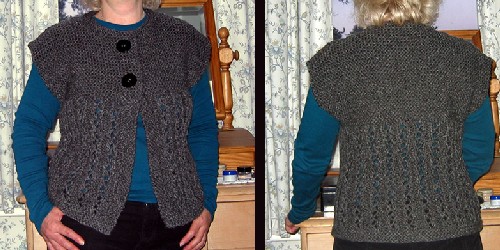
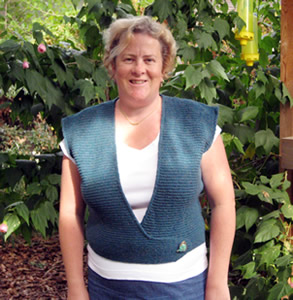
Snug winter accessory from 1953.
"Something new in waistcoats. A modern version of the old-fashioned knitted comforter".
Proves to be very flattering for most shapes, and not just for those twig-like 1950s post-war figures.
Instructions.The overall pattern is four basic rows: 1st Row: Right side facing, purl.
These 4 rows form the ridged pattern. Back:With larger needles cast on 117 sts. and work 52 rows in pattern as given above. With right side facing, shape sides by increasing one stitch at each end of next and every following 6th row until there are 153 sts. Work straight until back measures 11 inches at centre. Work straight until back measures l8¾ inches, then with right
side facing, shape shoulders by casting off 10 sts at beginning of next
8 rows. Right Front:With larger needles cast on 82 sts and work in pattern as for back, Work 12 rows straight in pattern. With wrong side facing, decrease one stitch at end of next and following
9 alternate rows [82 sts]. With right side facing, continue in pattern, sloping front edge and shaping
side edge as follows: Continue in pattern, sloping front edge by decreasing one stitch at beginning
of every following l0th row. With wrong side facing, continue sloping front edge on every l0th row as before, and at the same time, shape armhole by casting off 6 sts at beginning of next row, then k2 tog at this edge on next 7 rows. Now keep armhole edge straight and continue sloping front edge on every
l0th row as before until 40 sts remain. With wrong side facing, shape shoulder by casting off 10 sts at beginning
of next and following 3 alternate tows, armhole edge. Left Front:With larger needles cast on 60 sts. and work 52 rows in pattern. Armhole borders:Join shoulder seams. Front Borders:With right side facing and smaller circular needle, pick up and knit
172 sts from top of flap to centre back of neck. Work 5 border rows as for armhole borders. To Make UpPress parts lightly on wrong side under a damp cloth. Join side seams. Press seams. Fasten with pin or brooch as shown in photograph. |
|
Materials10 x 25g balls 1 pair each of No 11 (3mm) needles, and one long No 12 (2¾mm) circular needle. Original knitted in a 3ply wool on numbers 14, and 13 (2mm and 2¼mm) needles. Kilt pin to fasten. TensionYarn knits 28sts x 40 rows to four inches on No 11 needles. The original tension on thinner wool is 9 sts to the inch. Note: Do not stretch pattern when Size mattersOriginal sized for bust 33-34 inches; length from top of shoulders 19
inches. See "adapting the size". **A word on the wool.I used a Rowan Tweed 4ply, which is thicker than the original wool and made the item larger overall. The actual yarn I used is no longer available but you could choose Scottish Tweed 4ply instead. Original: Paton's Beehive Fingering 3 ply in Lipstick Red. Disclaimer
|
|
Adapting the size:Knitting in 4-ply produces a bigger size than the original but I carefully checked my tension, experimented with needle sizes, and did the arithmetic. Changing from 9st per inch to 7st per inch makes a big change from a 34 inch bust to 42. However the wrap over style offers some flexibility, and it is easy to add or subtract a few sts throughout the pattern if you need to, or even alter the waist size that you start with, and do fewer increases up to the armhole, if you feel up to it. This style is meant to be wrapped as tightly as you like to wear it, and seems to look flattering on a range of figure types. I wanted to make the wrap for myself, I liked the style and tried on this one before sending it off to Alison. However, the 4ply tweed made up too big for me (even with my own ample bosom!). I purchased some 2 ply on-line - fine pure wool in a cone, intended for machine knitting - so one day when I feel like working with lots of tiny stitches, I might get round to it.... (It's a lovely red - "lipstick red" ...) |
|
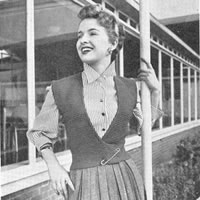
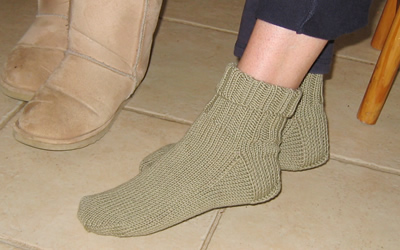
My sister was going on a summer trekking holiday and wanted some suitable socks to wear in her riding boots. I have created these simple socks in soft wool/cotton double knitting to meet the needs for a thick summer sock. I can't say how well the wool/cotton will wear as a sock wool, but the double knitting weight means they take about 5 minutes to knit (OK maybe a bit longer...).
I made the largest size for my sister (UK shoe size 5 or 6) - the smaller sizes are intended for children. You can wear the tops extended if used under riding boots, or rolled down if, perhaps, wearing shorts with heavy hiking boots.
Instructions (work 2 alike).Cast on 36 (40;44;48) stitches loosely; divide over 3 needles and join in a round. Work 35 rounds in k2, p2 rib (or required length). Next Round: K1, make 1 by picking up bar between sts and knitting into the back of it; knit to last st; make 1, k1. [38 (42;46;50) sts] Knit 5 rounds straight. Divide for heelNext Round: K9 (10;11;12), and then slip the last 10 sts of the round onto the other end of the same needle - these 19 (21;23;25) sts are for the heel. Divide the remaining sts between two needles, and leave for the instep. Commence Heel1st Row: Slip 1 purlwise, purl to end. 2nd Row: Slip 1 knitwise. * K1, keeping yarn at back of work, slip 1 purlwise; repeat from * to last 2 sts; k2. Repeat these 2 rows 8 (9;10;11) times more, then the first row again. Turn Heel1st Row: K13 (14;15;16) sts, slip 1, k1, psso (pass the slipped stitch over), turn. 2nd Row: Slip 1, p7, p2tog, turn. 3rd Row: Slip 1, k7, slip 1, k1, psso, turn. Repeat the 2nd and 3rd rows 3 (4;5;6) times more, then the 2nd row once. K5, thus completing the heel. 4 sts remain unworked on the left-hand needle. Using spare needle, knit 4 heel sts, pick up and knit 10 (12;14;16) sts along side of heel. Slip all instep sts on to one needle, and using 2nd needle knit across instep sts. Using 3rd needle, pick up and knit 10 (12;14;16) sts along side of heel, then knit 5 heel sts. [48 (54;60;66) sts]. Shape instep:1st round: Knit. 2nd round: 1st needle: knit
to the last 3sts, k2tog, k1. Repeat these two rounds until 38 (42;46;50) sts remain. Continue on these sts until work measures 4¼(5;5¾;6½) inches, or desired length, from where sts were knitted up at the heel. Shape Toe:1st round: 1st needle: knit
to the last 3sts, k2tog, k1. 2nd round: Knit. Repeat these 2 rounds until 18 sts remain. Making UpKnit sts from 1st needle on to end of 3rd needle. |
Materials2 x 50g balls Rowan Wool Cotton , shade 930, "Riviera". One set of 4 number 9 (3¾mm) needles. Tension24st and 32 rows to four inches on No 9 needles. Size mattersLength of foot approximately 7½(8½;9½;10½) inches (adjustable). A word on the wool.Wool Cotton is possibly my favourite Rowan yarn; a 50/50 blend of soft
Merino wool and cotton. I am not sure how well it will stand up to wear
and tear in a sock, but the cotton should improve durability. Disclaimer
|
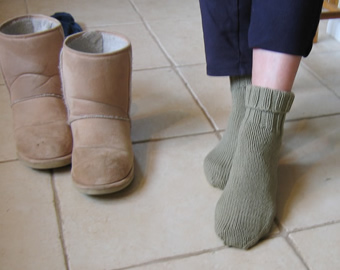
Here's a picture of the socks "in use". Left to right - my sister at the rear on the grey, Susanna, Liz, and leading on the palamino, Tom, the guide.
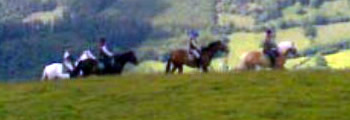
Llanthony Riding and Trekking is based at Court Farm, next to Llanthony Priory; here's the full picture (from which the detail above is taken) showing the fabulous scenery and environment in Wales. Lyn strongly recommends the bed and breakfast accommodation that she enjoyed at Pen-y-dre Farm
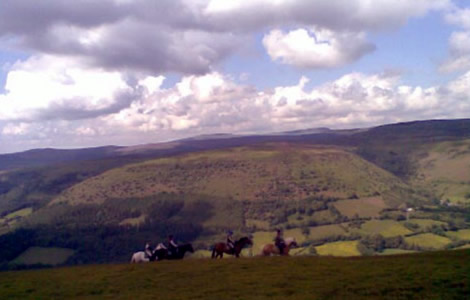
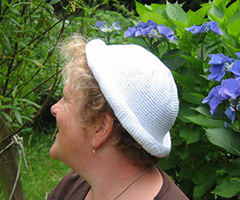
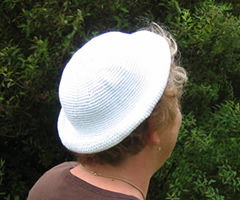
"Capped to catch the eye" in 1952.
This cap can be "worn with a purpose on windy days for cliff-top walks or out at sea,
or just for extra prettiness at any time".
"Leave it plain or dot with beads" - and - "for teenagers only - roll up the brim in jaunty sailor style".
Luvvly.
Instructions.Instructions are for 2 versions - one plain and one with striped brim. Crown 1st Round: *
2 dc in 1 dc; repeat from * to end. 5th Round: *
(1 dc in 1 dc) three times, 2 dc in 1 dc; repeat from *
to end. [40 dc] 7th Round: *
(1 dc in 1 dc) four times, 2 dc in 1 dc; repeat from *
to end. [60 dc] 12th Round: *
(1 dc in 1 dc) fourteen times, 2 dc in 1 dc; repeat from *
to last 10 dc; (1 dc in 1 dc) ten times. [106 dc] 19th-34th Round: As 18th round. This completes the crown. Striped BrimWith number 11 hook, and white yarn, make 23 chain, turn. Miss 1 ch 1 dc in each of 22 ch. †† Join in contrast. Continue repeating from †† to †† until strip fits all round the lower edge of the crown. Do not stretch this strip but allow it to fit comfortably. End with 2 rows of contrast colour. Fasten off. Finishing: Plain BrimThis is worked with the yarn doubled. Sew in ends and optionally embroider 5 rows of beads around the crown, as shown in
the photograph. |
MaterialsPlain: 2 x 50g ball Phildar
Phil Crochet, in white, (100% cotton, 201yards). Striped: 1 x 50g ball 3 balls (2 in white) made both hat versions. Nos. 11 (3mm) and 10 (3¼mm) crochet hooks. Crochet abbreviations:ch = chain Remember these are English crochet instructions where dc is equivalent
to US single crochet, and so on - see "Terminology" in the side
bar. Tension7 dc to an inch. Check the tension and your head measurement carefully; the original was made in angora which is more stretchy than pure cotton. Size mattersTo fit "an average head". However, the hat size can vary quite a lot according to your tension. A word on the wool.Original specified 2 x ½oz balls of Patons Fuzzy Wuzzy Angora. Disclaimer
|
Striped-brim version, and modelled original:
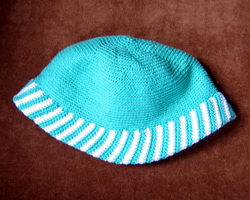
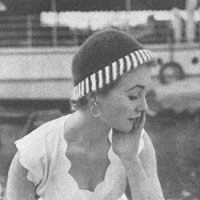
I was so taken with the another seaside idea on the same page as the hat that I felt compelled to share it with you here as well.
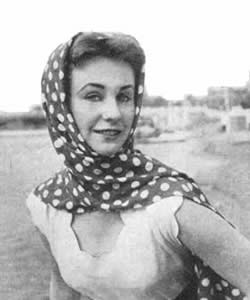
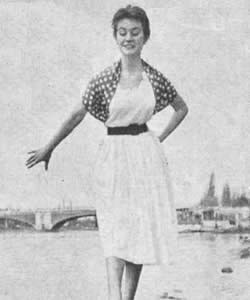
.....TIED AT THE BACK it makes a snug bolero....
As a change from the everlasting headsquare, buy a yard of rayon or silk -
ours was a yard of spotted rayon at 5/6d,
[Editor's note: For you
whipper snappers out there, that's 27½p or about 60 cents.]
but silk is best if you can afford it, as it's less slippery - cut it in half
lengthways, join the short ends neatly, slip hem the long raw edges, and you
have a manoueverable long stole, which can be worn in all sorts of ways and
is so much prettier and smarter than a triangle tied under your chin.
[Editor's note: I'm with
them on that one.]
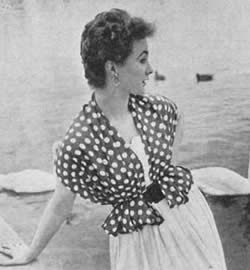
AS A CARDIGAN - round your shoulders, ends tucked up and over your belt in two comfortable pockets.
Carry it around on holiday and it will be a godsend for those chilly moments,
and less bother to carry than a cardigan. Tie it round tyour waist as a sash
when you don't want to carry it.
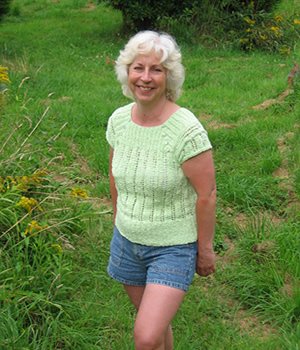
Cool summer top from 1935, knitted in bouclé cotton/linen mix, using an eyelet lace pattern for the body, and ribbing for the yoke. I have adapted the yoke slightly, and given a better fit to the sleeves.
"This engaging affair uses a fairly thick wool (quickly knitted!)".
Here I demonstrate its versatility - it could be worn as a smart top with a skirt - or in the garden with denim shorts!
Instructions.The basic pattern for most of the top is two basic rows: 1st Round: *
k2tog; k2; yarn forward; k1; yarn forward; k2; k2tog through back loops;
repeat from * [Editor's note: If you are knitting in the round, the alternate rounds are knitted; if you are knitting back and front on 2 needles, for example, when you divide at the armholes, then the second row is purl.] Main body:The back and front are knitted together in the round. Using a No 11 (3mm) circular needle, cast on 198 stitches. Change to a No 10 (3¼mmm) needle, and work in pattern as given
above, for an inch. Change to No 9 (3¾mm) needles and continue
in pattern for another inch, then to No 8 (4mm) needles and carry on with
these until work measures 13 inches from commencement, ending with a plain
knit row (2nd round of pattern), but cast off the last 8 sts of the round Shape armhole:Divide front and back and work each side separately as follows: Cast off the first 8 sts of the round, then, with one stitch on the right hand needle, commence the pattern row, and work 9 pattern repeats; k1. Cast off the next 16 sts; then, with one stitch on the right hand needle, commence the pattern row, and work 9 pattern repeats; k1. You should have 83 sts to work for the back and front. Back:Turn the work and purl back across 83sts. Continue working back and forth across these 83 sts in pattern as set,
starting and ending each row, with one plain knitted stitch. Work 2 inches
(about 6 more eyelet rows), ending with a purl row. Here shape the neck. Next Row: k1, *
k2tog, k2, wool forward, k1, wool forward, k2, k2tog *
; put the next 63 stitches on to a spare needle; join in a second ball
of wool, repeat from * to *
once, k1. Continue on the latter 10 stitches till work measures 19½
inches from commencement. Cast off 9 stitches from armhole end. Finish off the opposite shoulder to match. Front:Rejoin the yarn to other set of 83sts, with wrong side facing, and purl back across 83sts. Complete the front exactly as you did the back. Yoke:Join the shoulders either by stitching or grafting. Using the No 10 needles with points at both ends, or a circular needle,
and with the right side of the work facing, knit up 236 stitches, starting
at a shoulder seam as follows: [Editor's note: It took me a while to work out the "continue decreasing in this manner" so at the end of the instructions I am including my explanation of the yoke decreasing. Rounds 2 through 5 are the four decreasing rows that are repeated.] Sleeves:With right side facing and using No 8 needles, pick up and knit 67 sts around the head of the sleeve, (leave the cast off armhole sts).
You will knit backwards and forwards in pattern across these sts, shaping
the sleeve by knitting short rows. 1st Row: K2,
* k2tog; k2; yarn forward; k1; yarn forward; k2; k2tog through
back loops; repeat from * to the last 2 sts,
k2. Knit the next 3 rows. Making UpSew up sleeve seams under the arms, and sew in all ends.
Sew four buttons up each of the two front corners of yoke. |
|
Materials5 x 50g balls Stylecraft Sirocco 80% cotton, 20% linen; 98yds/90m per ball. Numbers 8, 9, 10, and 11 (4, 3¾, 3¼ and 3mm) circular needles. 8 decorative buttons. TensionYarn knits to 20st and 28 rows to four inches on No 8 needles. One pattern = 1½ in on No 8 needles. Size mattersOriginal sized for bust 34 inches; length 18 inches. A word on the wool.I wanted to knit this in a bouclé or slub cotton and just could not find what I wanted - there is the fabulous Debbie Bliss Astrakhan, but that is too wintry and thick. Then, in a local haberdashers, I found this Stylecraft yarn which is absolutely what I was looking for and has the benefit of being natural fibre and very good value! Original: Paton's Super Brindle, which comes (came) in white flecked with colours. This was probably finer than Sirocco - more a straight DK at 22 sts per 4 inches I am guessing. Disclaimer
|
|
Additional Instructions for Yoke Decreasing:These follow the foundation decreasing "Round 1". Instead of writing out every stitch, I have indicated the number of sts between the decreases; "rib" means k2 p2 rib, following the ribs as set out in the row below. 2nd Round: rib 26, p2tog, rib 58, p2tog, rib 54, p2tog,
rib 58, p2tog, rib 28. 6th Round: rib 24, k2tog, rib 54,
k2tog, rib 50, k2tog, rib 54, k2tog, rib 26. 10th Round: rib 22, p2tog, rib 50,
p2tog, rib 46, p2tog, rib 50, p2tog, rib 24. 14th Round: rib 20, k2tog, rib 46,
k2tog, rib 42, k2tog, rib 46, k2tog, rib 22. 18th Round: rib 18, p2tog, rib 42,
p2tog, rib 38, p2tog, rib 42, p2tog, rib 20. 22nd Round: rib 16, k2tog, rib 38,
k2tog, rib 34, k2tog, rib 38, k2tog, rib 18. |
|
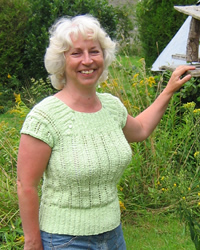
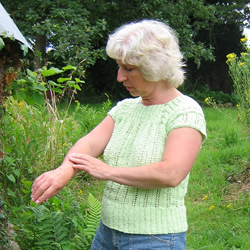
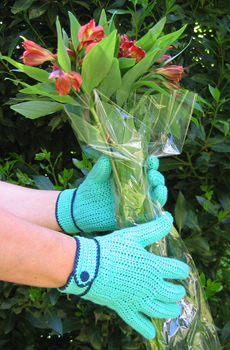
Chic summer gloves from 1955, worked in cotton crochet, though not lacy.
Elegant but not frilly - "these trim gloves are crisp and fresh". Definitely to be worn with pill-box hat and veil rather than Edwardian sunshade, (or in practice - neither - but you get the idea).
Original worked in white with black trim. Very Audrey Hepburn.
Instructions (both hands alike).Beginning at the side edge with main colour, make 41 chain, turn. Start with little finger Begin third finger ** Begin middle finger Begin first finger Begin thumb [Editor's note: You end here at the top of the thumb. One half of the glove is complete - this half covers the back of the hand.] Now keeping same side of glove piece facing you, rejoin to beginning of row, and work 1 long row dc. up side of thumb and all round fingers, ending at top of little finger. Now work down side of little finger to wrist thus: Little finger Third finger Middle finger First finger Thumb Continue with row, working a row of dc. down inner side of thumb and round all fingers, ending at top of little finger, where you finished your row of dc when working the other side; fasten off. Make another glove in the same way. To Make UpPress parts very carefully on wrong side under a damp cloth. Remember to turn second glove inside out for other hand. CuffsWith main colour yarn, make 45 ch., turn. 1st Row: Miss 1 ch., *
1 dc in each ch.; repeat from * to
last ch., 2 dc in last ch.; turn with 1 ch. With contrast yarn, work 1 row of dc all round cuff. Sew cuff neatly round glove with contrast edging overlapping edge of
main work and with opening in centre of back; rounded edge comes below
3rd finger and slightly overlaps straight short edge of cuff.
Work a small circle of dc in contrast and sew in position on top of cuff
as shown in photograph. |
Materials1 x 50g ball Phildar
Phil Crochet, shade 07 Veronese, (100% cotton, 201yards), with a small
amount of navy blue for contrast. Crochet abbreviations:ch = chain Remember these are English crochet instructions where dc is equivalent
to US single crochet, and so on - see "Terminology" in the side
bar. Tension6 half trebles to an inch. Size mattersTo fit "an average hand". A word on the wool.Original specified 2 x 1oz balls of Strutt's Milford Knitting Cotton No. 8 in white, with scraps of black 4-ply wool for edging. The single 50g ball of Phil Crochet was only just enough at 201yds. For winter gloves, they could be easily worked in wool instead of cotton for those who don't like to knit. Disclaimer
|
Your finished gloves.
Editor's note: "So what's all this messing about with a bunch of flowers?" - I was trying to emulate the original photo shoot, and found it surprisingly hard. I had to get George to take the photo and he did not seem focussed enough on (a) yes I did want the flowers in the photo not just a load of stems, (b) but it is supposed to be a centred around the gloves and not a bunch of flowers, and (c) o I wish I had slim elegant fingers, and maybe 4 arms so I could take the photo myself...

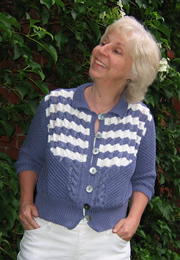
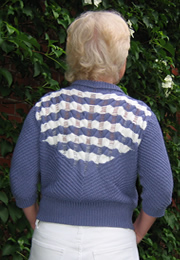
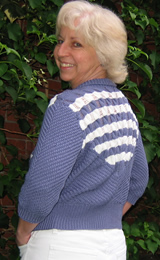
Summer jacket from 1935 has an unusual design that is quite fun to work. It was given only in one nominal size, but has some flexibility for your own alterations. I simply love the way this has turned out; the bamboo yarn is so soft and comfortable. On finishing, I immediately wore it all the next day.
Diagonal Rib PatternSleeves and lower part of jumper are knitted in a k2, p2 rib, with the rib carried one stitch sideways on each row. The following 4 rows form the pattern, worked over an odd number of stitches. Row 1: (k2, p2) repeated to centre
stitch; knit centre stitch; (p2, k2) repeated to end of row.
Cable PatternThe yoke of the jumper is knitted in cable ribbing, where the stitch
between the cables is subsequently dropped to form "ladders".
When the sts are dropped, pull them back to where you started the cables,
above the diagonal rib, and secure the stitch by running a thread through
and stitching on the inside. BackUsing No. 12 needles and main colour (blue), cast on 104 stitches, and
work 3 inches in k1, p1 rib, (approximately 25 rows), increasing one stitch
at the end of the last row. Work the 4-row pattern 10 times, then the first two rows again, (42 rows). [Editor's note: The origonal instructions were to work the 4-row pattern 14 times as it was intended for a thinner yarn. For my version, in the bamboo yarn, I worked 16 rows fewer up to the start of the cables, as well as 16 rows fewer in the armhole section (see notes below) which brought the welt up to sit on my hips as shown in the photo.] Row 43: (p2, k2) repeated to centre
stitch; knit centre stitch; (k2, p2) repeated to end of row. (ie
pattern row 3 with 5 sts knitted in the middle). Now start the striped pattern: Row 55: K38 sts in pattern as set
in blue; join on white: k6, cable C4B, k1, cable C4F, k6; join on another
ball of blue and finish row in pattern. Continue as on last 2 rows. increasing number of white stitches for 5 more rows (i.e.. finally 31 blue; 43 white; 31 blue). Row 63: Work in blue right across
row: 30 sts in pattern; k5, (C4B, k1) twice, (C4F, k1) twice, k4; 30 sts
in pattern. Continue thus for 6 more rows in blue, still taking 2 more into stocking stitch in each row (23 pattern sts on each side). Row 71: Pattern 22 sts blue; join
on white: k4, (C4B, k1) 3 times, (C4F, k1) 3 times, k3; join on blue pattern
22 sts. Continue thus for 6 more rows. Row 79: Work in blue right across
row: 14 sts in pattern; k3, (C4B, k1) 4 times, (C4F, k1) 4 times, k2;
14 sts in pattern. Shape armhole: Repeat from ** with alternate colours 4
times, then repeat row 87 row in blue. Work 3 rows in stocking stitch. Row 131: Cast off 2, drop 1 st, leave
big loop (to cover dropped st), and cast off 1 more; knit to end.
Right FrontUsing No. 12 needles and main colour (blue), cast on 66 stitches, and
work 3 inches in k1, p1 rib, (approximately 30 rows), increasing one stitch
at the end of the last row. [67 sts]. Row 1: k15; (p2, k2) repeated to
end of row. Repeat these 8 rows 4 times. Row 41: k15; (p2, k2) repeated to
end of row. Row 61: All blue. K4, (C4F, k1) twice,
C4F, k5; (p2, k2) repeated to end of row. Row 69: Join in white: k4; (C4F,
k1) 4 times, k3. Join in blue: (p2, k2) repeated to end of row. Row 77: All blue. K4, (C4F, k1) 5
times, k2; (p2, k2) repeated to end of row. Shape armhole: Row 85: Join on white: k4; (C4F,
k1) 5 times; k9, k2tog. Work 2 more cable stripes alternately
in white and blue, working only 3 rows in stocking stitch after the cable
row on the second blue stripe. Row 113: Cast off 2, break wool and
pull through last stitch; drop 1. Join on again. Left FrontCast on and work in ribbing as for right front; change to No. 9 needles and purl one row on 67 sts. Row 1: k2; (p2, k2) repeated to last
13 sts, k13. Continue with these rows in pattern as set, reversing the shapings and
making the two fronts correspond. Sleeves (work 2 alike).Cast on 62 stitches on No.12 needles. Next row: Increase once at each end
of needle. Cast off 3 sts at the beginning of the next 2 rows. [Editor's note: The instructions above are as I worked the sleeve but are completely different fom the original. Below are the original instructions in case you are working in the fine fingering weight wool.] Here are the original
instructions for the 3 ply weight yarn: Work 7 rows in pattern.
[My sleeve length is to the elbow. The original sleeve was made much shorter and a different shape.] CollarOn No. 12 needles, pick up 104 stitches
round neck: 33 sts from each front and side neck, and 38 sts across the
back. Making UpDrop stitches between cables. Catch these stitches (and sew in) on the
wrong side to prevent running into the diagonally ribbed pattern. |
MaterialsOriginal pattern calls for 6oz of main and 1oz white in "3 ply". One pair each of numbers 12 (2¾mm) and 9 (3¾mm) needles.
One cable needle. One No 9 (3½mm) crochet hook. Seven buttons, approximately 1 inch. The original shows rather larger buttons as part of the styling. TensionOriginal states 32st to an inch over diagonal rib on No 9 needles. Size mattersNo size given originally - knitted example measured 36-38 inches. My version is knitted with fewer rows than stated in the original pattern (my deviations noted in red); this is - as intended - to keep the cardigan waist length like the original, but with longer sleeves. The result is a good fit for me (a chubby UK size 12), shaped to be fitted around the bust, under the arms, and into the waist, but with a good degree of ease. See the section on sizing. A word on the wool.Rowan Bamboo Soft, is a light weight DK which knits to a tension of 25sts
and 30 rows to 4 inches; 102m/112yds to 50g. Disclaimer
|
The original pattern seems to be intended as a neat fitting jacket in a fine yarn, knitted on larger needles.
I calculated the chest size (one size only given) as working out to only 28 inches, which even for the era seemed a bit small, so I felt confident in moving to a thicker yarn, based on the needle size. What I had failed to take into account, is that when you drop the stitches between the cable, the chest size expands a lot. Purely guessing I would say the original size using fine yarn was intended for a 33 to 35 inch bust.
The design of the cables and ladders, means that the cardigan is in fact self-shaping. In my version, the measurement for the back just above the welt is about 16 inches, and this increases to about 18 inches by the time you get to armholes. This gives you a nominal 36-38 inch bust size as the fronts are slightly larger and you can choose, within limits, to have fewer or more rows of crochet to form the front closure bands.
To increase the length of the cardigan, you can follow the areas marked in red where I have altered the rows. Preferably stick with adding or subtracting in chunks of 8 for simplicity.
To make tweaks to the bust size you can add in crochet rows at the front.
To make a significant alteration is slightly more difficult; in order
to keep the symmetry of the cables you really need to add in two cables
on the back and one each on the front, which would make a difference of
36 sts, and in the yarn I used this would be about 5½ inches.
But please note: This cardigan fits me well, and still looks as shown in the pictures; however the bamboo yarn has eased considerably with wear - I now think I could easily have removed an even 4 cable patterns (5½ inches) and still have a nicely fitting cardigan.
Finally, you can of course make overall size changes by using substitute yarns of other weights. This design is pretty tolerant of such changes, as I discovered, but you risk ending up with a different look - anything from the tiny figure-hugging waist length jacket of the original to a longer altogether looser cardigan style. If you are up to it, you can of course check your tension and work it all out beforehand, but remember the effect of the ladders is to much increase the finished size above that implied by the tension.
Here is a popup of the original picture for comparison with my version:
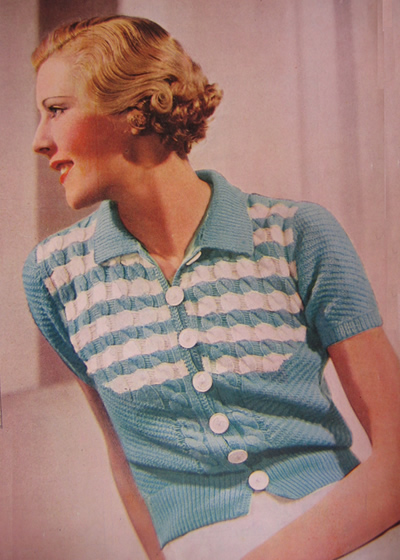
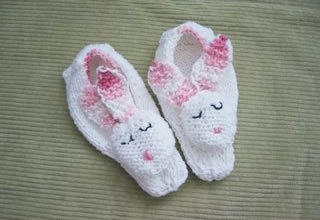
A charming pattern from Alison for a pair of child's slippers, first knitted for her niece, Nancy.
InstructionsWork two slippers the same as follows: Sole and foot - Cast on 28 sts in white At start of toes k1p1 rib for 2 inches Next row: p2 tog across entire row
(14 sts) Heel - Pick up 10 stitches from middle of cast on row, leaving 18sts (9 on each side of the 10 you have picked up). You will pick up and incorporate these 18 sts as you work the back of the heel. Work 15 rows on these 10 sts in stockinette as follows: Row 1: K9; pick up the next st of
the cast-on row and knit it together with the last st of the row. Turn. Continue in this way for 12 rows in all. Bind off remaining 6 stitches. In sewing the toe centre seam, and working the heel you have pulled up the sides to form the slipper shape. [Editor's note: If the 'cuff' of the slipper is loose you can work a row of single crochet around the edge of the slipper and pull in the shape a little. I used the pink for this.]. Head - knit 2 in white. Cast on 10 sts. Using spare yarn, embroider a pink nose, and crescent shapes for closed eyes, using the picture as a guide. Loosely stuff head and use long tail to sew around edge and pull in making
a small flat ball. Ears - knit 4 in white and 4 in pink Cast on 2 sts. Sew a white to a pink ear using blanket stitch. Finishing - Sew ears firmly to back of head at jaunty angle. Tail - (optional) make 2 small pompoms and attach to heels of slipper. |
MaterialsDishcloth cotton - white and pink (Lily Sugar n'Cream cotton.). 1 pair 5mm needles. . Tension20 sts and 26 rows to 4 inches measured over stocking stitch on 4½mm needles. Size mattersFits feet 7" long (age 4 or so). Disclaimer
|
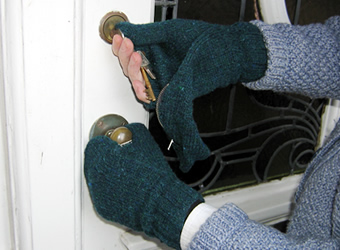
These are double layered mittens which have suddenly become popular again (probably more the height of fashion a year or so ago - as well as half a century ago). This pattern is from February 1940. Here the thumb is left free; in some designs of this era, the thumb and forefinger are left free - your "trigger finger " I assume.
"The glove mitts are a sensible idea, ensuring both warmth and freedom of movement. Instructions are given for both men's and women's sizes".
The different sizes are achieved by using different wool weights and needles.
Instructions (both hands alike)Using No. 14 (2mm) needles cast on 48 stitches, and work in k2, p2 rib in rounds for 2½ inches. Next row: Knit twice into every stitch. Now slip every alternate stitch (ie every "made" stitch) on to No 12(11) needles and leave the original 48 sts on the No14 needles on the outside of the work.
[Editor's note: The
original instructions expect you to continue to knit on the larger needles,
leaving the outer sts on the No 14 needles. I found this very awkward;
I thought it would improve as I got further up the glove but it did not. Continue on the No 12(11) needles, on the "made" sts, in rounds of plain knitting, and work 2 rows straight. 3rd round: Knit twice into first
st, knit to the last st, knit twice into it. 6th round: Knit twice into first
st, knit to the last 2sts, knit twice into next st, k1. 9th round: Knit twice into first
st, knit to the last 3sts, knit twice into next st, k2. Continue in this way, increasing on every 3rd row at either side of the
thuumb, until there are 66 sts on the needles. Divide for thumb Continue on these 20 sts for 22 rounds. Rejoin wool to continue with the main part of the mitten: Work 18 rounds straight on these 54 sts. Divide for fingers Work 3 rounds straight on these 20 sts, then work 4 rounds k1, p1 rib. Cast off loosely in rib. Next round (middle finger): Remove the waste wool and pick up 4 sts at the base forefinger. Knit first 6 sts from holder; cast on 4 sts in waste wool and knit them onto the working needle; slip the last 6 sts on holder onto a needle and knit them. [20sts] Complete as for forefinger. Next round (third finger): Work and complete as for middle finger. Next round (little finger): Remove the waste wool and pick up 4 sts at the base third finger, and knit the remaining 14 sts from holder. [18sts] Work as before over these 18 sts. Over-mitten Next row (right side facing): K2tog;
k21; k2tog; k21; k2tog. Continue in stocking stitch, decreasing as for 7th row on every 6th row
until 37 sts remain. Making up 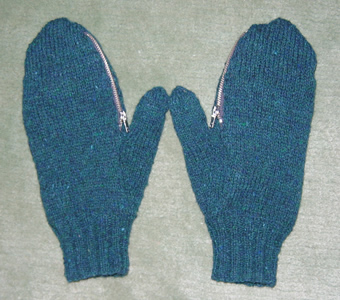
|
MaterialsExample shown is knitted in 3 x 25g balls Rowan 4ply Tweed. Set of 4 each of numbers 14, 12 and 11 (UK size) needles for the smaller
size, and 14, 11 and 10 for the larger size. Two 4-inch zip fasteners. TensionApprox. 8st to 1 inch Rowan 4ply tweed tension: 28st and 40rows to 4 inches (10cm) using No
11 (3mm) needles. Size mattersTo fit size 6¼-7, or 7½-8½ inch hand. A word on the wool.Original calls for 2oz 3 ply for girl's size [sic] and 3oz 4ply for man's
size. Disclaimer
|
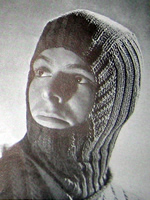
This 'good old Balaclava helmet' was included in the item "More Knitteds for the Forces".
I know - they are nice and warm - and they can be useful on the slopes - but I'm given to understand that beanies are more the thing currently, so I have spared you the details!
Let me know if, (your imagination no doubt fired by the hunk on the left), you want to knit it.
I'm afraid I also have to report that George says these are the silliest mittens he has ever had. Good thing he was not called upon to be in the Home Guard 50 or more years ago, eh?.
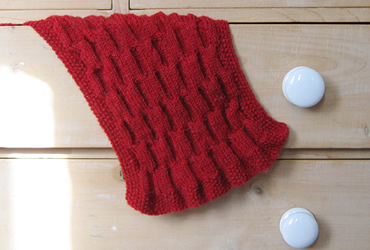
"Reversible scarf for the cold days ahead". This is a very pleasing pattern from October 1963, and is a suggestion for "pre-Christmas plans". The pattern is the same on both sides, so great for a scarf, and can be knitted in basically any wool weight; ensure you use needles a couple of sizes larger than normal for whichever weight you choose, and do a proportional calculation on the gauge, so your scarf is not too wide.
InstructionsCast on 73 stitches. First row: K1, * p1, k1; repeat from * to end. Repeat this row for the moss stitch border 8 times more. 10th (increase) row: Moss 8, (increase in the next st, moss 6) 8 times; increase in the next st, moss 8. [82 sts] Change to pattern rows as follows: 1st row: moss 5, p3, *k6,
p6; repeat from * to last 14sts; k6, p3,
moss 5. 11th row: moss 5; *slip
the next 3 sts on to a cable needle to the back of the work; k3, p3 from
cable needle; slip the next 3 sts on to a cable needle to the front of
the work; p3, then k3 from cable needle; repeat from *
to last 5sts; moss 5. 23rd row: moss 5; *slip
the next 3 sts on to a cable needle to the front of the work; p3, then
k3 from cable needle; slip the next 3 sts on to a cable needle to the
back of the work; k3, p3 from cable needle; repeat from *
to last 5sts; moss 5. These 24 rows form the pattern. Continue straight until the work measures 46 ins, ending with a 12th or 24th pattern row. Next (decrease) row: moss 8 *k2tog; (p1, k1) 3 times; p2tog, repeat from * 3 times more; k2tog; (p1, k1) 4 times. [73sts]. Work 9 rows moss stitch over all stitches. Finishing - Press work very lighty, taking care not to spoil th texture of the patttern. Cut the remainig wool into 7½ inch lengths; take 3 lengths of wool together each time, fold in half, and, with a crochet hook, knot through short ends to make a fringe. Trim fringe. Substituting the wool - I used a vintage wool,
Phildar Brisants. This is a fine double knitting, which is normally knitted
on no. 9 (3¾mm) needles. The cabling make for a tighter tension,
and the recommended needles (UK No 6) are 2 sizes larger than usual for
a DK. I went with no. 8 needles, instead of 9s, but should have gone larger
I think. If you want to use chunkier wool, then decrease the number of sts proportionally. The pattern is worked over 12sts. |
MaterialsOriginal call for 9oz of Patons Moorland Double Knitting Example shown is knitted in Phildar Brisants. One pair of No. 6 (5mm) needles. TensionEquivalent to 20st and 26rows to 4 inches (10cm) measured over stocking
stitch. Size mattersWidth: 12 inches A word on the wool.This pattern is for double knitting wool, and from memory Moorland DK
was slightly heavy-weight. Disclaimer
|
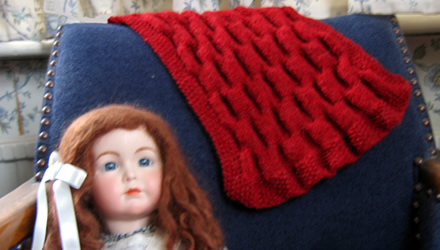
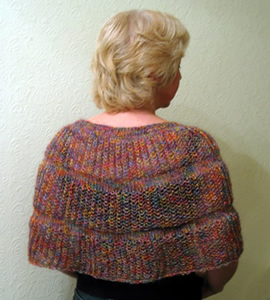
Adapted from an original idea for sleepwear, this has transformed itself into a glamorous stole.
Whether or not it sparkles obviously depends on the type of wool you choose. I used a fabulous Italian yarn, which was a bit brighter once knitted up, than I had imagined from the ball, but has made a lovely item. The original pattern (from the 1970s but probably revamped from a much earlier design) called for 4 ply wool - about 8 ounces - but my version is not only in much lighter weight man-made fibres with a consequent good yardage, but also designed to be shorter than the original.
I think you could feasibly wear this in the evening with a skimpy evening top or as a decorative addition over a plain black roll-neck sweater.
[Note: we noticed that this colourway works particularly well with dark brown].
InstructionsUsing No. 6 (5mm) needles cast on 72 stitches, and work 6 rows k1, p1 rib. Increase row: K5, * m1 (make one st by picking up the loop between the stitches and knitting into the back of it), k4; repeat from * to the last 6sts, m1, k5. [88 sts]. **
Right side of work facing, change to No. 3 (6½mm) needles and commence pattern. Next pattern row: *
K1, k1b; repeat from * to end. Work 25 rows in the pattern. Change to number 6 (5mm) needles and work 3 rows in stocking stitch,
starting with a purl row. Increase row: K6, * m1, k4; repeat from * to the last 6sts, m1, k6. [108 sts]. Make a second pattern band by repeating from ** to **. Increase row: K4, * m1, k4; repeat from * to the last 4sts, m1, k4. [134 sts]. Make a third pattern band by repeating from ** to **, but omit the final three st st rows, and, on this last segment, continue on the No. 3 needles and knit a further 5 pattern rows. Cast off very loosely using a large gauge needle. End panels - Using No. 7 (4½mm) needles, and wrong side of work facing, pick up and knit 56 sts purlwise. Next row: (right side facing) K6,
*k2tog, repeat from *
to last 6 sts, k6. [34 sts]. Continue to decrease at the centre in this way until 6 sts remain. Repeat for the other side. Finishing - Press the stocking-stitch end pieces lighty on the
wrong side, using a warm iron and a damp cloth. [Editor's notes: The original pattern had 5 segments. If you want to do that, work in the same way, with each pattern band at 25 rows and the following additional increase rows: Increase row for fourth pattern band:
K5, * m1, k5; repeat from
* to the last 4sts, m1, k4. [160 sts]. ..and for the side panels pick up and knit 80 sts instead of 56, and decrease to 50 sts in the first decrease row.] |
MaterialsExample shown is knitted in 2 x 50g balls of an S. Charles Collezione yarn "Ritratto" - shade 64 One pair each of numbers 3, 6 and 7 (UK size) needles. Fancy clasp available on the web from TextileGarden, or Purlescence, or Nordic Fiber Arts. TensionApprox. 16st and 32rows to 4 inches (10cm) measured over pattern using
No 3 (6½mm) needles. Size mattersWidth around lower edge: 60 inches A word on the wool."Ritratto" is a man-made fibre with 28% mohair; knits 22sts to 10cm on No 6 (5mm) needles; 50g ball is 198 yards and I used about 1½ balls for the project.
I think this would work out well using Rowan Kidsilk Haze (or Night or Splash), or in Rowan Damask, which has a slightly shiny silk thread running through the yarn. Disclaimer
|
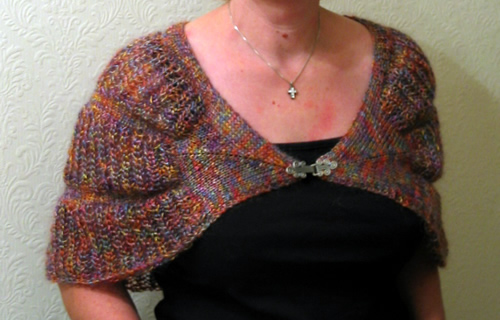
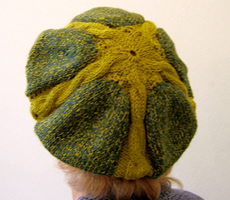
Hats are not my thing but I am fond of berets. Here is an irresistible 1970's two-tone design - the original in two glaring shades of gold and yellow. Consider also making it in orange with a strawberry or coffee contrast - I can vouch for this as a popular contemporary combination and you can view it as part of Southwest airlines hostess uniforms from the same period (although the colour of the uniforms is possibly not as striking as the hot pants and knee boots of the period...).
Alternatively just stick with more reserved single colour in traditional white Aran, understated and letting the pattern speak for itself.
Cable PatternRow 1: P3, k6, p3. These 10 rows form the pattern. Special note: Wind 5 small balls of yarn in each colour. Use a separate ball for each cable and panel, and twist the colours where they meet to avoid gaps in work ("intarsia method"). InstructionsUsing No. 10 needles and medium colour (M), cast on 106 stitches, and work 9 rows k1, p1 rib. [Editor's note: If you work the beret in 2 colours then work over 2 needles as described. If you work in a single colour, you could work this in the round, reversing knit and purl sts on wrong side rows.] Next row: (p1, p into front and back of next st) twice, * p2, p into front and back of next st, p1, p into front and back of next st; repeat from * to the last 7sts, (p1, p into front and back of next st) 3 times; p into front and back of last st. [150 sts]. Change to No 7 needles. Next row: (right side) *
k22 in M; join in light (L), k2, (k into front and back of next st) 4
time, k2; repeat from * to end. [170 sts]. Continue in stocking stitch and cable pattern, until work measures 5½ inches from beginning, finishing with right side facing for the next row. Shape crown as follows: Next row: *
(k2tog, k7, k2tog tbl) twice in M; pattern 12 L; repeat from *
to end. [150 sts]. Next row: K3, *
p6, k2, (p2tog) twice, k2; repeat from *
to last 11sts; p6, k2, p3tog. [60 sts]. Break off wool leaving end. Thread end through remaining sts and draw up tightly. Fasten off securely. Making up - Press lighty on the wrong side, using a warm iron and a damp cloth. Join seam, using a fine back stitch. Press seam. |
MaterialsOriginal pattern calls for 3oz of medium colour and 1oz light in an Aran
weight yarn. One pair each of numbers 10 and 7 needles. Tension20st and 25 rows to 4 inches (10cm) on No 7 (4½mm) needles. Size mattersInstructions to fit an "average" head (!). A word on the wool.I used Phildar yarns Oxygene (a DK) which knits 23st to 4 inches; and Frénésie (a heavy DK) which knits 19st to 4 inches. Disclaimer
|
Yet another object of my admiration is Southwest airlines. They don't really have any visibility outside the US, so I was suitably surprised on my first journey with them. (It was the night of October 31st flying to Tucson in 1994, and they sure had some fun with us passengers...). I have also been impressed at their impromptu organisation of party games to try and occupy a hot and fractious plane load of souls during an hours delay at LA. (See the wikipedia entry: "Southwest is known for colourful boarding announcements and crews that burst out in song. The singing is unusual, and is quite popular among customers, but has been noted by some travel critics as being offensive and intrusive." huh - what do they know?!)
They had their 25th anniversary in 1996, and had an exhibition that I must have caught somewhere (perhaps a magazine article) which showed their uniform designs over the years. Sadly I can't find any trace of this on the web now - just these photos:
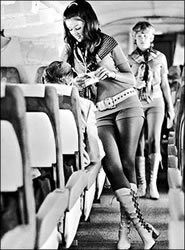
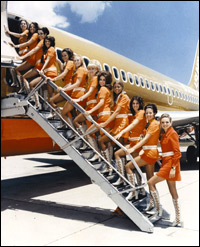

Casual sailing sweater, (designed in Italy, apparently), for that 1950s holiday mood. I think this is an outfit for the boathouse, or for the yacht where the chap does all the sailing stuff! I can't say how it would look covered in a life jacket, but it really is a delightful little sweater. The fit (smaller size) is excellent on me (a chubby UK size 12, US size 6), and it looks great despite the rules about short people and horizontal striping.
InstructionsBack and front are mainly knitted alike, but there is some additional
detail on the welt at the front. BackWith No. 12 needles, cast on 112 (120) stitches in navy, and work 2 inches (20 rows) in k1, p1 rib. ** Join in white and continue in st st stripes as follows: Row 1: right side facing, knit in white. Do not turn the work,
but slip the sts back to other end of the needle. Continue in the striped pattern, and shape the sides by increasing 1
st at each end of the next and every following 6th row, until there are
134 (142) sts. Shape armholes as follows: Shape shoulder as follows (right side facing): Next row: Rib to end, picking up loop where row was turned each
time and knitting it together with the the next st to avoid a hole Cast off right across very loosely in rib. FrontWith No. 12 needles, cast on 140 (148) stitches in navy, and work 2 inches
(20 rows) in k1, p1 rib. Work as for back from ** to **. [Editor's note: I adapted the front neck to give it some additional shaping. See "Adapting the Front Neck" section] To make upPress parts carefully on wrong side under a damp cloth. With navy wool
and number 12 needles, continue in rib on each of the sets of 14 sts on
safety pins until piece measures 5 inches from start. Cast off in rib.
Join these ribbed pieces to sides of front. [Editor's note: This is to stop the edges of the armholes from curling over, as there is no additional knitted edging.] Now fold neck edge of front over to back along shoulder edges by ½ inch. Sew two buttons on each shoulder through double thickness to secure shoulders. Press seams. |
MaterialsOriginal pattern calls for 4oz of 3ply in light navy and 1 oz each in
lipstick red and white. One pair of No 12 double pointed needles (or a circular needle) and one pair No 11 needles. 8 large pearl buttons and bias binding. Tension32st and 40 rows to 4 inches (10cm) on No 12 (2½ mm) needles,
using the 4 ply wool. (original pattern calls for No 11 needles and 3ply). Size mattersInstructions for two slim fitting sizes: 34-35 (36-37) inch bust; length from top of shoulders 20½ (20½) inches. A word on the wool.For the navy and white I used a vintage Hayfield soft cotton 4ply, and
for the red I used Jaeger Sienna (also a pure cotton 4ply). I used 11
and 12 needles which are a size smaller needles than stated in the original
pattern, and with these I managed to achieve the required tension. Disclaimer
|
The original pattern is a slash neck, the same at the back as the front. I adapted the front neck to lower it slightly and add shaping. [Editor's note: This adaptation used slightly less wool that the slash neck version where I had only inches left, knitting the smaller size. Adapting the neckline left me with just enough to sew up!]

Replace the shoulder shaping section for the front as follows:
Shape shoulder (front adaptation) as follows (right side facing):
Next 2 rows: Rib to the last 4 sts, turn; rib to the last 4 sts,
turn.
Next 2 rows: Rib to the last 8 sts, turn; rib to the last 8 sts,
turn.
Next 2 rows: Rib to the last 12 sts, turn; rib to the last 12 sts,
turn.
Divide for neck as follows:
Next row: Rib 40(42) sts; turn and leaving the rest of the sts
on a spare needle. Complete each side of the neck separately.
Next row: K2tog; rib to the last 16 sts, turn.
Next row: Rib to the last 2sts; k2tog; turn.
Next row: K2tog; rib to the last 20sts, turn.
Next row: Rib to the last 2sts; k2tog; turn.
Next row: K2tog; rib to the last 24sts, turn.
Continue thus, turning 4 stitches short of the shoulder edge each time
as for the back, and decreasing at neck edge on every row, until you complete
the row:
Next row: Rib to the last 36 sts, turn. Then:
Next row: Rib to the last 2sts; k2tog; break wool.
Rejoin the wool to the sts on the spare needle at centre neck. Rib across
all sts on spare needle to the last 16 sts, turn.
Next row: Rib 38(40) sts, k2tog; turn, and complete this side of
the neck separately, leaving the centre 28 (30) sts on a spare needle.
Next row: K2tog; rib to the last 20sts, turn.
Next row: Rib to the last 2sts; k2tog; turn.
Next row: K2tog; rib to the last 24sts, turn.
Continue thus, turning 4 stitches short of the shoulder edge each time
as for the back, and decreasing at neck edge on every row, until you complete
the row:
Next row: Rib to the last 36 sts, turn. Then:
Next row: (wrong side facing) rib across right shoulder to the last 2sts; k2tog; do not break wool.
Pick up and rib all sts across the neck: pick up the approximately 12
sts** down
right side of neck, rib across centre 28 (30) sts, pick up approximately
12 sts** up
left hand side of neck; then rib across all sts of right shoulder, picking
up loop where row was turned each time and knitting it together with the
the next st to avoid a hole.
[**Editor's note:
make sure you pick up the right number of sts down sides of neck to ensure
continuity if the k1 p1 rib - that is and even or an odd number.]
Next row: Rib back across all sts, picking up loop where row was
turned each time and knitting it together with the the next st as before,
across the right shoulder..
Cast off right across very loosely in rib.
I have not tried this myself, but it seems to me that it would be moderately easy to adapt the size by simply adding stitches. To adjust the length, make additional stripes in the navy and the red striped sections evenly, both above and below the armhole decreasing, as required. To gauge how much to increase, you can use a sleeveless top that fits you well and measure the overall length, as well as the length of the armhole.
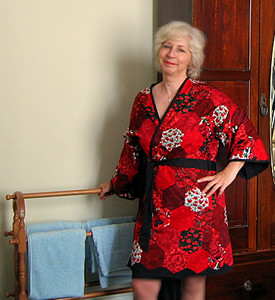
A fun coverall that can be worn as a dressing robe or on the beach. This is a 1970s take on the Japanese design for happi coats, which originated as Japanese over coats traditionally worn by shop keepers. The family crest, shop name or emblem was printed on the back of the coat. Today, happi coats are still used by some shop keepers in Japan, but are also widely used elsewhere for festivals, parties and so on.
I realised while writing these instructions that they are not really for the novice seamstress. You will understand them better if you have used a paper pattern before. Having said that, this is a very simple shape; there is no real tailoring and if you are not a perfectionist, you can obtain a very pleasing result without much skill. If you are a perfectionist, then I expect you will make a high quality item in spite of my sketchy instructions....
InstructionsUsing the dressmakers paper, make a paper pattern from the graphs (Figs 1 and 2) and, using fabric scraps, or fat quarters, cut patches at least approximately 4 inches by 4 inches, according to the patch shapes you have chosen. Lay the patchwork pieces out on a table until there are enough to make a Back, two Fronts, two Sleeves and two Pockets. Remember to evenly distribute the colours so you don't run out of one particular fabric. Join the patches together by hand or (preferably) machine. Make the area of fabric required for each pattern piece.
For the sleeves, make two pieces of patchwork, each 22 inches by 15½ inches. For the back make one piece, 35½ inches by 26 inches, and, for the fronts, two pieces, each 36 inches by 12½ inches. For the pockets make two pieces, each 9 inches by 8½ inches. Pin the pattern pieces to the patchwork, and cut: one back on the fold; two sleeves; two fronts (remember these must be a left and right mirror image of each other); and two pockets. Pin the paper pattern pieces to the lining fabric and cut out the same pieces. Pockets: Place the pocket linings against right sides of pockets, and machine stitch around 3 sides, leaving the top open. Turn the pockets and press, (3 edges are enclosed in the lining). Cut two pocket facings from the facing fabric, each 9 inches by 4 inches. Turn in the short edges of the facings so that they are the same width as the pockets. Place one longer (raw) facing edge to the top raw edge of the pocket and sew in place. Turn facing to inside, tuck raw edge under and stitch. Repeat with the other pocket. Pin pockets to robe fronts in positions indicated on the graph, and top stitch in place. Sewing up: Tack the patchwork fronts to the lining fronts, wrong sides together. Tack and machine stitch the patchwork layer of the back only to the fronts along the shoulder seams and down the side seams, working on the wrong side. Machine the back lining to the shoulder seams, enclosing all the raw edges, and hem down the side seams. Sew the patchwork sleeve seams, with the raw edges on the wrong side, as usual, and then with right side to right side, ease the sleeves into the armholes; pin, tack and sew. Sew sleeve lining seams, wrong side to wrong side, and hem into place. Tack lining to patchwork all around the edges of the garment. Facings: From the facing fabric, cut one belt 78 inches by 5 inches, two belt slots, each 3 inches by 2½ inches, two front facings each 39 by 4 inches, one hem 52 inches by 5 inches, and two cuffs, each 21 inches by 5 inches. |
Materials2½m (112cm width) plain lining fabric. Fabric scraps, or about 10 fat quarters quilt fabric (usually 112cm or 44 inches wide). 2m cotton fabric for facings (or bias binding). Dressmaker's squared paper - 1 inch grid (I found only in centimetre grids on the web - 2ins=5cm) Size mattersOne size fits all. However for my version, I altered the pattern below to make it slightly smaller (to fit me); however, as a wrap, it can be worn over-size. A word on the designI used floral hexagons for my robe. The original was shown with rectangular patches. See "adaptations". |
You can make the robe by cutting the basic design from a plain fabric, which you can use as a conventional lining, or you can apply your patches directly to the lining as a backing, depending on how free form you want to be with your patchwork. You can use any patchwork techniques; I have used a conventional shape, but applied the patches directly on to the backing, overlapping them like roof tiles, and top stitching in place. This method allowed for minor inaccuracies in sizing the patches. I chose the shape of the patch to suit my floral fabric.
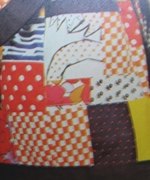 The original robe was a rather pleasing design made of uneven rectangles in geometric and spotted fabrics in 1970s oranges, yellows, and browns. However, I was seduced by the lovely red poppy fabrics in my local quilt shop in Dorking (The Quilt Room) - in consequence I chose a hexagonal shape which I thought better suited the floral effect. I like the effect but also feel that it is a little reminiscent of a table cloth.
The original robe was a rather pleasing design made of uneven rectangles in geometric and spotted fabrics in 1970s oranges, yellows, and browns. However, I was seduced by the lovely red poppy fabrics in my local quilt shop in Dorking (The Quilt Room) - in consequence I chose a hexagonal shape which I thought better suited the floral effect. I like the effect but also feel that it is a little reminiscent of a table cloth.
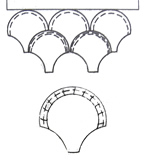 I would like to experiment with the fish-scale (or clam-shell) patch in beautiful pale blues and sea-greens to make a bath robe. There are some lovely "watery" batik fabrics available in packs. You could even introduce silvers, and gauzy effects. The fish-scale design can be used as patches, or as a quilting pattern, and is well-suited to the overlapping appliqué method (to better emulate scales).
I would like to experiment with the fish-scale (or clam-shell) patch in beautiful pale blues and sea-greens to make a bath robe. There are some lovely "watery" batik fabrics available in packs. You could even introduce silvers, and gauzy effects. The fish-scale design can be used as patches, or as a quilting pattern, and is well-suited to the overlapping appliqué method (to better emulate scales).
Whatever you choose, remember to use big patches, otherwise it will be a 20 year project. You could even cheat and choose a fabric with a patchwork pattern, or indeed just decide to use some fabric that pleases you with no patchwork at all!
I wanted to keep the robe as light weight as possible, but you could put in an interlining and then quilt, for a heavier weight padded robe.

A pretty, low-cut, jewelled cocktail jumper for evenings, dating from 1957. Originally knitted in Patons Beehive Fingering 3-ply, this version uses a fine vintage Phildar yarn in sunshine yellow. The original colour suggestion was pale pink, with black embroidery, (which I omitted altogether for my version to avoid looking like a bee as much as possible). I think it would be very pretty in pink.
My pose above is in imitation of the orginal model, which is in itself quite a challenge despite the air-brushing techniques available for digital photographs....
Lace PatternRow 1: (right side) k1, wfwd, sl1,
k1, psso, k1, * k1, k2tog, wind wool twice
round needle, sl1, k1, psso, k1; repeat from *
to last 4 sts: k1, k2tog, wfwd, k1. InstructionsBack and front alike. With No. 13 needles, cast on 114 (126) stitches, and work 4 inches in
k1, p1 rib. [Editor's note: I worked both sides together in the round, (so every round knit) up to the start of the armhole pattern, when I split the work, and continued each side separately. Mark the sides with st markers to aid placement of the increases.] Introduce lace pattern at the centre: Next row: Inc in 1st st, k55 (61), pattern 26sts as
1st row of lace pattern, k55 (61), Inc in last st. Next row: pattern 14sts as 1st row of lace pattern;
k40 (46); pattern 38sts as 1st row of lace pattern; k40 (46); pattern 14sts as 1st row of lace pattern. Divide for neck as follows: Row 1: pattern 14sts as 1st row of lace pattern; k34
(40); k1, wfwd, sl1, k1, psso, k1, * k1,
k2tog, wind wool twice round needle, sl1, k1, psso, k1; repeat from *
twice more, k1, k2tog, turn, and leave remaining sts on a spare needle. Continue in pattern, decreasing 1st at neck edge on every alternate row, and at the same time, taking an extra 6 sts into lace pattern at neck edge on every following 1st pattern row until 49 (51) sts remain, ending with right side facing for next row. At this point 9 (10) complete patterns have been done from the start of the lace pattern. Now work over all stitches in pattern, still decreasing 1 st at neck
edge on next and following 3 alternate rows. [45 (47) sts] Shape shoulder as follows (right side facing): Next row: Cast off 12 (14) sts, pattern to last 2 sts, K2tog. With right side facing, rejoin the wool to the remaining sts and work the other side of the neck as follows: Row 1: k2tog, k1, * k1, k2tog, wind
wool twice round needle, sl1, k1, psso, k1; repeat from *
twice more; k1, k2tog, wfwd, k1; k34 (40); pattern 14sts as 1st
row of lace pattern. Finish to correspond with the other side of the neck. Making up - Press stocking stitch parts only on the wrong side under a damp cloth. Join shoulder and side seams. Press seams.
Embroidery - Using 2 strands of stranded cotton, embroider 4 petal
loop stitch flowers in centre of diamonds round neck edge and sleeves,
as shown in the photograph, then add a jewel or sequin to the centre of
each flower. |
MaterialsOriginal pattern calls for 5oz of 3-ply. One pair each of numbers 13 and 11 needles. Number 12 crochet hook. Jewels
(5mm) or sequins and stranded cotton for embroidery. Tension32st and 40 rows to 4 inches (10cm) on No 11 (3mm) needles. Size mattersInstructions for two slim fitting sizes: 33-35 (36-38) inch bust; length from top of shoulders 18½ (19¼) inches. A word on the wool.I used an old Phildar yarn (Loisirs) which knits 30st to 4inches; Phildar
Luxe is a quality fine yarn in a fair range of colours - but both
these yarns are mixed fibres with only 15% wool. Disclaimer(well...almost a disclaimer...)
|
Substituting the wool
The recommended yarn is a 3-ply. Knitting these old patterns makes you
think "gosh - I'd forgotten how fine 3-ply was" and "gosh
- how small and dainty people were in the 1950s".
In addition to the issues with size and tension, 3-ply is a very fine
(fingering) yarn which is now really restricted to baby wools, assuming
you can find it at all. The baby ranges usually offer it in white only,
and tend to be "easy care" - or as we know it: synthetic. I
have not done exhaustive research, but there does not seem to be any of
the standard bread-and-butter brands in this wool weight. I imagine that
some of the heavier crochet cottons may knit up to these kinds of tensions,
but the texture of the knitting may be a little stiff.
You can aquire some vintage 3-plys on eBay (for example, Jaeger 3ply Botany,
or even Patons Nylox, which is 80% wool and not entirely restricted to
mens sock colours). I notice also there are very fine yarns available in
cones intended for use with knitting machines, but often content and weights are not clearly defined.
The good news is there has been quite an opening up of the 4-ply wool weights* which I think is due to the popularity of sock knitting now. There are some lovely colour ranges, and Rowan, for example, offer several 4-ply ranges including suitable cottons. This top has turned out to be very pretty, and I would have much preferred it in a cotton or soft woollen yarn.
Knitting in 4-ply will help you with producing a bigger size but check
your tension carefully, experiment with smaller needles, and do your arithmetic.
Changing from 8st per inch to 7st per inch makes a small 35 inch bust
leap to 40. This style is meant to be tight, and don't necessarily be
put off if you have an ample figure - as long as it goes in and out in
the right proportion!
If you want to change the number of stitches to alter the size then you
need to add or subtract 12 at a time. You can alter the length up to the
arm easily enough, and also lengthen the armhole by simply knitting more
of the lace pattern before you start shaping the shoulder, (as I did).
*The "quickerknit", or fine double knitting yarns, seem to be offered in many more ranges now as well ; at one time this too was relegated to the baby wool shelves only, and it is one of my favourite weights to knit with.
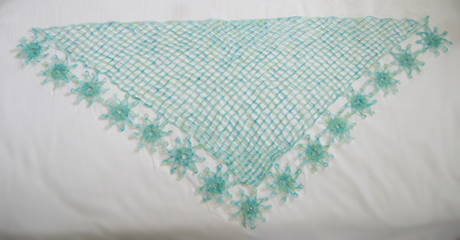
Pattern from 1955 described as a "lacy head scarf for evening wear". This is a charming fichu, for evening, or indeed day wear, depending on your choice of yarn type.
I don't know about you, but I try not to wear head scarves in the evening; in fact I try not to wear them ever. I took against them in the 1970s - something to do with the image of the Royal Family - o, and they make me look like an extra from an Edinburgh Fringe production of Mother Courage.
Hopefully, however, this one will make us all look like Grace Kelly.
InstructionsBegin at the widest part. With No. 11 (the larger) hook make 260 chain, very loosely. Row 1: Miss 1ch, * 1dc in next ch,
7ch, miss 5ch; repeat from * to last chain;
1dc in last ch; turn. Continue, repeating 2nd row, thus decreasing one trellis pattern
on every row, until only one trellis pattern remains to be worked in the centre.
First round: 3ch. (this counts as one dbl tr), work 26 dbl trs
through centre of ring, and join to top of he 3ch with a slip st. Make 14 more in the same way. Making up - Press lighty on the wrong side under a damp cloth. Make a long strip of flowers by joining (sewing) the tip of one petal of one flower to the adjoining tip of petal of another flower. Join this strip to sloping sides of main part - seven petals along each side, and one at the top of the triangle; catch the tips of two petals of each flower to the main work to secure the border. Give a final press, pinning out the flower points. [Editor's note: I experimented, adding a pearlised bead suspended in the centre of each of the flowers; it looks very pretty and follows the current fashion for applied beading - however the "nude" versions retain a certain delicacy without further adornment.] |
MaterialsOriginal pattern calls for a ½oz ball of "Fine Ply". Example in hand-painted cobweb lace wool (100m skeins about 9g) purchased from Alchemy Fibre Arts eBay shop. Numbers 11 (3mm) and 12 (2.5mm) crochet hooks. TensionOne trellis pattern measures ¾in on no. 11 hook. SizeApproximately 36 inches at the widest part. A word on the wool.There were quite a few patterns for very fine scarves and shawls in cobweb
wools, and as their name suggests they are very fine gauge. |
Now you have the taste for chic yet casual evening wear in adaptable crochet, I expect you'll want to embark on a larger project (such as the one below) to extend your skills. Let me know if you need the pattern.
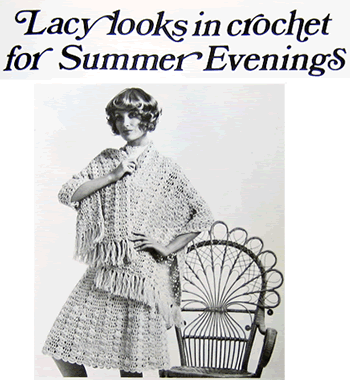

A true gem of a pattern described as an "angora tippet" from the early 1950s. Originally knitted in Patons Beryl Angora 4ply wool, this version uses a mixed fibre mohair yarn which knits to a 4ply tension.
InstructionsWith No. 8 needles, cast on 338 stitches loosely, and work 4 rows stocking stitch starting with a knit row. **Next (eyelet) row: K2 *wool forward,
K2tog.; repeat from * to last 2 sts, K2. Make hem - on next row by knitting 1st from the needle together
with 1st from the cast-on edge. Work 7 rows in stocking stitch, starting
with a purl row. Repeat sections from **
to ** once more. Next row: wrong side facing, K4, *
P30, K30; repeat from * to last 34 sts; P30,
K4. Start shaping Next row: K4, (K2tog, K12) 22 times, K4. Next row: K4, (K2tog, K11) 22 times, K4. Continue in this way, decreasing 22 sts on next and every following 6th
row, (remembering you will be working 1st fewer after the K2tog on each
decrease row) until 96 sts remain. Neckband Join neckband and main body Place the needle with the neck sts and the spare needle with the body
sts together, with right sides (facing each other) together, and cast
off the two sets of stitches together. Making up
The detail shows the mixture of stocking stitch and garter stitch gored panels, which gives the shoulder cape such a perfect drape. The hem is formed by a double folded picot edging, which is reproduced at the neck.
|
MaterialsOriginal pattern calls for 2 oz angora wool. One pair each of number 8 and number 11 needles. Two decorative gold buttons, and hook and eye for fastening at the neck. Tension28st to 4 inches (10cm) on No 8 (4mm) needles. Size mattersOne size fits all! However - I did lengthen the cape by about one inch overall, as I found that although the tension was as stated in sts per inch, the length seemed shorter than depicted. A word on the woolI used a vintage wool from Pingouin called Volutes (80% acrylic 20% mohair), which I chose from my stash mainly for its rich colour. It knits to a tension of 23sts x 34rows on No. 11-12 (3-2½mm) needles, thus I knitted the cape on smaller needles than the pattern stated to achieve the right tension. I think the cape really needs to be knitted in a true luxury yarn, such as angora, or cashmere. Rowan's Kidsilk Haze could be suitable but the smallest tension on No. 10 needles is quoted as 25sts to 4in. |


Knitted in a combination of wools, ribbon, and a linen yarn, of various weights using the basic shape of a double knitting pattern. The length is short to allow for sitting in bed.
InstructionsKnitted to a basic shape as follows: Back - cast
on 88 sts. Knit in your own pattern for 7 or 8 inches. Right front
- cast on 36 sts. Knit to pattern increasing 1st at the beginning of every
alternate row until there are 44 sts. (This forms a curved front edge).
Left front - work to match the right front, reversing all shapings. Sleeves - cast on 56 sts and work for 2 inches, then increase 1 st at each end of next and every following 6th row to 76 sts. Work straight to 15 inches from beginning. Cast off. Crochet border - a simple row of double crochet and then a crochet shell pattern (1 dc; miss 2; 5 tr into next stitch; miss 2; then repeat). Make up - sew
shoulders and side seams. Set sleeves into the armholes, placing 2 ins
at the sleeve top to the cast off sts at the underarm, and sewing up the
sleeve seams. |
MaterialsSelf-styled free form pattern, knitting a mixture of rows in plain and purl, using wools from 4ply through to a chunky boucle and including ribbon yarn. Tie made from twisted cord or ribbon. Size mattersTension (average over different yarn weights): |
